ZyXEL Communications HES309M WiMax Outdoor CPE User Manual ZyBook2
ZyXEL Communications Corporation WiMax Outdoor CPE ZyBook2
User Manual
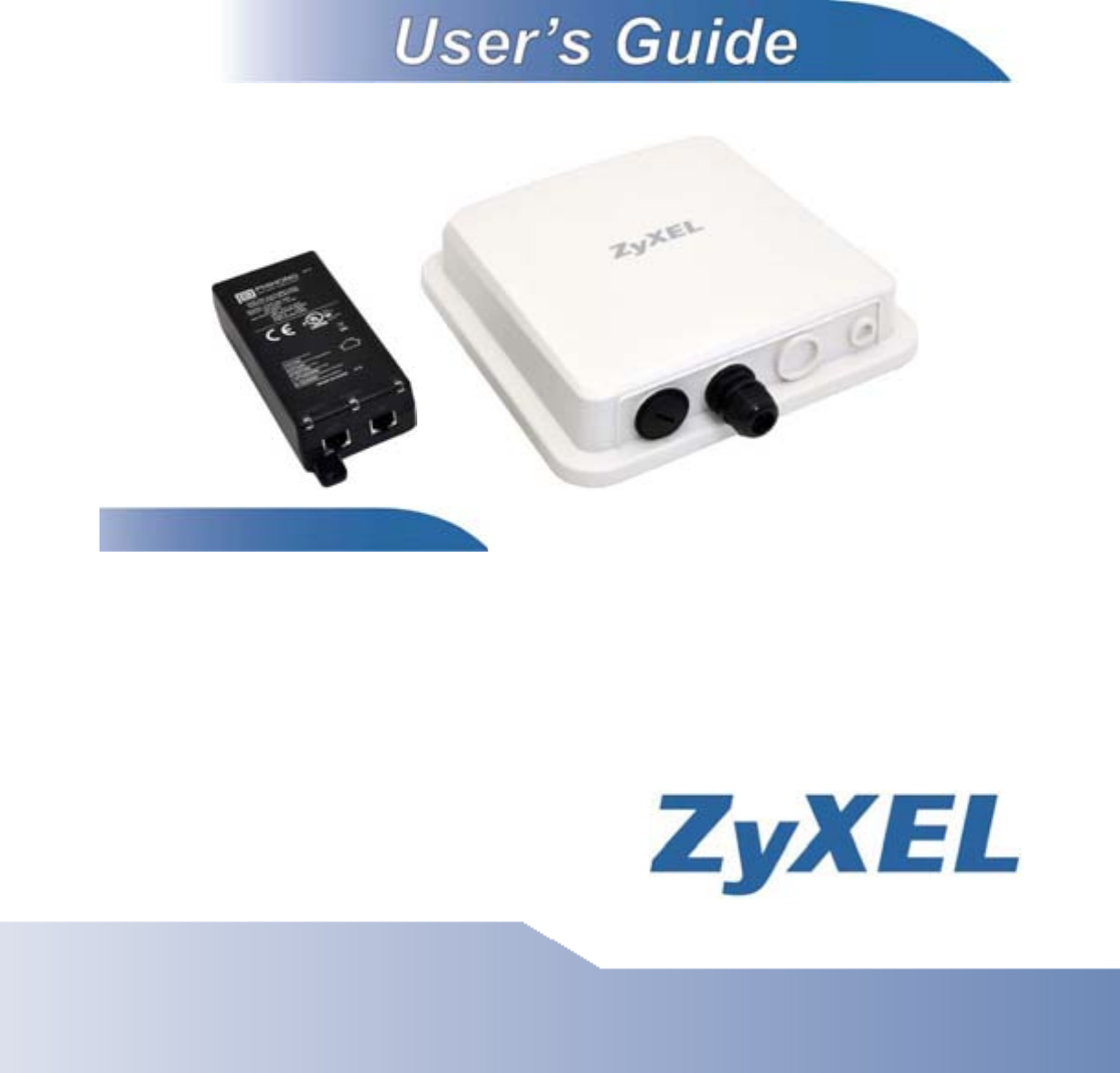
www.zyxel.com
www.zyxel.com
HES-309M
WiMAX Outdoor CPE
Copyright © 2010
ZyXEL Communications Corporation
Firmware Version 2.00
Edition 1, 10/2010
Default Login Details
IP Address: http://192.168.1.1
User Name: admin
Password: 1234
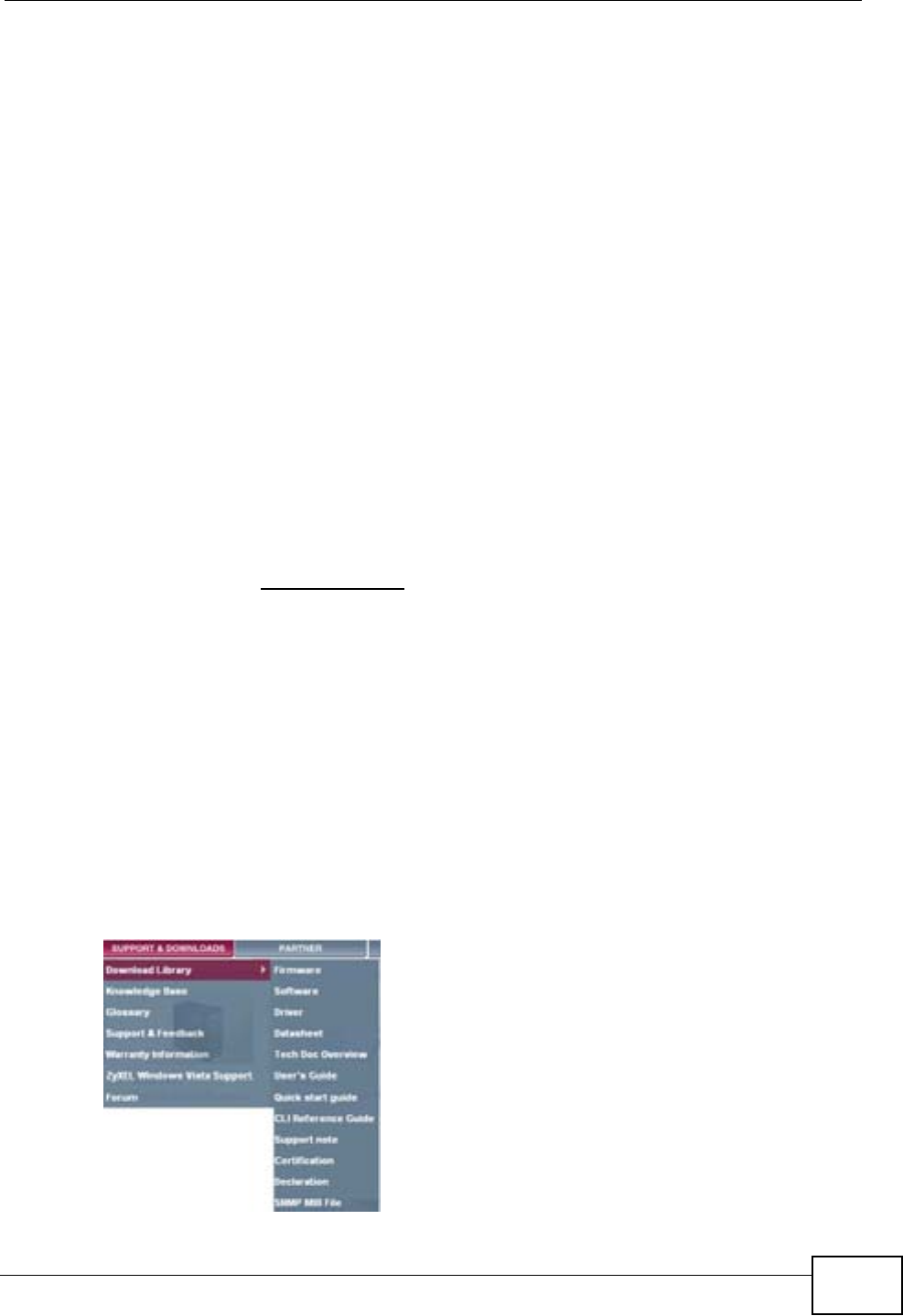
About This User's Guide
HES-309M Series User’s Guide 3
About This User's Guide
Intended Audience
This manual is intended for people who want to configure the ZyXEL WiMAX
Device using the ZyXEL Web Configurator. You should have at least a basic
knowledge of TCP/IP networking concepts and topology.
Related Documentation
•Quick Start Guide
The Quick Start Guide is designed to help you get up and running right away. It
contains information on setting up your network and configuring for Internet
access.
• Support Disc
Refer to the included CD for support documents.
• ZyXEL Web Site
Please refer to www.zyxel.com for additional support documentation and
product certifications.
Documentation Feedback
Send your comments, questions or suggestions to: techwriters@zyxel.com.tw
Thank you!
The Technical Writing Team, ZyXEL Communications Corp.,
6 Innovation Road II, Science-Based Industrial Park, Hsinchu, 30099, Taiwan.
Need More Help?
More help is available at www.zyxel.com.

About This User's Guide
HES-309M Series User’s Guide
4
• Download Library
Search for the latest product updates and documentation from this link. Read
the Tech Doc Overview to find out how to efficiently use the documentation in
order to better understand how to use your product.
• Knowledge Base
If you have a specific question about your product, the answer may be here.
This is a collection of answers to previously asked questions about ZyXEL
products.
•Forum
This contains discussions on ZyXEL products. Learn from others who use ZyXEL
products and share your experiences as well.
Customer Support
Should problems arise that cannot be solved by the methods listed above, you
should contact your vendor. If you cannot contact your vendor, then contact a
ZyXEL office for the region in which you bought the device.
See http://www.zyxel.com/web/contact_us.php for contact information. Please
have the following information ready when you contact an office.
• Product model and serial number.
•Warranty Information.
• Date that you received your device.
• Brief description of the problem and the steps you took to solve it.

Document Conventions
HES-309M Series User’s Guide 5
Document Conventions
Warnings and Notes
These are how warnings and notes are shown in this User’s Guide.
Warnings tell you about things that could harm you or your
WiMAX Device.
Note: Notes tell you other important information (for example, other things you may
need to configure or helpful tips) or recommendations.
Syntax Conventions
• The product(s) described in this book may be referred to as the “WiMAX
Device”, the “device”, the “system” or the “product” in this User’s Guide.
• Product labels, screen names, field labels and field choices are all in bold font.
• A key stroke is denoted by square brackets and uppercase text, for example,
[ENTER] means the “enter” or “return” key on your keyboard.
• “Enter” means for you to type one or more characters and then press the
[ENTER] key. “Select” or “choose” means for you to use one of the predefined
choices.
• A right angle bracket ( > ) within a screen name denotes a mouse click. For
example, TOOLS > Logs > Log Settings means you first click Tools in the
navigation panel, then the Logs sub menu and finally the Log Settings tab to
get to that screen.
• Units of measurement may denote the “metric” value or the “scientific” value.
For example, “k” for kilo may denote “1000” or “1024”, “M” for mega may
denote “1000000” or “1048576” and so on.
• “e.g.,” is a shorthand for “for instance”, and “i.e.,” means “that is” or “in other
words”.
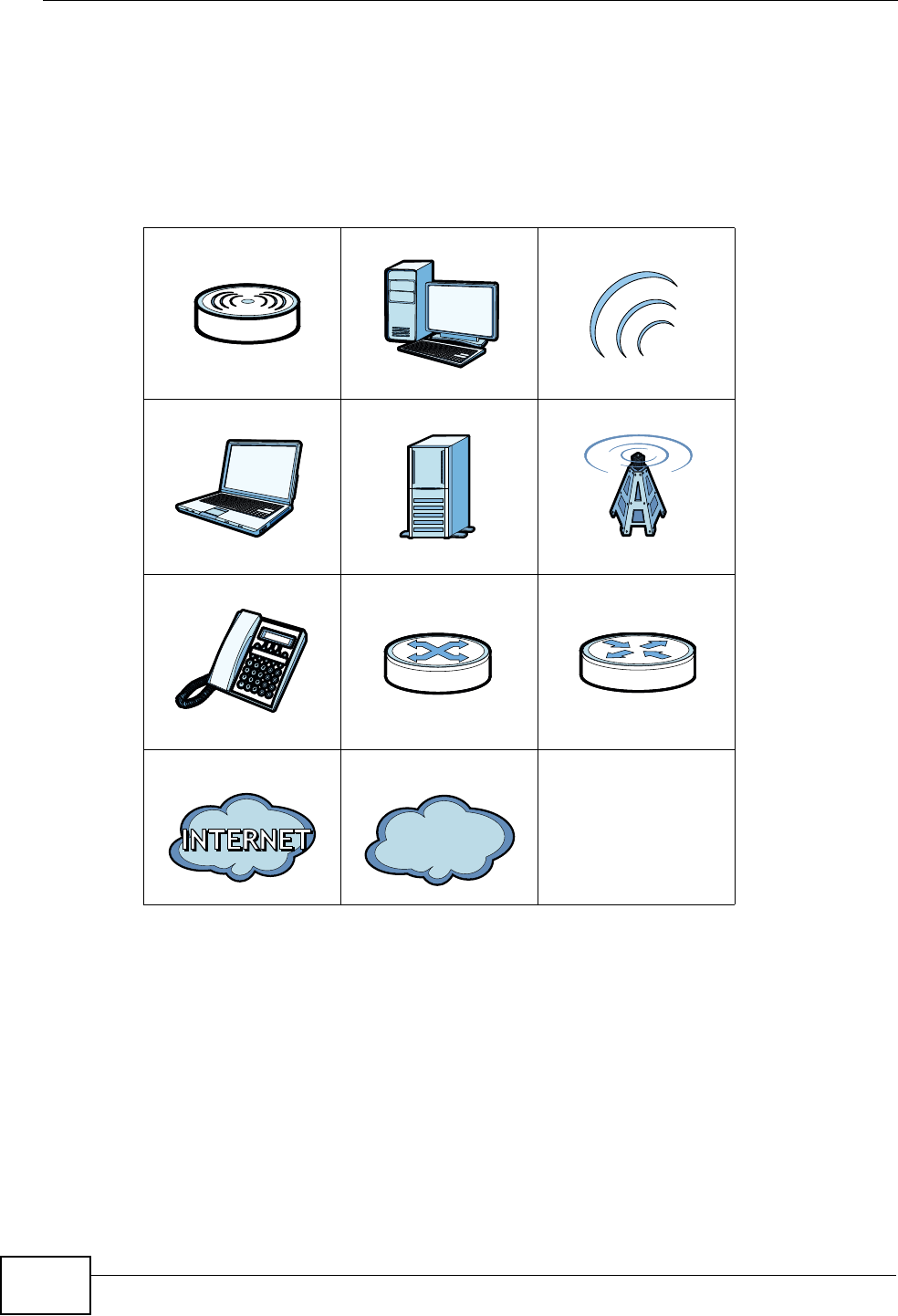
Document Conventions
HES-309M Series User’s Guide
6
Icons Used in Figures
Figures in this User’s Guide may use the following generic icons. The WiMAX
Device icon is not an exact representation of your product.
Table 1 Common Icons
WiMAX Device Computer Wireless Signal
Notebook Server Base Station
Telephone Switch Router
Internet Cloud Network Cloud

Safety Warnings
HES-309M Series User’s Guide 7
Safety Warnings
For your safety, be sure to read and follow all warning notices and
instructions.
• Do NOT use this product near water, for example, in a wet basement or near a
swimming pool.
• Do NOT expose your device to dampness, dust or corrosive liquids.
• Do NOT store things on the device.
• Do NOT install, use, or service this device during a thunderstorm. There is a
remote risk of electric shock from lightning.
• Connect ONLY suitable accessories to the device.
• Do NOT open the device or unit. Opening or removing covers can expose you to
dangerous high voltage points or other risks. ONLY qualified service personnel
should service or disassemble this device. Please contact your vendor for further
information.
• Make sure to connect the cables to the correct ports.
• Place connecting cables carefully so that no one will step on them or stumble
over them.
• Always disconnect all cables from this device before servicing or disassembling.
• Use ONLY an appropriate power adaptor or cord for your device. Connect it to
the right supply voltage (for example, 110V AC in North America or 230V AC in
Europe).
• Do NOT remove the plug and connect it to a power outlet by itself; always
attach the plug to the power adaptor first before connecting it to a power outlet.
• Do NOT allow anything to rest on the power adaptor or cord and do NOT place
the product where anyone can walk on the power adaptor or cord.
• Do NOT use the device if the power adaptor or cord is damaged as it might
cause electrocution.
• If the power adaptor or cord is damaged, remove it from the device and the
power source.
• Do NOT attempt to repair the power adaptor or cord. Contact your local vendor
to order a new one.Do not use the device outside, and make sure all the
connections are indoors. There is a remote risk of electric shock from lightning.
• Do NOT obstruct the device ventilation slots, as insufficient airflow may harm
your device.Use only No. 26 AWG (American Wire Gauge) or larger
telecommunication line cord.
• Antenna Warning! This device meets ETSI and FCC certification requirements
when using the included antenna(s). Only use the included antenna(s).
• If you wall mount your device, make sure that no electrical lines, gas or water
pipes will be damaged.

Safety Warnings
HES-309M Series User’s Guide
8
• Make sure that the cable system is grounded so as to provide some protection
against voltage surges.
Your product is marked with this symbol, which is known as the WEEE mark.
WEEE stands for Waste Electronics and Electrical Equipment. It means that
used electrical and electronic products should not be mixed with general
waste. Used electrical and electronic equipment should be treated
separately.

Contents Overview
HES-309M Series User’s Guide 9
Contents Overview
User’s Guide ........................................................................................................................... 15
Getting Started ........................................................................................................................... 17
The Web Configurator ............................................................................................................... 19
Setup Wizard ............................................................................................................................. 23
Tutorials ..................................................................................................................................... 29
Technical Reference .............................................................................................................. 45
System Status ............................................................................................................................ 47
WiMAX ....................................................................................................................................... 51
Network Settings ....................................................................................................................... 73
Security .................................................................................................................................... 105
Maintenance .............................................................................................................................111
Troubleshooting ....................................................................................................................... 137
Product Specifications ............................................................................................................. 143

Contents Overview
HES-309M Series User’s Guide
10

Table of Contents
HES-309M Series User’s Guide 11
Table of Contents
About This User's Guide .......................................................................................................... 3
Document Conventions............................................................................................................5
Safety Warnings........................................................................................................................7
Contents Overview ...................................................................................................................9
Table of Contents.................................................................................................................... 11
Part I: User’s Guide................................................................................ 15
Chapter 1
Getting Started ........................................................................................................................ 17
1.1 About Your WiMAX Device .................................................................................................. 17
1.1.1 WiMAX Internet Access ............................................................................................. 17
1.2 WiMAX Device Hardware .................................................................................................... 18
1.2.1 LEDs .......................................................................................................................... 18
1.3 Good Habits for Device Management .................................................................................. 18
Chapter 2
The Web Configurator ............................................................................................................19
2.1 Overview .............................................................................................................................. 19
2.1.1 Accessing the Web Configurator ................................................................................ 19
2.1.2 The Reset Button ....................................................................................................... 20
2.1.3 Saving and Canceling Changes ................................................................................. 20
2.1.4 Working with Tables ................................................................................................... 21
2.2 The Main Screen ................................................................................................................. 22
Chapter 3
Setup Wizard ........................................................................................................................... 23
3.1 Overview .............................................................................................................................. 23
3.1.1 Welcome to the Setup Wizard .................................................................................... 23
3.1.2 LAN Settings .............................................................................................................. 24
3.1.3 WiMAX Frequency Settings ....................................................................................... 25
3.1.4 WiMAX Authentication Settings ................................................................................. 27
3.1.5 Setup Complete ......................................................................................................... 28

Table of Contents
HES-309M Series User’s Guide
12
Chapter 4
Tutorials ................................................................................................................................... 29
4.1 Overview .............................................................................................................................. 29
4.2 WiMAX Connection Settings ............................................................................................... 29
4.3 Configuring LAN DHCP .......................................................................................................30
4.4 Changing Certificate ............................................................................................................ 32
4.5 Blocking Web Access .......................................................................................................... 33
4.6 Configuring the MAC Address Filter .................................................................................... 34
4.7 Setting Up NAT Port Forwarding ......................................................................................... 36
4.8 Access the WiMAX Device Using DDNS ............................................................................. 39
4.8.1 Registering a DDNS Account on www.dyndns.org .................................................... 39
4.8.2 Configuring DDNS on Your WiMAX Device ............................................................... 40
4.8.3 Testing the DDNS Setting .......................................................................................... 40
4.9 Configuring Static Route for Routing to Another Network ................................................... 40
4.10 Remotely Managing Your WiMAX Device ......................................................................... 43
Part II: Technical Reference .................................................................. 45
Chapter 5
System Status ......................................................................................................................... 47
5.1 Overview .............................................................................................................................. 47
5.2 System Status ...................................................................................................................... 47
Chapter 6
WiMAX...................................................................................................................................... 51
6.1 Overview .............................................................................................................................. 51
6.1.1 What You Need to Know ............................................................................................ 51
6.2 Connection Settings ............................................................................................................ 55
6.3 Frequency Settings .............................................................................................................. 57
6.4 Authentication Settings ........................................................................................................ 60
6.5 Connect ............................................................................................................................... 63
6.6 Wide Scan ........................................................................................................................... 66
6.7 Link Status ........................................................................................................................... 67
6.8 Link Statistics ....................................................................................................................... 69
6.9 Connection Info ................................................................................................................... 70
6.10 Service Flow ...................................................................................................................... 70
6.11 Buzzer ................................................................................................................................ 71
Chapter 7
Network Settings..................................................................................................................... 73
7.1 Overview .............................................................................................................................. 73

Table of Contents
HES-309M Series User’s Guide 13
7.1.1 What You Need to Know ............................................................................................ 73
7.2 WAN .................................................................................................................................... 78
7.3 PPPoE ................................................................................................................................. 80
7.4 GRE ..................................................................................................................................... 82
7.5 EtherIP ................................................................................................................................. 82
7.6 IP ......................................................................................................................................... 83
7.7 DHCP .................................................................................................................................. 84
7.8 Static Route ......................................................................................................................... 85
7.9 RIP ....................................................................................................................................... 86
7.10 Port Forwarding ................................................................................................................. 87
7.10.1 Port Forwarding Wizard ........................................................................................... 89
7.11 Port Trigger ........................................................................................................................ 90
7.11.1 Port Trigger Wizard .................................................................................................. 91
7.11.2 Trigger Port Forwarding Example ............................................................................. 92
7.12 DMZ ................................................................................................................................... 93
7.13 ALG ................................................................................................................................... 94
7.14 UPnP ................................................................................................................................. 95
7.14.1 Installing UPnP in Windows XP ............................................................................... 95
7.14.2 Web Configurator Easy Access ............................................................................... 99
7.15 DDNS .............................................................................................................................. 101
7.16 Content Filter ................................................................................................................... 102
Chapter 8
Security.................................................................................................................................. 105
8.1 Overview ............................................................................................................................ 105
8.1.1 What You Need to Know .......................................................................................... 105
8.2 IP Filter .............................................................................................................................. 106
8.3 MAC Filter .......................................................................................................................... 107
8.4 DDOS ................................................................................................................................ 108
Chapter 9
Maintenance .......................................................................................................................... 111
9.1 Overview .............................................................................................................................111
9.1.1 What You Need to Know ...........................................................................................111
9.2 Password ............................................................................................................................118
9.3 HTTP ..................................................................................................................................119
9.4 Telnet ................................................................................................................................. 120
9.5 SSH ................................................................................................................................... 121
9.6 SNMP ................................................................................................................................ 122
9.7 CWMP ............................................................................................................................... 123
9.8 OMA-DM ............................................................................................................................ 125
9.9 Date ................................................................................................................................... 127
9.10 Time Zone ........................................................................................................................ 128

Table of Contents
HES-309M Series User’s Guide
14
9.11 Upgrade File .................................................................................................................... 128
9.11.1 The Firmware Upload Process ............................................................................... 129
9.12 Upgrade Link ................................................................................................................... 130
9.13 CWMP Upgrade ..............................................................................................................130
9.14 Backup ............................................................................................................................. 131
9.15 Restore ............................................................................................................................ 132
9.15.1 The Restore Configuration Process ....................................................................... 132
9.16 Factory Defaults .............................................................................................................. 133
9.17 Log Setting ...................................................................................................................... 133
9.18 Log Display ...................................................................................................................... 134
9.19 About ............................................................................................................................... 135
9.20 Reboot ............................................................................................................................. 135
Chapter 10
Troubleshooting.................................................................................................................... 137
10.1 Power, Hardware Connections, and LEDs ...................................................................... 137
10.2 WiMAX Device Access and Login ................................................................................... 138
10.3 Internet Access ................................................................................................................ 140
10.4 Reset the WiMAX Device to Its Factory Defaults ............................................................ 141
10.4.1 Pop-up Windows, JavaScript and Java Permissions ............................................. 142
Chapter 11
Product Specifications .........................................................................................................143
Appendix A WiMAX Security ................................................................................................ 147
Appendix B Setting Up Your Computer’s IP Address........................................................... 151
Appendix C Pop-up Windows, JavaScript and Java Permissions........................................179
Appendix D IP Addresses and Subnetting ...........................................................................189
Appendix E Importing Certificates ........................................................................................201
Appendix F Common Services............................................................................................. 233
Appendix G Legal Information.............................................................................................. 237
Index....................................................................................................................................... 241

15
PART I
User’s Guide

16
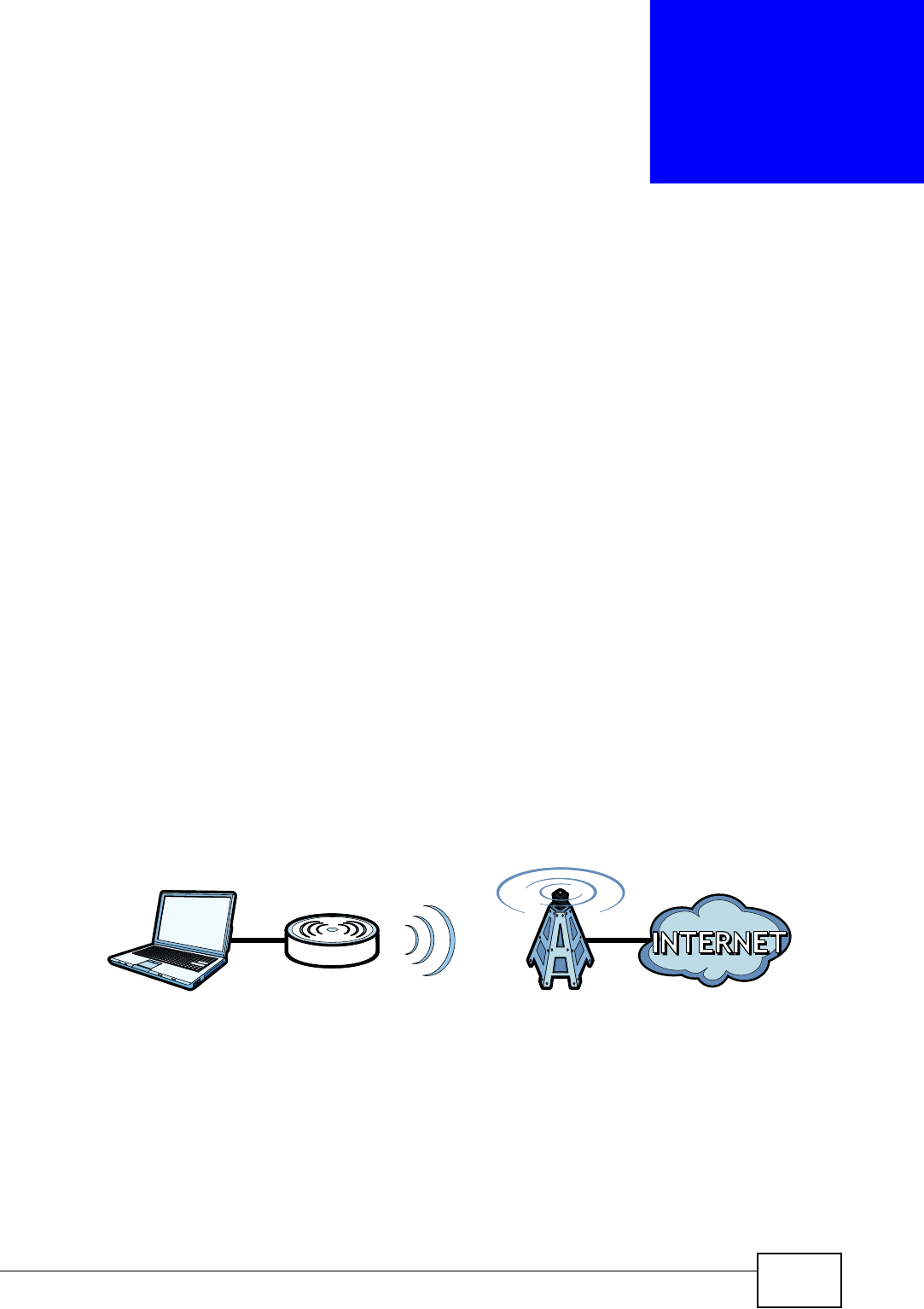
HES-309M Series User’s Guide 17
CHAPTER 1
Getting Started
1.1 About Your WiMAX Device
The WiMAX Device that allows you to access the Internet by connecting to a
WiMAX wireless network. You can configure firewall and content filtering as well as
a host of other features and the browser-based user interface -- the Web
Configurator -- provides easy management.
See Chapter 11 on page 143 for a complete list of features for your model.
1.1.1 WiMAX Internet Access
Connect your computer or network to the WiMAX Device for WiMAX Internet
access. See the Quick Start Guide for instructions on hardware connections.
In a wireless metropolitan area network (MAN), the WiMAX Device connects to a
WiMAX base station (BS) for Internet access.
The following diagram shows a notebook computer equipped with the WiMAX
Device connecting to the Internet through a WiMAX base station (BS).
Figure 1 Mobile Station and Base Station
When the firewall is on, all incoming traffic from the Internet to your network is
blocked unless it is initiated from your network.
Use content filtering to block access to web sites with URLs containing keywords
that you specify. You can define time periods and days during which content
filtering is enabled and include or exclude particular computers on your network
from content filtering. For example, you could block access to certain web sites.
BS

Chapter 1 Getting Started
HES-309M Series User’s Guide
18
1.2 WiMAX Device Hardware
Follow the instructions in the Quick Start Guide to make hardware connections.
1.2.1 LEDs
The following figure shows the LEDs (lights) on the WiMAX Device.
1.3 Good Habits for Device Management
Do the following things regularly to make the WiMAX Device more secure and to
manage the WiMAX Device more effectively.
• Change the password. Use a password that’s not easy to guess and that consists
of different types of characters, such as numbers and letters.
• Write down the password and put it in a safe place.
• Back up the configuration (and make sure you know how to restore it).
Restoring an earlier working configuration may be useful if the WiMAX Device
becomes unstable or even crashes. If you forget your password, you will have to
reset the WiMAX Device to its factory default settings. If you backed up an
earlier configuration file, you would not have to totally re-configure the WiMAX
Device. You could simply restore your last configuration.

HES-309M Series User’s Guide 19
CHAPTER 2
The Web Configurator
2.1 Overview
The Web Configurator is an HTML-based management interface that allows easy
device set up and management via any web browser that supports: HTML 4.0,
CSS 2.0, and JavaScript 1.5, and higher. The recommended screen resolution for
using the web configurator is 1024 by 768 pixels and 16-bit color, or higher.
In order to use the Web Configurator you need to allow:
• Web browser pop-up windows from your device. Web pop-up blocking is enabled
by default in many operating systems and web browsers.
• JavaScript (enabled by default in most web browsers).
• Java permissions (enabled by default in most web browsers).
See the Appendix C on page 179 for more information on configuring your web
browser.
2.1.1 Accessing the Web Configurator
1Make sure your WiMAX Device hardware is properly connected (refer to the Quick
Start Guide for more information).
2Launch your web browser.
3Enter "" as the URL.
4Enter the default Username (admin) and Password (1234), then click Login.
The Main screen displays.
Note: For security reasons, the WiMAX Device automatically logs you out if you do
not use the Web Configurator for five minutes. If this happens, log in again.
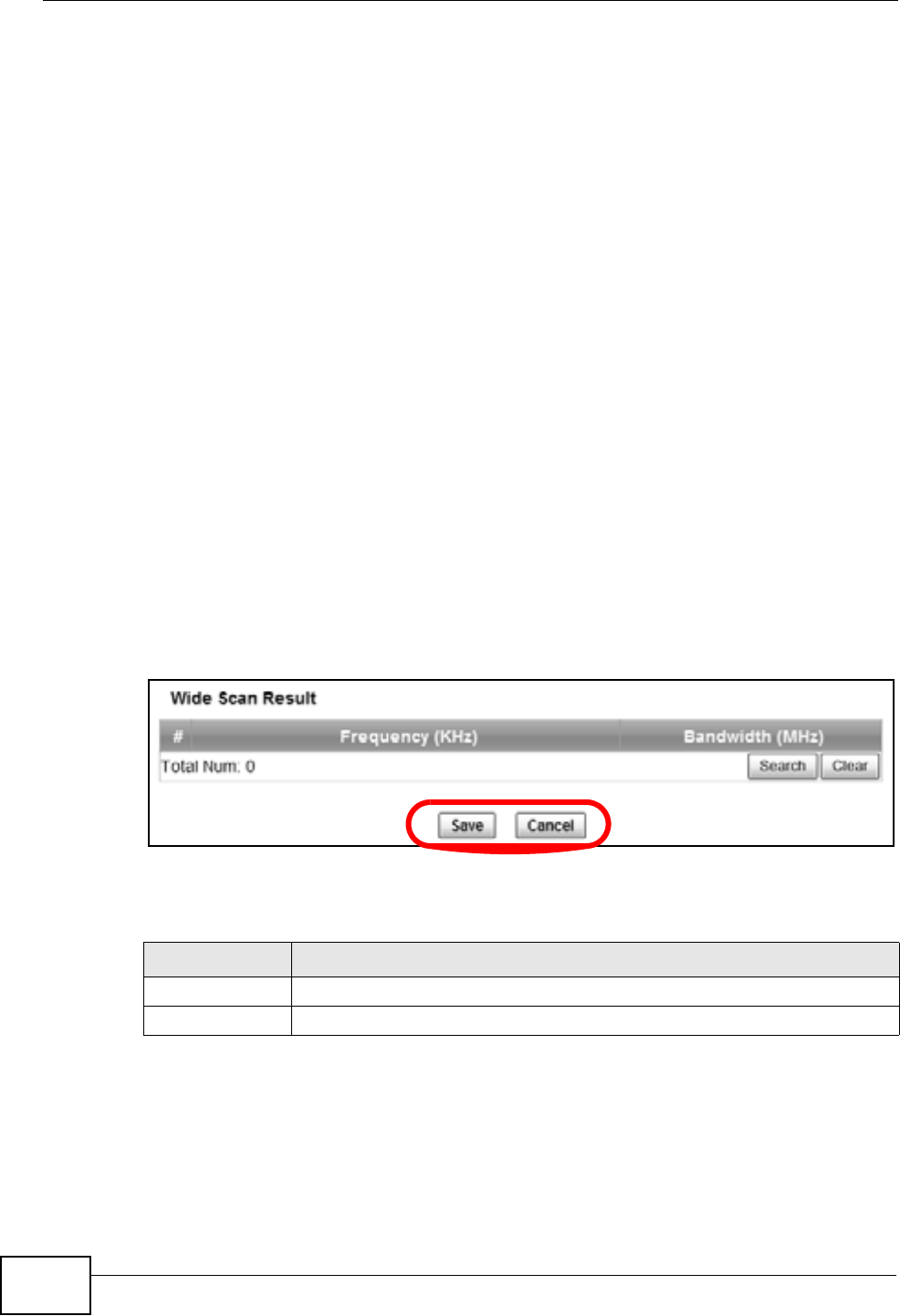
Chapter 2 The Web Configurator
HES-309M Series User’s Guide
20
2.1.2 The Reset Button
If you forget your password or cannot access the Web Configurator, you will need
to use the Reset button to reload the factory-default configuration file. This
means that you will lose all configurations that you had previously and the
password will be reset to “1234”.
2.1.2.1 Using The Reset Button
1Make sure the Power light is on (not blinking).
2To set the device back to the factory default settings, press the Reset button for
five seconds or until all LED lights blink one time, then release it. The device
restarts when the defaults have been restored.
3Reconfigure the WiMAX Device following the steps in your Quick Start Guide.
2.1.3 Saving and Canceling Changes
All screens to which you can make configuration changes must be saved before
those changes can go into effect. If you make a mistake while configuring the
WiMAX Device, you can cancel those changes and start over.
Figure 2 Saving and Canceling Changes
This screen contains the following fields:
Note: If you make changes to a page but do not save before switching to another
page or exiting the Web Configurator, those changes are disgarded.
Table 2 Saving and Canceling Changes
LABEL DESCRIPTION
Save Click this to save your changes.
Cancel Click this to restore the settings on this page to their last saved values.
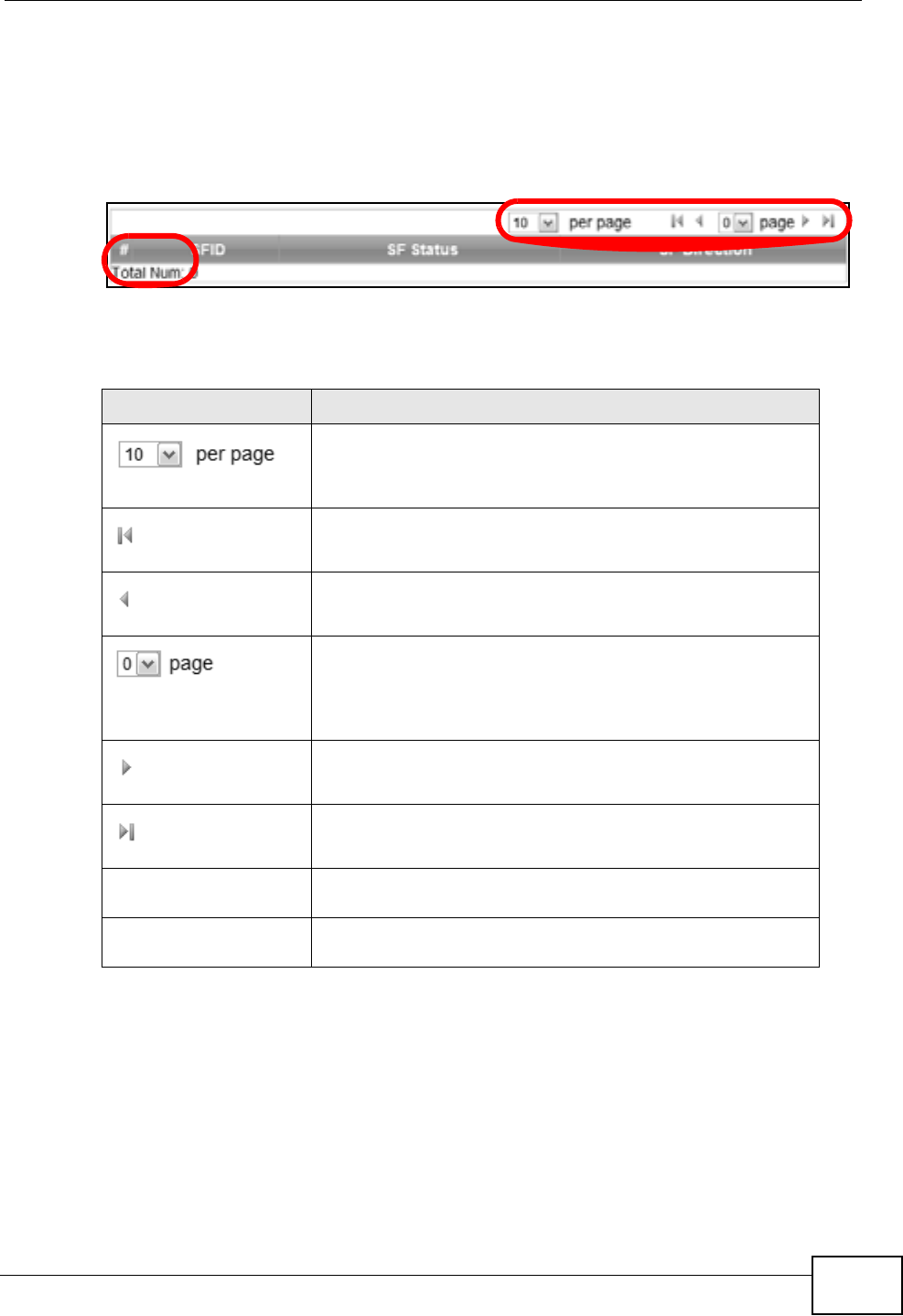
Chapter 2 The Web Configurator
HES-309M Series User’s Guide 21
2.1.4 Working with Tables
Many screens in the WiMAX Device contain tables to provide information or
additional configuration options.
Figure 3 Tables Example
This screen contains the following fields:
Table 3 Saving and Canceling Changes
LABEL DESCRIPTION
Items per Page
This displays the number of items displayed per table page.
Use the menu to change this value.
First Page
Click this to go to the first page in the table.
Previous Page
Click this to go to the previous page in the table.
Page Indicator / Jump to Page
This indicates which page is currently displayed in the
table. Use the menu to jump to another page. You can only
jump to other pages if those pages exist.
Next Page
Click this to go to the previous page in the table.
Last Page
Click this to go to the last page in the table.
# This indicates an item’s position in the table. It has no
bearing on that item’s importance or lack there of.
Total Num This indicates the total number of items in the table,
including items on pages that are not visible.
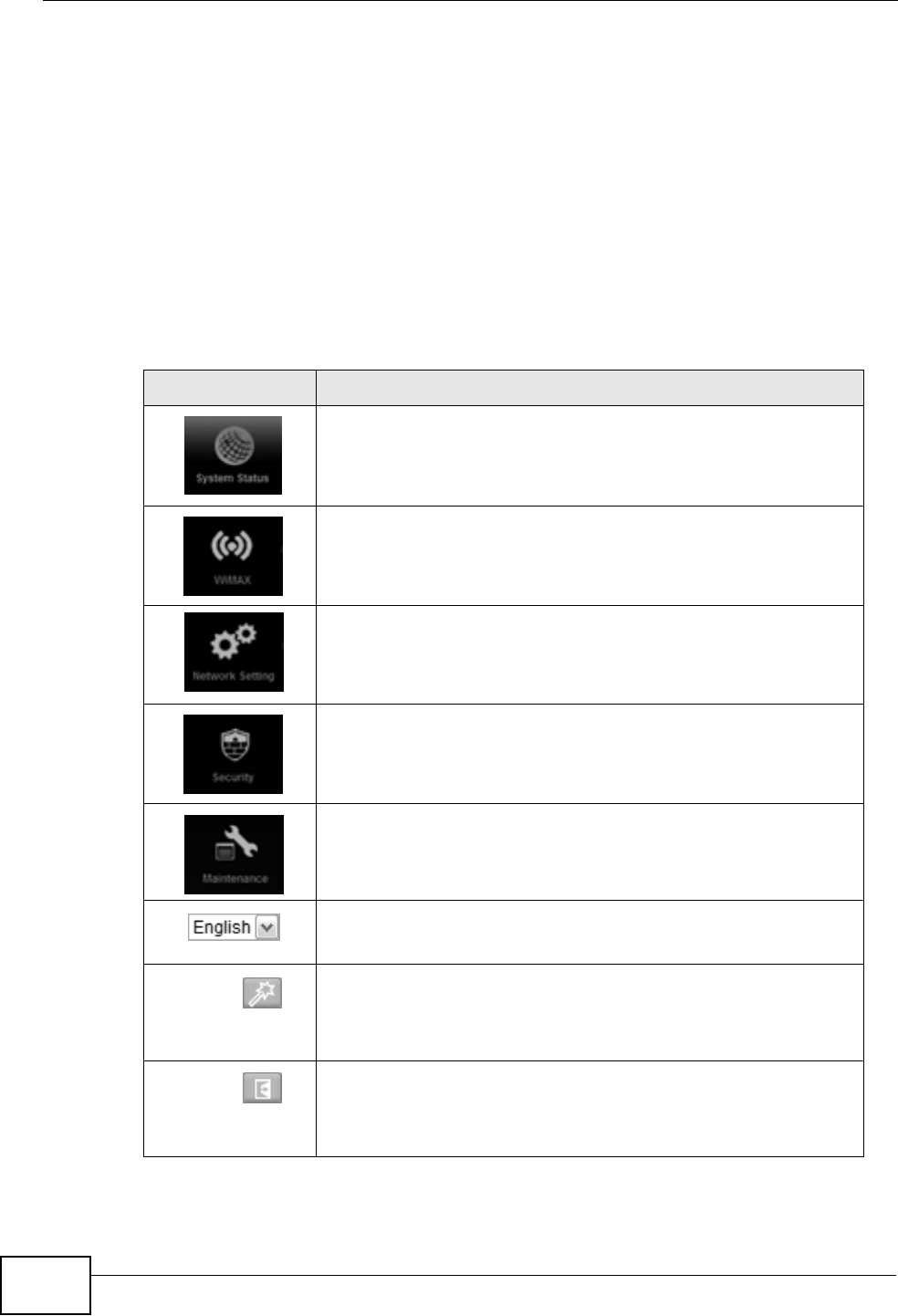
Chapter 2 The Web Configurator
HES-309M Series User’s Guide
22
2.2 The Main Screen
When you first log into the Web Configurator, the Main screen appears. Here you
can view a summary of your WiMAX Device’s connection status. This is also the
default “home” page for the Web Configurator and it contains conveniently-placed
shortcuts to all of the other screens.
Note: Some features in the Web Configurator may not be available depending on your
firmware version and/or configuration.
The following table describes the icons in this screen.
Table 4 Main > Icons
ICON DESCRIPTION
System Status
Click this to open the Main screen, which shows your WiMAX
Device status and other information.
WiMAX
Click this to open the WiMAX menu, which gives you options for
configuring your WiMAX settings.
Network Setting
Click this to open the Network menu, which gives you options for
configuring your network settings.
Security
Click this to open the Security menu, which gives you options for
configuring your firewall and security settings.
Maintenance
Click this to open the Maintenance menu, which gives you
options for maintaining your WiMAX Device.
Language
Use this menu to select the Web Configurator’s language.
Setup Wizard
Click this to open the Setup Wizard, where you can configure the
most essential settings for your WiMAX Device to work.
Logout
Click this to log out of the Web Configurator.
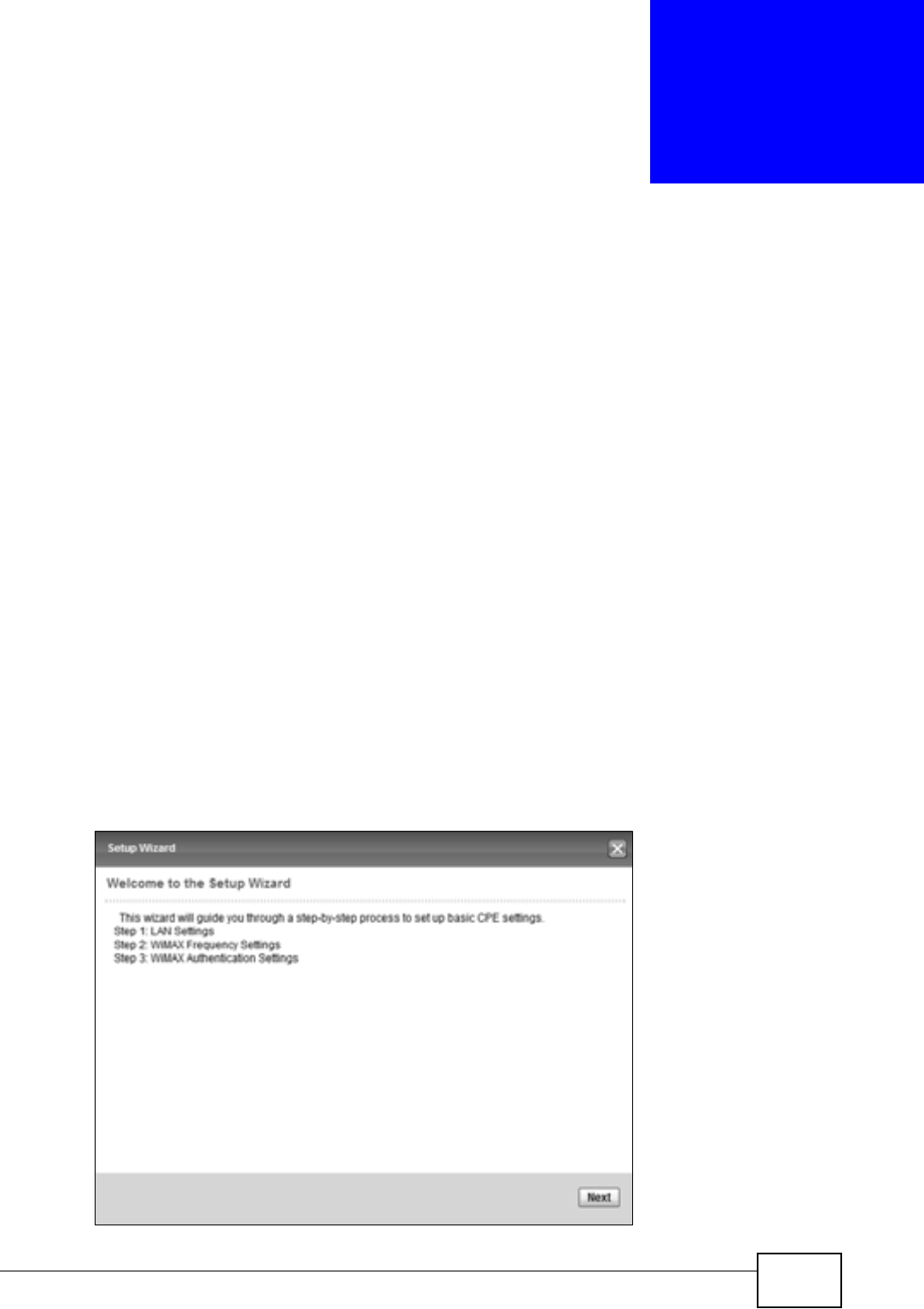
HES-309M Series User’s Guide 23
CHAPTER 3
Setup Wizard
3.1 Overview
This chapter provides information on the ZyXEL Setup Wizard. The wizard guides
you through several steps for onfiguring your network settings.
3.1.1 Welcome to the Setup Wizard
This screen provides a quick summary of the configuration tasks the wizard helps
you to perform. They are:
1Set up your Local Area Network (LAN) options, which determine how the devices
in your home or office connect to the WiMAX Device.
2Set up your WiMAX Device’s broadcast frequency, which is the radio channel it
uses to communicate with the ISP’s base station.
3Set up your WiMAX Device’s login options, which are used to connect your LAN to
the ISP’s network and verify your account.
Figure 4 Setup Wizard > Welcome
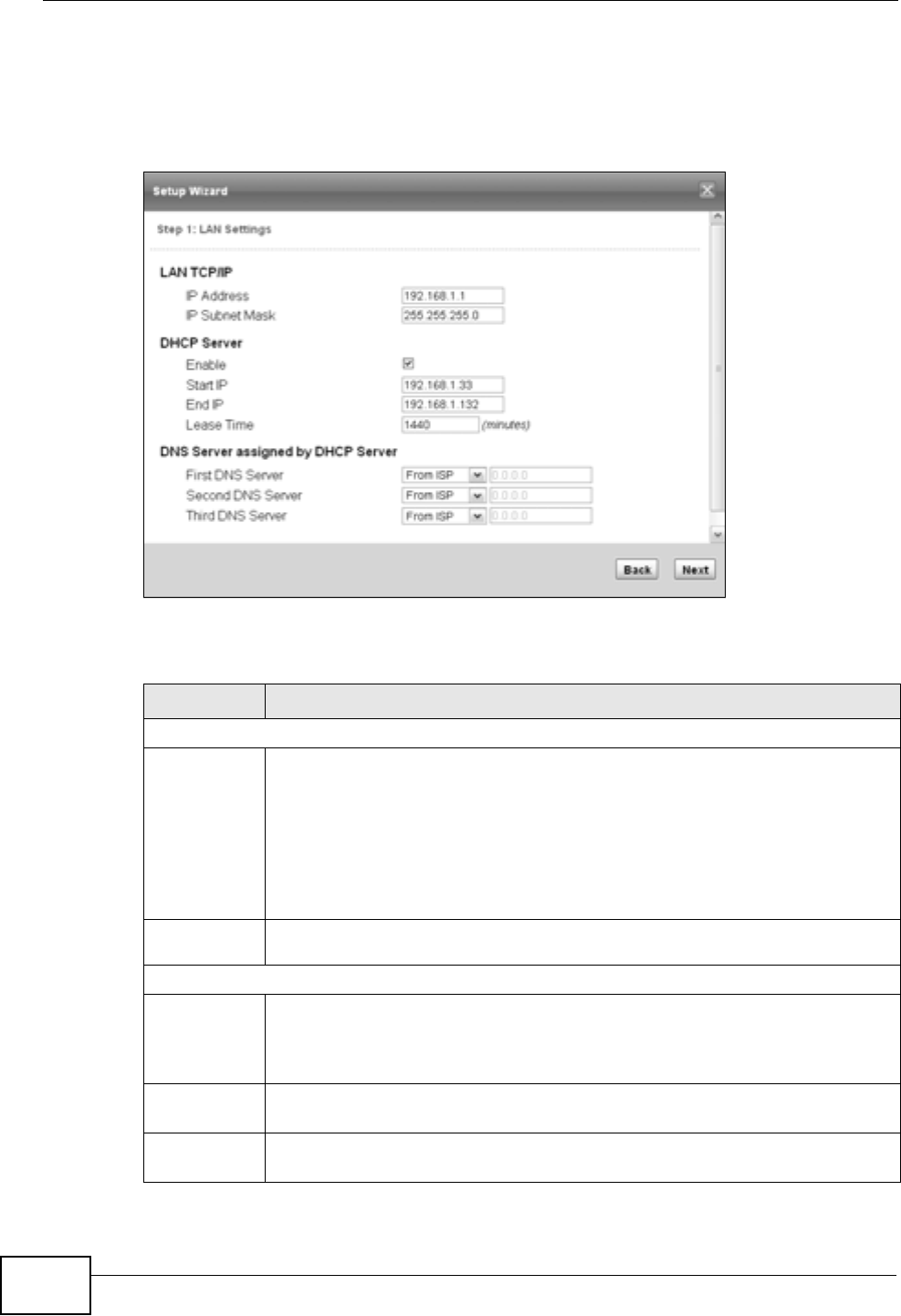
Chapter 3 Setup Wizard
HES-309M Series User’s Guide
24
3.1.2 LAN Settings
The LAN Settings screen allows you to configure your local network options.
Figure 5 Setup Wizard > LAN Settings
The following table describes the labels in this screen.
Table 5 Setup Wizard > LAN Settings
LABEL DESCRIPTION
LAN TCP/IP
IP
Address Enter the IP address of the WiMAX Device on the LAN.
Note: This field is the IP address you use to access the WiMAX Device
on the LAN. If the web configurator is running on a computer on
the LAN, you lose access to it as soon as you change this field.
You can access the web configurator again by typing the new IP
address in the browser.
IP Subnet
Mask Enter the subnet mask of the LAN.
DHCP Server
Enable Select this if you want the WiMAX Device to be the DHCP server on the
LAN. As a DHCP server, the WiMAX Device assigns IP addresses to DHCP
clients on the LAN and provides the subnet mask and DNS server
information.
Start IP Enter the IP address from which the WiMAX Device begins allocating IP
addresses.
End IP Enter the IP address at which the WiMAX Device stops allocating IP
addresses.
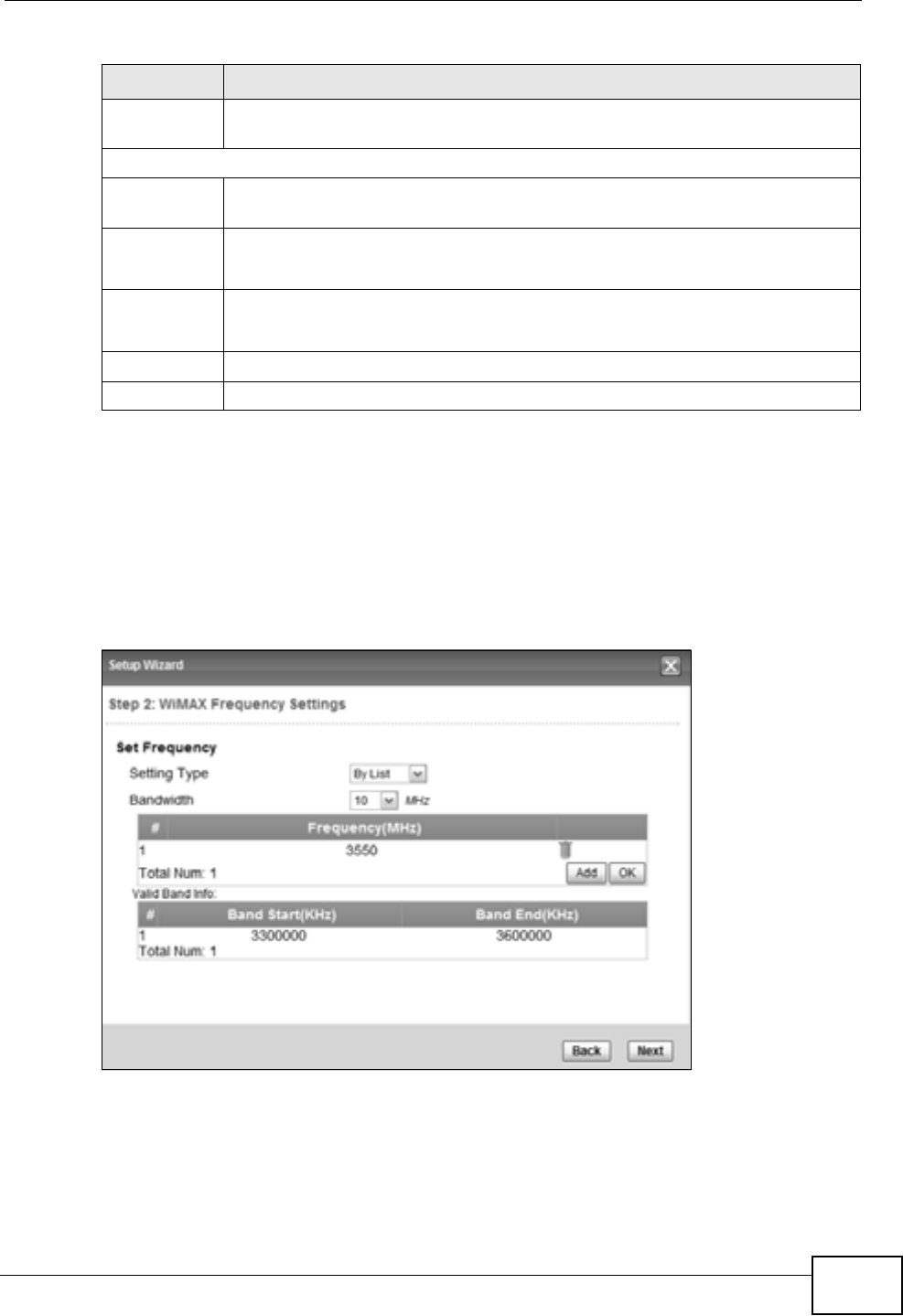
Chapter 3 Setup Wizard
HES-309M Series User’s Guide 25
3.1.3 WiMAX Frequency Settings
The WiMAX Frequency Settings screen allows you to configure the broadcast radio
frequency used by the WiMAX Device.
Note: These settings should be provided by your ISP.
Figure 6 Setup Wizard > WiMAX Frequency Settings
Lease
Time Enter the duration in minutes before the device requests a new IP address
from the DHCP server.
DNS Server assigned by DHCP Server
First DNS
Server Specify the first IP address of three DNS servers that the network can use.
The WiMAX Device provides these IP addresses to DHCP clients.
Second
DNS
Server
Specify the second IP address of three DNS servers that the network can
use. The WiMAX Device provides these IP addresses to DHCP clients.
Third
DNS
Server
Specify the third IP address of three DNS servers that the network can use.
The WiMAX Device provides these IP addresses to DHCP clients.
Back Click to display the previous screen.
Next Click to proceed to the next screen.
Table 5 Setup Wizard > LAN Settings (continued)
LABEL DESCRIPTION

Chapter 3 Setup Wizard
HES-309M Series User’s Guide
26
The following table describes the labels in this screen.
Table 6 Setup Wizard > WiMAX Frequency Settings
LABEL DESCRIPTION
Setting Type Select the WiMAX frequency setting type from the list.
•By Range - Select this to set up the frequency based on
a range of MHz.
•By List - Select this to set up the frequency on an
individual MHz basis. You can add multiple MHz values to
the list.
Step Enter the increments in MHz by which to increase the
frequency range.
Note: This field only appears when you select By Range
under Setting Type.
Start Frequency Enter the frequency value at the beginning of the frequency
range to use. The frequency is increased in increments equal
to the Step value until the End Frequency is reached, at
which time the cycle starts over with the Start Frequency.
Note: This field only appears when you select By Range
under Setting Type.
End Frequency Enter the frequency value at the end of the frequency range
to use.
Note: This field only appears when you select By Range
under Setting Type.
Bandwidth Set the frequency bandwidth in MHz that this WiMAX Device
uses.
# This is an index number for enumeration purposes only.
Frequency (MHz) Displays the frequency MHz for the item in the list.
Total Num Displays the total number of items in the list.
Delete Click this to remove an item from the list.
Add Click this to add an item to the list.
OK Click this to save an newly added item to the list.
# This is an index number for enumeration purposes only.
Band Start (KHz) Indicates the beginning of the frequency band in KHz.
Band End (KHz) Indicates the end of the frequency band in KHz.
Total Num Displays the total number of items in the list.
Back Click to display the previous screen.
Next Click to proceed to the next screen.
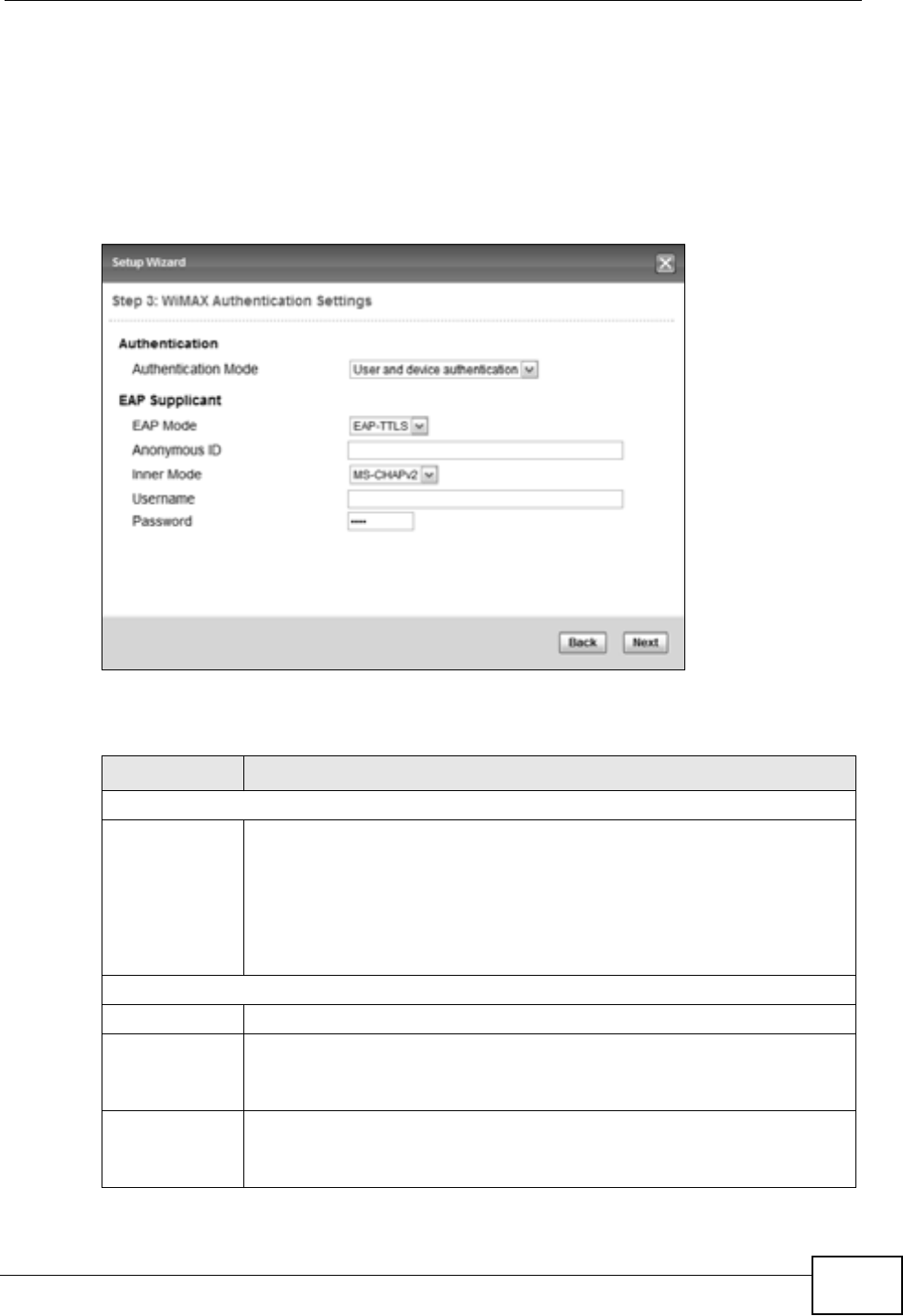
Chapter 3 Setup Wizard
HES-309M Series User’s Guide 27
3.1.4 WiMAX Authentication Settings
The WiMAX Authentication Settings screen allows you to configure how your
WiMAX Device logs into the service provider’s network.
Note: These settings should be provided by your ISP.
Figure 7 Setup Wizard > WiMAX Authentication Settings
The following table describes the labels in this screen.
Table 7 Setup Wizard > WiMAX Authentication Settings
LABEL DESCRIPTION
Authentication
Authenticati
on Mode Select a WiMAX authentication mode for authentication network
sessions with the ISP. Options are:
• No authentication
• User authentication
• Device authentication
• User and Device authentication
EAP Supplication
EAP Mode Select an EAP authentication mode.
Anonymous
Id Enter your anonymous ID.
Note: Some modes may not require this.
Inner Mode Select an inner authentication mode.
Note: Some modes may not require this.
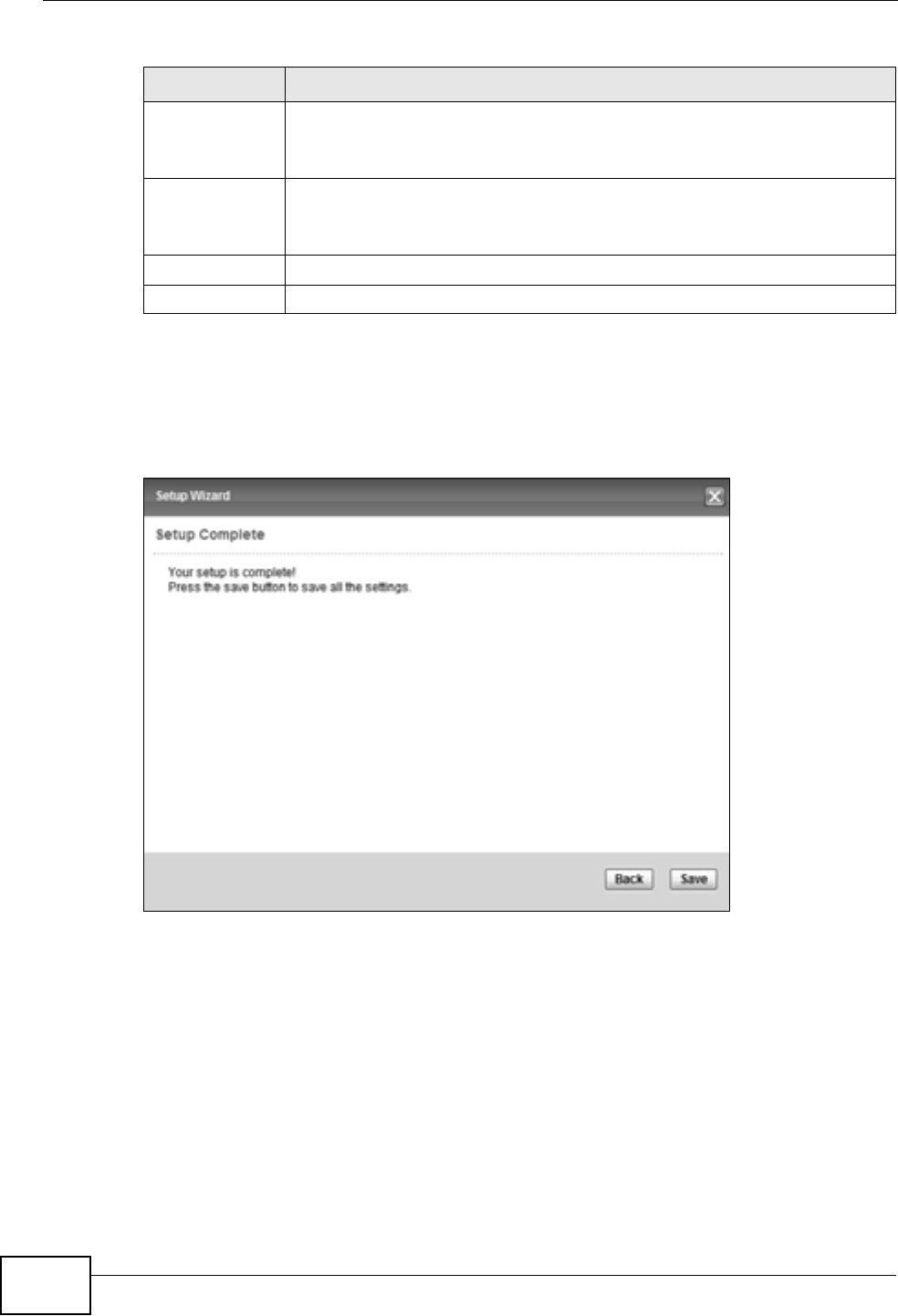
Chapter 3 Setup Wizard
HES-309M Series User’s Guide
28
3.1.5 Setup Complete
Click Save to save the Setup Wizard settings and close it.
Figure 8 Setup Wizard > Setup Complete
Launch your web browser and navigate to www.zyxel.com. If everything was
configured properly, the web page should display. You can now surf the Internet!
Refer to the rest of this guide for more detailed information on the complete range
of WiMAX Device features available in the more advanced web configurator.
Note: If you cannot access the Internet, open the web configurator again to confirm
that the Internet settings you configured in the wizard setup are correct.
Username Enter your authentication username.
Note: Some modes may not require this.
Password Enter your authentication password.
Note: Some modes may not require this.
Back Click to display the previous screen.
Next Click to proceed to the next screen.
Table 7 Setup Wizard > WiMAX Authentication Settings (continued)
LABEL DESCRIPTION

HES-309M Series User’s Guide 29
CHAPTER 4
Tutorials
4.1 Overview
This chapter shows you how to configure some of the WiMAX Device’s features.
Note: Be sure to read The Web Configurator on page 19 before working through the
tutorials presented here. For field descriptions for individual screens, see the
related technical reference in this User's Guide.
This chapter includes the following configuration examples:
•WiMAX Connection Settings on page 29
•Configuring LAN DHCP on page 30
•Changing Certificate on page 32
•Blocking Web Access on page 33
•Configuring the MAC Address Filter, see page 34
•Setting Up NAT Port Forwarding, see page 36
•Access the WiMAX Device Using DDNS, see page 39
•Configuring Static Route for Routing to Another Network, see page 40
•Remotely Managing Your WiMAX Device on page 43
4.2 WiMAX Connection Settings
This tutorial provides you with pointers for configuring the WiMAX Device to
connect to an ISP.
1Connect the WiMAX Device to the ISP’s nearest base station. See Section 6.2 on
page 55.
2Configure the WiMAX Device’s broadcast frequency. Section 6.3 on page 57.
3Configure the WiMAX Device to connect securely to the ISP’s authentication
servers. See Section 6.4 on page 60.
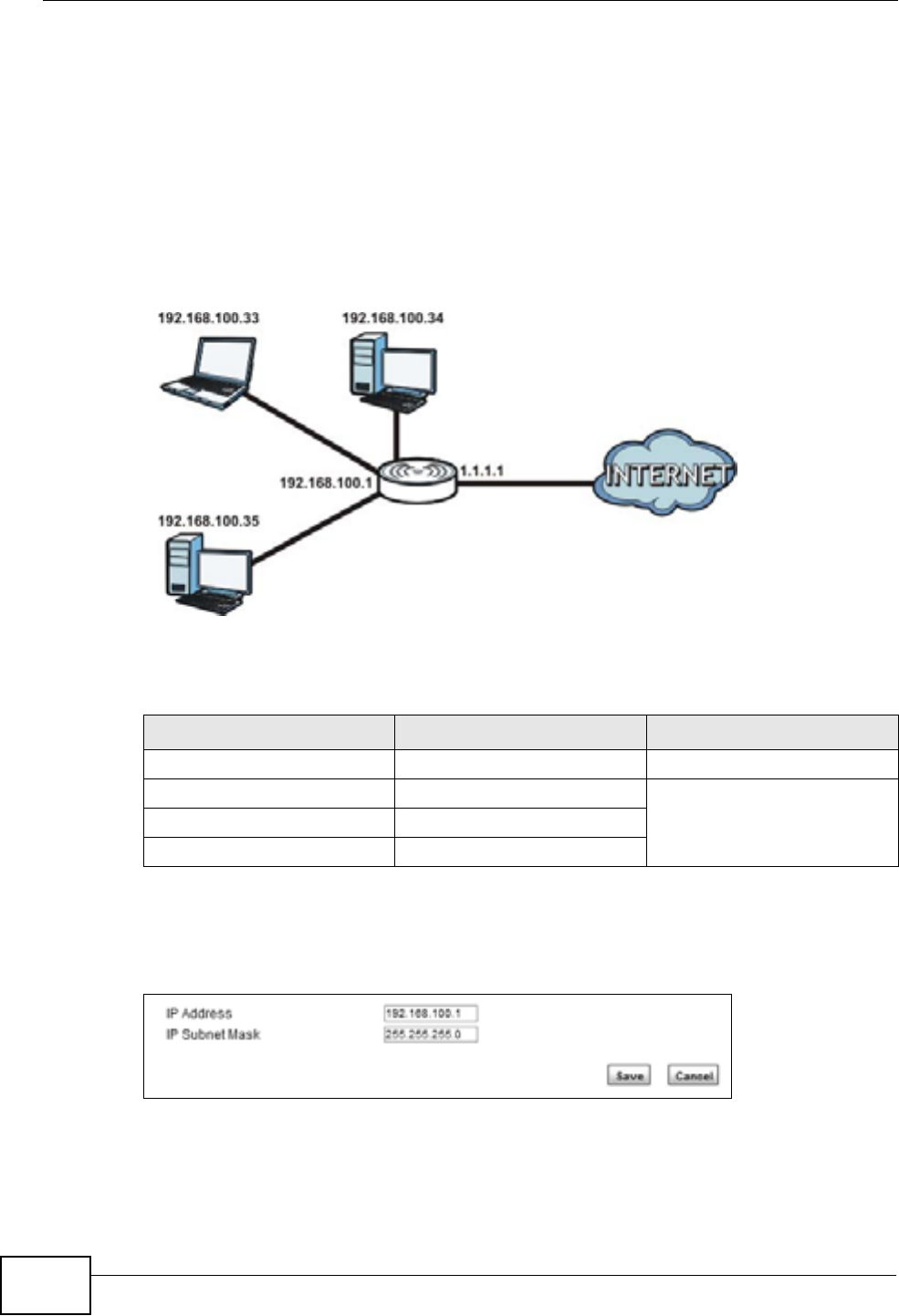
Chapter 4 Tutorials
HES-309M Series User’s Guide
30
4Check the WiMAX Device’s connection status to ensure everything is working
properly. See Section 6.7 on page 67.
4.3 Configuring LAN DHCP
This tutorial shows you how to set up a small network in your office or home.
Goal: Connect three computers to your WiMAX Device to form a small network.
Required: The following table provides a summary of the information you will
need to complete the tasks in this tutorial.
1In the Web Configurator, open the Networking Setting > LAN screen and set
the IP Address to 192.168.100.1. Use the default IP Subnet Mask of
255.255.255.0. Click Save.
2Manually change the IP address of your computer that your are using to
192.168.100.x (for example, 192.168.100.5) and keep the subnet set to
255.255.255.0.
INFORMATION VALUE SEE ALSO
LAN IP Address 192.168.100.1 Chapter 7 on page 83
Starting IP Address 192.168.100.10 Chapter 7 on page 84
Ending IP Address 192.168.100.30
DNS Servers From ISP
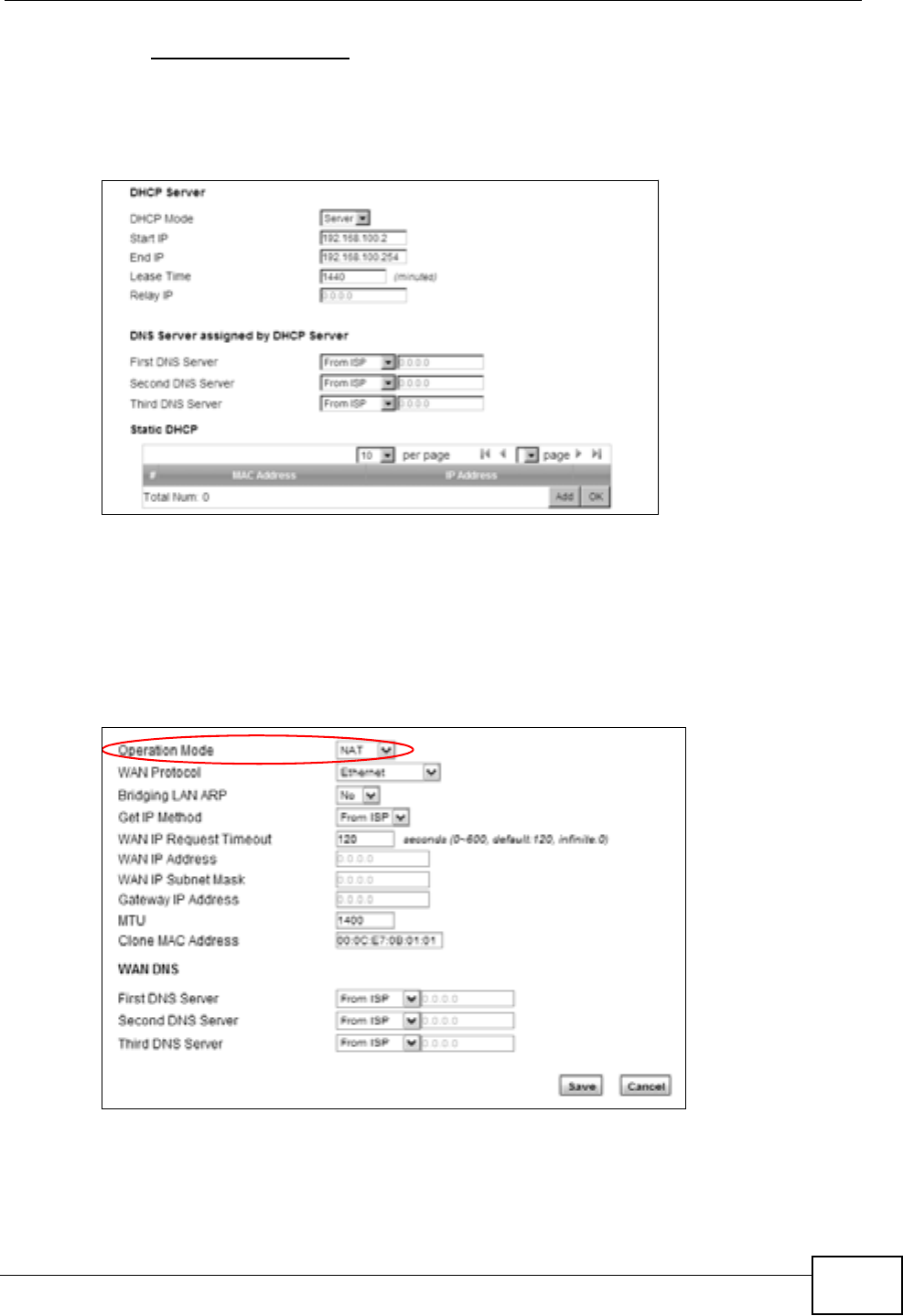
Chapter 4 Tutorials
HES-309M Series User’s Guide 31
3Type http://192.168.100.1 in your browser after the WiMAX Device finishes
starting up completely.
4Log into the Web Configurator and open the Networking Setting > LAN >
DHCP screen.
5Select Server for the DHCP mode, then enter 192.168.100.10 and
192.168.100.30 as your DHCP starting and ending IP addresses.
6Leave the other settings as their defaults and click Save.
7Next, go to the Networking Setting > WAN screen and select NAT in the
Operation Mode field. Click Save.
8Connect your computers to the WiMAX Device’s Ethernet ports and you’re all set!
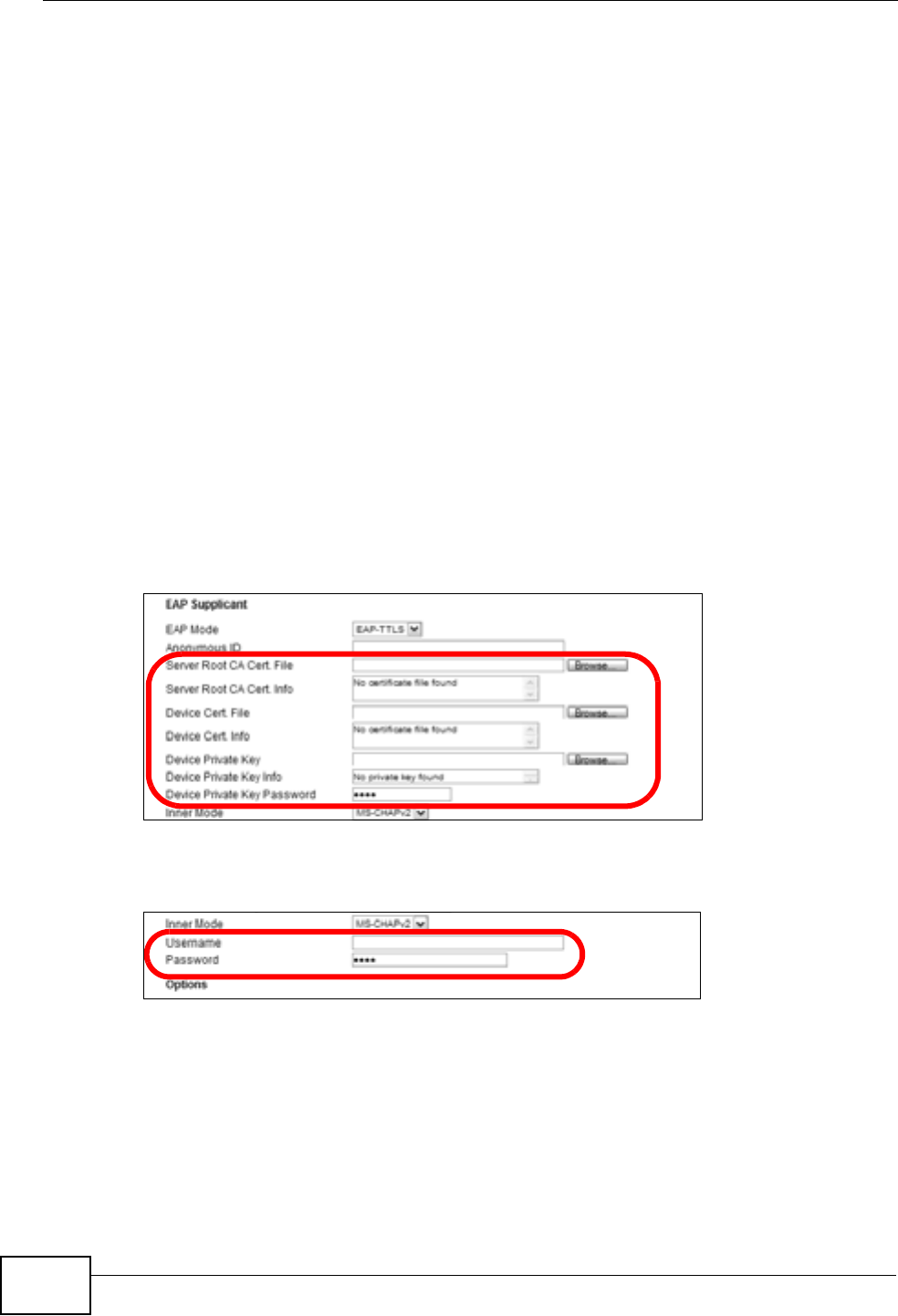
Chapter 4 Tutorials
HES-309M Series User’s Guide
32
Note: You may need to configure the computers on your LAN to automatically obtain
IP addresses. For information on how to do this, see Appendix B on page 151.
Once your network is configured and hooked up, you will want to connect it to the
Internet next. To do this, just run the Internet Connection Wizard (Chapter 3
on page 23), which walks you through the process.
4.4 Changing Certificate
This tutorial shows you how to import a new security certificate, which allows your
device to communicate with another network servers.
Goal: Import a new security certificate into the WiMAX Device.
See Also:Appendix E on page 201.
1Go to the WiMAX > Profile > Authentication Settings screen. In the EAP
Supplicant section, click each Browse button and locate the security certificates
that were provided by your new ISP.
s
2Configure your new Internet access settings based on the information provided by
the ISP.
Note: You can also use the Internet Connection Wizard to configure the Internet
access settings.

Chapter 4 Tutorials
HES-309M Series User’s Guide 33
3You may need to configure the Options section according to the information
provided by the ISP.
4Click Save. You should now be able to connect to the Internet through your new
service provider!
4.5 Blocking Web Access
If your WiMAX Device is in a home or office environment you may decide that you
want to block an Internet website access. You may need to block both the
website’s IP address and domain name.
Goal: Configure the WiMAX Device’s content filter to block a website with a
domain name www.example.com.
See Also:Section 7.16 on page 102.
1Open the Networking Setting > Content Filter.
2Select Enable URL Filter.
3Select Blacklist.
4Click Add and configure a URL filter rule by selecting Active and entering
www.example.com as the URL.
5Click OK.

Chapter 4 Tutorials
HES-309M Series User’s Guide
34
6Click Save.
Open a browser from your computer in the WiMAX Device’s LAN network, you
should get an “Access Violation” message when you try to access to http://
www.example.com. You may also need to block the IP address of the website if
you do not want users to access to the website through its IP address.
4.6 Configuring the MAC Address Filter
This tutorial shows you how to use the MAC filter to block a DHCP client’s access to
hosts and to the WiMAX network.
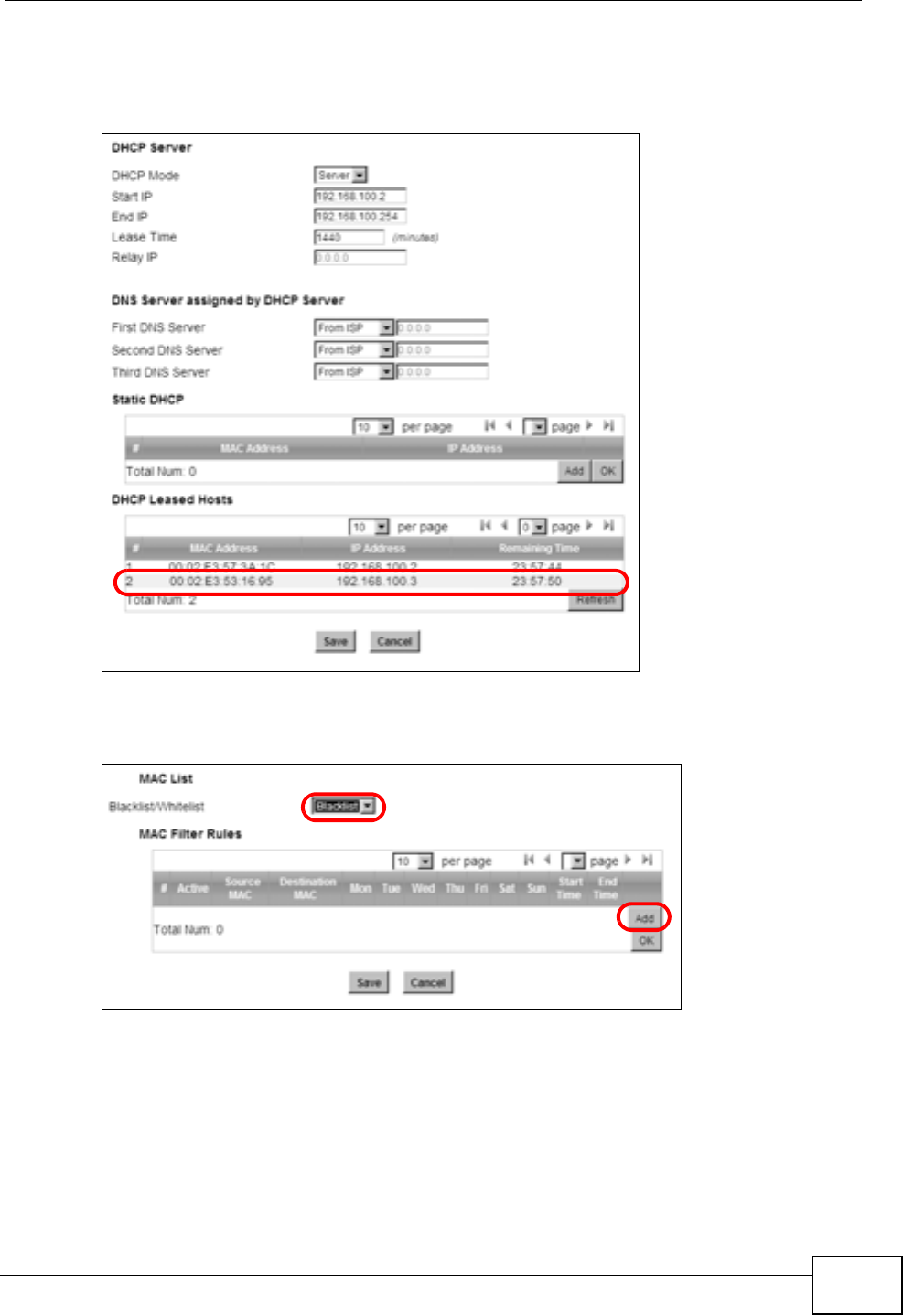
Chapter 4 Tutorials
HES-309M Series User’s Guide 35
1First of all, you have to know the MAC address of the computer. If not, you can
look for the MAC address in the Network Setting > LAN > DHCP screen.
(192.168.100.3 mapping to 00:02:E3:53:16:95 in this example).
2Click Security > Firewall >MAC Filter. Select Blacklist and click the Add
button in the MAC Filter Rules table.
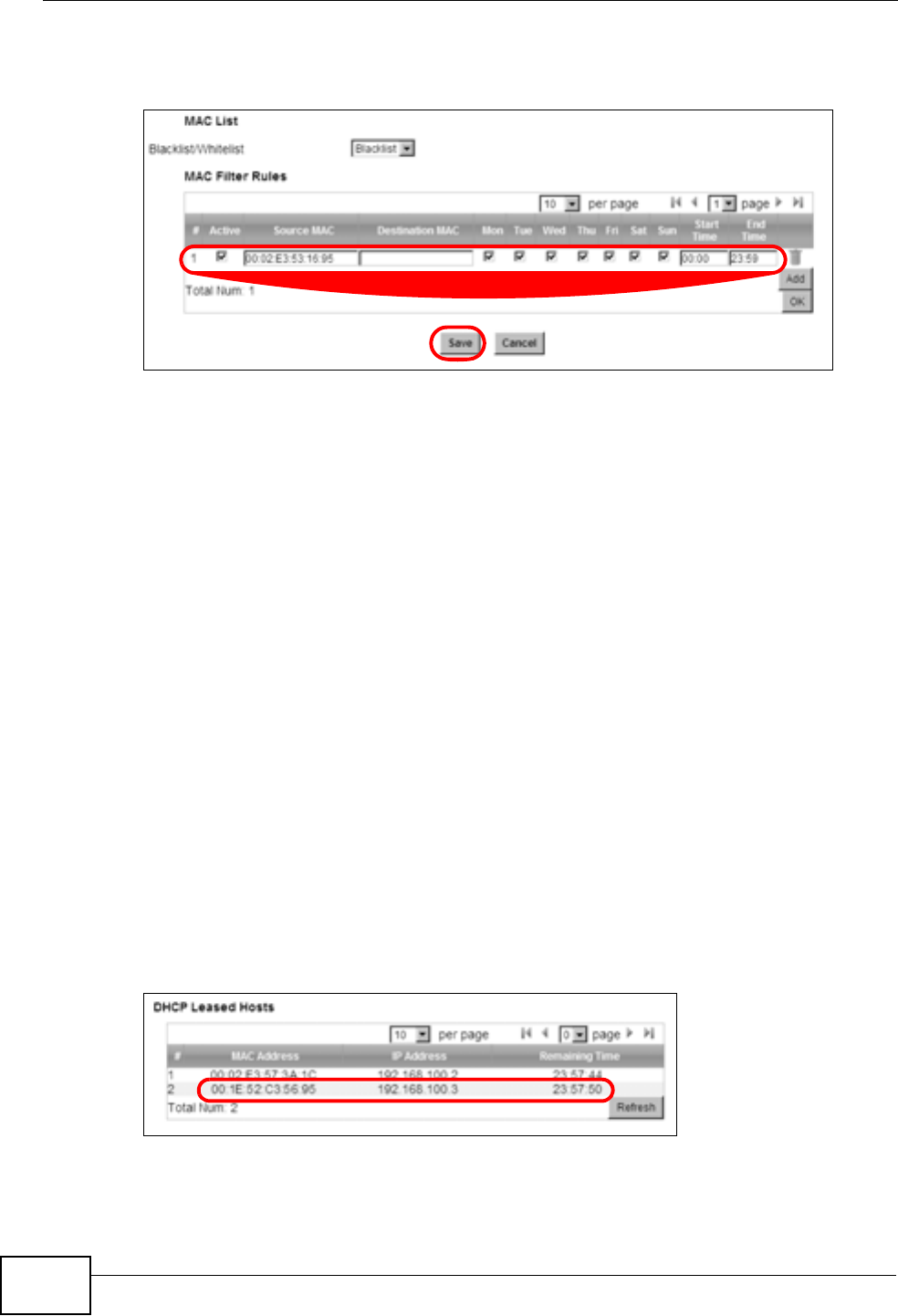
Chapter 4 Tutorials
HES-309M Series User’s Guide
36
3An empty entry appears. Enter the computer’s MAC address in the Source MAC
field and leave the other fields set to their defaults. Click Save.
The computer will no longer be able to access any host on the WiMAX network
through the WiMAX Device.
4.7 Setting Up NAT Port Forwarding
Thomas recently received an Xbox 360 as his birthday gift. His friends invited him
to play online games with them on Xbox LIVE. In order to communicate and play
with other gamers on Xbox LIVE, Thomas needs to configure the port settings on
his WiMAX Device.
Xbox 360 requires the following ports to be available in order to operate Xbox
LIVE correctly:
TCP: 53, 80, 3074
UDP: 53, 88, 3074
1You have to know the Xbox 360’s IP address first. You can check it through the
Xbox 360 console. You may be able to check the IP address on the WiMAX Device
if the WiMAX Device has assigned a DHCP IP address to the Xbox 360. Check the
DHCP Leased Hosts table in the Network > LAN > DHCP screen. Look for the
IP address for the Xbox 360.
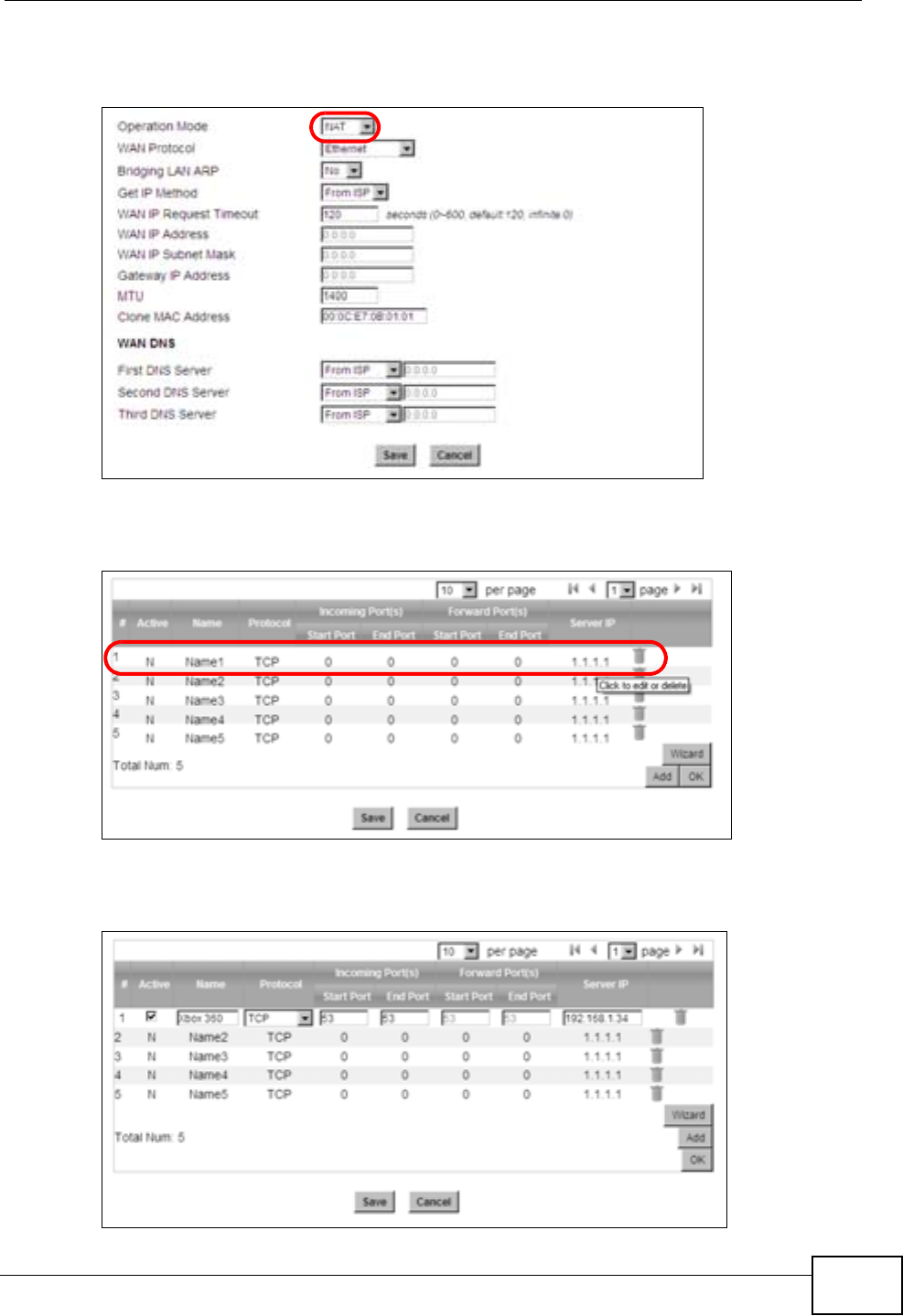
Chapter 4 Tutorials
HES-309M Series User’s Guide 37
2NAT mode is required to use port forwarding. Click Network Setting > WAN and
make sure NAT is selected in the Operation Mode field. Click Save.
3Click Network Setting > NAT > Port Forwarding and then click the first entry
to edit the rule.
4Configure the screen as follows to open TCP/UDP port 53 for the Xbox 360. Click
OK.
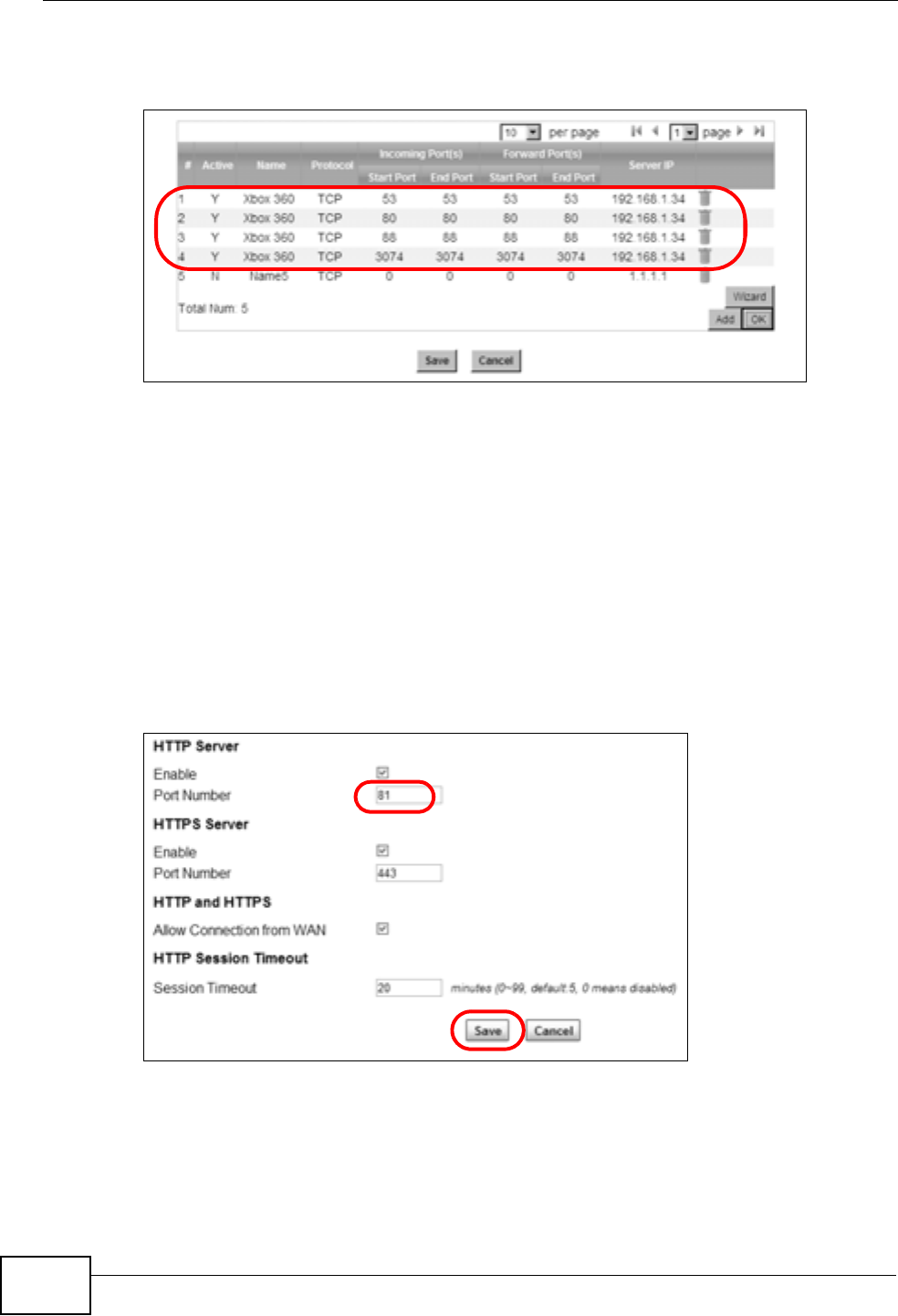
Chapter 4 Tutorials
HES-309M Series User’s Guide
38
5Repeat steps 2 and 3 to open the rest of the ports for the Xbox 360. The port
forwarding settings you configured are listed in the Port Forwarding screen.
6Click Save.
Thomas can then connect his Xbox 360 to the Internet and play online games with
his friends.
In this tutorial, all port 80 traffic is forwarded to the Xbox 360, but port 80 is also
the default listening port for remote management via WWW. If Thomas also wants
to manage the WiMAX Device from the Internet, he has to assign an unused port
to WWW remote access.
Click Advanced > Remote MGMT. Enter an unused port in the Port field (81 in
this example). Click Save.
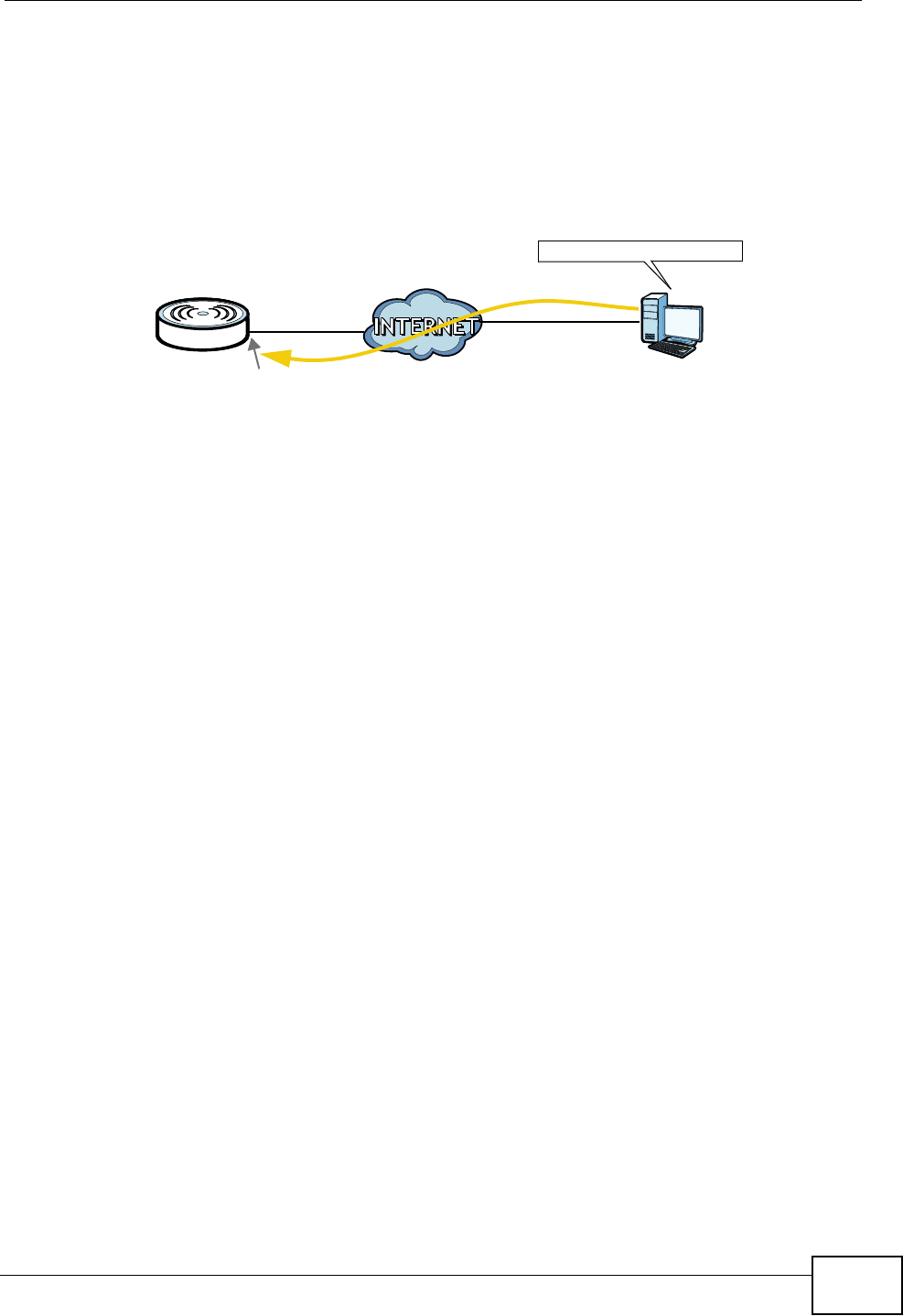
Chapter 4 Tutorials
HES-309M Series User’s Guide 39
4.8 Access the WiMAX Device Using DDNS
If you connect your WiMAX Device to the Internet and it uses a dynamic WAN IP
address, it is inconvenient for you to manage the device from the Internet. The
WiMAX Device’s WAN IP address changes dynamically. Dynamic DNS (DDNS)
allows you to access the WiMAX Device using a domain name.
To use this feature, you have to apply for DDNS service at www.dyndns.org.
This tutorial covers:
•Registering a DDNS Account on www.dyndns.org
•Configuring DDNS on Your WiMAX Device
•Testing the DDNS Setting
Note: If you have a private WAN IP address (see Private IP Addresses on page 198),
then you cannot use DDNS.
4.8.1 Registering a DDNS Account on www.dyndns.org
1Open a browser and type http://www.dyndns.org.
2Apply for a user account. This tutorial uses UserName1 and 12345 as the
username and password.
3Log into www.dyndns.org using your account.
4Add a new DDNS host name. This tutorial uses the following settings as an
example.
• Hostname: mywimax.dyndns.org
•Service Type: Host with IP address
• IP Address: Enter the WAN IP address that your WiMAX Device is currently
using. You can find the IP address on the WiMAX Device’s Web Configurator
Status page.
Then you will need to configure the same account and host name on the WiMAX
Device later.
w.x.y.z a.b.c.d
http://mywimax.dyndns.org
A
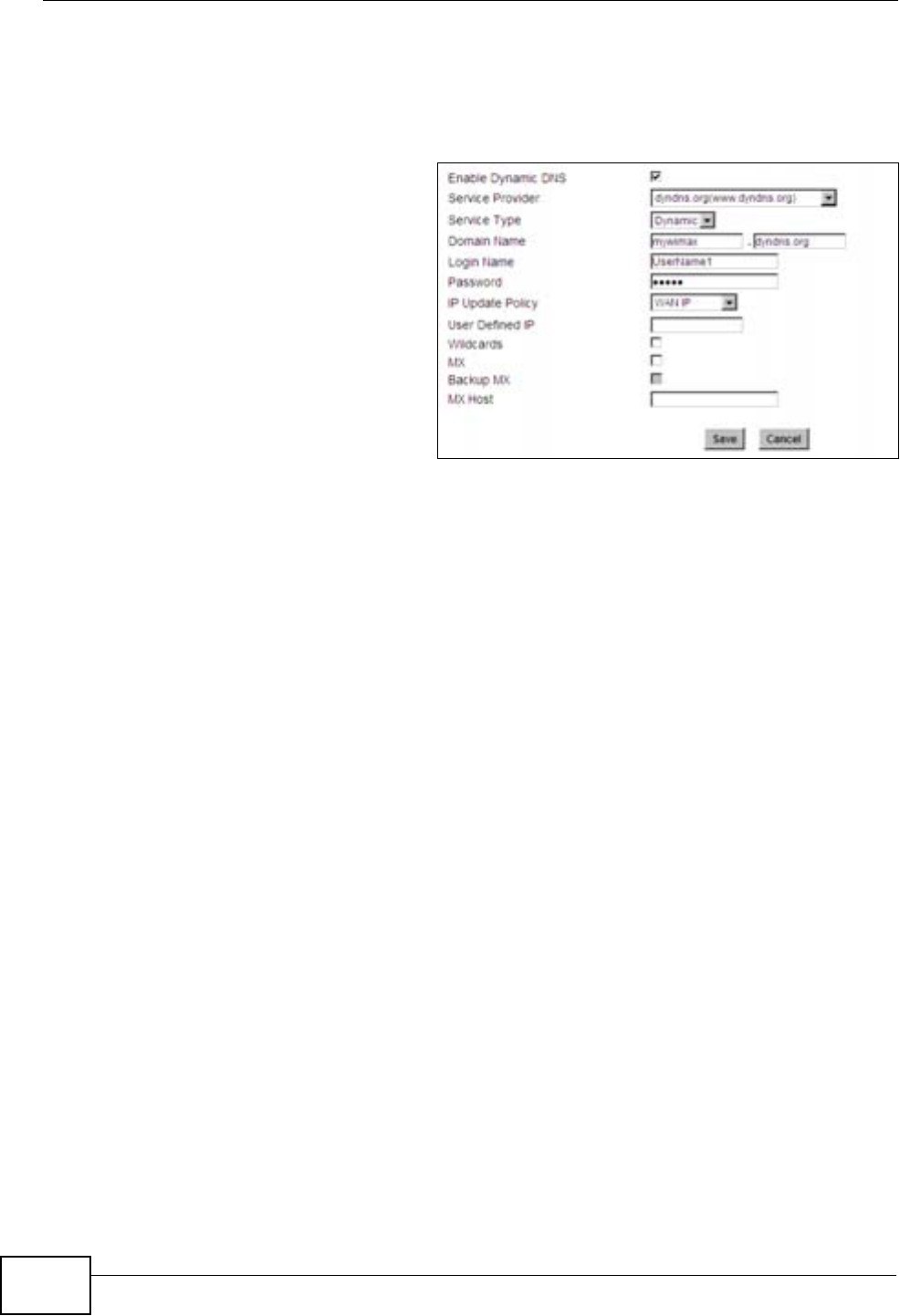
Chapter 4 Tutorials
HES-309M Series User’s Guide
40
4.8.2 Configuring DDNS on Your WiMAX Device
Configure the following settings in the Network Setting > DDNS screen.
1Select Enable Dynamic DNS.
2Select dyndns.org for the
service provider.
3Select Dynamic for the
service type.
4Type mywimax.dyndns.org
in the Domain Name field.
5Enter the user name
(UserName1) and password
(12345).
6Select WAN IP for the IP update policy.
7Click Save.
4.8.3 Testing the DDNS Setting
Now you should be able to access the WiMAX Device from the Internet. To test
this:
1Open a web browser on the computer (using the IP address a.b.c.d) that is
connected to the Internet.
2Type http://mywimax.dyndns.org and press [Enter].
3The WiMAX Device’s login page should appear. You can then log into the WiMAX
Device and manage it.
4.9 Configuring Static Route for Routing to
Another Network
In order to extend your Intranet and control traffic flowing directions, you may
connect a router to the WiMAX Device’s LAN. The router may be used to separate
two department networks. This tutorial shows how to configure a static routing
rule for two network routings.
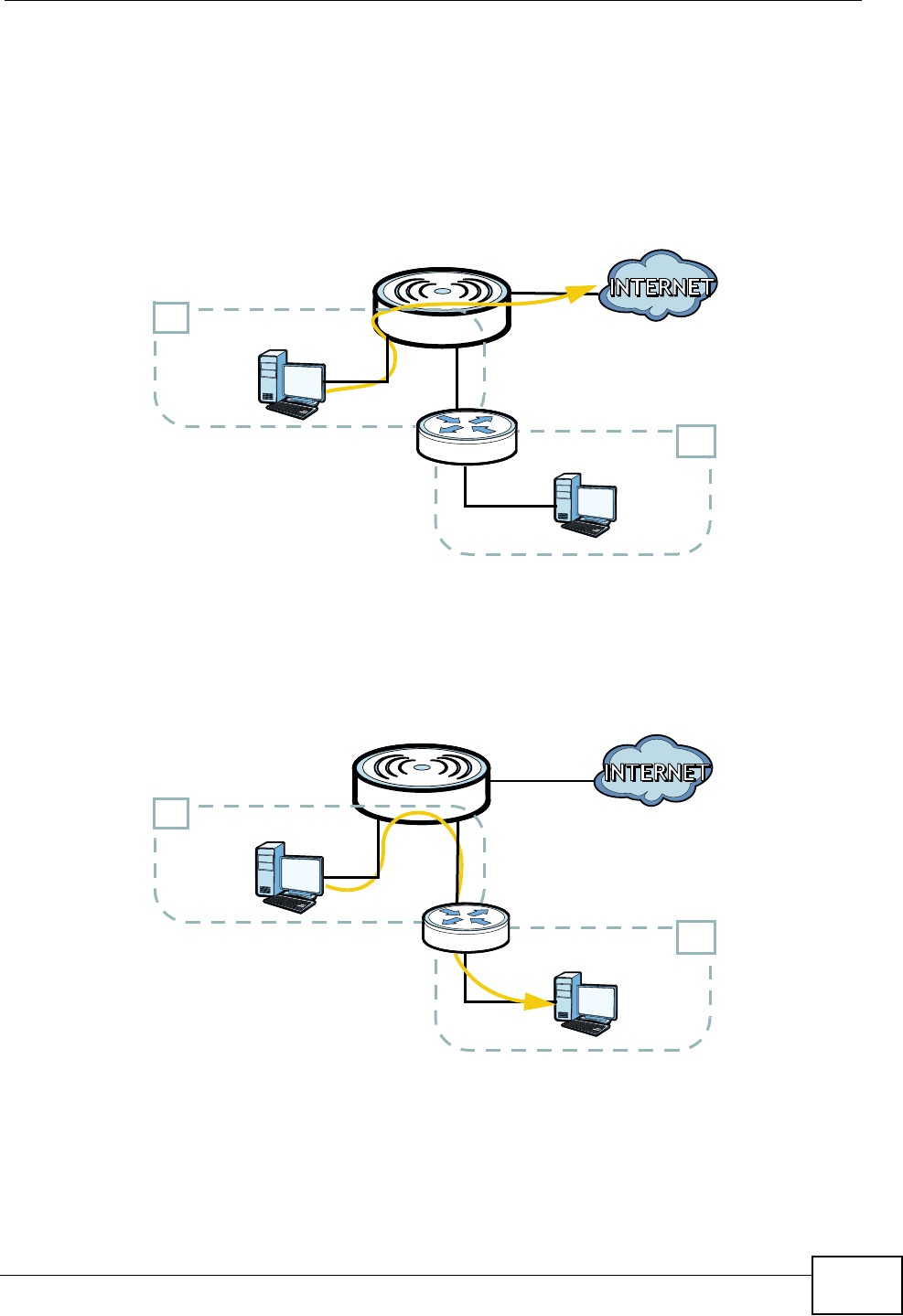
Chapter 4 Tutorials
HES-309M Series User’s Guide 41
In the following figure, router R is connected to the WiMAX Device’s LAN. R
connects to two networks, N1 (192.168.1.x/24) and N2 (192.168.10.x/24). If
you want to send traffic from computer A (in N1 network) to computer B (in N2
network), the traffic is sent to the WiMAX Device’s WAN default gateway by
default. In this case, computer B will never receive the traffic.
You need to specify a static routing rule on the WiMAX Device to specify R as the
router in charge of forwarding traffic to N2. In this case, the WiMAX Device routes
traffic from computer A to R and then R routes the traffic to computer B.
N2
B
A
R
N1
N2
B
N1
A
R
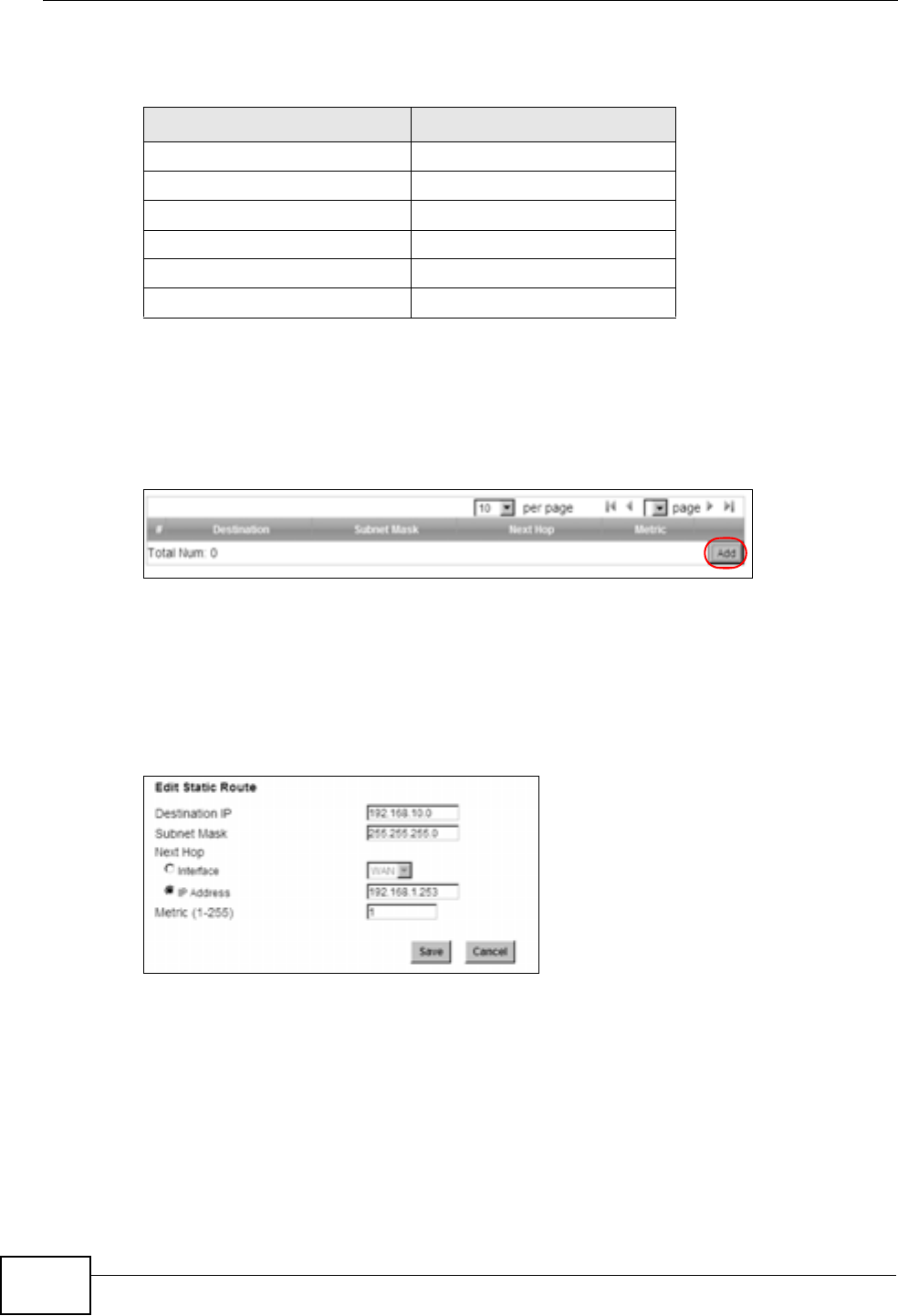
Chapter 4 Tutorials
HES-309M Series User’s Guide
42
This tutorial uses the following example IP settings:
To configure a static route to route traffic from N1 to N2:
1Click Network Setting > Route > Static Route.
2Click Add to create a new route.
3Configure the Edit Static Route screen using the following settings:
3a Enter 192.168.10.0 and subnet mask 255.255.255.0 for the destination,
N2.
3b Enter 192.168.1.253 (R’s IP address on N1) in the IP Address field under
Next Hop.
3a Click Save.
Now computer B should be able to receive traffic from computer A. You may need
to additionally configure R’s firewall settings to accept specific traffic to pass
through.
Table 8 IP Settings in this Tutorial
DEVICE / COMPUTER IP ADDRESS
The WiMAX Device’s WAN 172.16.1.1
The WiMAX Device’s LAN 192.168.1.1
A192.168.1.34
R’s IP address on N1 192.168.1.253
R’s IP address on N2 192.168.10.2
B192.168.10.33
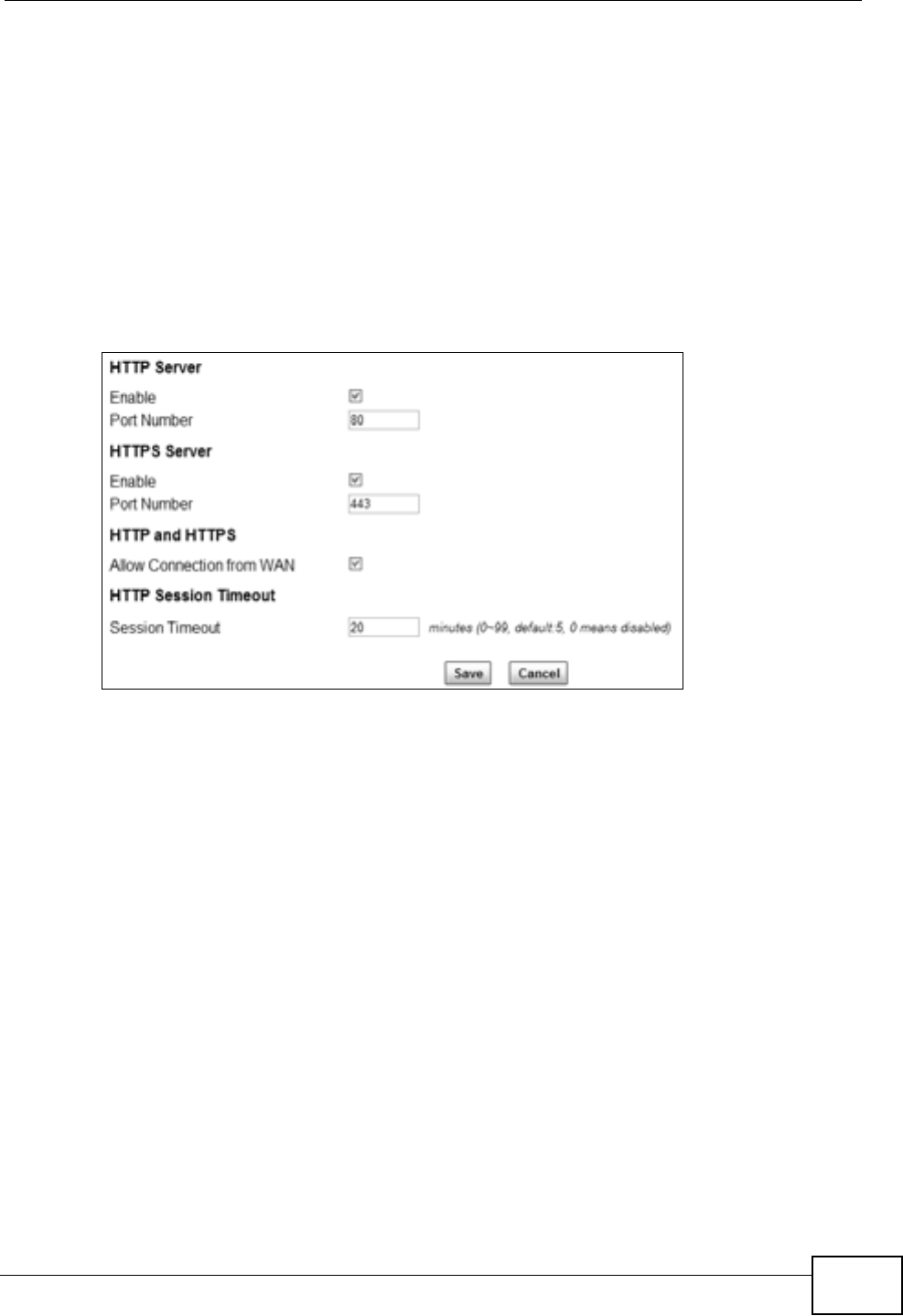
Chapter 4 Tutorials
HES-309M Series User’s Guide 43
4.10 Remotely Managing Your WiMAX Device
The remote management feature allows you to log into the device through the
Internet.
Goal: Set up the WiMAX Device to allow management requests from the WAN
(Internet).
See Also:Section 9.3 on page 119.
1Open the Maintenance > Remote MGMT > HTTP screen.
2Select Enable in both HTTP Server and HTTPS Server sections and leave the
Port Number settings as “80” and “443”.
3Select Allow Connection from WAN. This allows remote management
connections not only from the local network but also the WAN network (Internet).
4Click Save.

Chapter 4 Tutorials
HES-309M Series User’s Guide
44

45
PART II
Technical Reference

46
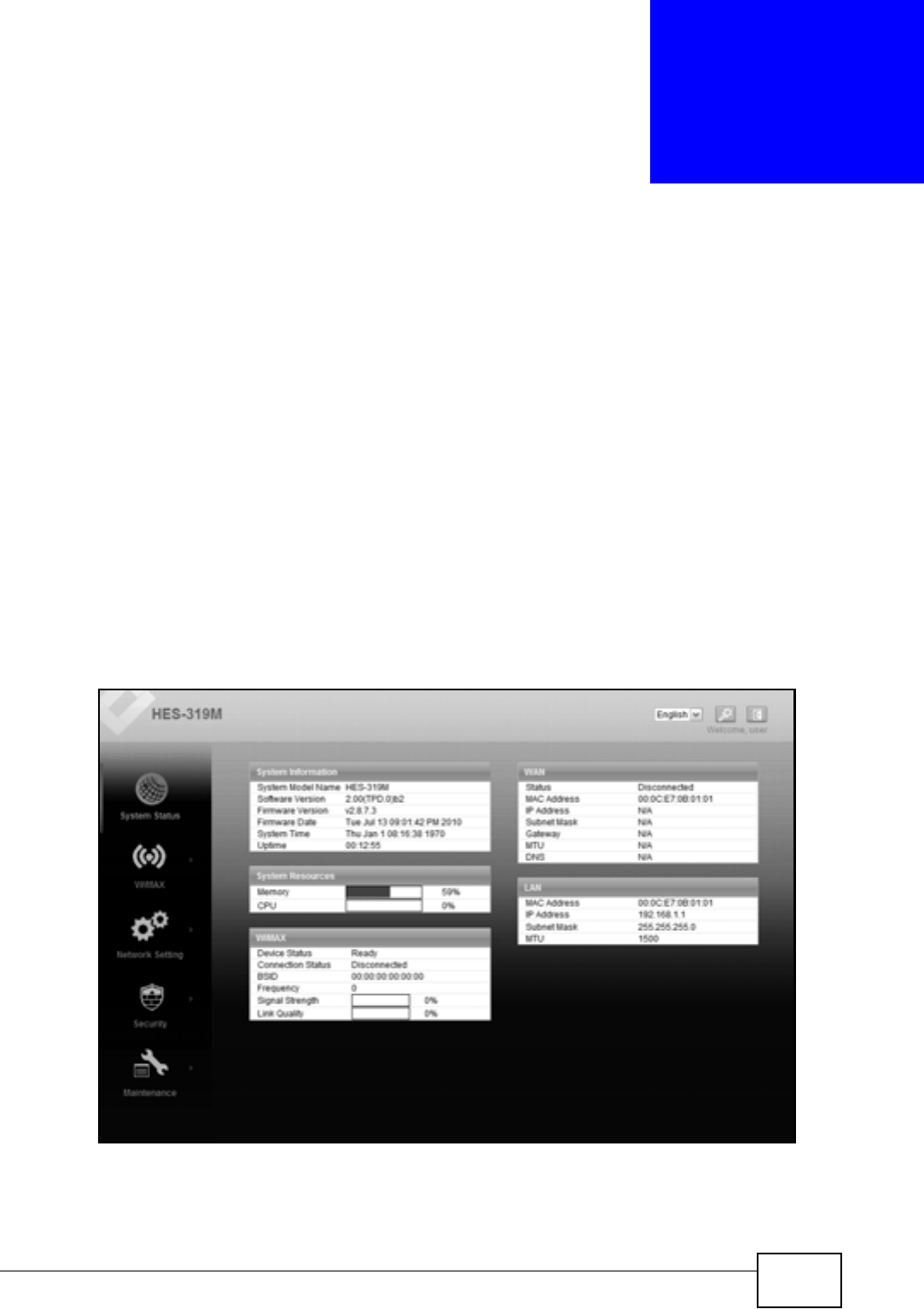
HES-309M Series User’s Guide 47
CHAPTER 5
System Status
5.1 Overview
Use this screen to view a summary of your WiMAX Device connection status.
5.2 System Status
This screen allows you to view the current status of the device, system resources,
and interfaces (LAN and WAN).
Click System Status to open this screen as shown next.
Figure 9 System Status

Chapter 5 System Status
HES-309M Series User’s Guide
48
The following tables describe the labels in this screen.
Table 9 Status
LABEL DESCRIPTION
System Information
System
Model Name This field displays the WiMAX Device system model name. It is used for
identification.
Software
Version This field displays the Web Configurator version number.
Firmware
Version This field displays the current version of the firmware inside the device.
Firmware
Build Time This field shows the date the firmware version was created.
Time This field displays the current system time.
Uptime This field displays how long the WiMAX Device has been running since it
last started up.
System Resources
Memory This field displays what percentage of the WiMAX Device’s memory is
currently used. The higher the memory usage, the more likely the
WiMAX Device is to slow down. Some memory is required just to start
the WiMAX Device and to run the web configurator. You can reduce the
memory usage by disabling some services; by reducing the amount of
memory allocated to NAT and firewall rules (you may have to reduce
the number of NAT rules or firewall rules to do so); or by deleting rules
in functions such as incoming call policies, speed dial entries, and static
routes.
CPU This field displays what percentage of the WiMAX Device’s CPU is
currently used. The higher the CPU usage, the more likely the WiMAX
Device is to slow down.
WiMAX
Device
Status This field displays the WiMAX Device current status for connecting to
the selected base station.
Scanning - The WiMAX Device is scanning for available base stations.
Ready - The WiMAX Device has finished a scanning and you can
connect to a base station.
Connecting - The WiMAX Device attempts to connect to the selected
base station.
Connected - The WiMAX Device has successfully connected to the
selected base station.
UMAC State This field displays the status of the WiMAXconnection between the
WiMAX Device and the base station.
Network Search - The WiMAX Device is scanning for any available
WiMAX connections.
Disconnected - No WiMAX connection is available.
Network Entry - A WiMAX connection is initializing.
Normal - The WiMAX connection has successfully established.

Chapter 5 System Status
HES-309M Series User’s Guide 49
BSID This field displays the MAC address of the base station to which the
device is connected.
Frequency This field indicates the frequency the WiMAX Device is using.
Signal
Strength This field indicates the strength of the connection that the WiMAX
Device has with the base station.
Link Quality This field indicates the relative quality of the link the WiMAX Device has
with the base station.
WAN
Status This field indicates the status of the WAN connection to the WiMAX
Device.
MAC
Address This field indicates the MAC address of the port making the WAN
connection on the WiMAX Device.
IP Address This field indicates the current IP address of the WiMAX Device in the
WAN.
Subnet Mask This field indicates the current subnet mask on the WAN.
Gateway This field indicates the IP address of the gateway to which the WiMAX
Device is connected.
MTU This field indicates the Maximum Transmission Unit (MTU) between the
WiMAX Device and the ISP servers to which it is connected.
DNS This field indicates the Domain Name Server (DNS) to which your
WiMAX Device is connected.
LAN
MAC
Address This field indicates the MAC address of the port making the LAN
connection on the WiMAX Device.
IP Address This field displays the current IP address of the WiMAX Device in the
LAN.
Subnet Mask This field displays the current subnet mask in the LAN.
MTU This field indicates the Maximum Transmission Unit (MTU) between the
WiMAX Device and the client devices to which it is connected.
Table 9 Status (continued)
LABEL DESCRIPTION

Chapter 5 System Status
HES-309M Series User’s Guide
50
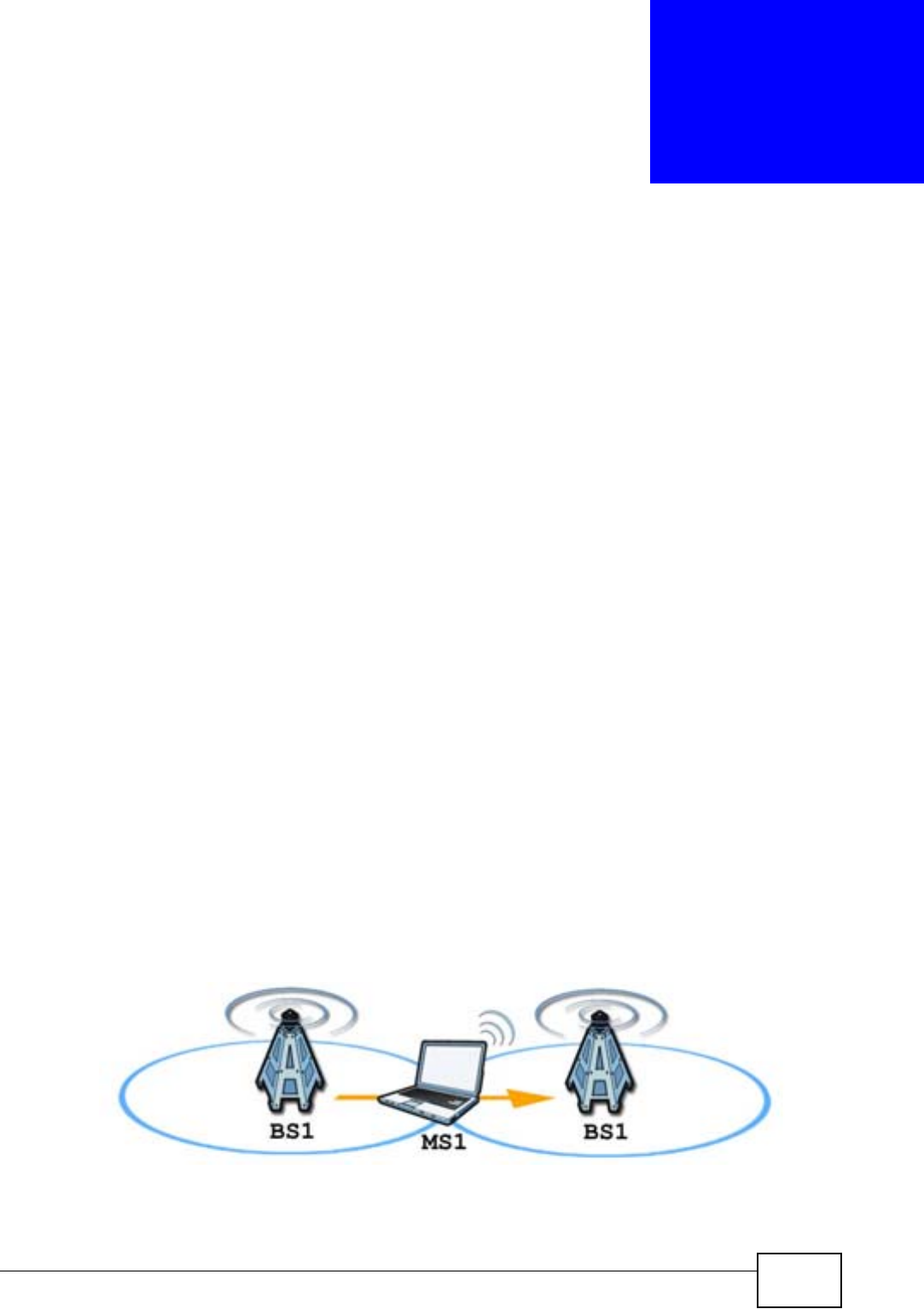
HES-309M Series User’s Guide 51
CHAPTER 6
WiMAX
6.1 Overview
This chapter shows you how to set up and manage the connection between the
WiMAX Device and your ISP’s base stations.
6.1.1 What You Need to Know
The following terms and concepts may help as you read through this chapter.
WiMAX
WiMAX (Worldwide Interoperability for Microwave Access) is the IEEE 802.16
wireless networking standard, which provides high-bandwidth, wide-range
wireless service across wireless Metropolitan Area Networks (MANs). ZyXEL is a
member of the WiMAX Forum, the industry group dedicated to promoting and
certifying interoperability of wireless broadband products.
In a wireless MAN, a wireless-equipped computer is known either as a mobile
station (MS) or a subscriber station (SS). Mobile stations use the IEEE 802.16e
standard and are able to maintain connectivity while switching their connection
from one base station to another base station (handover) while subscriber stations
use other standards that do not have this capability (IEEE 802.16-2004, for
example). The following figure shows an MS-equipped notebook computer MS1
moving from base station BS1’s coverage area and connecting to BS2.
Figure 10 WiMax: Mobile Station
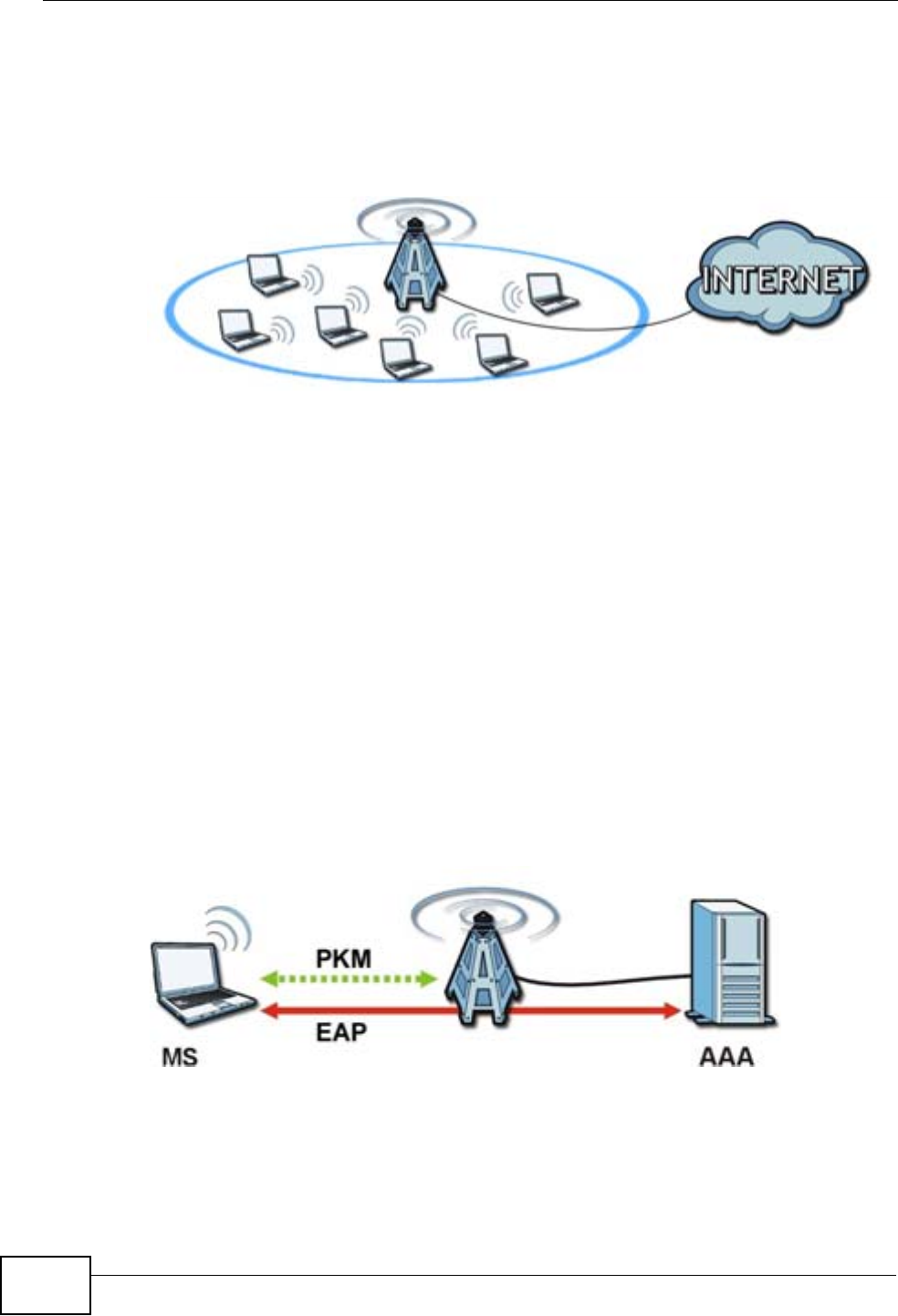
Chapter 6 WiMAX
HES-309M Series User’s Guide
52
WiMAX technology uses radio signals (around 2 to 10 GHz) to connect subscriber
stations and mobile stations to local base stations. Numerous subscriber stations
and mobile stations connect to the network through a single base station (BS), as
in the following figure.
Figure 11 WiMAX: Multiple Mobile Stations
A base station’s coverage area can extend over many hundreds of meters, even
under poor conditions. A base station provides network access to subscriber
stations and mobile stations, and communicates with other base stations.
The radio frequency and bandwidth of the link between the WiMAX Device and the
base station are controlled by the base station. The WiMAX Device follows the
base station’s configuration.
Authentication
When authenticating a user, the base station uses a third-party RADIUS or
Diameter server known as an AAA (Authentication, Authorization and Accounting)
server to authenticate the mobile or subscriber stations.
The following figure shows a base station using an AAA server to authenticate
mobile station MS, allowing it to access the Internet.
Figure 12 Using an AAA Server
In this figure, the dashed arrow shows the PKM (Privacy Key Management)
secured connection between the mobile station and the base station, and the solid
arrow shows the EAP secured connection between the mobile station, the base
station and the AAA server. See the WiMAX security appendix for more details.
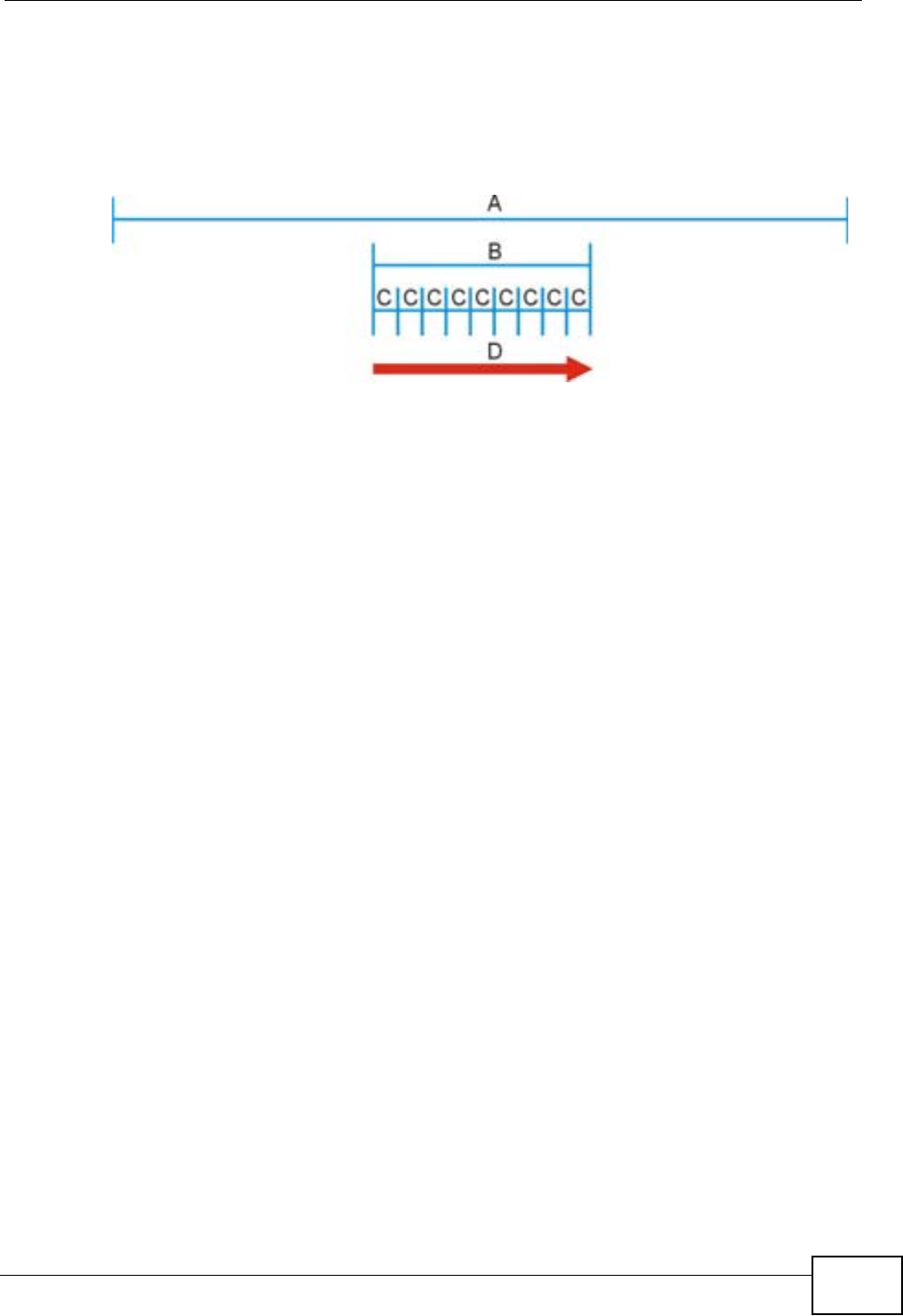
Chapter 6 WiMAX
HES-309M Series User’s Guide 53
Frequency Ranges
The following figure shows the WiMAX Device searching a range of frequencies to
find a connection to a base station.
Figure 13 Frequency Ranges
In this figure, A is the WiMAX frequency range. “WiMAX frequency range” refers to
the entire range of frequencies the WiMAX Device is capable of using to transmit
and receive (see the Product Specifications appendix for details).
In the figure, B shows the operator frequency range. This is the range of
frequencies within the WiMAX frequency range supported by your operator
(service provider).
The operator range is subdivided into bandwidth steps. In the figure, each C is a
bandwidth step.
The arrow D shows the WiMAX Device searching for a connection.
Have the WiMAX Device search only certain frequencies by configuring the
downlink frequencies. Your operator can give you information on the supported
frequencies.
The downlink frequencies are points of the frequency range your WiMAX Device
searches for an available connection. Use the Site Survey screen to set these
bands. You can set the downlink frequencies anywhere within the WiMAX
frequency range. In this example, the downlink frequencies have been set to
search all of the operator range for a connection.
Certification Authority
A Certification Authority (CA) issues certificates and guarantees the identity of
each certificate owner. There are commercial certification authorities like
CyberTrust or VeriSign and government certification authorities. You can use the
WiMAX Device to generate certification requests that contain identifying
information and public keys and then send the certification requests to a
certification authority.

Chapter 6 WiMAX
HES-309M Series User’s Guide
54
Certificate File Formats
The certification authority certificate that you want to import has to be in one of
these file formats:
• Binary X.509: This is an ITU-T recommendation that defines the formats for
X.509 certificates.
• PEM (Base-64) encoded X.509: This Privacy Enhanced Mail format uses
lowercase letters, uppercase letters and numerals to convert a binary X.509
certificate into a printable form.
• Binary PKCS#7: This is a standard that defines the general syntax for data
(including digital signatures) that may be encrypted. The WiMAX Device
currently allows the importation of a PKS#7 file that contains a single
certificate.
• PEM (Base-64) encoded PKCS#7: This Privacy Enhanced Mail (PEM) format uses
64 ASCII characters to convert a binary PKCS#7 certificate into a printable
form.
CINR
Carrier to Interference-plus-Noise Ratio (CINR) measures the effectiveness of a
wireless signal and plays an important role in allowing the WiMAX Device to
decode signal burts. If a burst has a high signal strength and a high interference-
plus-noise ratio, it can use Digital Signal Processing (DSP) to decode it; if the
signal strength is lower, it can switch to an alternate burst profile.
RSSI
Received Signal Strength Indicator (RSSI) measures the relative strength of a
given wireless signal. This is important in determining if a signal is below the
Clear-To-Send (CTS) threshold. If it is below the arbitrarily specified threshold,
then WiMAX Device is free to transmit any data packets.
EAP Authentication
EAP (Extensible Authentication Protocol) is an authentication protocol that runs on
top of the IEEE 802.1x transport mechanism in order to support multiple types of
user authentication. By using EAP to interact with an EAP-compatible RADIUS
server, an access point helps a wireless station and a RADIUS server perform
authentication.
The WiMAX Device supports EAP-TLS and EAP-TTLS (at the time of writing, TTLS is
not available in Windows Vista) . For EAP-TLS authentication type, you must first
have a wired connection to the network and obtain the certificate(s) from a
certificate authority (CA). Certificates (also called digital IDs) can be used to
authenticate users and a CA issues certificates and guarantees the identity of each
certificate owner.
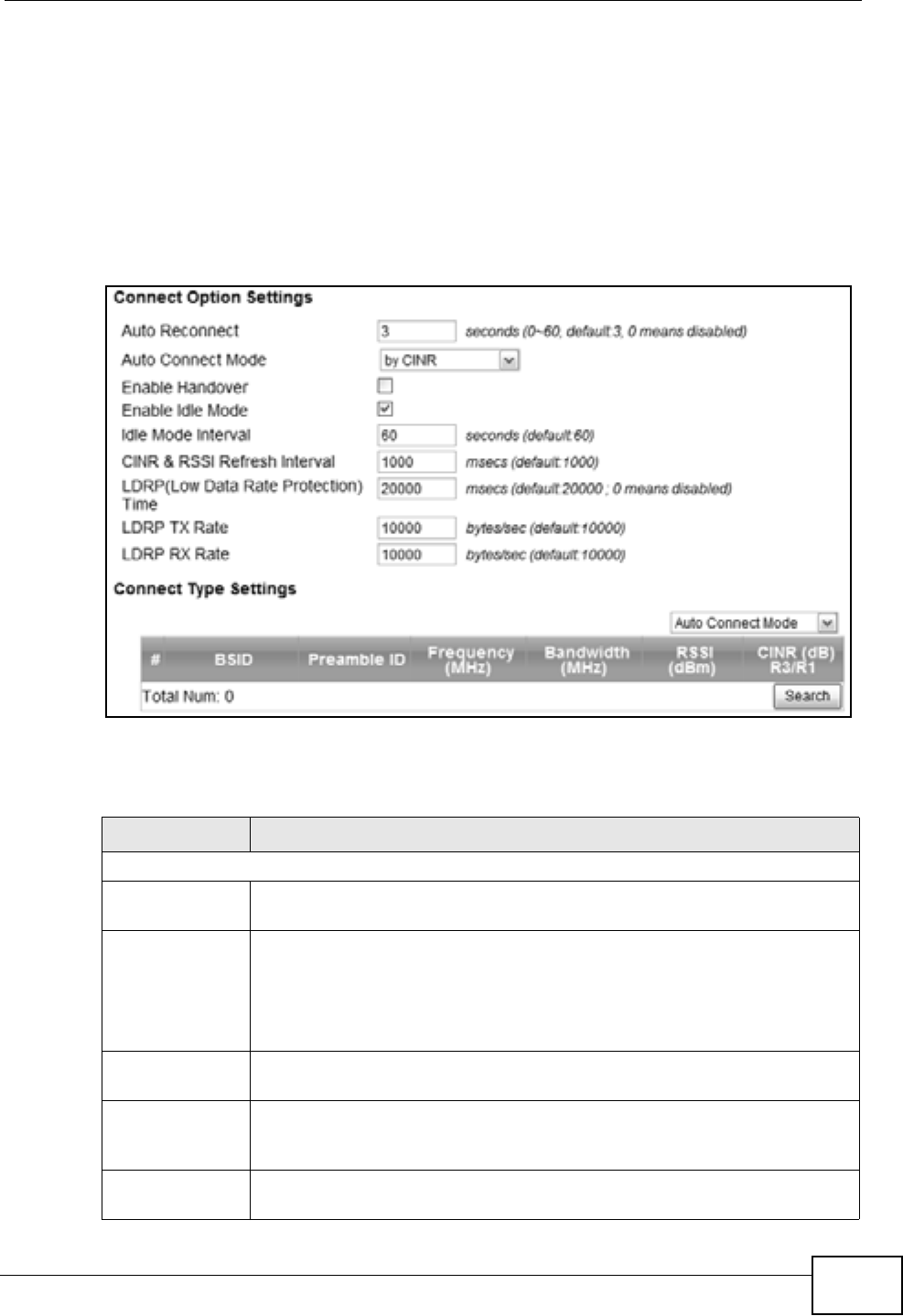
Chapter 6 WiMAX
HES-309M Series User’s Guide 55
6.2 Connection Settings
This screen allows you to configure how the WiMAX Device connects to the base
stations on the WiMAX network.
Click WiMAX > Profile > Connection Settings to open this screen as shown
next.
Figure 14 Connection Settings Screen
This screen contains the following fields:
Table 10 Connection Settings
LABEL DESCRIPTION
Connection Option Settings
Auto
Reconnect Select the interval in seconds that the WiMAX Device waits after getting
disconnected from the base station before attempting to reconnect.
Auto
Connect
Mode
Select the auto connect mode.
•By channel power - Auto connects to the base station if the signal
strength of the channel is sufficient for the WiMAX Device.
•By CINR - Auto connects to the base station if the signal-to-noise
ratio is sufficient for the WiMAX Device.
Enable
Handover Select this to maintain connectivity while the WiMAX Device switches its
connection from one base station to another base station.
Enable Idle
Mode Select this to have the WiMAX Device enter the idle mode after it has no
traffic passing through for a pre-defined period. Make sure your base
station also supports this before selecting this.
Idle Mode
Interval Set the idle duration in minutes. This is how long the WiMAX Device
waits during periods of no activity before going into idle mode.

Chapter 6 WiMAX
HES-309M Series User’s Guide
56
CINR & RSSI
Refresh
Interval
Set the refresh interval in milliseconds for calculating the signal-to-
noise measurement (CINR) and signal strength measurement (RSSI) of
the WiMAX Device.
LDRP (Low
Data Rate
Protection)
Enter the Low Data Rate Protection (LDRP) time in milliseconds. If the
uplink/downlink data rate is smaller than the LDRP time, the WiMAX
Device sends a disconnect request to the base station.
LDRP TX
Rate Enter the outgoing data rates for LDRP in bytes per second.
LDRP RX
Rate Enter the incoming data rates for LDRP in bytes per second.
Connection Type Settings
Mode Select Select how the WiMAX Device connects to the base station.
•Auto Connect Mode - The device connects automatically to the
first base station in range.
•Network Search Mode - The device scans for available base
stations then connects to the best one it can.
BSID This displays the MAC address of a base station within range of the
WiMAX Device.
Preamble ID The preamble ID is the index identifier in the header of the base
station’s broadcast messages. In the beginning of a mobile stations’s
network entry process, it searches for the preamble and uses it to
additional channel information.
The preamble ID is used to synchronize the upstream and downstream
transmission timing with the base station.
Frequency
(MHz) This field displays the radio frequency of the WiMAX Device’s connection
to the base station.
Bandwidth
(MHz) This field displays the bandwidth of the base station in megahertz
(MHz).
RSSI (dBm) This field displays the Received Signal Strength Indication (RSSI),
which is an overal measurement of radio signal strength. A higher RSSI
level indicates a stronger signal.
CINR (dB)
R3/R1 This field displays the average Carrier to Interference plus Noise Ratio
for the current connection. This value is an indication of overal radio
signal quality, where a higher value means a better quality signal.
Search Click this to have the WiMAX Device scan for base stations.
Table 10 Connection Settings (continued)
LABEL DESCRIPTION
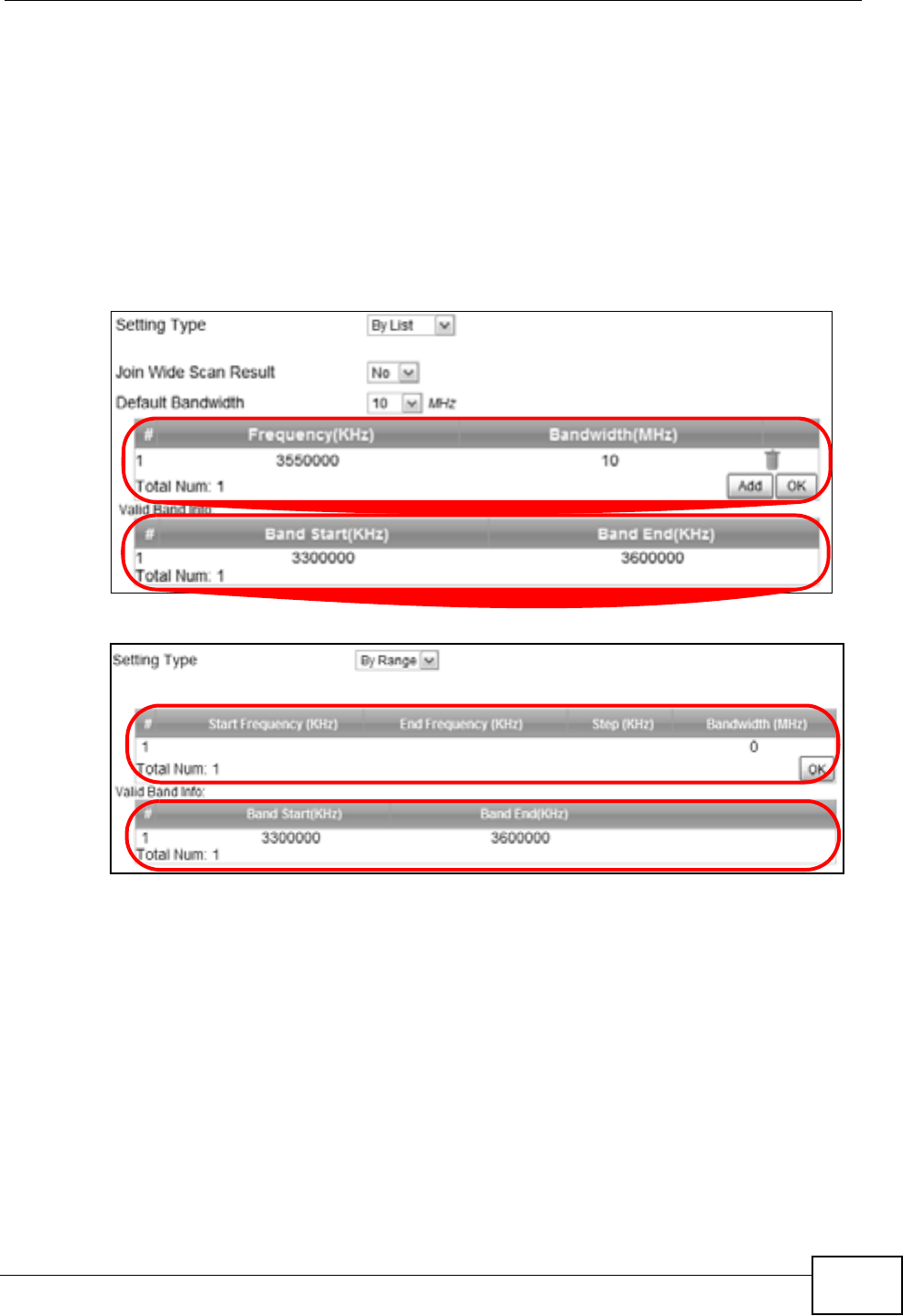
Chapter 6 WiMAX
HES-309M Series User’s Guide 57
6.3 Frequency Settings
Use this screen to have the WiMAX Device to scan one or more specific radio
frequencies (given by your WiMAX service provider) to find available connections
to base stations.
Click WiMAX > Profile > Frequency Settings to open this screen as shown
next.
Figure 15 Frequency Settings Screen (By List)
Figure 16 Frequency Settings Screen (By Range)
A
B
A
B

Chapter 6 WiMAX
HES-309M Series User’s Guide
58
This screen contains the following fields:
Table 11 Frequency Settings
LABEL DESCRIPTION
Setting Type Select whether to scan base stations by entering specific frequency(-
ies) (By List) or a range of frequencies (By Range).
Note: When you select By Range, you can only configure one
range of frequencies in this screen. To configure multiple
frequency ranges, use the WiMAX > Wide Scan screen.
Note: Some settings in this screen are only available depending on
the Setting Type selected.
Join Wide Scan
Result
The scanning result of the frequency to scan you configured in this
screen will be shown in the WiMAX > Connect screen. Select this
option to determine whether to also append the wide scanning result
(configured in the WiMAX > Wide Scan screen) to the same table.
Default
Bandwidth
Select the default bandwidth (size) per frequency band you specify in
table A.
A (When By List is selected in the Setting Type field)
Frequency
(KHz) This displays the center frequency of an frequency band in kilohertz
(KHz).
Click the number to modify it.
Enter the center frequency in this field when you are adding an entry.
Bandwidth
(MHz) This displays the bandwidth of the frequency band in megahertz (MHz).
If you set a center frequency to 3400000 KHz with the bandwidth of 10
MHz, then the frequency band is from 3300500 to 3400500 KHz.
Click the number to modify it.
Enter the bandwidth of the frequency band in this field when you are
adding an entry.
Delete Click this button to remove an item from the list.
Add Click this button to add an item to the list.
OK Click this button to save any changes made to the list.
A (When By Range is selected in the Setting Type field)
Start
Frequency
(KHz)
This indicates the beginning of a frequency band in kilohertz (KHz).
Click this field to modify it.
Enter the beginning frequency when you are adding an entry.
End
Frequency
(KHz)
This indicates the end of the frequency band in kilohertz (KHz).
Click this field to modify it.
Step (KHz) This indicates the frequency step within each band in kilohertz (KHz).
Click this field to modify it.
Bandwidth
(MHz) This indicates the bandwidth in megahertz (MHz).
Click this field to modify it.

Chapter 6 WiMAX
HES-309M Series User’s Guide 59
OK Click this button to save any changes made to the list.
Valid Band Info (B)
This table displays the entire frequency band the WiMAX Device supports. The
frequenc(ies) to scan that you configured in table A must be within this range.
Band Start
(KHz) This indicates the beginning of the frequency band in kilohertz (KHz).
Band End
(KHz) This indicates the end of the frequency band in kilohertz (KHz).
Table 11 Frequency Settings (continued)
LABEL DESCRIPTION
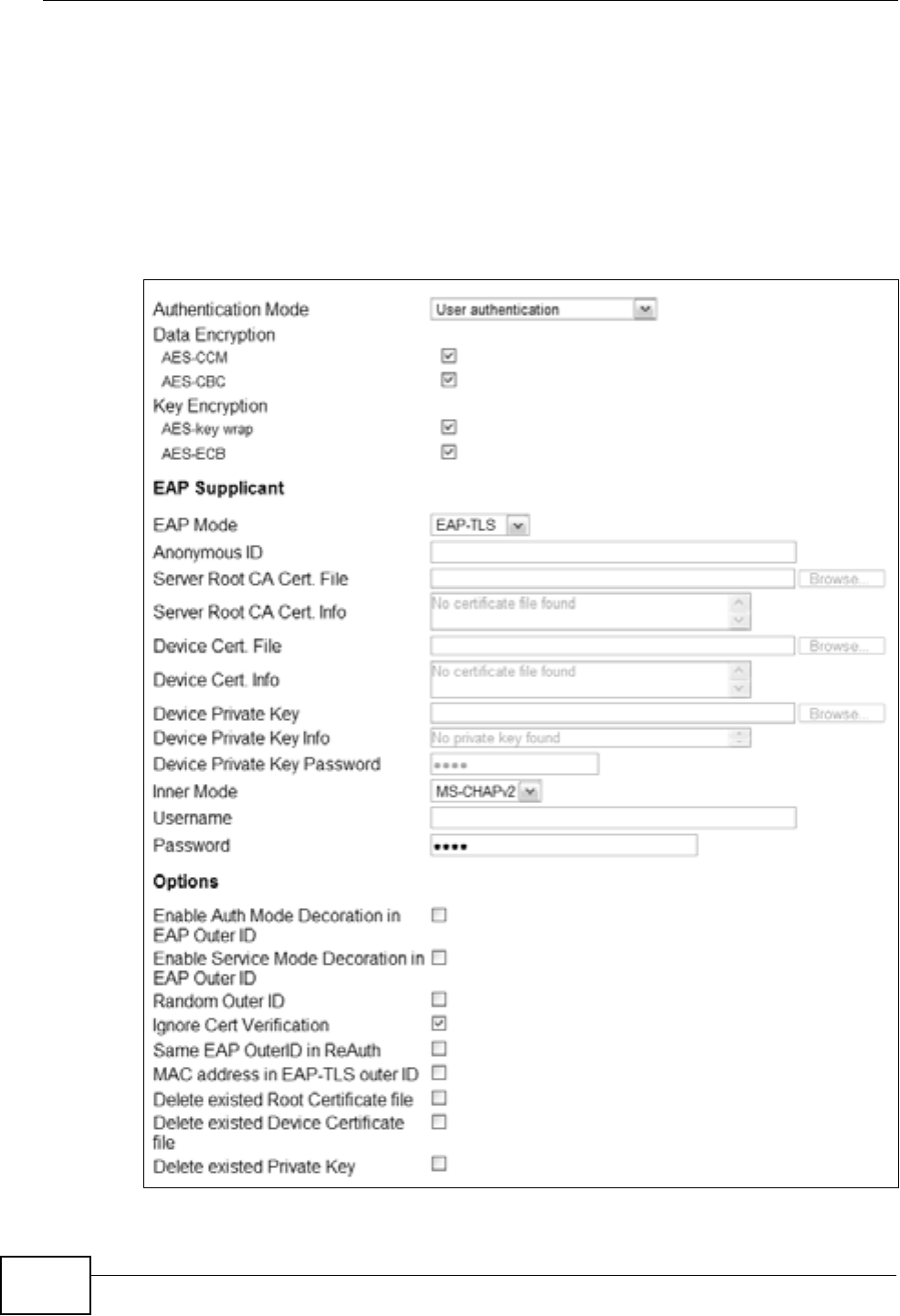
Chapter 6 WiMAX
HES-309M Series User’s Guide
60
6.4 Authentication Settings
These settings allow the WiMAX Device to establish a secure (authenticated)
connection with the service provider.
Click WiMAX > Profile > Authentication Settings to open this screen as shown
next.
Figure 17 Authentication Settings Screen

Chapter 6 WiMAX
HES-309M Series User’s Guide 61
This screen contains the following fields:
Table 12 Authentication Settings
LABEL DESCRIPTION
Authentication
Mode
Select the authentication mode from the list.
The WiMAX Device supports the following authentication modes:
• No authentication
• User authentication
• Device authentication
• User and device authentication
Data Encryption
AES-CCM Select this to enable AES-CCM encryption. CCM combines counter-mode
encryption with CBC-MAC authentication.
AES-CBC Select this to enable AES-CBC encryption. CBC creates message
authentication code from a block cipher.
Key Encryption
AES-key
wrap Select this encapsulate cryptographic keys in a symmetric encryption
algorithm.
AES-ECB Select this to divide cryptographic keys into blocks and encrypt them
separately.
EAP Supplicant
EAP Mode Select an Extensible Authentication Protocol (EAP) mode.
The WiMAX Device supports the following:
•EAP-TLS - In this protocol, digital certifications are needed by both
the server and the wireless clients for mutual authentication. The
server presents a certificate to the client. After validating the
identity of the server, the client sends a different certificate to the
server. The exchange of certificates is done in the open before a
secured tunnel is created. This makes user identity vulnerable to
passive attacks. A digital certificate is an electronic ID card that
authenticates the sender’s identity. However, to implement EAP-TLS,
you need a Certificate Authority (CA) to handle certificates, which
imposes a management overhead.
•EAP-TTLS - This protocol is an extension of the EAP-TLS
authentication that uses certificates for only the server-side
authentications to establish a secure connection. Client
authentication is then done by sending username and password
through the secure connection, thus client identity is protected. For
client authentication, EAP-TTLS supports EAP methods and legacy
authentication methods such as PAP, CHAP, MS-CHAP and MS-CHAP
v2.
Anonymous
ID Enter the anonymous ID used for EAP supplicant authentication.
Server Root
CA Cert File Browse for and choose a server root certificate file, if required.
Server Root
CA Info This field displays information about the assigned server root
certificate.
Device Cert
File Browse for and choose a device certificate file, if required.
Device Cert
Info This field displays information about the assigned device certificate.

Chapter 6 WiMAX
HES-309M Series User’s Guide
62
Device
Private Key Browse for and choose a device private key, if required.
Device
Private Key
Info
This field displays information about the assigned device private key.
Device
Private Key
Password
Enter the device private key, if required.
Inner Mode Sets the EAP-TTLS inner mode.
The WiMAX Device supports the following:
•MS-CHAP v2 - This is version 2 of Microsoft’s variant of Challenge
Handshake Authentication Protocol (CHAP). It allows for mutual
authentication between devices.
•MS-CHAP - This is Microsoft’s variant of Challenge Handshake
Authentication Protocol (CHAP). It allows for mutual authentication
between devices.
•CHAP - The Challenge Handshake Authentication Protocol (CHAP)
uses PPP to authenticate remote devices using a three-way
handshake and shared secret verification.
•MD5 - Message-Digest, algorithm 5, (MD5) encryption is typically
used for checking file integrity. Because this encryption protocol
contains a number of serious security flaws it is generally not
recommended that you use it for authentication security.
•PAP - Password Authentication Protocol uses unencrypted plaintext
to send a passwords for authentication over the network. It’s
probably not a good idea to rely on this for security.
Username Enter the username required for the EAP-TTLS inner method.
Password Enter the password required for the EAP-TTLS inner method.
Options
Enable Auth
Mode
Decoration
in EAP Outer
ID
Select this to enable authentication mode.
Enable
Service
Mode
Decoration
in EAP Outer
ID
Select this to enable service mode.
Random
Outer ID Select this to allow the WiMAX Device to generate a 16-byte random
number as a username for the EAP Identity Response message.
Ignore Cert
Verification Select this to ignore base station certification verification when a
certificate is received during EAP-TLS or EAP-TTLS.
Same EAP
OuterID in
ReAuth
Select this to use the same EAP to the outer ID when reauthenticating.
MAC address
in EAP-TLS
outer Id
Adds the MAC address of the WiMAX Device to the outer ID while the
EAP mode is set to EAP-TLS.
Table 12 Authentication Settings (continued)
LABEL DESCRIPTION
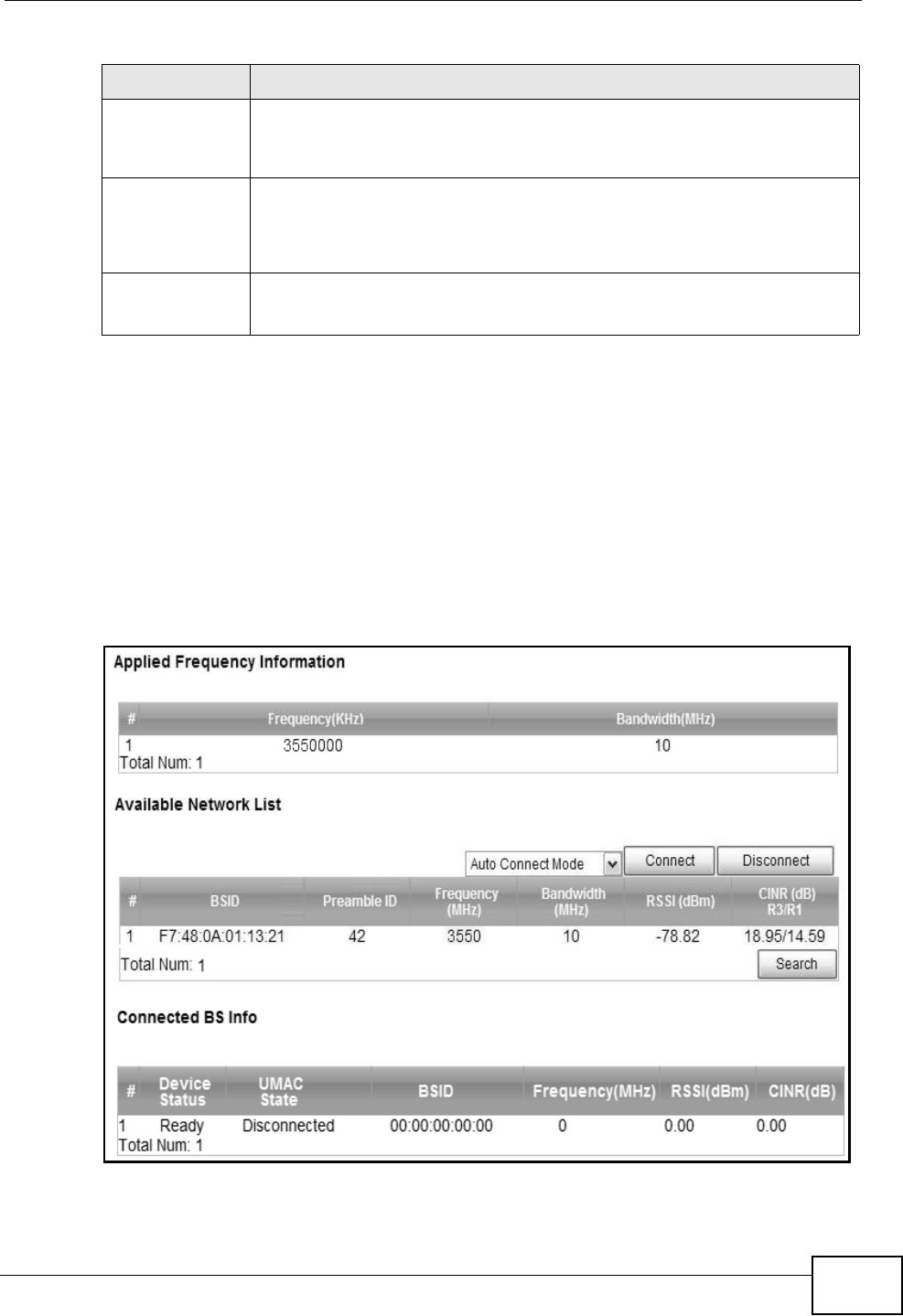
Chapter 6 WiMAX
HES-309M Series User’s Guide 63
6.5 Connect
This screen allows you to view the available WiMAX frequency band(s) and base
station(s) the WiMAX Device found through scanning and choose a base station to
which to connect.
Click WiMAX > Connect to open this screen as shown next.
Figure 18 Connect Screen
Delete
existed Root
Certificate
file
Select this to delete an existing root certificate file from the WiMAX
Device.
Delete
existed
Device
Certificate
file
Select this to delete an existing device certificate file from the WiMAX
Device.
Delete
existed
Private Key
Select this to delete an existing private key from the WiMAX Device.
Table 12 Authentication Settings (continued)
LABEL DESCRIPTION

Chapter 6 WiMAX
HES-309M Series User’s Guide
64
This screen contains the following fields:
Table 13 Connect
LABEL DESCRIPTION
Applied Frequency Information
This table shows the scanning result you made in the WiMAX > Profile > Frequency
Settings and WiMAX > Wide Scan screens.
Note: You cannot see the wide scanning result that you made in WiMAX > Wide
Scan screen if the Join Wide Scan Result is set to No in the WiMAX >
Profile > Frequency Settings screen.
Frequency
(KHz) This field displays the available center frequency of a frequency band in
kilohertz (KHz).
Bandwidth
(MHz) This field displays the bandwidth of the frequency band in megahertz
(MHz).
Available Network List
Connected
Mode Select a connect mode:
•Auto Connect Mode - This allows the WiMAX Device to connect to
any of the base stations on the list automatically.
•Network Search Mode - This allows the WiMAX Device to connect
to a user-specified base station. Select this option, choose a base
station, click Connect.
Connect Click this to connect to the selected base station.
Disconnect Click this to disconnect from the selected base station.
BSID This field displays the base station MAC address.
Preamble ID This field displays the preamble ID.
The preamble ID is the index identifier in the header of the base
station’s broadcast messages. In the beginning of a mobile stations’s
network entry process, it searches for the preamble and uses it to
additional channel information.
The preamble ID is used to synchronize the upstream and downstream
transmission timing with the base station.
Frequency
(MHz) This field displays the center frequency the base station uses in
kilohertz (KHz).
Bandwidth
(MHz) This field displays the frequency band bandwidth the base station uses
in megahertz (MHz).
RSSI (dBm) This field displays the Received Signal Strength Indication (RSSI),
which is an overal measurement of radio signal strength. A higher RSSI
level indicates a stronger signal.
CINR (dB)
R3/R1 This field displays the average Carrier to Interference plus Noise Ratio
for the current connection. This value is an indication of overal radio
signal quality, where a higher value means a better quality signal.
Search Click this to have the WiMAX Device scan for base stations in the
frequency band(s) listed in the Applied Frequency Information
table.
Connected BS Info

Chapter 6 WiMAX
HES-309M Series User’s Guide 65
Device
Status This field displays the WiMAX Device current status for connecting to
the selected base station.
Scanning - The WiMAX Device is scanning for available base stations.
Ready - The WiMAX Device has finished scanning and you can connect
to a base station.
Connecting - The WiMAX Device attempts to connect to the selected
base station.
Connected - The WiMAX Device has successfully connected to the
selected base station.
UMAC State This field displays the status of the WiMAXconnection between the
WiMAX Device and the base station.
Network Search - The WiMAX Device is scanning for any available
WiMAX connections.
Disconnected - No WiMAX connection is available.
Network Entry - A WiMAX connection is initializing.
Normal - The WiMAX connection has been successfully established.
BSID This field displays the MAC address of the base station to which the
WiMAX Device is connected.
Frequency
(MHz) This field displays the frequency the base station uses in megahertz
(MHz).
RSSI (dBm) This field displays the Received Signal Strength Indication (RSSI),
which is an overal measurement of radio signal strength. A higher RSSI
level indicates a stronger signal.
CINR (dB) This field displays the average Carrier to Interference plus Noise Ratio
for the current connection. This value is an indication of overal radio
signal quality, where a higher value means a better quality signal.
Table 13 Connect (continued)
LABEL DESCRIPTION
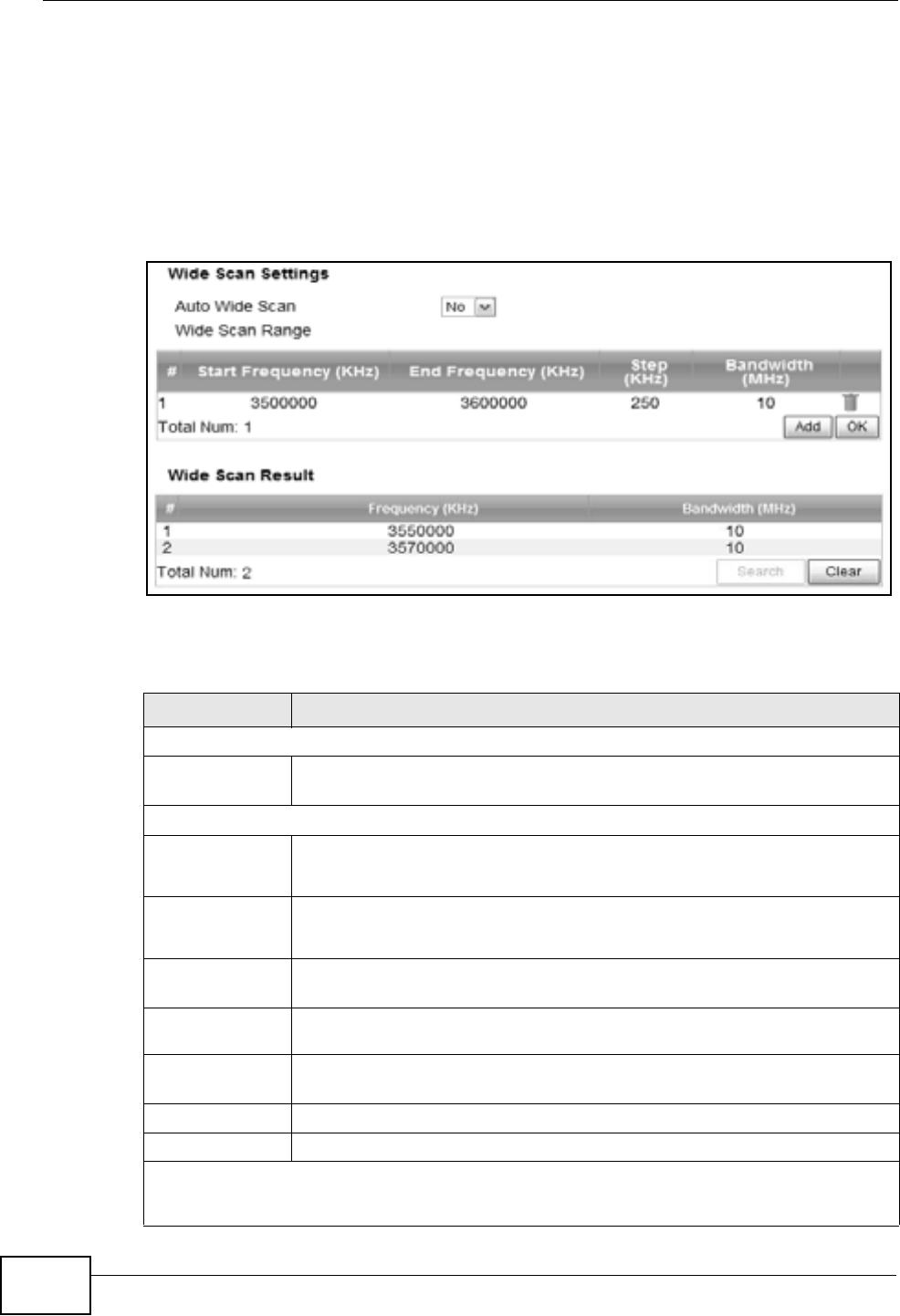
Chapter 6 WiMAX
HES-309M Series User’s Guide
66
6.6 Wide Scan
This screen allows you to discover base stations by entering one or more
frequency ranges and bandwidth on which to scan.
Click WiMAX > Wide Scan to open this screen as shown next.
Figure 19 Wide Scan Screen
This screen contains the following fields:
Table 14 Wide Scan
LABEL DESCRIPTION
Wide Scan Settings
Auto Wide
Scan Use this to enable (Yes) or disable (No) automatically scanning for
base stations.
Wide Scan Range
Start
Frequency
(KHz)
Enter the start frequency in kilohertz (KHz) for a wide scan range.
End
Frequency
(KHz)
Enter the end frequency in kilohertz (KHz) for a wide scan range.
Step (KHz) Enter the step increment in kilohertz (KHz) that the wide scan jumps
each time it scans between the start and end frequencies.
Bandwidth
(MHz) Enter the frequency bandwidth to be scanned.
Delete Click this to remove a range of frequencies from the wide scan range
list.
Add Click this to add a range of frequencies to the wide scan range list.
OK Click this so save any changes to the wide scan range list.
Wide Scan Result
This table displays the available frequency band(s) found through the wide scan.
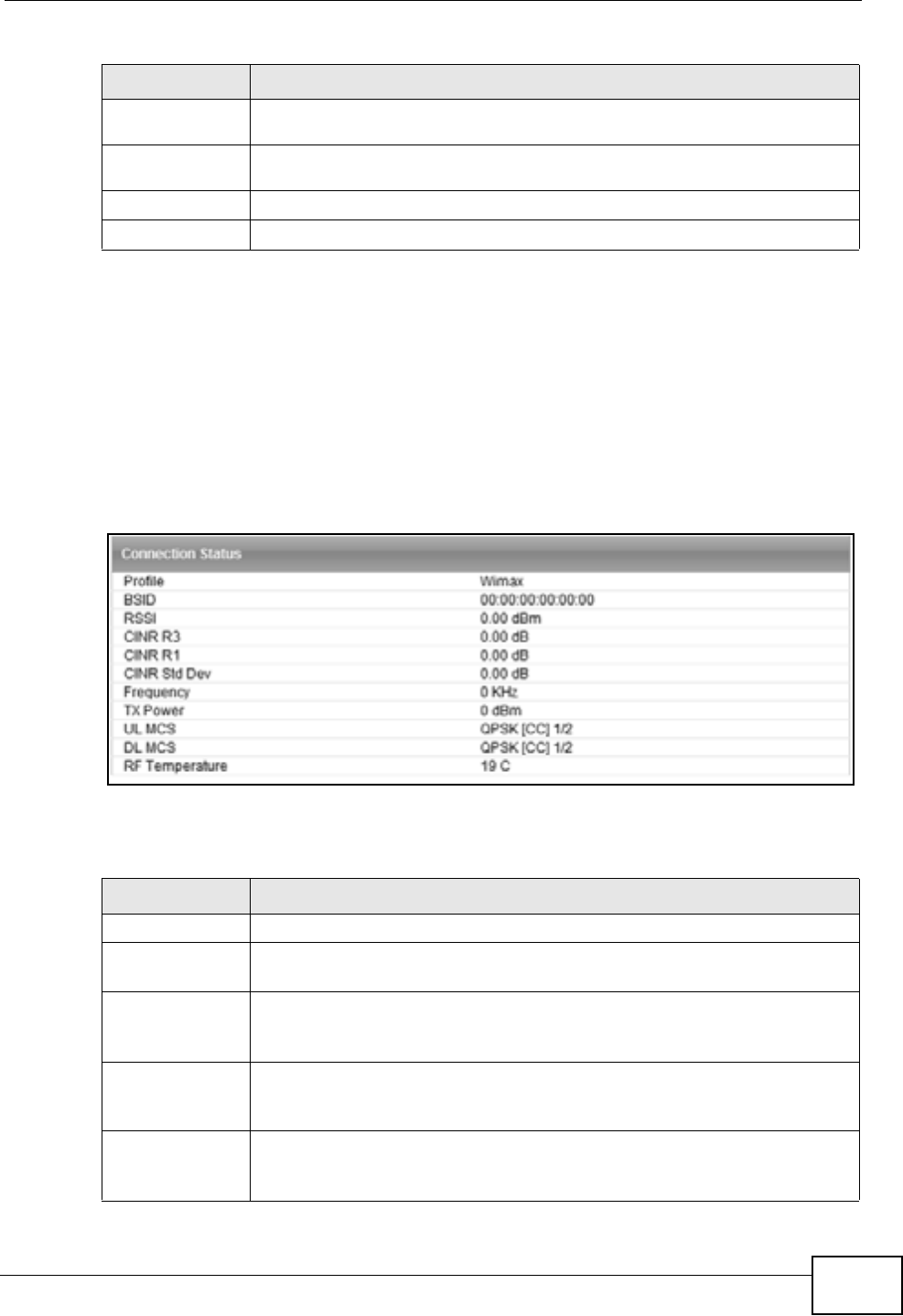
Chapter 6 WiMAX
HES-309M Series User’s Guide 67
6.7 Link Status
This screen provides a general overview of the current WiMAX connection with the
service provider.
Click WiMAX > Link Status to open this screen as shown next.
Figure 20 Link Status Screen
This screen contains the following fields:
Frequency
(KHz) This field displays the frequency in kilohertz (KHz).
Bandwidth
(MHz) This field displays the bandwidth in megahertz (MHz).
Search Click this to initiate a wide scan.
Clear Click this to clear the wide scan results.
Table 14 Wide Scan (continued)
LABEL DESCRIPTION
Table 15 Link Status
LABEL DESCRIPTION
Profile This field displays the profile name.
BSID This field displays the MAC address of the base station to which the
WiMAX Device is currently connected.
RSSI This field displays the Received Signal Strength Indication (RSSI),
which is an overal measurement of radio signal strength. A higher RSSI
level indicates a stronger signal.
CINR R3 This field displays the average Carrier to Interference plus Noise Ratio
(R3) for the current connection. This value is an indication of overal
radio signal quality, where a higher value means a better quality signal.
CINR R1 This field displays the average Carrier to Interference plus Noise Ratio
(R1) for the current connection. This value is an indication of overal
radio signal quality, where a higher value means a better quality signal.

Chapter 6 WiMAX
HES-309M Series User’s Guide
68
CINR Std Dev This field displays the average Carrier to Interference plus Noise Ratio
(Std Dev) for the current connection. This value is an indication of
overal radio signal quality, where a higher value means a better quality
signal.
Frequency This field displays the frequency in kilohertz (KHz).
TX Power This field displays the transmission power of the WiMAX Device in dBm.
UL MCS This field displays the Uplink Modulation and Coding Sequence (UL
MCS).
DL MCS This field displays the Downlink Modulation and Coding Sequence (DL
MCS).
RF Temperature This field displays the temperature of the WiMAX Device’s RF circuit.
Table 15 Link Status (continued)
LABEL DESCRIPTION
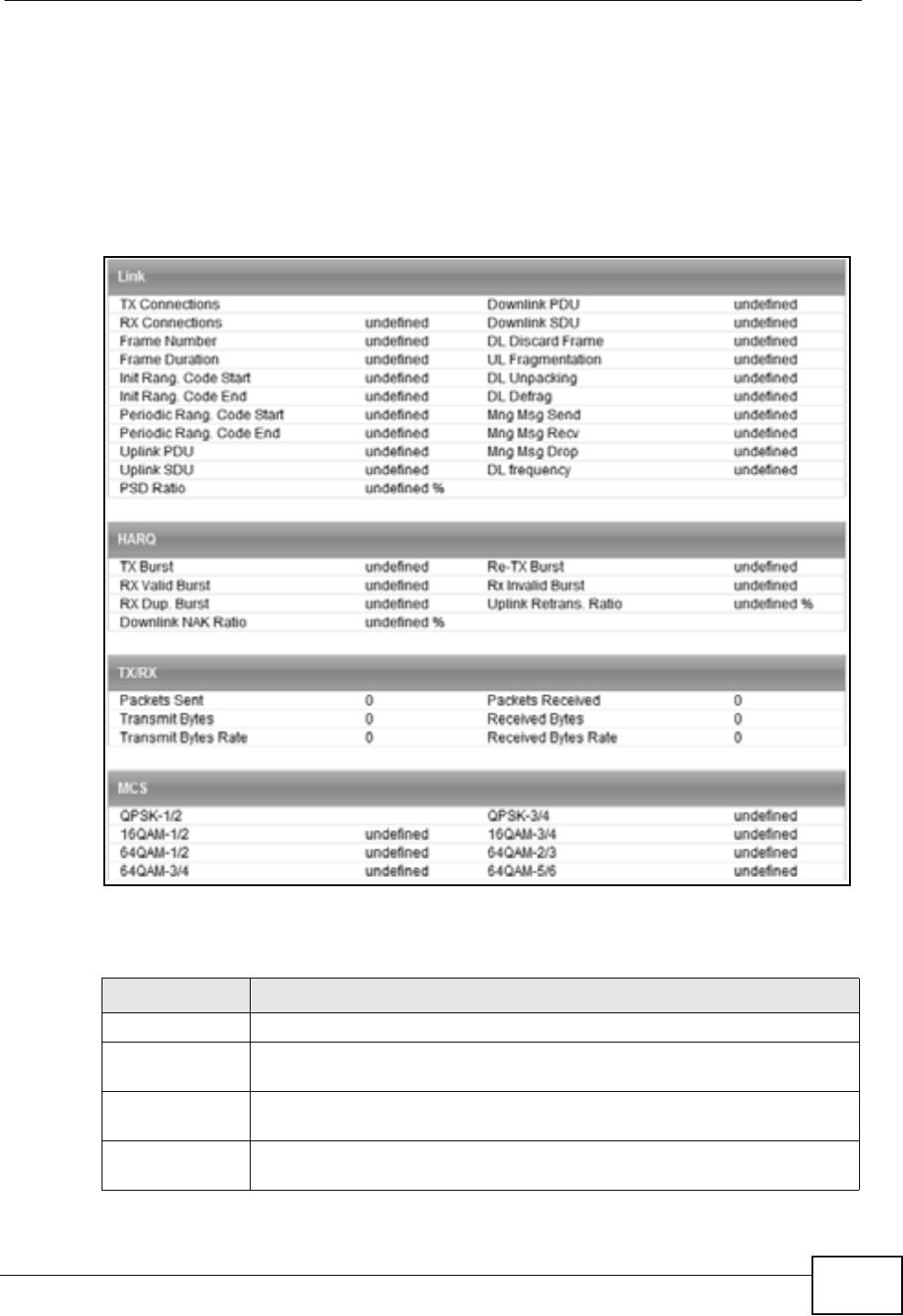
Chapter 6 WiMAX
HES-309M Series User’s Guide 69
6.8 Link Statistics
This screen provides a detailed overview of the current WiMAX connection with the
service provider..
Click WiMAX > Link Statistics to open this screen as shown next.
Figure 21 Link Statistics Screen
This screen contains the following sections:
Table 16 Link Statistics
LABEL DESCRIPTION
Link This section provides a detailed overview of link statistics.
HARQ This section provides a detailed overview of Hybrid Automatic Repeat
Request link statistics.
TX/RX This section provides a detailed overview of transmission and receiving
link statistics.
MCS This section provides a detailed overview of Modulation and Coding
Sequence (MCS) link statistics
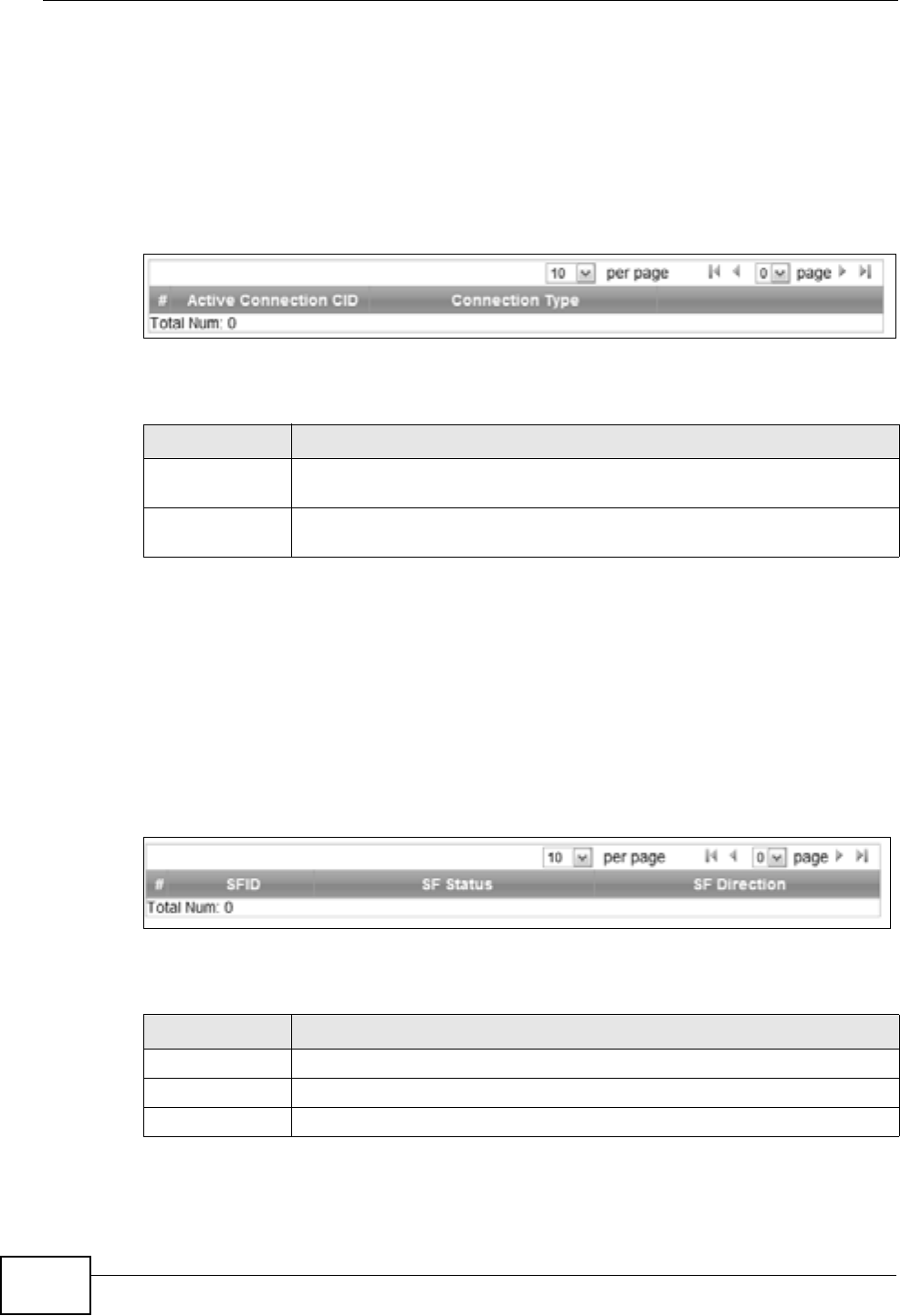
Chapter 6 WiMAX
HES-309M Series User’s Guide
70
6.9 Connection Info
This screen displays all of the connections made through the WiMAX device since
its last reboot.
Click WiMAX > Connection Info to open this screen as shown next.
Figure 22 Connection Info Screen
This screen contains the following fields:
6.10 Service Flow
This screen displays data priority information for all of the connections made
through the WiMAX device since its last reboot.
Click WiMAX > Service Flow to open this screen as shown next.
Figure 23 Service Flow Screen
This screen contains the following fields:
Table 17 Connection Info
LABEL DESCRIPTION
Active
Connection CID
This displays the unique, unidirectional 16-bit Connection Identifier
(CID) for an active connection.
Connection
Type
This displays the type of connection.
Table 18 Service Flow
LABEL DESCRIPTION
SFID This displays a 32-bit service flow identifier.
SF Status This display the service flow status.
SF Direction This displays the service flow direction.
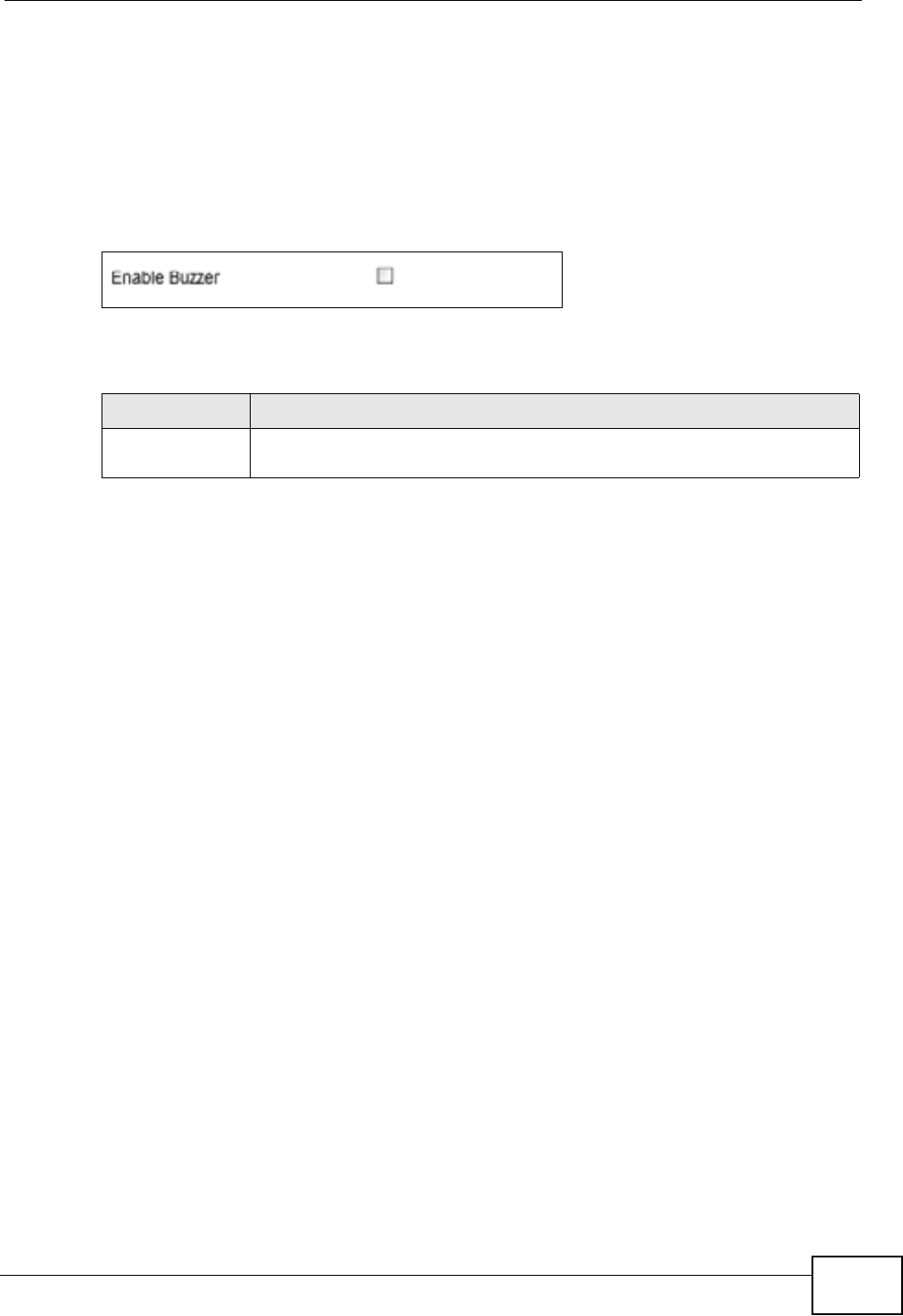
Chapter 6 WiMAX
HES-309M Series User’s Guide 71
6.11 Buzzer
This screen allows you to enable or disable the WiMAX Device’s buzzer. See
Section 1.2.1 on page 18 for a description of buzzer states.
Click WiMAX > Buzzer to open this screen as shown next.
Figure 24 Buzzer Screen
This screen contains the following fields:
Table 19 Buzzer
LABEL DESCRIPTION
Enable Buzzer Select this to enable the buzzer. Whenever a connection is made to a
WiMAX signal, the device emits a small buzz.

Chapter 6 WiMAX
HES-309M Series User’s Guide
72

HES-309M Series User’s Guide 73
CHAPTER 7
Network Settings
7.1 Overview
This chapter shows you how to configure the WiMAX Device’s network settings.
7.1.1 What You Need to Know
The following terms and concepts may help as you read through this chapter.
IP Address
IP addresses identify individual devices on a network. Every networking device
(including computers, servers, routers, printers, etc.) needs an IP address to
communicate across the network. These networking devices are also known as
hosts.
Subnet Masks
Subnet masks determine the maximum number of possible hosts on a network.
You can also use subnet masks to divide one network into multiple sub-networks.
DHCP
A DHCP (Dynamic Host Configuration Protocol) server can assign your WiMAX
Device an IP address, subnet mask, DNS and other routing information when it’s
turned on.

Chapter 7 Network Settings
HES-309M Series User’s Guide
74
DNS Server Address
DNS (Domain Name System) is for mapping a domain name to its corresponding
IP address and vice versa. The DNS server is extremely important because
without it, you must know the IP address of a machine before you can access it.
The DNS server addresses that you enter in the DHCP setup are passed to the
client machines along with the assigned IP address and subnet mask.
There are two ways that an ISP disseminates the DNS server addresses. The first
is for an ISP to tell a customer the DNS server addresses, usually in the form of an
information sheet, when s/he signs up. If your ISP gives you the DNS server
addresses, enter them in the DNS Server fields; otherwise, leave them blank.
Some ISPs choose to pass the DNS servers using the DNS server extensions of
PPP IPCP (IP Control Protocol) after the connection is up. If your ISP did not give
you explicit DNS servers, chances are the DNS servers are conveyed through IPCP
negotiation. The WiMAX Device supports the IPCP DNS server extensions through
the DNS proxy feature.
If the Primary and Secondary DNS Server fields are not specified, for instance,
left as 0.0.0.0, the WiMAX Device tells the DHCP clients that it itself is the DNS
server. When a computer sends a DNS query to the WiMAX Device, the WiMAX
Device forwards the query to the real DNS server learned through IPCP and relays
the response back to the computer.
Please note that DNS proxy works only when the ISP uses the IPCP DNS server
extensions. It does not mean you can leave the DNS servers out of the DHCP
setup under all circumstances. If your ISP gives you explicit DNS servers, make
sure that you enter their IP addresses. This way, the WiMAX Device can pass the
DNS servers to the computers and the computers can query the DNS server
directly without the WiMAX Device’s intervention.
RIP Setup
RIP (Routing Information Protocol) allows a router to exchange routing
information with other routers. The RIP Direction field controls the sending and
receiving of RIP packets. When set to:
•RX/TX - the WiMAX Device will broadcast its routing table periodically and
incorporate the RIP information that it receives.
•RX Only - the WiMAX Device will not send any RIP packets but will accept all
RIP packets received.
•TX Only - the WiMAX Device will send out RIP packets but will not accept any
RIP packets received.
•None - the WiMAX Device will not send any RIP packets and will ignore any RIP
packets received.
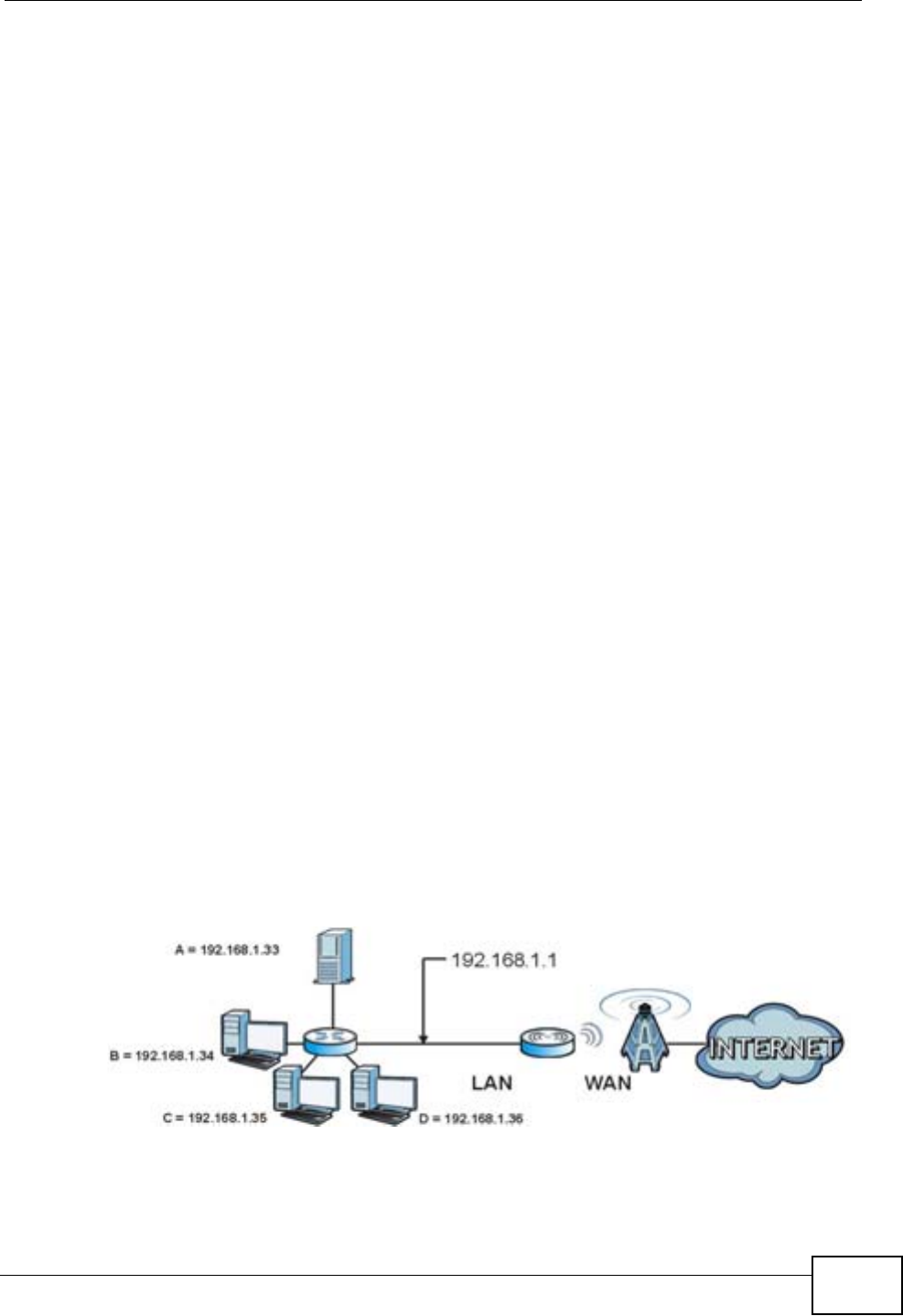
Chapter 7 Network Settings
HES-309M Series User’s Guide 75
The Version field controls the format and the broadcasting method of the RIP
packets that the WiMAX Device sends (it recognizes both formats when receiving).
RIP-1 is universally supported; but RIP-2 carries more information. RIP-1 is
probably adequate for most networks, unless you have an unusual network
topology.
Both RIP-2B and RIP-2M sends the routing data in RIP-2 format; the difference
being that RIP-2B uses subnet broadcasting while RIP-2M uses multicasting.
Port Forwarding
A NAT server set is a list of inside (behind NAT on the LAN) servers, for example,
web or FTP, that you can make accessible to the outside world even though NAT
makes your whole inside network appear as a single machine to the outside world.
With port forwarding, you can forward incoming service requests to the server(s)
on your local network. You may enter a single port number or a range of port
numbers to be forwarded, and the local IP address of the desired server. The port
number identifies a service; for example, web service is on port 80 and FTP on
port 21. In some cases, such as for unknown services or where one server can
support more than one service (for example both FTP and web service), it might
be better to specify a range of port numbers.
In addition to the servers for specified services, NAT supports a default server. A
service request that does not have a server explicitly designated for it is forwarded
to the default server. If the default is not defined, the service request is simply
discarded.
For example, let's say you want to assign ports 21-25 to one FTP, Telnet and SMTP
server (A in the example), port 80 to another (B in the example) and assign a
default server IP address of 192.168.1.35 to a third (C in the example). You
assign the LAN IP addresses and the ISP assigns the WAN IP address. The NAT
network appears as a single host on the Internet.
Figure 25 Multiple Servers Behind NAT Example

Chapter 7 Network Settings
HES-309M Series User’s Guide
76
Trigger Ports
Some services use a dedicated range of ports on the client side and a dedicated
range of ports on the server side. With regular port forwarding you set a
forwarding port in NAT to forward a service (coming in from the server on the
WAN) to the IP address of a computer on the client side (LAN). The problem is
that port forwarding only forwards a service to a single LAN IP address. In order to
use the same service on a different LAN computer, you have to manually replace
the LAN computer's IP address in the forwarding port with another LAN
computer's IP address,
Trigger port forwarding solves this problem by allowing computers on the LAN to
dynamically take turns using the service. The WiMAX Device records the IP
address of a LAN computer that sends traffic to the WAN to request a service with
a specific port number and protocol (a "trigger" port). When the WiMAX Device's
WAN port receives a response with a specific port number and protocol
("incoming" port), the WiMAX Device forwards the traffic to the LAN IP address of
the computer that sent the request. After that computer’s connection for that
service closes, another computer on the LAN can use the service in the same
manner. This way you do not need to configure a new IP address each time you
want a different LAN computer to use the application.
ALG
Some applications, such as SIP, cannot operate through NAT (are NAT un-friendly)
because they embed IP addresses and port numbers in their packets’ data
payload. Some NAT routers may include a SIP Application Layer Gateway (ALG).
An Application Layer Gateway (ALG) manages a specific protocol (such as SIP,
H.323 or FTP) at the application layer.
A SIP ALG allows SIP calls to pass through NAT by examining and translating IP
addresses embedded in the data stream.
UPnP
Universal Plug and Play (UPnP) is a distributed, open networking standard that
uses TCP/IP for simple peer-to-peer network connectivity between devices. A
UPnP device can dynamically join a network, obtain an IP address, convey its
capabilities and learn about other devices on the network. In turn, a device can
leave a network smoothly and automatically when it is no longer in use.
How do I know if I'm using UPnP?
UPnP hardware is identified as an icon in the Network Connections folder
(Windows XP). Each UPnP compatible device installed on your network will appear
as a separate icon. Selecting the icon of a UPnP device will allow you to access the
information and properties of that device.

Chapter 7 Network Settings
HES-309M Series User’s Guide 77
NAT Traversal
UPnP NAT traversal automates the process of allowing an application to operate
through NAT. UPnP network devices can automatically configure network
addressing, announce their presence in the network to other UPnP devices and
enable exchange of simple product and service descriptions. NAT traversal allows
the following:
• Dynamic port mapping
• Learning public IP addresses
• Assigning lease times to mappings
Windows Messenger is an example of an application that supports NAT traversal
and UPnP.
Cautions with UPnP
The automated nature of NAT traversal applications in establishing their own
services and opening firewall ports may present network security issues. Network
information and configuration may also be obtained and modified by users in some
network environments.
All UPnP-enabled devices may communicate freely with each other without
additional configuration. Disable UPnP if this is not your intention.
UPnP and ZyXEL
ZyXEL has received UPnP certification from the official UPnP Forum (http://
www.upnp.org). ZyXEL's UPnP implementation supports IGD 1.0 (Internet
Gateway Device).
The WiMAX Device only sends UPnP multicasts to the LAN.
Content Filter
Internet content filtering allows you to create and enforce Internet access policies
tailored to their needs. Content filtering is the ability to block certain specific URL
keywords.
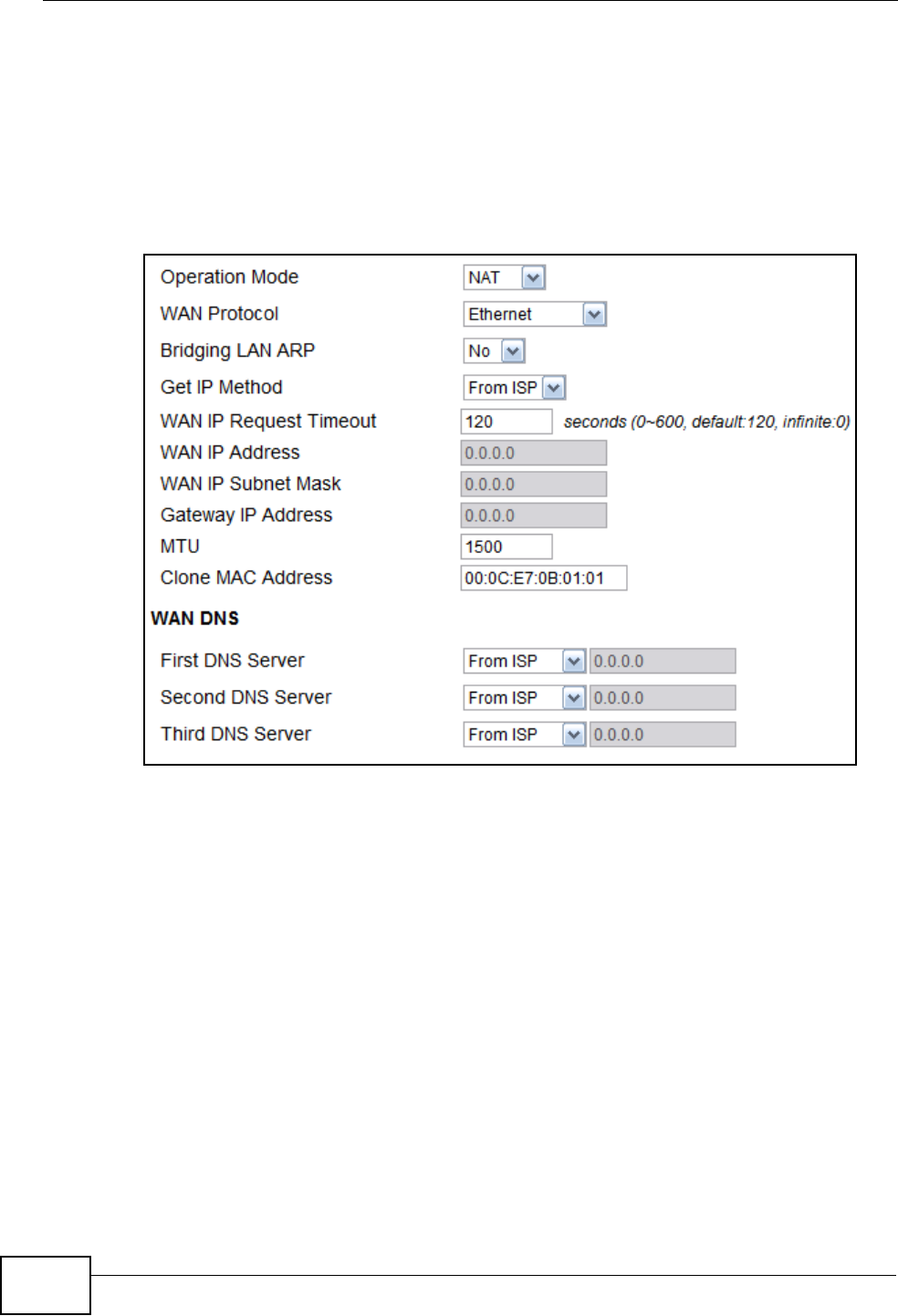
Chapter 7 Network Settings
HES-309M Series User’s Guide
78
7.2 WAN
Use these settings to configure the WAN connection between the WiMAX Device
and the service provider.
Click Network Setting > WAN to open this screen as shown next.
Figure 26 WAN Screen

Chapter 7 Network Settings
HES-309M Series User’s Guide 79
This screen contains the following fields:
Table 20 WAN
LABEL DESCRIPTION
Operation Mode Select the WiMAX Device’s operational mode.
•Bridge - This puts the WiMAX Device in bridge mode, acting as a
transparent middle man between devices on the LAN and the
devices on the WAN.
•NAT - This allows the WiMAX Device to tag frames for NAT, allowing
devices on the LAN to use their own internal IP addresses while
communicating with devices on the WAN.
WAN Protocol Select the protocol the WiMAX Device uses to connect to the WAN.
The options are:
•Ethernet - Select this if you have a persistent connection to the
network.
•PPPoE - Select this if must log into the network before initiating a
persistent connection.
•GRE Tunnel - Select this if you connect to the network using Point-
to-Point Protocol to create VPNs.
•EtherIP - Select this if you need to tunnel Ethernet and IEEE 802.3
MAC frames across an IP Internet.
Bridging LAN
ARP
This option enables or disables allow ARP requests to cross the WiMAX
Device.
Get IP Method Select how the WiMAX Device receives its IP address.
•User - Select this to manually enter the IP address the WiMAX
Device uses.
•From ISP - Select to automatically get the IP address the WiMAX
Device uses from the ISP.
WAN IP Request
Timeout
Enter the number of seconds the WiMAX Device waits for an IP from the
ISP before it times out.
WAN IP Address If the WiMAX Device gets its IP from the user, enter the IP address it is
to use.
WAN IP Subnet
Mask
If the WiMAX Device gets its IP from the ISP, enter the IP address it is
to use.
Gateway IP
Address
If the WiMAX Device gets its gateway IP address from the user, enter
the IP address it is to use.
MTU Enter the Maximum Transmission Unit (MTU) for the WiMAX Device.
This is the largest protocol unit that the WiMAX Device allows to pass
through it.
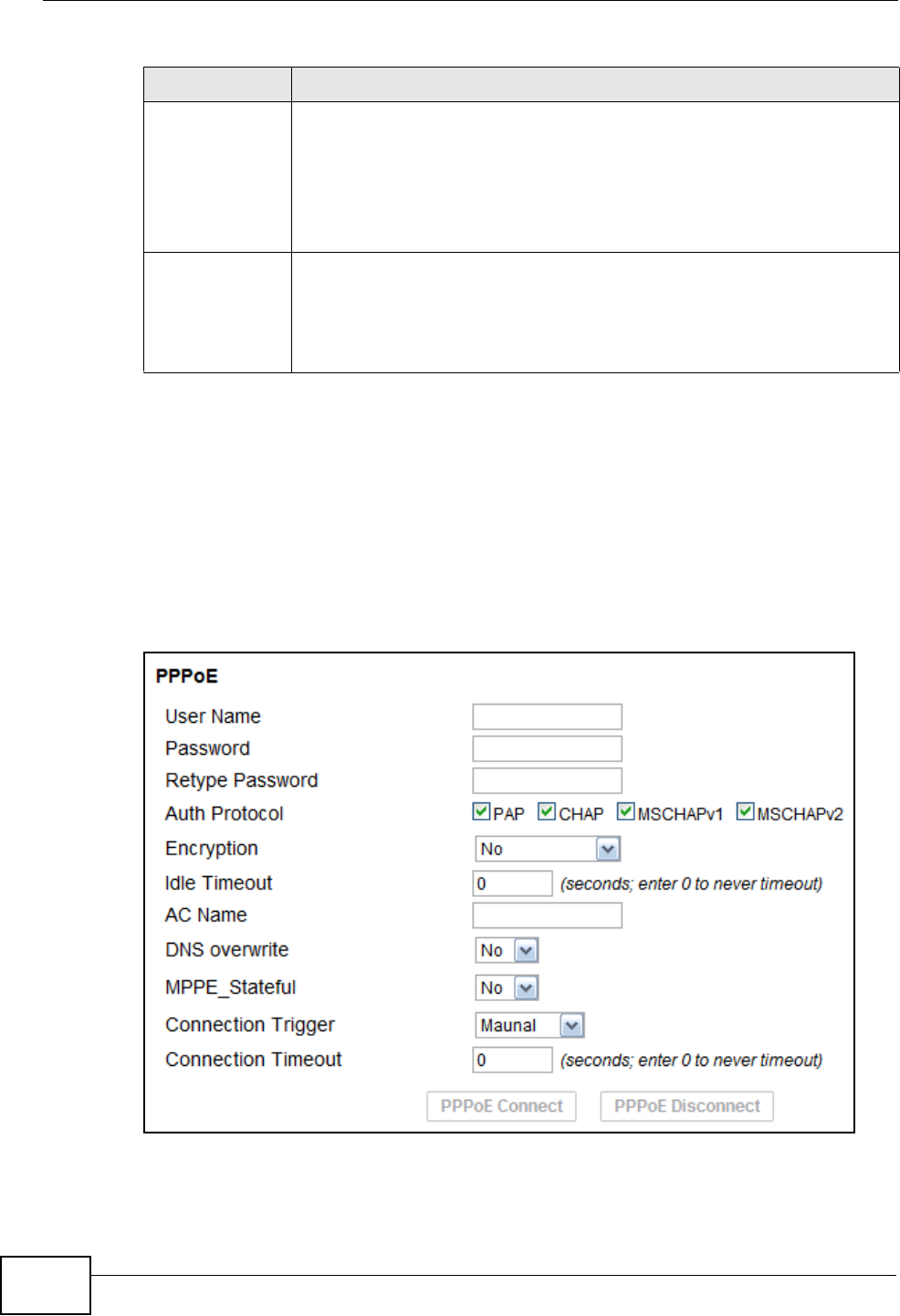
Chapter 7 Network Settings
HES-309M Series User’s Guide
80
7.3 PPPoE
Use these settings to configure the PPPoE connection between the WiMAX Device
and the service provider.
Click Network Setting > WAN > PPPoE
Figure 27 PPPoE Screen
Clone MAC
Address
Enter a MAC address here for registering bridged devices on the
network if their current MAC addresses are causing problems. For
example, this can happen when a desktop computer swaps network
interface cards; the original NIC may have used its MAC address to
register itself on the network and now the new NIC is unrecognized.
Using a MAC address that you know is valid, i.e. a “clone”, allows that
device to stay registered.
First~Third DNS
Server
Select how the WiMAX Device acquires its DNS server address.
•From ISP - Select this to have the WiMAX Device acquire its DNS
server address from the ISP.
•User Define - Select this to manually enter the DNS server used by
the WiMAX Device.
Table 20 WAN (continued)
LABEL DESCRIPTION

Chapter 7 Network Settings
HES-309M Series User’s Guide 81
This screen contains the following fields:
Table 21 PPPoE
LABEL DESCRIPTION
User Name Enter the username for PPPoE login into the WAN network.
Password Enter the password for PPPoE login into the WAN network.
Retype
Password
Retype the password to confirm it.
Auth Protocol Select a PPPoE authentication protocol. The WiMAX Device supports the
following:
•CHAP - The Challenge Handshake Authentication Protocol (CHAP)
uses PPP to authenticate remote devices using a three-way
handshake and shared secret verification.
•PAP - Password Authentication Protocol uses unencrypted plaintext
to send a passwords for authentication over the network. It’s
probably not a good idea to rely on this for security.
•MS-CHAP v1/2 -This is Microsoft’s variant of Challenge Handshake
Authentication Protocol (CHAP). It allows for mutual authentication
between devices.
Encryption Use this option to enable or disable authentication.
Idle Timeout Enter the number of second the WiMAX Device waits during
authentication before timing out.
AC Name Enter the access concentrator name for the PPPoE interface if your ISP
uses an AC PPPoE service.
DNS Overwrite Use this option to allow or disallow the WiMAX Device to overwrite DNS
static DNS entries on client devices.
MPPE_Stateful Use this option to allow or disallow the WiMAX Device to use the
Microsoft Point-To-Point Encryption (MPPE) protocol for stateful peer
negotiation.
Connection
Trigger
Set whether the WiMAX Device is persistently connected to the WAN
(AlwaysOn) or you must click the PPPoE Connect button each time you
want to get on the WAN (Manual).
Connection
Timeout
Enter in seconds the duration the WiMAX Device waits for idle activity
before disconnecting from the WAN.
PPPoE Connect Click this to connect to the WAN using PPPoE.
PPPoE
Disconnect
Click this to disconnect from the WAN.
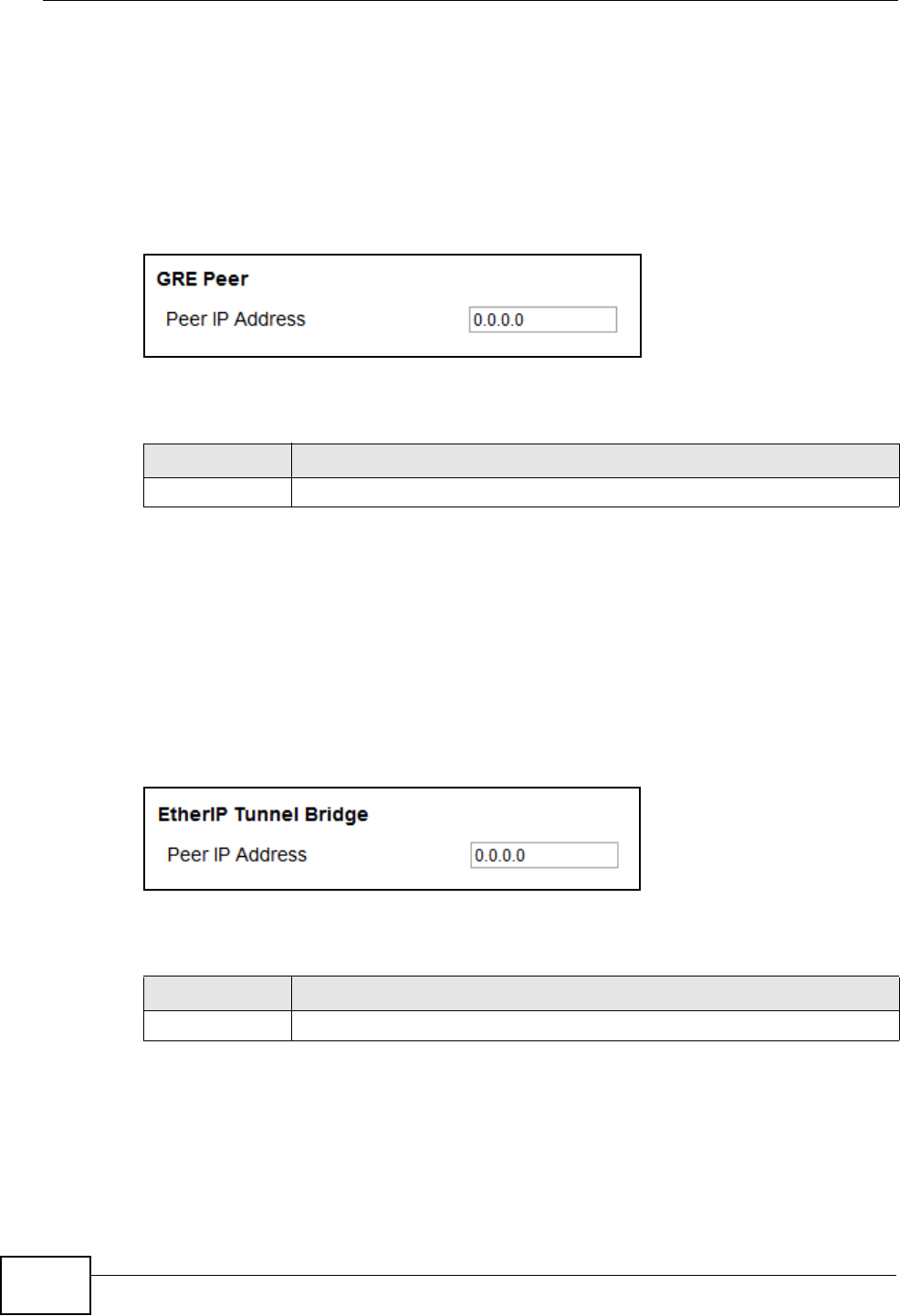
Chapter 7 Network Settings
HES-309M Series User’s Guide
82
7.4 GRE
Use these settings to configure the peer setting of the Generic Routing
Encapsulation (GRE) tunnel between the WiMAX Device and another GRE peer.
Click Network Setting > WAN > GRE to open this screen as shown next.
Figure 28 GRE Screen
This screen contains the following fields:
7.5 EtherIP
Use these settings to configure the peer setting of the EtherIP tunnel between the
WiMAX Device and another EtherIP peer.
Click Network Setting > WAN > EtherIP to open this screen as shown next.
Figure 29 EtherIP Screen
This screen contains the following fields:
Table 22 GRE
LABEL DESCRIPTION
Peer IP Address Enter the IP address of the GRE peer.
Table 23 EtherIP
LABEL DESCRIPTION
Peer IP Address Enter the IP address of the EtherIP peer.
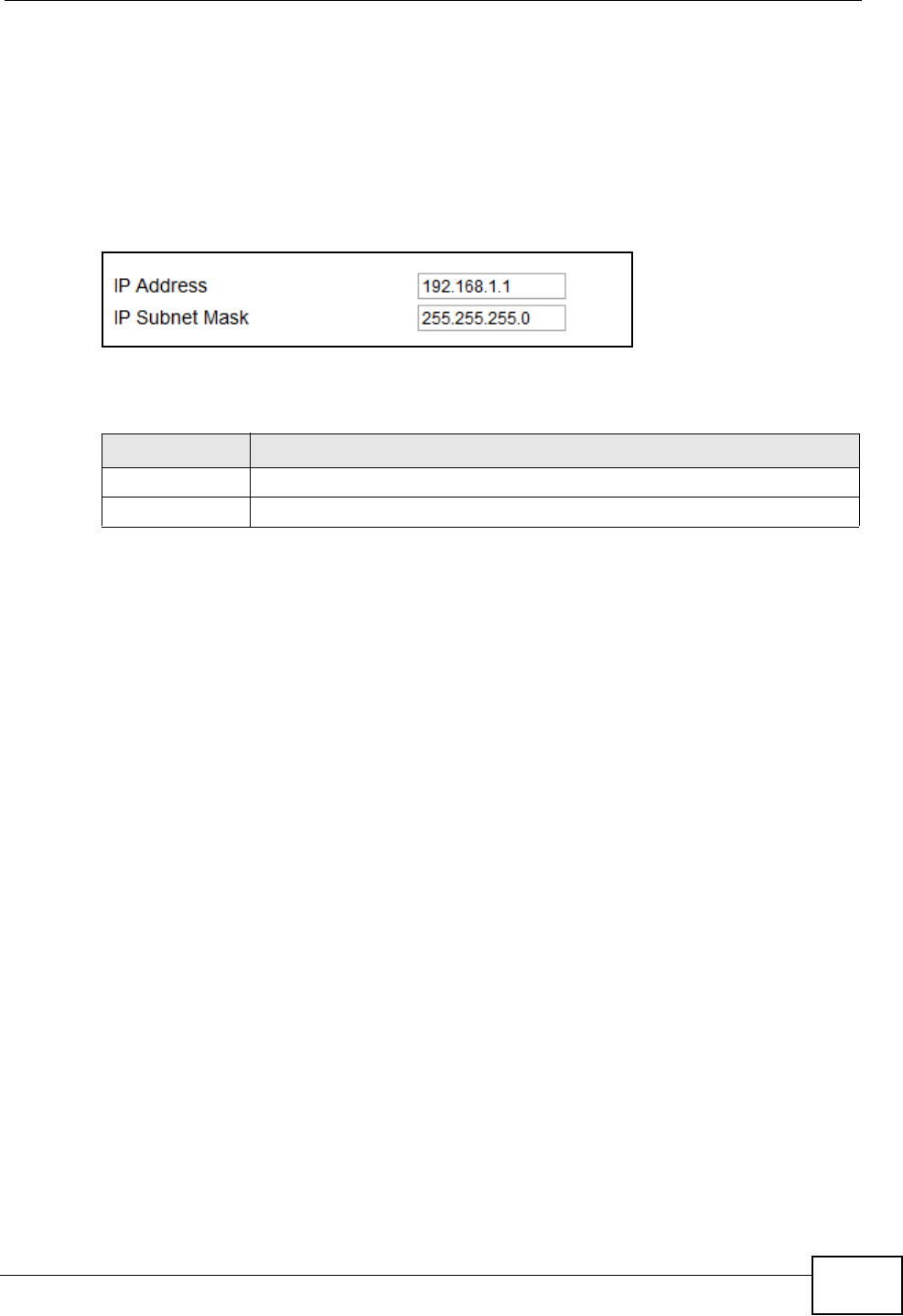
Chapter 7 Network Settings
HES-309M Series User’s Guide 83
7.6 IP
Use these settings to configure the LAN connection between the WiMAX Device
and your local network.
Click Network Setting > LAN > IP to open this screen as shown next.
Figure 30 IP Screen
This screen contains the following fields:
Table 24 IP
LABEL DESCRIPTION
IP address Enter the IP address of the LAN interface for the WiMAX Device.
IP Subnet Mask Enter the IP subnet maks of the LAN interface for the WiMAX Device.
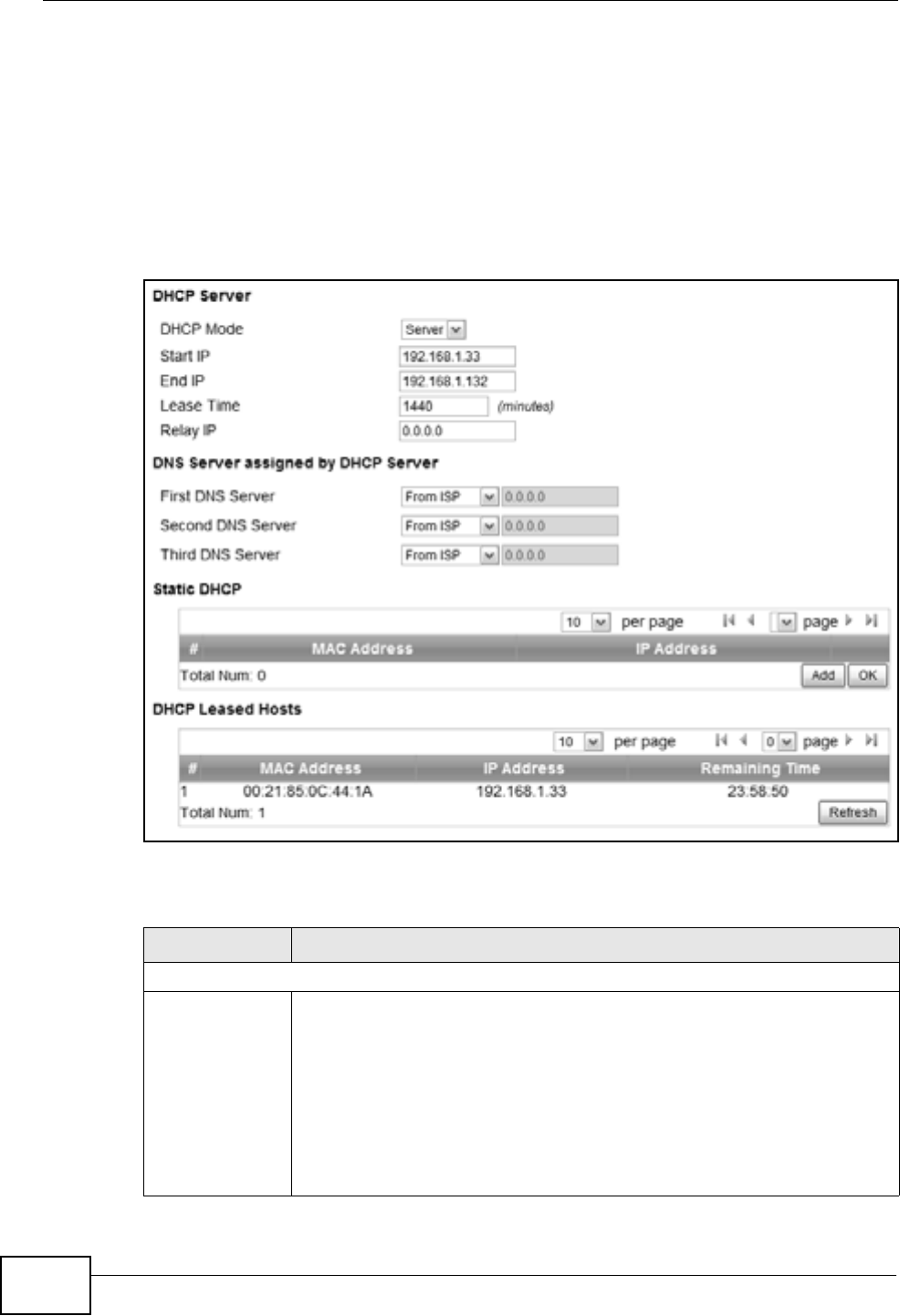
Chapter 7 Network Settings
HES-309M Series User’s Guide
84
7.7 DHCP
Use these settings to configure whether the WiMAX Device functions as a DHCP
server for your local network, or a DHCP relay between the local network and the
service provider. You can also disable the DHCP functions.
Click Network Setting > LAN > DHCP to open this screen as shown next.
Figure 31 DHCP Screen
This screen contains the following fields:
Table 25 DHCP
LABEL DESCRIPTION
DHCP Server
DHCP Mode Select this if you want the WiMAX Device to be the DHCP server on the
LAN. As a DHCP server, the WiMAX Device assigns IP addresses to
DHCP clients on the LAN and provides the subnet mask and DNS server
information.
•None - This disables DHCP mode for the WiMAX Device.
•Server - This sets the WiMAX Device as a DHCP server for the LAN.
•Relay - This sets the WiMAX Device as a DHCP relay for the LAN,
allowing it to pass-through IP addresses assigned to LAN devices
from the ISP servers.

Chapter 7 Network Settings
HES-309M Series User’s Guide 85
7.8 Static Route
Use these settings to create fixed paths through the network.
Click Network Setting > Route > Static Route to open this screen as shown
next.
Figure 32 Static Route Screen
Start IP Enter the start IP address from which the WiMAX Device begins
allocating IP addresses.
End IP Enter the end IP address at which the WiMAX Device ceases allocating
IP addresses.
Lease Time Enter the duration in minutes that devices on the LAN retain their
DHCP-issued IP addresses. At the end of the lease time, they poll the
WiMAX Device for a renewed or replacement IP.
Relay IP Enter the name of the IP address to be used.
DNS Server Assigned by the DHCP Server
First~Third
DNS Server Select how the WiMAX Device acquires its DNS server address.
•None - Select this to not use a DNS server.
•From ISP - Select this to have the WiMAX Device acquire its DNS
server address from the ISP.
•User Define - Select this to manually enter the DNS server used by
the WiMAX Device.
Static DHCP
MAC
Address This field displays the MAC address of the static DHCP client connected
to the WiMAX Device.
IP Address This field displays the IP address of the static DHCP client connected to
the WiMAX Device.
Add Click this to add a new static DHCP entry.
OK Click this to save any changes made to this list.
DHCP Leased Hosts
MAC
Address This displays the MAC address of the DHCP leased host.
IP Address This displays the IP address of the DHCP leased host.
Remaining
Time This displays the how much time is left on the host’s lease.
Refresh Click this to refresh the list.
Table 25 DHCP (continued)
LABEL DESCRIPTION
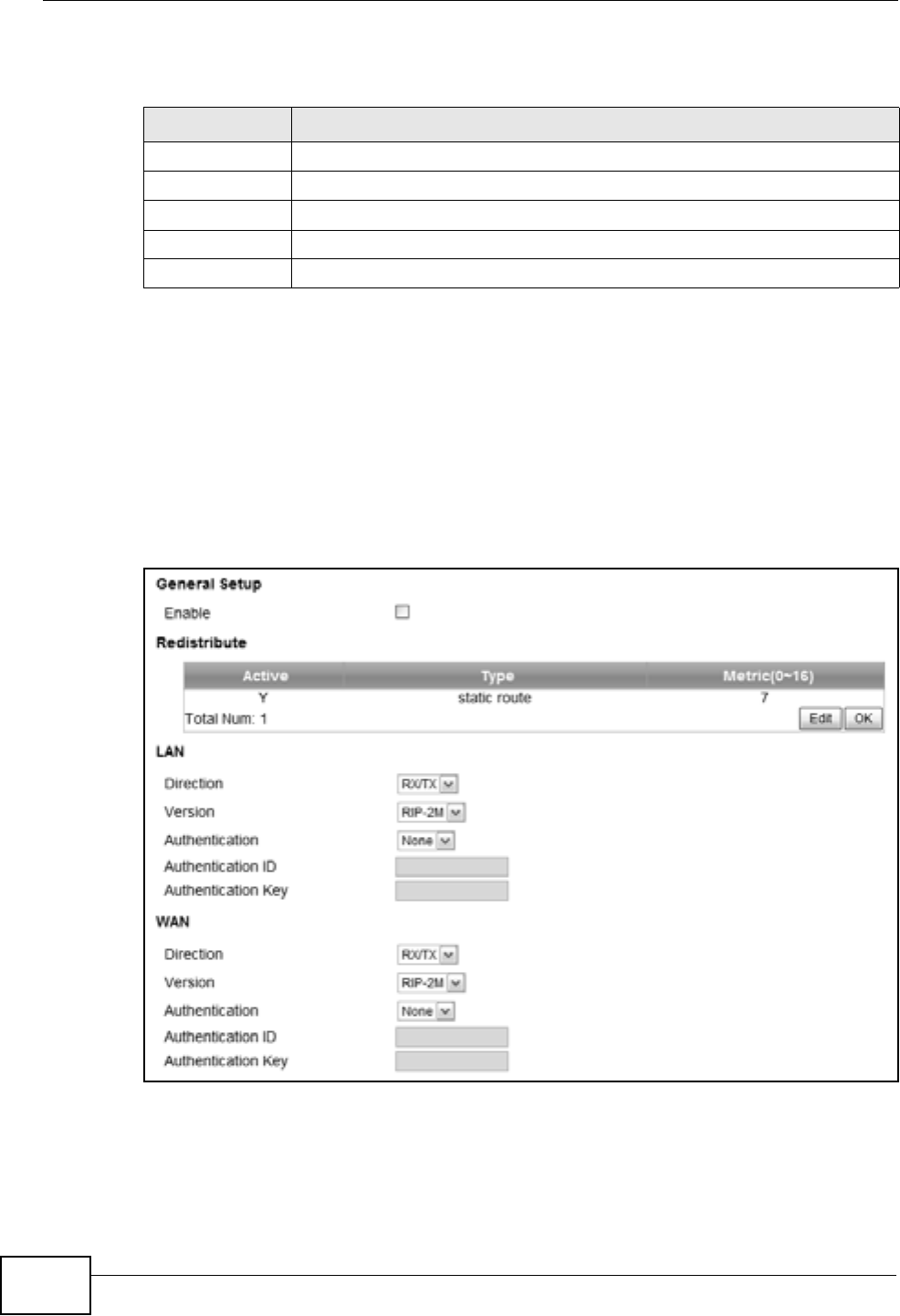
Chapter 7 Network Settings
HES-309M Series User’s Guide
86
This screen contains the following fields:
7.9 RIP
Use these settings to configure how the WiMAX Device exchanges information with
other routers.
Click Network Setting > Route > RIP to open this screen as shown next.
Figure 33 RIP Screen
Table 26 Static Route
LABEL DESCRIPTION
Destination This field displays the destination IP address of the static route.
Subnet Mask This field displays the subnet mask of the static route.
Next Hop This field displays next hop information of the static route.
Metric This field displays the static route metric.
Add Click this to add a new static route to the list.

Chapter 7 Network Settings
HES-309M Series User’s Guide 87
This screen contains the following fields:
7.10 Port Forwarding
Use these settings to forward incoming service requests to the ports on your local
network.
Note: Make sure you did not configure a DMZ host in the Network Setting > NAT >
DMZ screen if you want to make the settings of this screen work.
Table 27 RIP
LABEL DESCRIPTION
General Setup
Enable Select this to enable RIP on the WiMAX Device.
Redistribute
Active This indicates whether a route is being redistributed.
Type This indicates what type of route is being redistributed.
Metric This indicates the metric that is being used for redistribution.
Edit Click this to edit a selected route.
OK Click this to save any changes to the redistribution table.
LAN
Direction Set the LAN network direction to use with RIP.
Version Set the RIP version to use.
Authentication Use this option to enable or disable RIP authentication.
Authentication
ID Enter the authentication ID to use for RIP authentication.
Authentication
Key Enter the authentication key to use for RIP authentication.
WAN
Direction Set the WAN network direction to use with RIP.
Version Set the RIP version to use.
Authentication Use this option to enable or disable RIP authentication.
Authentication
ID Enter the authentication ID to use for RIP authentication.
Authentication
Key Enter the authentication key to use for RIP authentication.
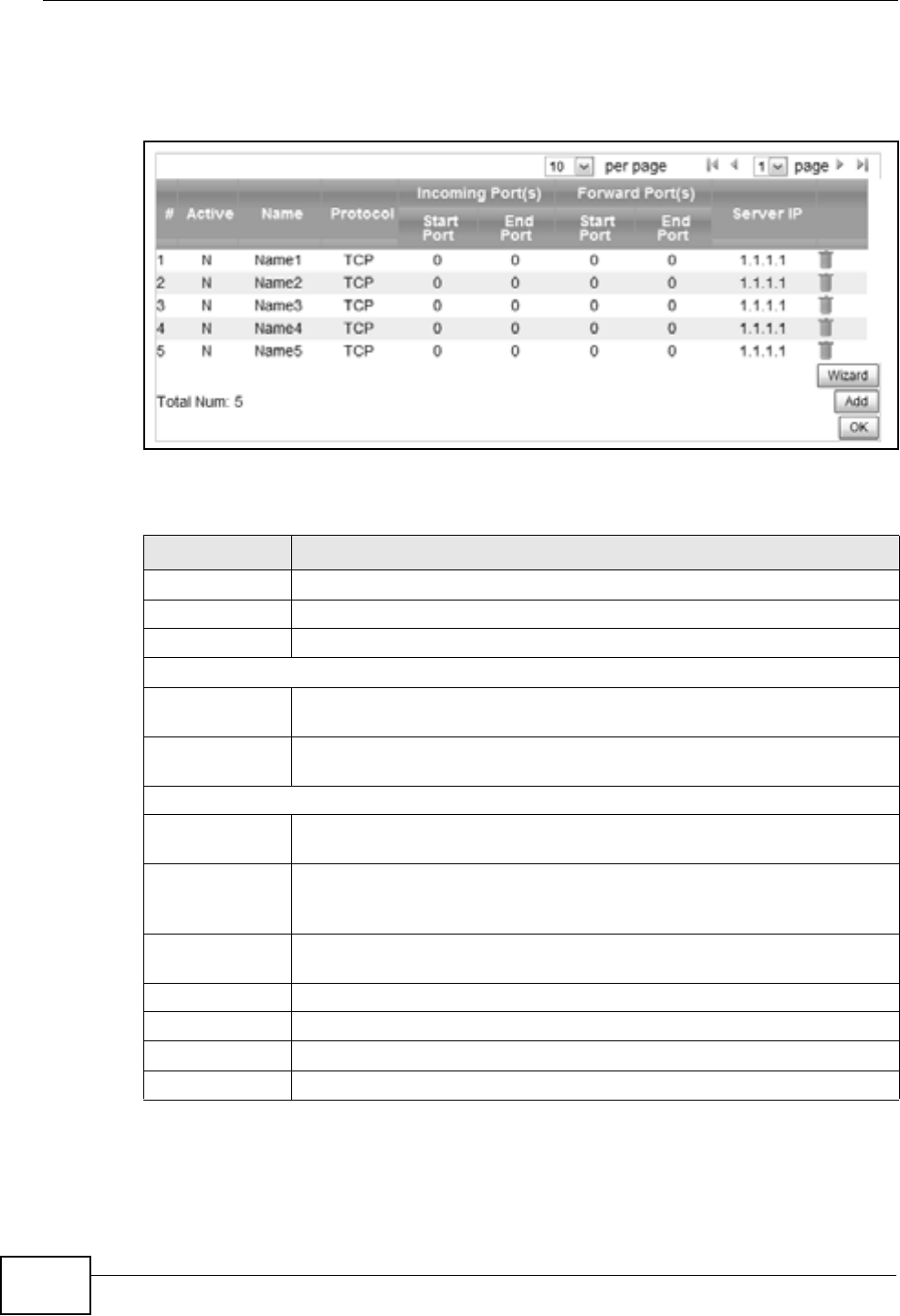
Chapter 7 Network Settings
HES-309M Series User’s Guide
88
Click Network Setting > NAT > Port Forwarding to open this screen as shown
next.
Figure 34 Port Forwarding Screen
This screen contains the following fields:
Table 28 Port Forwarding
LABEL DESCRIPTION
Active This indicates whether the port forwarding rule is active or not.
Name The displays the name of the port forwarding rule.
Protocol This displays the protocol to which the port forwarding rule applies.
Incoming Port(s)
Start Port This displays the starting port number for incoming traffic for the port
forwarding rule.
End Port This displays the ending port number for incoming traffic for the port
forwarding rule.
Forward Port(s)
Start Port This field displays the beginning of the range of port numbers forwarded
by this rule.
End Port This field displays the end of the range of port numbers forwarded by
this rule. If it is the same as the Start Port, only one port number is
forwarded.
Server IP This displays the IP address of the server to which packet for the
selected port(s) are forwarded.
Delete Click this to delete a specified rule.
Wizard Click this to open the port forwarding “wizard”.
Add Click this to add a new port forwarding rule.
OK Click this to save any changes made to the port forwarding list.
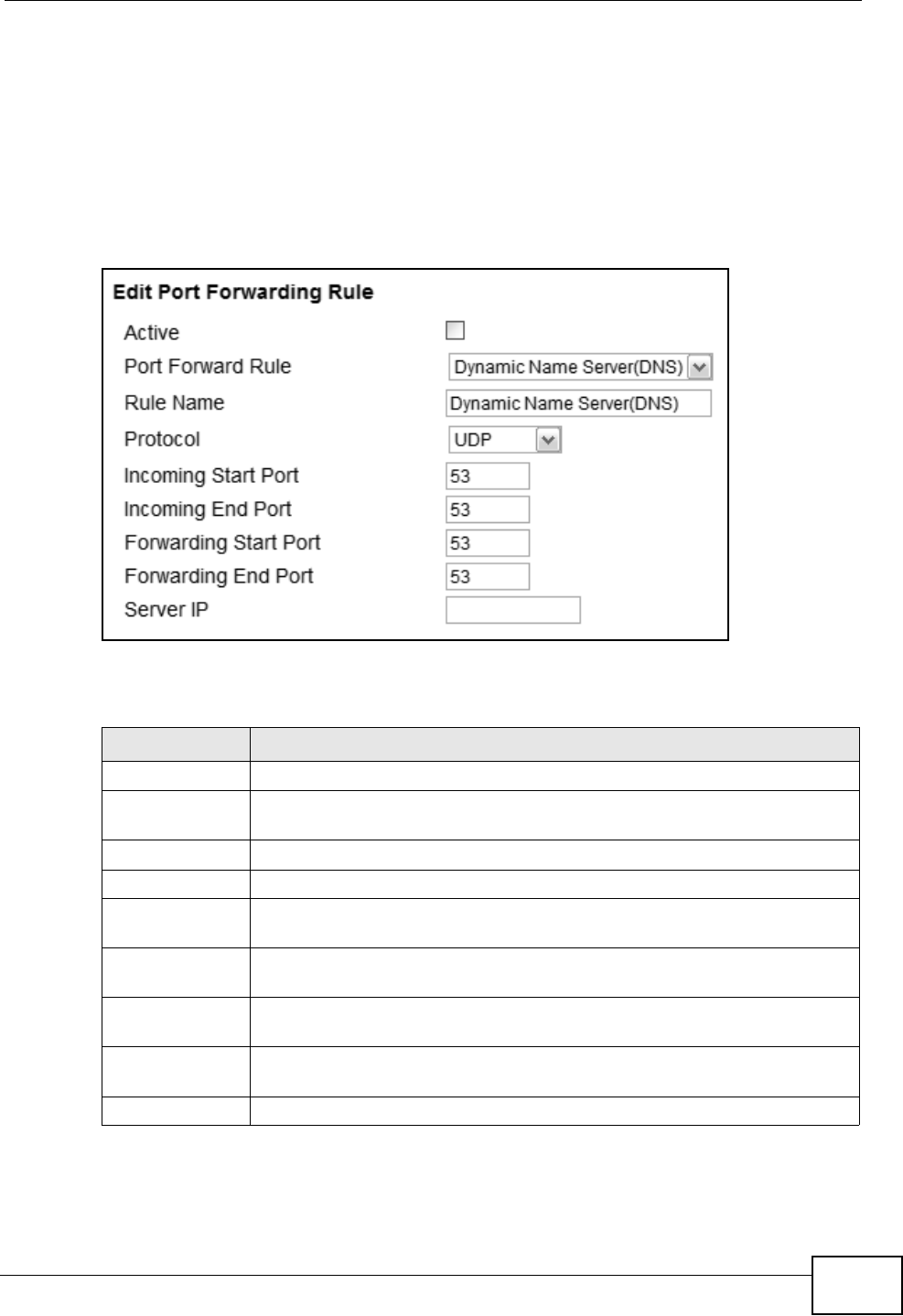
Chapter 7 Network Settings
HES-309M Series User’s Guide 89
7.10.1 Port Forwarding Wizard
Use this wizard to set up a port forwarding rule for incoming service requests to
the ports on your local network.
Click Network Setting > NAT > Port Forwarding > Wizard to open this
screen as shown next.
Figure 35 Port Forwarding Wizard Screen
This screen contains the following fields:
Table 29 Port Forwarding Wizard
LABEL DESCRIPTION
Active Select this to make this port forwarding rule active.
Port Forward
Rule
Select the type of port forwarding rule.
Rule Name Enter a name for the port forwarding rule.
Protocol Select the port forwarding protocol.
Incoming Start
Port
Enter the starting port number for incoming traffic for the port
forwarding rule.
Incoming End
Port
Enter the ending port number for incoming traffic for the port
forwarding rule.
Forwarding
Start Port
Enter the starting port number for forwarded traffic for the port
forwarding rule.
Forwarding End
Port
Enter the ending port number for forwarded traffic for the port
forwarding rule.
Server IP Enter the port forwarding server IP address.
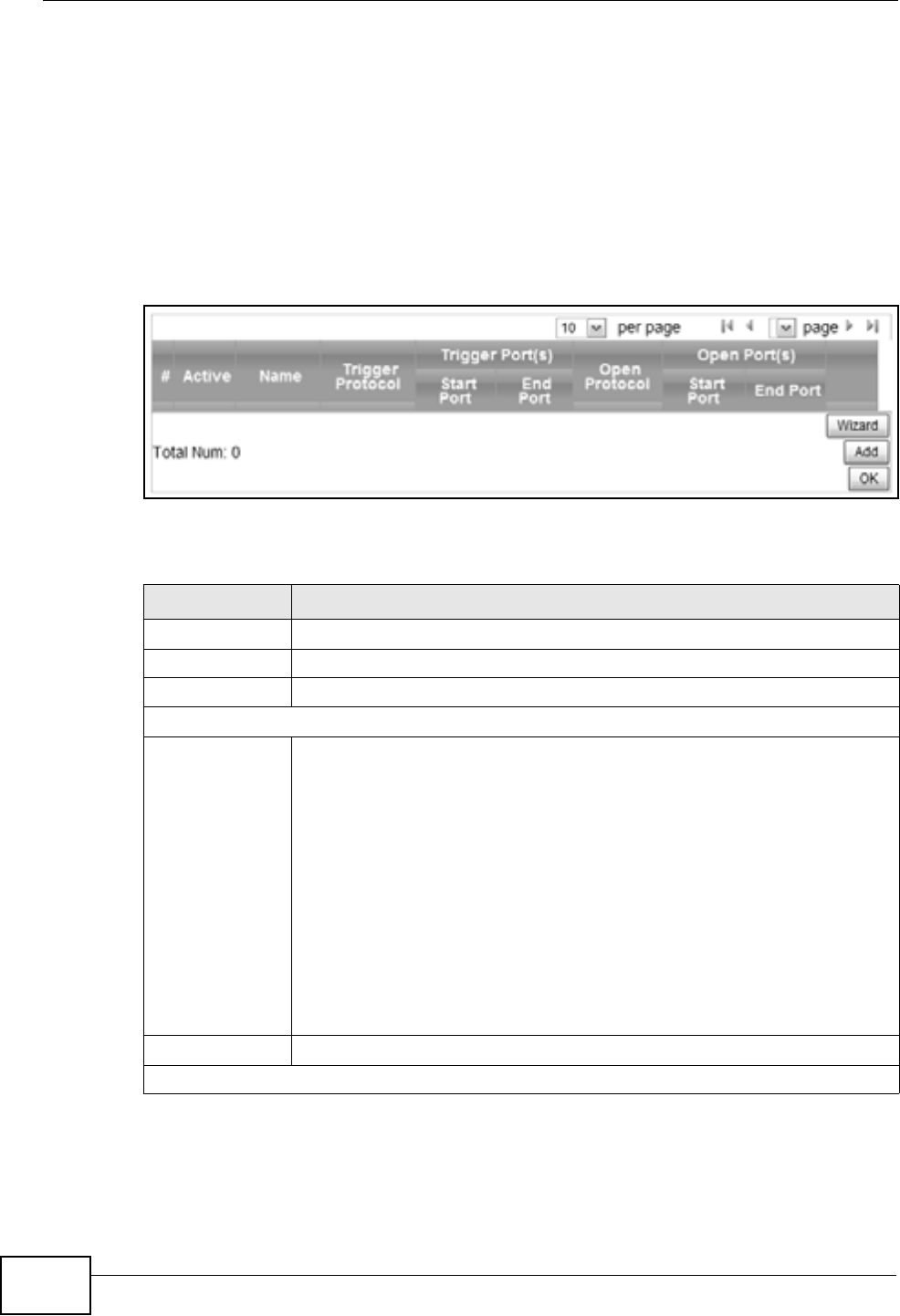
Chapter 7 Network Settings
HES-309M Series User’s Guide
90
7.11 Port Trigger
Use these settings to automate port forwarding and allow computers on local
network to provide services that would normally require a fixed address on the
local network.
Click Network Setting > NAT > Port Trigger to open this screen as shown
next.
Figure 36 Port Trigger Screen
This screen contains the following fields:
Table 30 Port Trigger
LABEL DESCRIPTION
Active This indicates whether the port trigger rule is active or not.
Name The displays the name of the port trigger rule.
Trigger Protocol This displays the protocol to which the port trigger rule applies.
Trigger Port(s)
Start / End
Port This displays the start / end trigger port for the port trigger rule.
Click Add to create a new, empty rule, then enter the incoming port
number or range of port numbers you want to forward to the IP address
the WiMAX Device records.
To forward one port number, enter the port number in the Start Port
and End Port fields.
To forward a range of ports,
• enter the port number at the beginning of the range in the Start
Port field
• enter the port number at the end of the range in the End Port field.
If you want to delete this rule, click the Delete icon.
Open Protocol This indicates which protocol is used to open the port trigger ports.
Open Port(s)
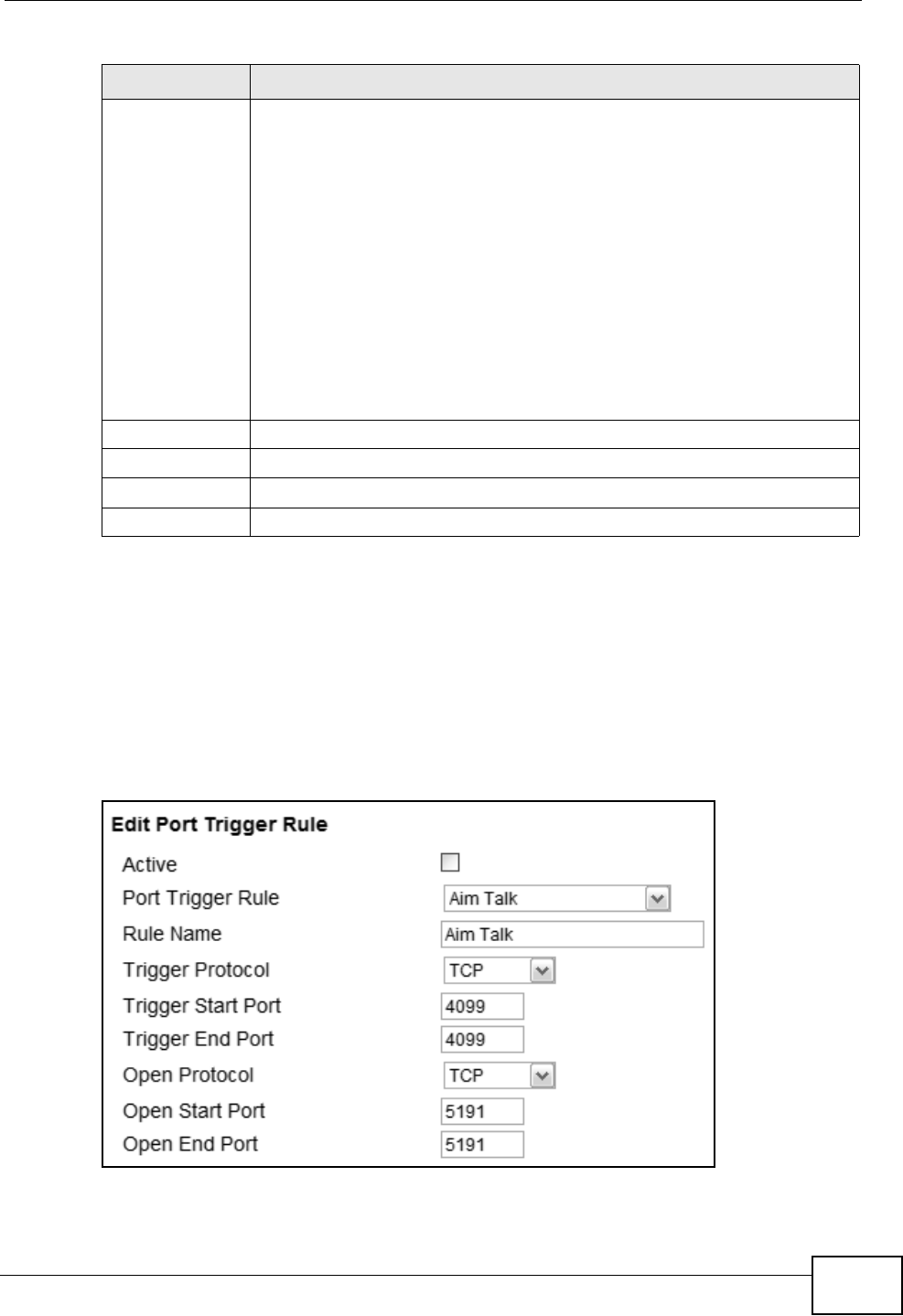
Chapter 7 Network Settings
HES-309M Series User’s Guide 91
7.11.1 Port Trigger Wizard
Use the wizard to create a port trigger rules that will allow the WiMAX Device to to
automate port forwarding and allow computers on local network to provide
services that would normally require a fixed address on the local network.
Click Network Setting > NAT > Port Trigger > Wizard
Figure 37 Port Trigger Wizard Screen
Start / End
Port This displays the start / end open port for the port trigger rule.
Click Add to create a new, empty rule, then enter the outgoing port
number or range of port numbers that makes the WiMAX Device record
the source IP address and assign it to the selected incoming port
number(s).
To select one port number, enter the port number in the Start Port and
End Port fields.
To select a range of ports,
• enter the port number at the beginning of the range in the Start
Port field
• enter the port number at the end of the range in the End Port field.
If you want to delete this rule, click the Delete icon.
Delete Click this to delete a specified rule.
Wizard Click this to open the port trigger “wizard”.
Add Click this to add a new port trigger rule.
OK Click this to save any changes made to the port trigger list.
Table 30 Port Trigger (continued)
LABEL DESCRIPTION
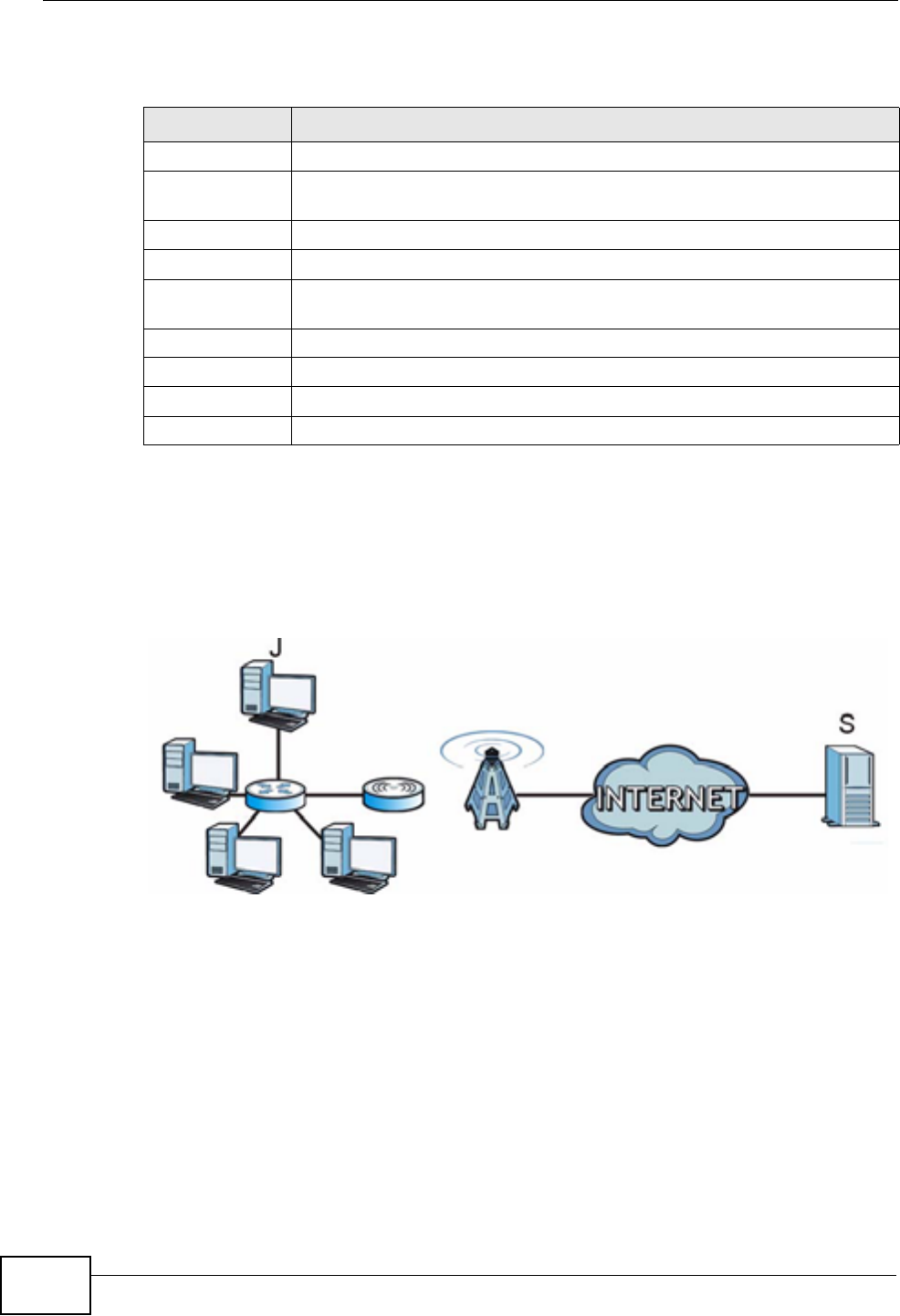
Chapter 7 Network Settings
HES-309M Series User’s Guide
92
This screen contains the following fields:
7.11.2 Trigger Port Forwarding Example
The following is an example of trigger port forwarding. In this example, J is Jane’s
computer and S is the Real Audio server.
Figure 38 Trigger Port Forwarding Example
1Jane requests a file from the Real Audio server (port 7070).
2Port 7070 is a “trigger” port and causes the WiMAX Device to record Jane’s
computer IP address. The WiMAX Device associates Jane's computer IP address
with the "incoming" port range of 6970-7170.
3The Real Audio server responds using a port number ranging between 6970-7170.
4The WiMAX Device forwards the traffic to Jane’s computer IP address.
Table 31 Port Trigger Wizard
LABEL DESCRIPTION
Active Select this to make this port trigger rule active.
Port Trigger
Rule
Select the type of port trigger rule.
Rule Name Enter a name for the port trigger rule.
Trigger Protocol Select the type of port trigger protocol.
Trigger Start
Port
Enter the port trigger start port.
Trigger End Port Enter the port trigger end port.
Open Protocol Select the type of open protocol for the port trigger rule.
Open Start Port Select the starting open port for the port trigger rule.
Open End Port Select the ending open port number for the port trigger rule.
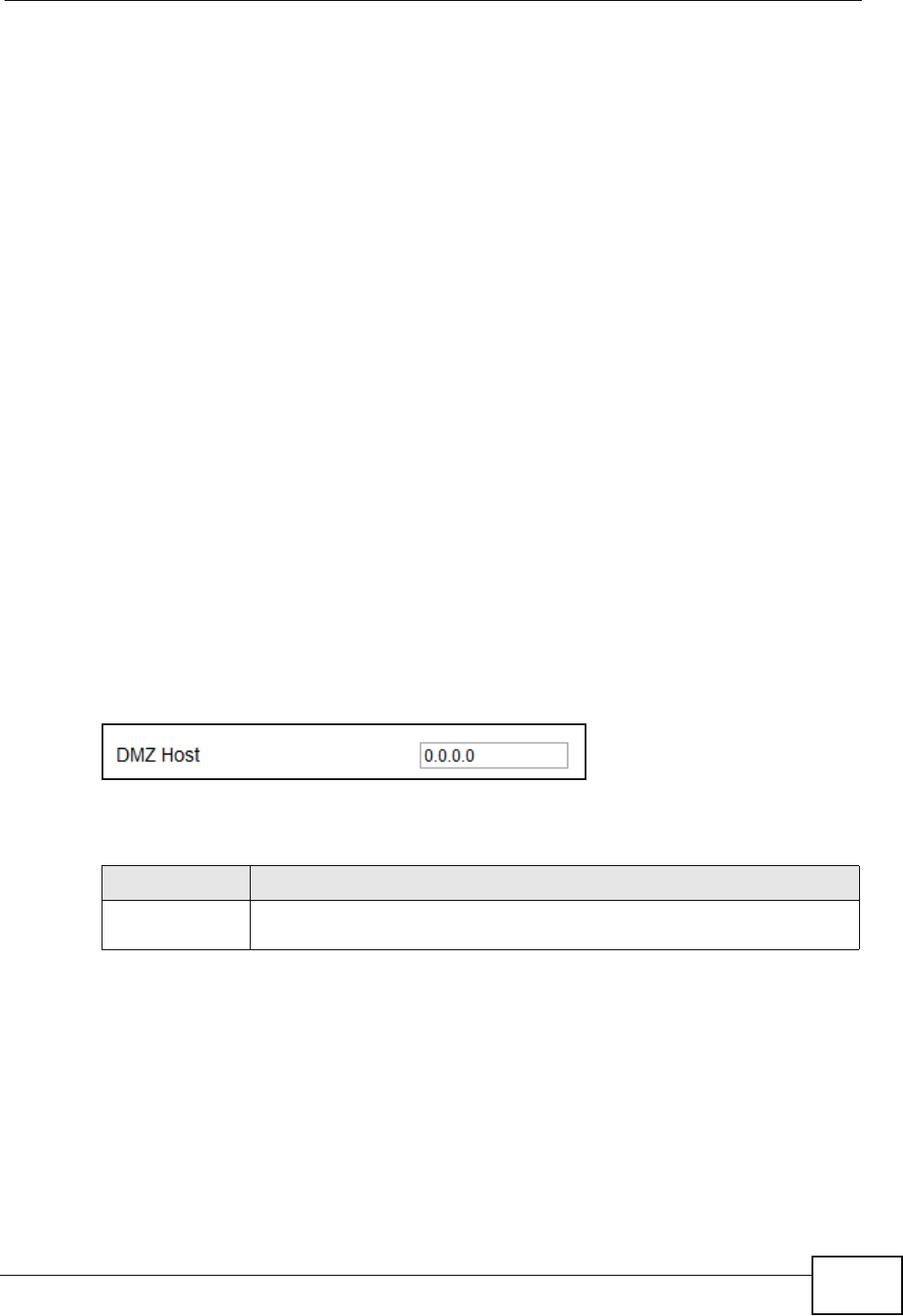
Chapter 7 Network Settings
HES-309M Series User’s Guide 93
5Only Jane can connect to the Real Audio server until the connection is closed or
times out. The WiMAX Device times out in three minutes with UDP (User
Datagram Protocol), or two hours with TCP/IP (Transfer Control Protocol/Internet
Protocol).
Two points to remember about trigger ports:
1Trigger events only happen on data that is coming from inside the WiMAX Device
and going to the outside.
2If an application needs a continuous data stream, that port (range) will be tied up
so that another computer on the LAN can’t trigger it.
7.12 DMZ
Use this page to set the IP address of your network DMZ (if you have one) for the
WiMAX Device. All incoming packets received by this WiMAX Device’s WAN
interface will be forwarded to the DMZ host you set.
Click Network Setting > NAT > DMZ to open this screen as shown next.
Note: The configuration you set in this screen takes priority than the Network Setting
> NAT > Port Forwarding screen.
Figure 39 DMZ Screen
This screen contains the following fields:
Table 32 DMZ
LABEL DESCRIPTION
DMZ Host Enter the IP address of your network DMZ host, if you have one.
0.0.0.0 means this feature is disabled.
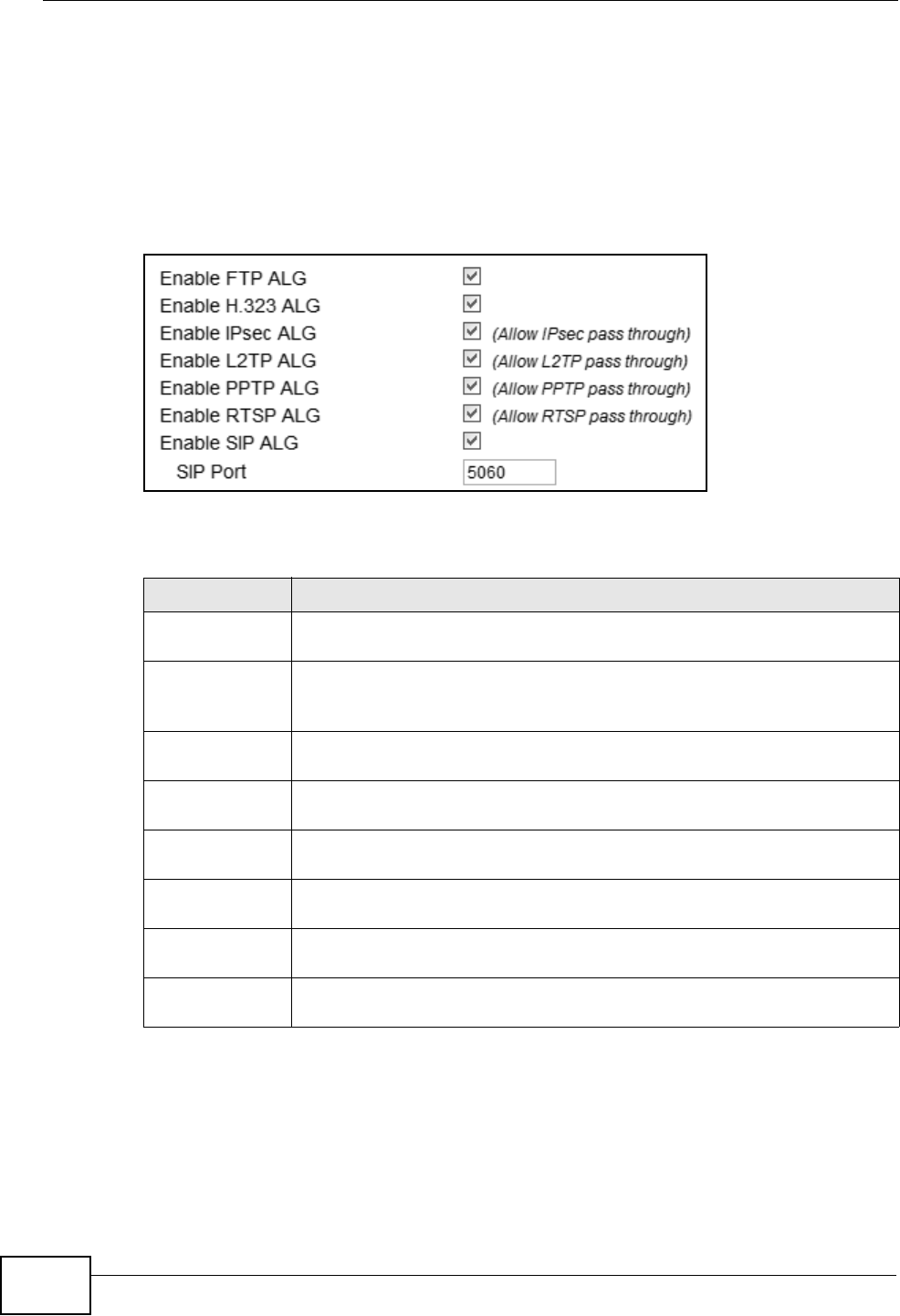
Chapter 7 Network Settings
HES-309M Series User’s Guide
94
7.13 ALG
Use these settings to bypass NAT on your WiMAX Device for those applications
that are "NAT un-friendly".
Click Network Setting > NAT > ALG to open this screen as shown next.
Figure 40 ALG Screen
This screen contains the following fields:
Table 33 ALG
LABEL DESCRIPTION
Enable FTP ALG Turns on the FTP ALG to detect FTP (File Transfer Program) traffic and
helps build FTP sessions through the WiMAX Device’s NAT.
Enable H.323
ALG
Turns on the H.323 ALG to detect H.323 traffic (used for audio
communications) and helps build H.323 sessions through the WiMAX
Device’s NAT.
Enable IPsec
ALG
Turns on the IPsec ALG to detect IPsec traffic and helps build IPsec
sessions through the WiMAX Device’s NAT.
Enable L2TP
ALG
Turns on the L2TP ALG to detect L2TP traffic and helps build L2TP
sessions through the WiMAX Device’s NAT.
Enable PPTP
ALG
Turns on the PPTP ALG to detect PPTP traffic and helps build PPTP
sessions through the WiMAX Device’s NAT.
Enable RTSP
ALG
Turns on the RTSP ALG to detect RTSP traffic and helps build RTSP
sessions through the WiMAX Device’s NAT.
Enable SIP ALG Turns on the SIP ALG to detect SIP traffic and helps build SIP sessions
through the WiMAX Device’s NAT.
SIP Port If you are using a custom UDP port number (not 5060) for SIP traffic,
enter it here.
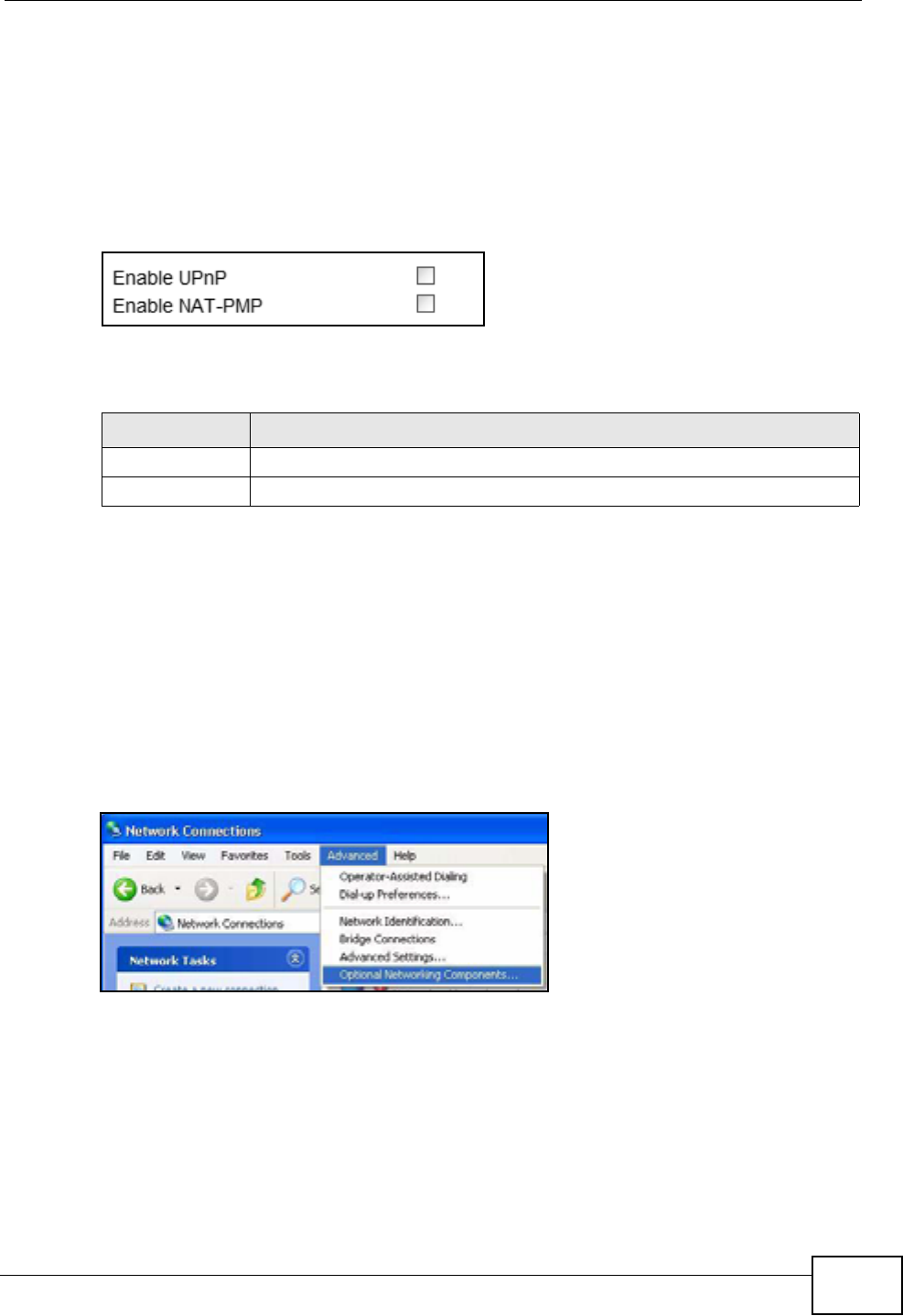
Chapter 7 Network Settings
HES-309M Series User’s Guide 95
7.14 UPnP
Use this page to enable the UPnP networking protocol on your WiMAX Device and
allow easy network connectivity with other UPnP-compatible devices.
Click Network Setting > UPnP to open this screen as shown next.
Figure 41 UPnP Screen
This screen contains the following fields:
7.14.1 Installing UPnP in Windows XP
Follow the steps below to install the UPnP in Windows XP.
1Click Start > Control Panel.
2Double-click Network Connections.
3In the Network Connections window, click Advanced in the main menu and
select Optional Networking Components ….
Table 34 UPnP
LABEL DESCRIPTION
Enable UPnP Select this to enable UPnP on the WiMAX Device.
Enable NAT-PMP Select this to enable NAT Port Mapping Protocol on the WiMAX Device.
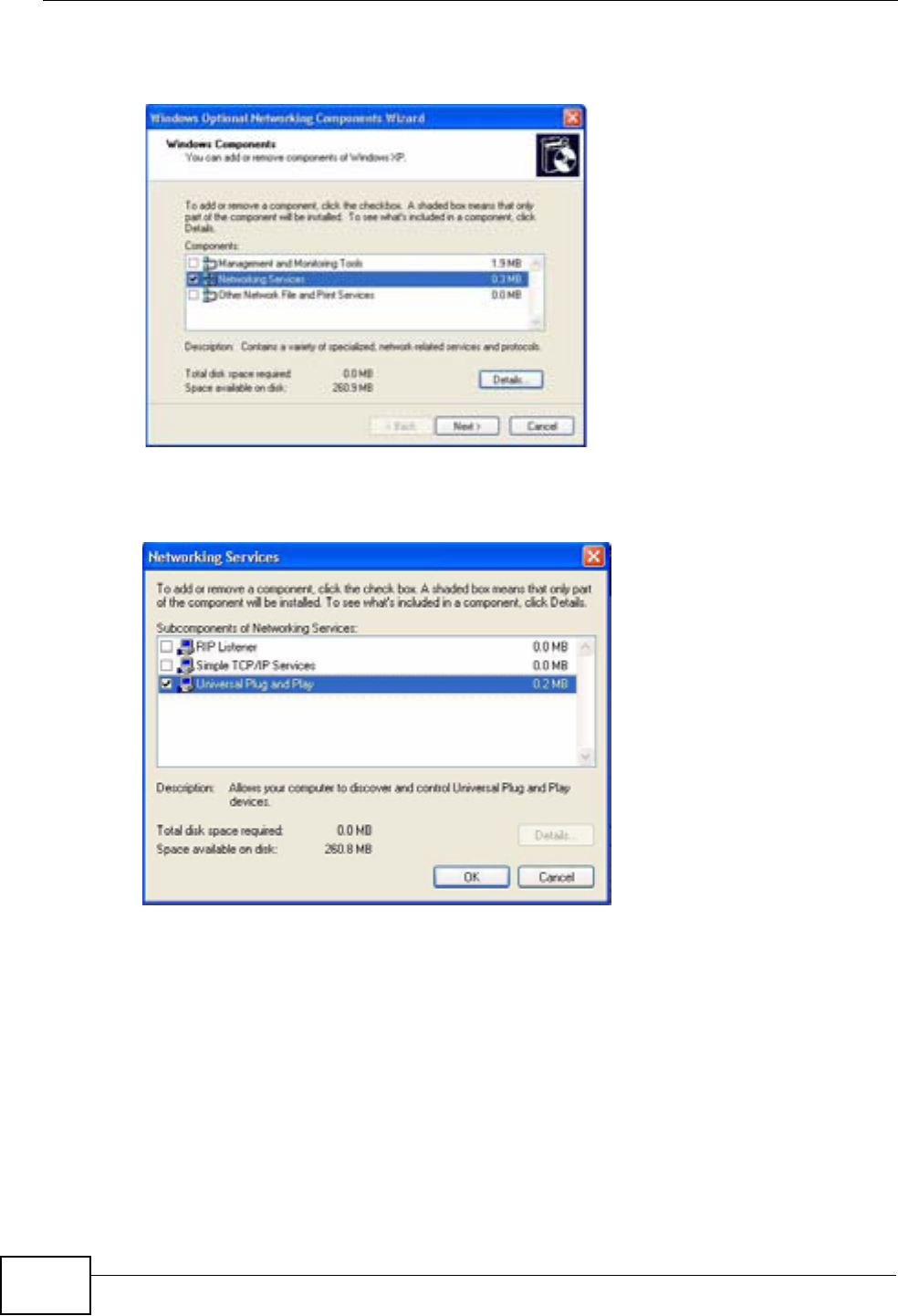
Chapter 7 Network Settings
HES-309M Series User’s Guide
96
4The Windows Optional Networking Components Wizard window displays.
Select Networking Service in the Components selection box and click Details.
5In the Networking Services window, select the Universal Plug and Play check
box.
6Click OK to go back to the Windows Optional Networking Component Wizard
window and click Next.
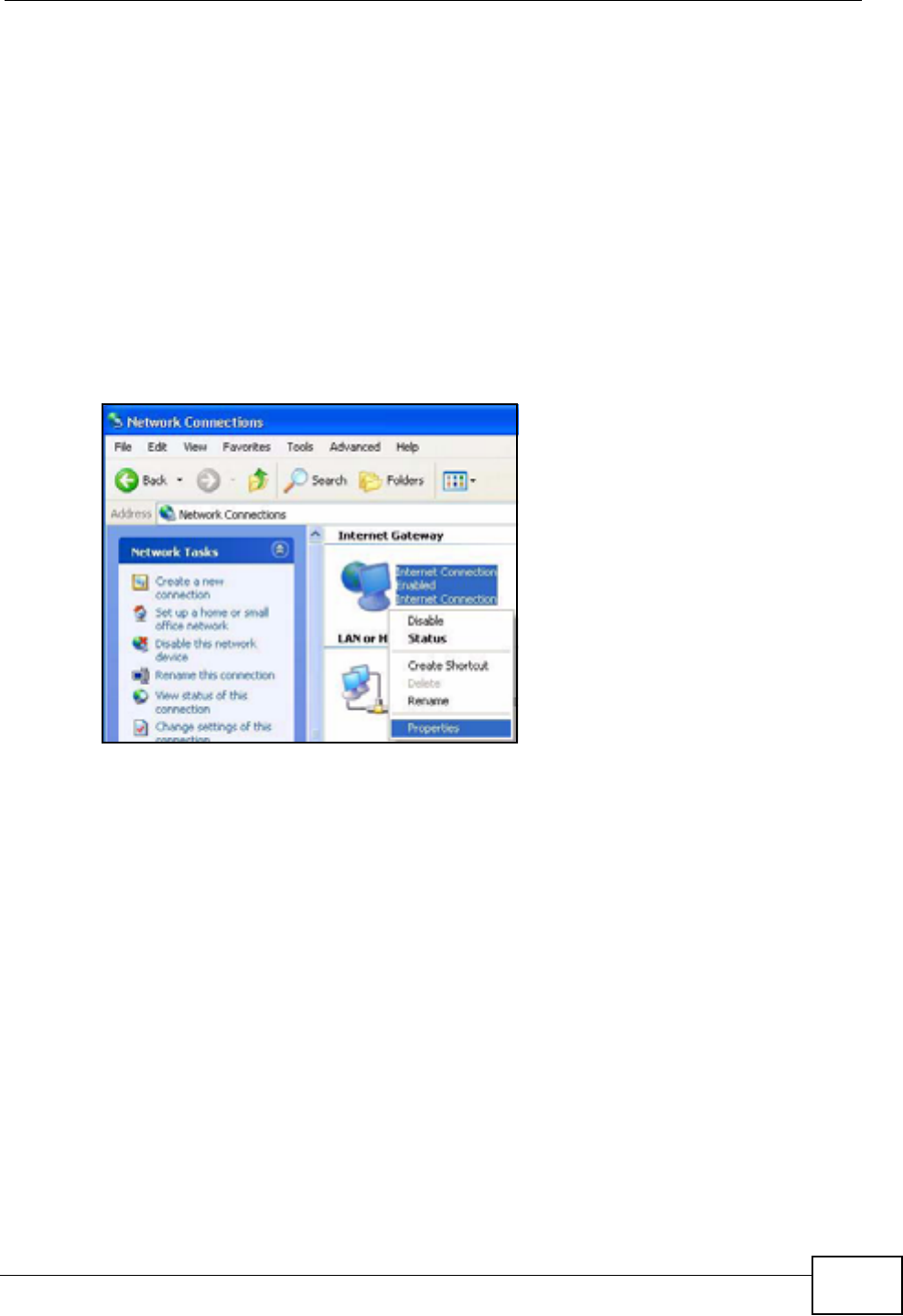
Chapter 7 Network Settings
HES-309M Series User’s Guide 97
7.14.1.1 Auto-discover Your UPnP-enabled Network Device in
Windows XP
This section shows you how to use the UPnP feature in Windows XP. You must
already have UPnP installed in Windows XP and UPnP activated on the WiMAX
Device.
Make sure the computer is connected to a LAN port of the WiMAX Device. Turn on
your computer and the WiMAX Device.
1Click Start and Control Panel. Double-click Network Connections. An icon
displays under Internet Gateway.
2Right-click the icon and select Properties.
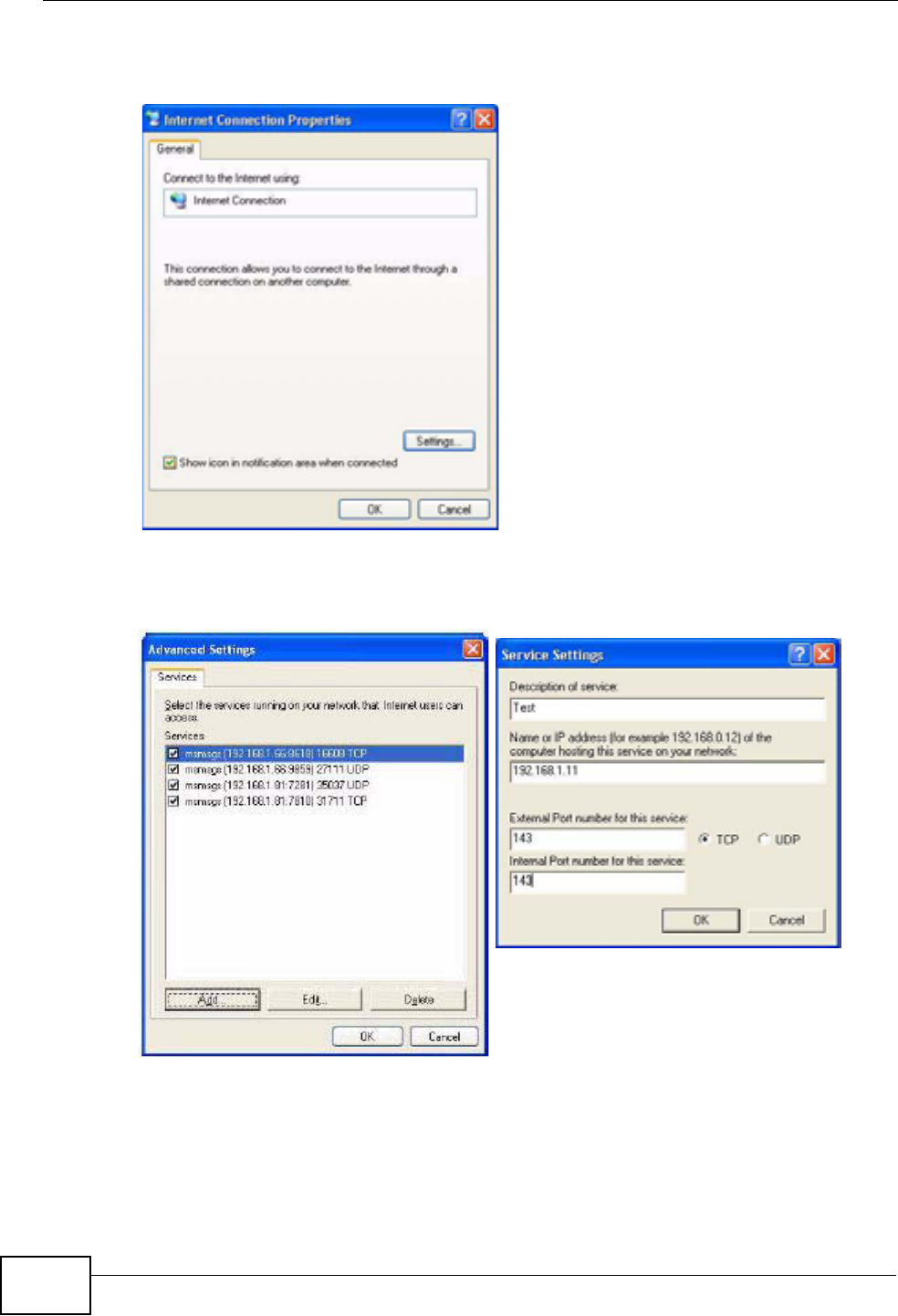
Chapter 7 Network Settings
HES-309M Series User’s Guide
98
3In the Internet Connection Properties window, click Settings to see the port
mappings there were automatically created.
4You may edit or delete the port mappings or click Add to manually add port
mappings.
5When the UPnP-enabled device is disconnected from your computer, all port
mappings will be deleted automatically.
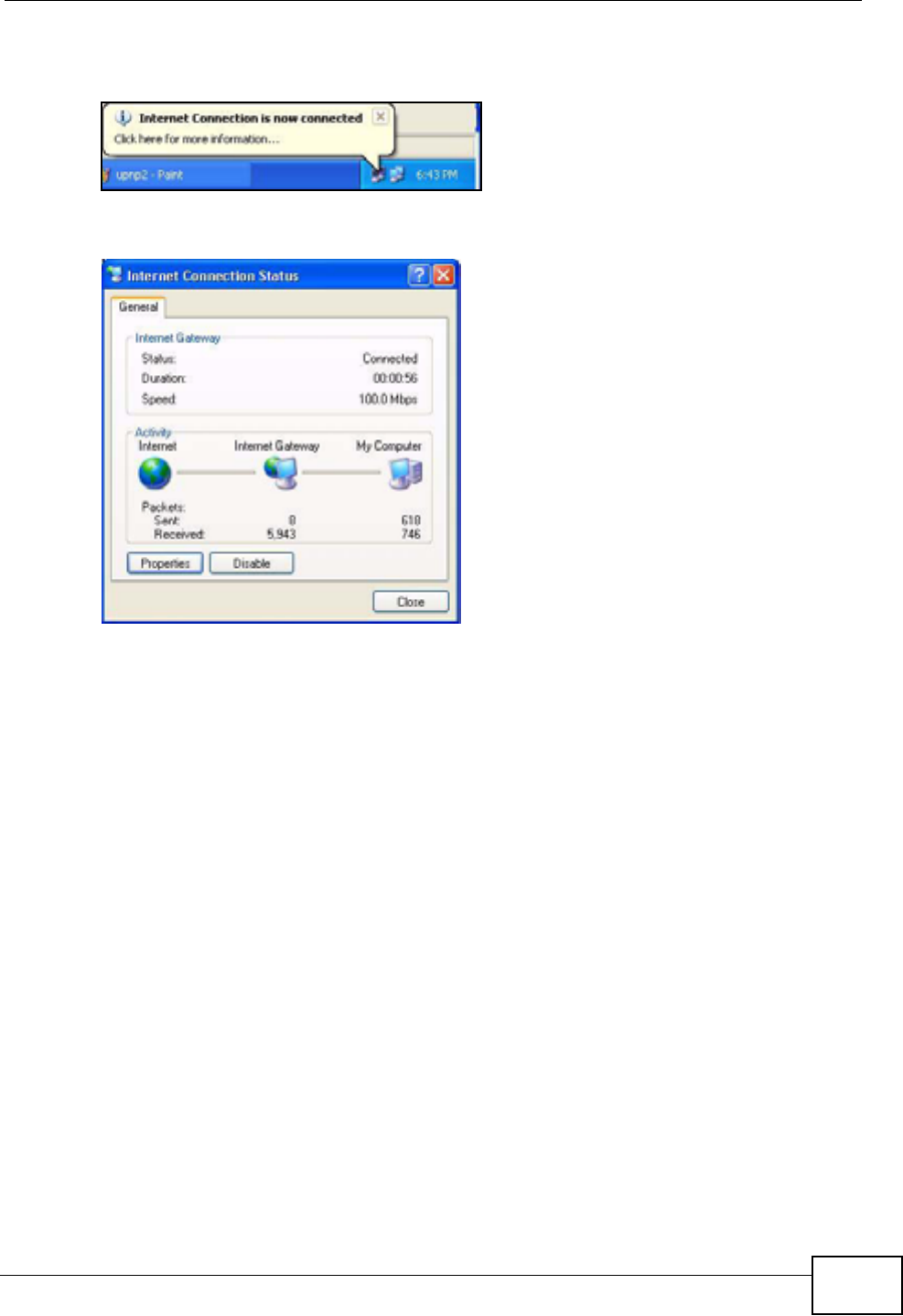
Chapter 7 Network Settings
HES-309M Series User’s Guide 99
6Select Show icon in notification area when connected option and click OK.
An icon displays in the system tray.
7Double-click on the icon to display your current Internet connection status.
7.14.2 Web Configurator Easy Access
With UPnP, you can access the web-based configurator on the WiMAX Device
without finding out the IP address of the WiMAX Device first. This becomes helpful
if you do not know the IP address of the WiMAX Device.
Follow the steps below to access the web configurator:
1Click Start and then Control Panel.
2Double-click Network Connections.
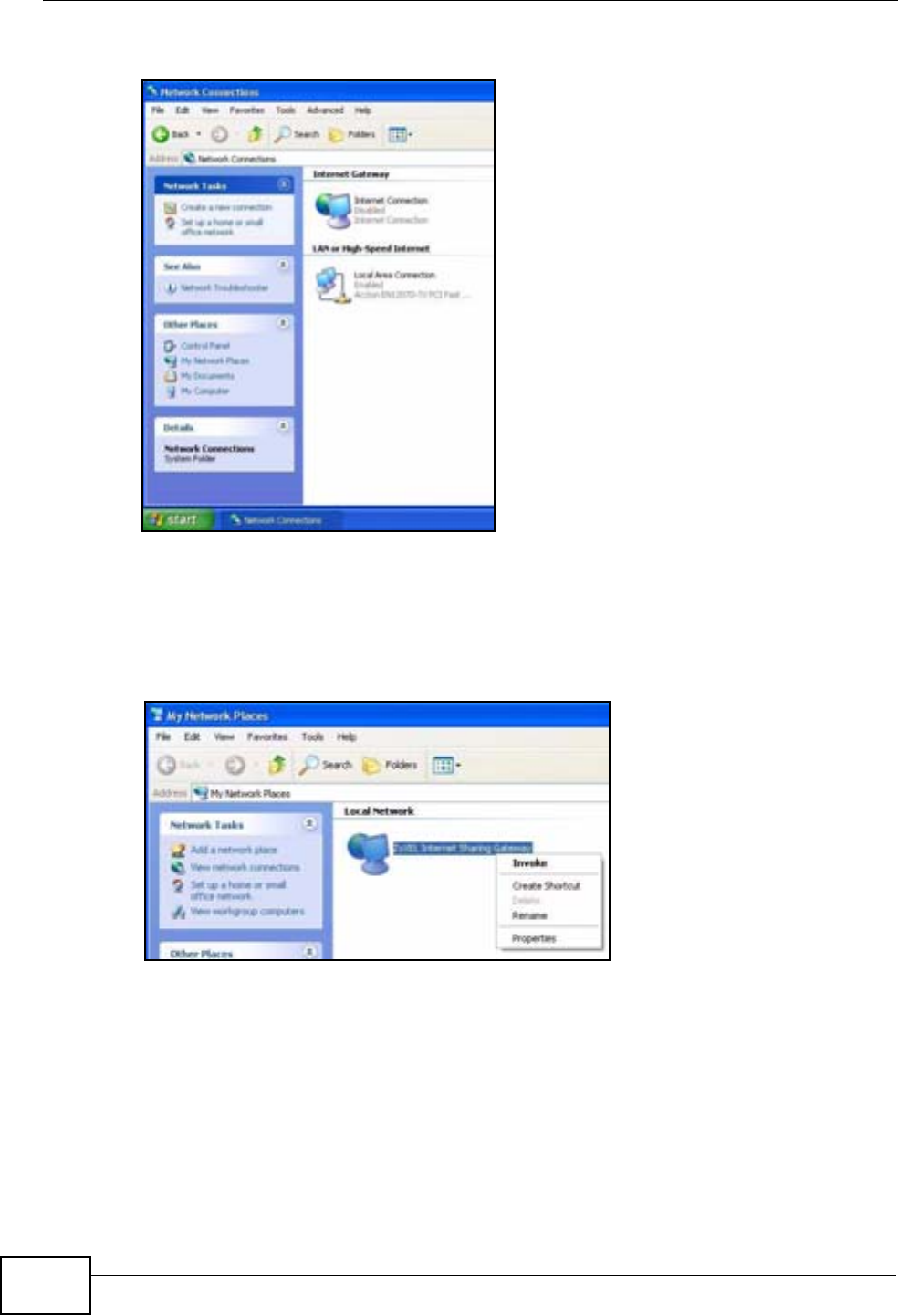
Chapter 7 Network Settings
HES-309M Series User’s Guide
100
3Select My Network Places under Other Places.
4An icon with the description for each UPnP-enabled device displays under Local
Network.
5Right-click on the icon for your WiMAX Device and select Invoke. The web
configurator login screen displays.
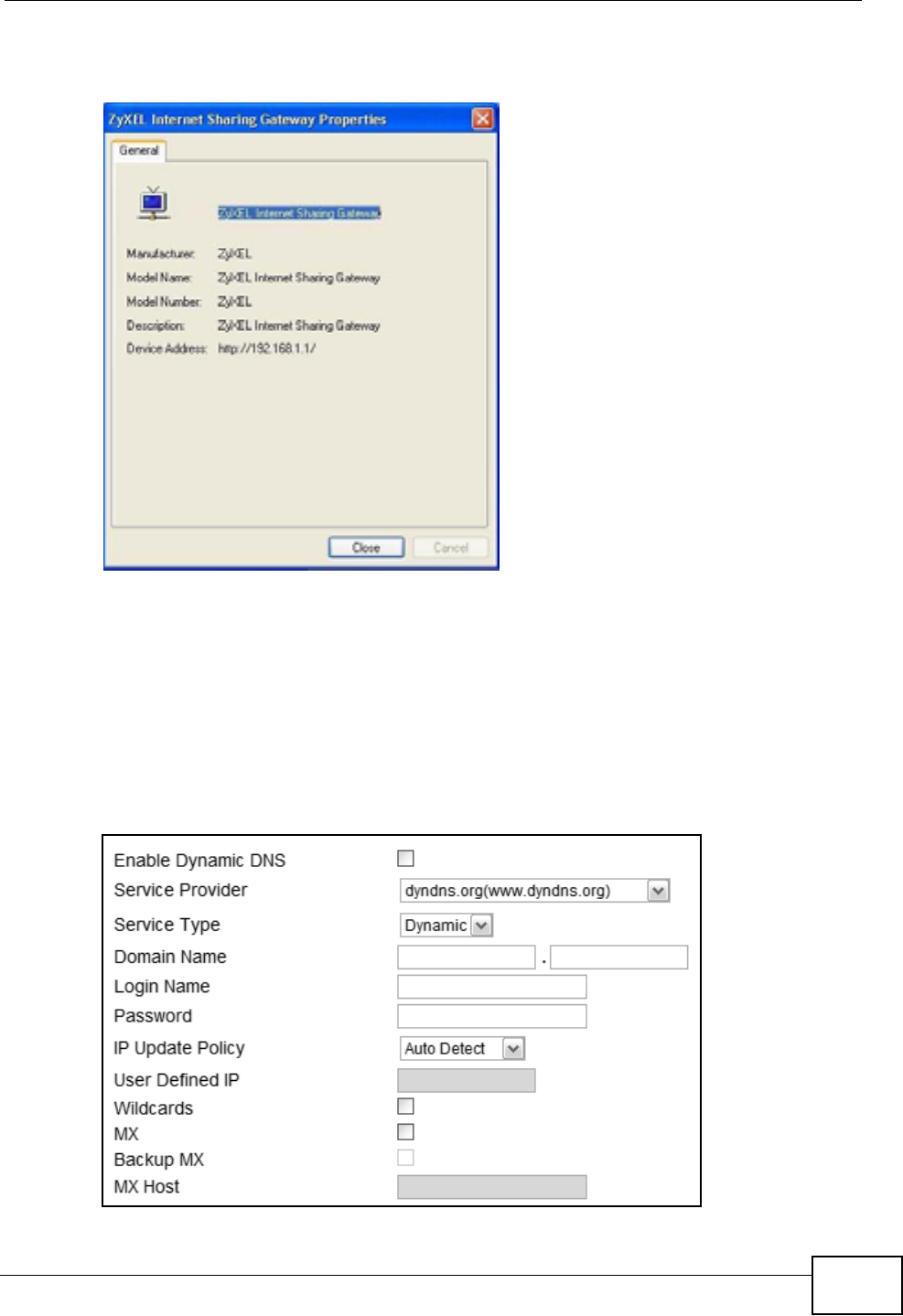
Chapter 7 Network Settings
HES-309M Series User’s Guide 101
6Right-click on the icon for your WiMAX Device and select Properties. A properties
window displays with basic information about the WiMAX Device.
7.15 DDNS
Use this page to configure the WiMAX Device as a dynamic DNS client.
Click Network Setting > DDNS
Figure 42 DDNS Screen
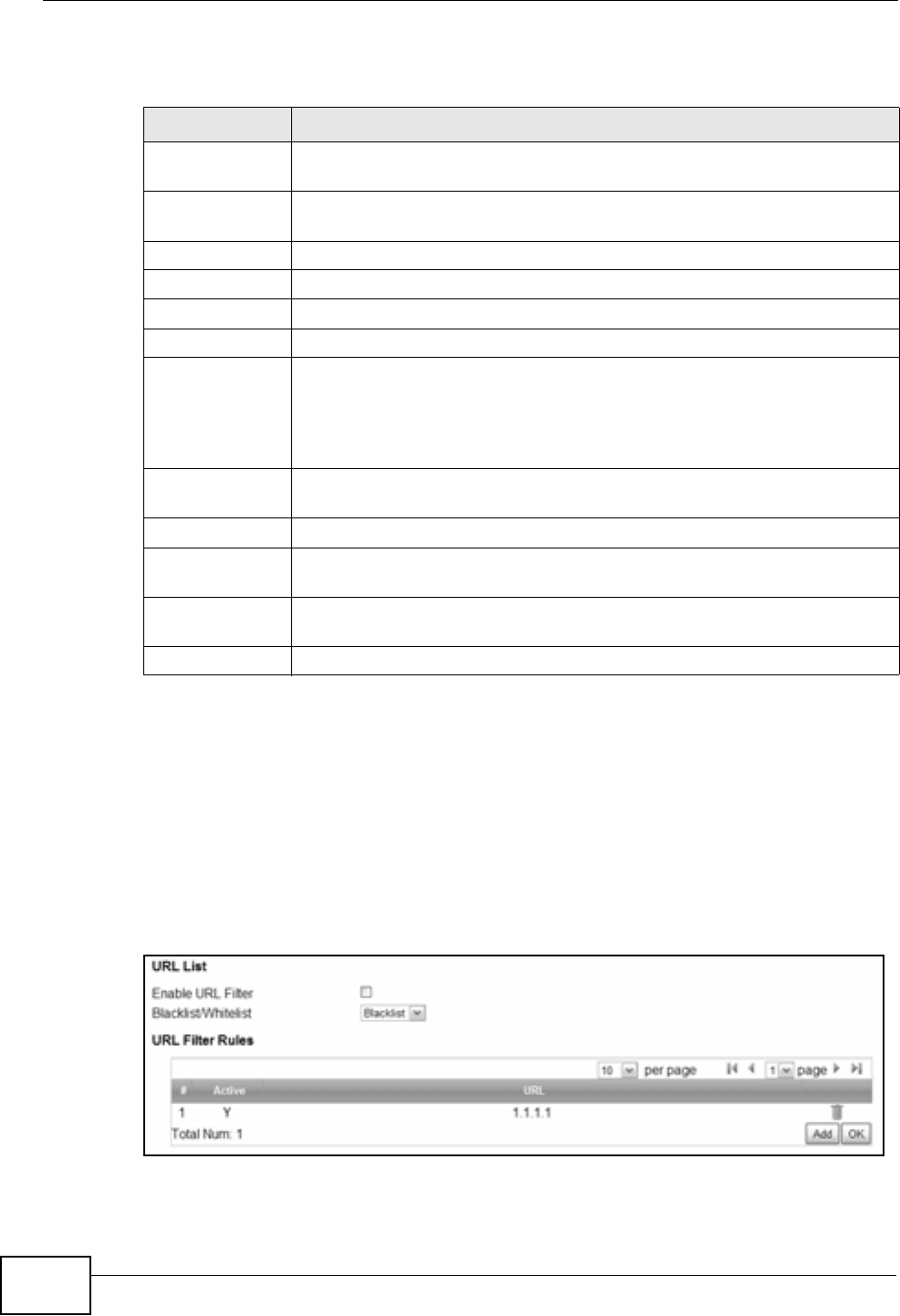
Chapter 7 Network Settings
HES-309M Series User’s Guide
102
This screen contains the following fields:
7.16 Content Filter
Use these settings to allow ("whitelist") or block ("blacklist") connections to and
from specific web sites through the WiMAX Device.
Click Network Setting > Content Filter to open this screen as shown next.
Figure 43 Content Filter Screen
Table 35 DDNS
LABEL DESCRIPTION
Enable Dynamic
DNS
Select this to enable dynamic DNS on the WiMAX Device.
Service
Provider
Select the dynamice DNS service provider for the WiMAX Device.
Service Type Select the dynamic DNS service type.
Domain Name Enter the domain name.
Login Name Enter the user name.
Password Enter the password.
IP Update Policy Select the policy used by the WiMAX Device. Options are:
•Auto Detect
•WAN
•User Defined
User Defined IP If chose “User Defined” for the IP Update Policy, enter the user
defined IP address.
Wildcards Select this to allow a hostname to use wildcards such as “*”.
MX Select this to enable mail routing, if supported by the specified DYNDNS
service provider.
Backup MX Select this to enable a secondary mail routing, if supported by the
specified DYNDNS service provider.
MX Host Enter the host to which mail is routed when the MX option is selected.

Chapter 7 Network Settings
HES-309M Series User’s Guide 103
This screen contains the following fields:
Table 36 Content Filter
LABEL DESCRIPTION
URL List
Enable URL
Filter Select this employ the content filter to allow (“whitelist”) or block
(“blacklist”) specific URL connections made through the WiMAX Device.
Blacklist/
Whitelist Select whether the current filtering applies to the blacklist (sites that
are blocked) or the whitelist (sites that are allowed).
URL Filter Rule
Active Indicates whether the current URL filter is active or not.
URL Indicates the URL to be filtered according to blacklist or whitelist rules.
Delete Click this to delete a specified rule.
Add Click this to add a new filter rule.
OK Click this to save any changes made to the list.

Chapter 7 Network Settings
HES-309M Series User’s Guide
104

HES-309M Series User’s Guide 105
CHAPTER 8
Security
8.1 Overview
This chapter shows you how to configure the WiMAX Device’s network settings.
8.1.1 What You Need to Know
The following terms and concepts may help as you read through this chapter.
About the WiMAX Device’s Security Features
The WiMAX Device security features are designed to protect against Denial of
Service attacks when activated as well as block access to and from specific URLs
and MAC addresses. Its purpose is to allow a private Local Area Network (LAN) to
be securely connected to the Internet. The WiMAX Device can be used to prevent
theft, destruction and modification of data.
The WiMAX Device is installed between the LAN and a WiMAX base station
connecting to the Internet. This allows it to act as a secure gateway for all data
passing between the Internet and the LAN.
The WiMAX Device has one Ethernet (LAN) port. The LAN (Local Area Network)
port attaches to a network of computers, which needs security from the outside
world. These computers will have access to Internet services such as e-mail, FTP
and the World Wide Web. However, “inbound access” is not allowed (by default)
unless the remote host is authorized to use a specific service.

Chapter 8 Security
HES-309M Series User’s Guide
106
8.2 IP Filter
Use this screen to block incoming connections from specific IP addresses.
Click Security > Firewall > IP Filter to open this screen as shown next.
Figure 44 IP Filter Screen
This screen contains the following fields:
Table 37 IP Filter
LABEL DESCRIPTION
Active Indicates whether the current IP filter is active or not.
Source IP This displays the source IP address for the IP filter rule.
Click Add to create a new, empty rule, then enter the incoming IP
address for the WiMAX Device to block.
If you want to delete this rule, click the Delete icon.
Source Port This displays the source port number for the IP filter rule.
Click Add to create a new, empty rule, then enter the incoming port
number for the WiMAX Device to block.
If you want to delete this rule, click the Delete icon.
Destination IP This displays the destination IP address for the IP filter rule.
Click Add to create a new, empty rule, then enter the outgoing IP
address for the WiMAX Device to block.
If you want to delete this rule, click the Delete icon.
Destination Port This displays the destination port number for the IP filter rule.
Click Add to create a new, empty rule, then enter the outgoing port
number for the WiMAX Device to block.
If you want to delete this rule, click the Delete icon.
Protocol This displays the protocol blocked by the IP filter rule.
Click Add to create a new, empty rule, then select the protocol type for
the WiMAX Device to block.
If you want to delete this rule, click the Delete icon.
Delete Click this to delete a specified rule.
Add Click this to add a new filter rule.
OK Click this to save any changes made to the list.
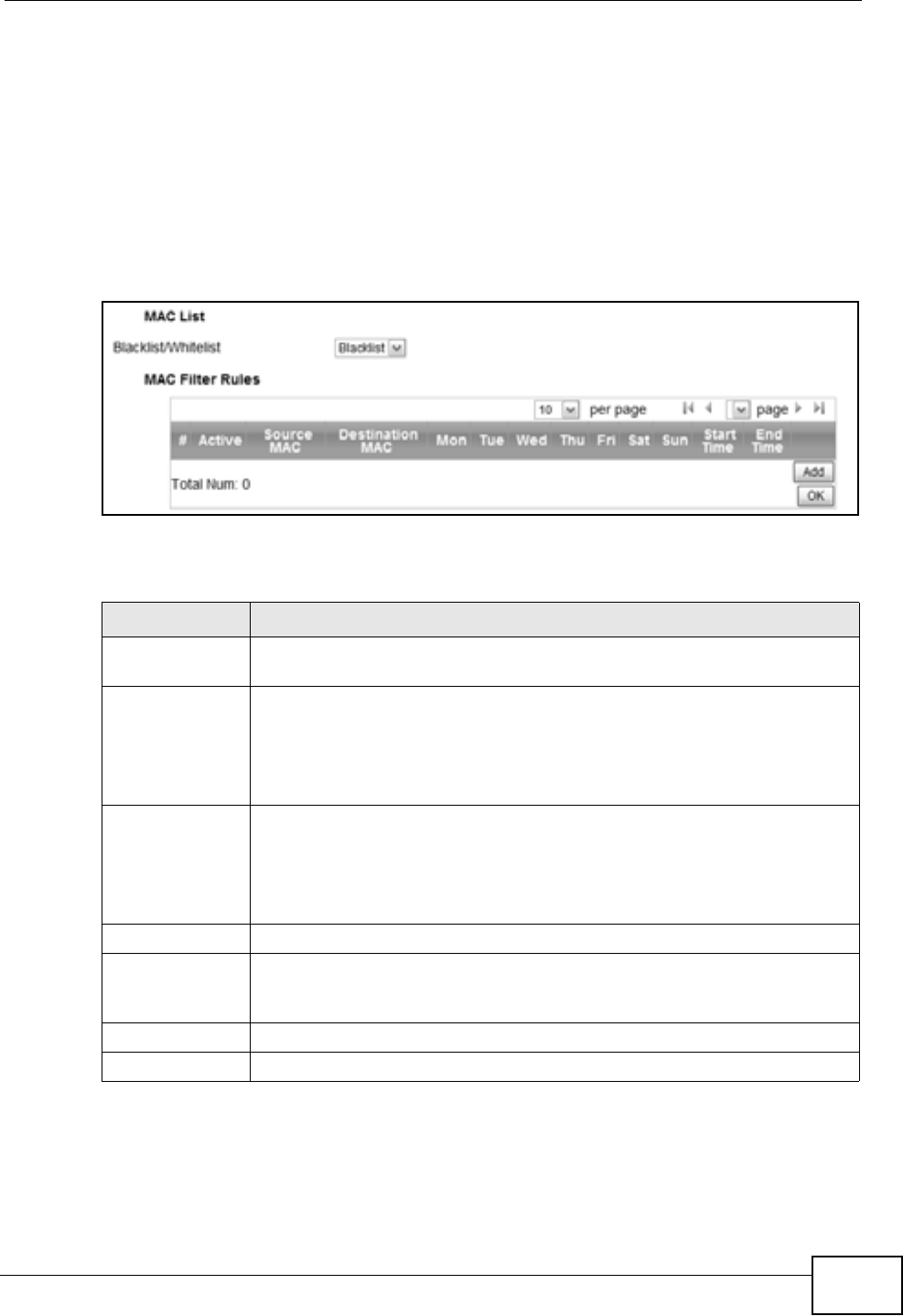
Chapter 8 Security
HES-309M Series User’s Guide 107
8.3 MAC Filter
Use this screen to allow ("whitelist") or block ("blacklist") connections to and from
specific devices on the network based on their unique MAC addresses.
Note: This feature only works when the WiMAX Device is in bridge mode.
Click Security > Firewall > MAC Filter to open this screen as shown next.
Figure 45 MAC Filter Screen
This screen contains the following fields:
Table 38 MAC Filter
LABEL DESCRIPTION
Blacklist/
Whitelist
Select either whitelist or blacklist for viewing and editing.
Source MAC This displays the source MAC for the MAC filter rule.
Click Add to create a new, empty rule, then enter the incoming MAC
address for the WiMAX Device to block.
If you want to delete this rule, click the Delete icon.
Destination
MAC
This displays the destination MAC for the MAC filter rule.
Click Add to create a new, empty rule, then enter the outgoing MAC
address for the WiMAX Device to block.
If you want to delete this rule, click the Delete icon.
Mon ~ Sun Select which days of the week you want the filter rule to be effective.
Start / End
Time
Select what time each day you want the filter rule to be effective. Enter
times in 24-hour format; for example, 3:00pm should be entered as
15:00.
Add Click this to add a new filter rule.
OK Click this to save any changes made to the list.
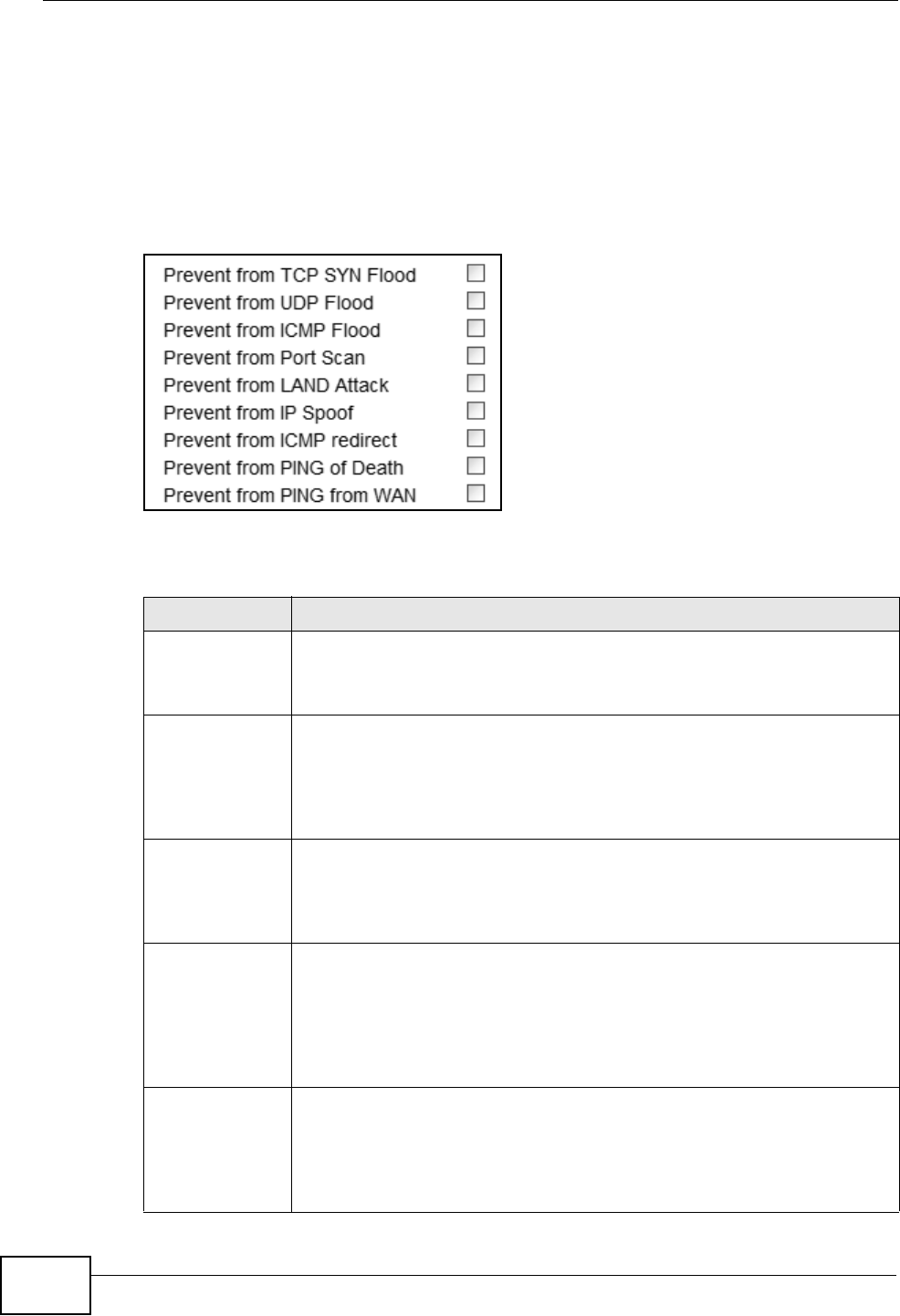
Chapter 8 Security
HES-309M Series User’s Guide
108
8.4 DDOS
Use these settings to potentially block specific types of Denial of Service attacks
directed at your WiMAX Device.
Click Security > Firewall > DDOS to open this screen as shown next.
Figure 46 DDOS Screen
This screen contains the following fields:
Table 39 DDOS
LABEL DESCRIPTION
Prevent from
TCP SYN Flood
Select this to monitor for and block TCP SYN flood attacks.
A SYN flood is one type of denial of service attack where an
overwhelming number of SYN requests assault a client device.
Prevent from
UDP Flood
Select this to monitor for and block UDP flood attacks.
An UDP flood is a type of denial of service attack where an
overwhelming number of UDP packets assault random ports on a client
device. Because the device is forced to analyze and respond to each
packet, it quickly becomes unreachable to other devices.
Prevent from
ICMP Flood
Select this to monitor for and block ICMP flood attacks.
An ICMP flood is a type of denial of service attack where an
overwhelming number of ICMP ping assault a client device, locking it
down and preventing it from responding to requests from other servers.
Prevent from
Port Scan
Select this to monitor for and block port scan attacks.
A port scan attack is typicall the precursor to a full-blown denial of
service attack wherein each port on a device is probed for security holes
that can be exploited. Once a security flaw is discovered, an attacker
can initiate the appropriate denial of service attack or intrusion attack
against the client device.
Prevent from
LAND Attack
Select this to monitor for and block LAND attacks.
A Local Area Network Denial (LAND) attack is a type of denial of service
attack where a spoofed TCP SYN packet targets a client device’s IP
address and forces it into an infinite recursive loop of querying itself and
then replying, effectively locking it down.

Chapter 8 Security
HES-309M Series User’s Guide 109
Prevent from IP
Spoof
Select this to monitor for and block IP address spoof attacks.
An IP address spoof is an attack whereby the source IP address in the
incoming IP packets allows a malicious party to masquerade as a
legitimate user and gain access to the client device.
Prevent from
ICMP redirect
Select this to monitor for and block ICMP redirect attacks.
An ICMP redirect attack is one where forged ICMP redirect messages
can force the client device to route packets for certain connections
through an attacker’s host.
Prevent from
PING of Death
Select this to monitor for and block ping of death attacks.
A Ping of Death (POD) attack is one where larger-than-allowed ping
packets are fragmented then sent against a client device. This results in
the client device suffering from a buffer overflow and subsequent
system crash.
Prevent from
PING from WAN
Select this to ignore ping requests from the WAN.
Table 39 DDOS (continued)
LABEL DESCRIPTION

Chapter 8 Security
HES-309M Series User’s Guide
110

HES-309M Series User’s Guide 111
CHAPTER 9
Maintenance
9.1 Overview
Use these screens to manage and maintain your WiMAX Device.
9.1.1 What You Need to Know
The following terms and concepts may help as you read through this chapter.
Remote Management Limitations
Remote management over LAN or WAN will not work when:
1You have disabled that service in one of the remote management screens.
2The IP address in the Secured Client IP field does not match the client IP
address. If it does not match, the WiMAX Device will disconnect the session
immediately.
3There is already another remote management session with an equal or higher
priority running. You may only have one remote management session running at
one time.

Chapter 9 Maintenance
HES-309M Series User’s Guide
112
Remote Management and NAT
When NAT is enabled:
• Use the WiMAX Device’s WAN IP address when configuring from the WAN.
• Use the WiMAX Device’s LAN IP address when configuring from the LAN.
System Timeout
There is a default system management idle timeout of five minutes. The WiMAX
Device automatically logs you out if the management session remains idle for
longer than this timeout period. The management session does not time out when
a statistics screen is polling.
SNMP
Simple Network Management Protocol (SNMP) is a protocol used for exchanging
management information between network devices. SNMP is a member of the
TCP/IP protocol suite. Your WiMAX Device supports SNMP agent functionality,
which allows a manager station to manage and monitor the WiMAX Device
through the network. The WiMAX Device supports SNMP version one (SNMPv1)
and version two (SNMPv2). The next figure illustrates an SNMP management
operation.
Note: SNMP is only available if TCP/IP is configured.
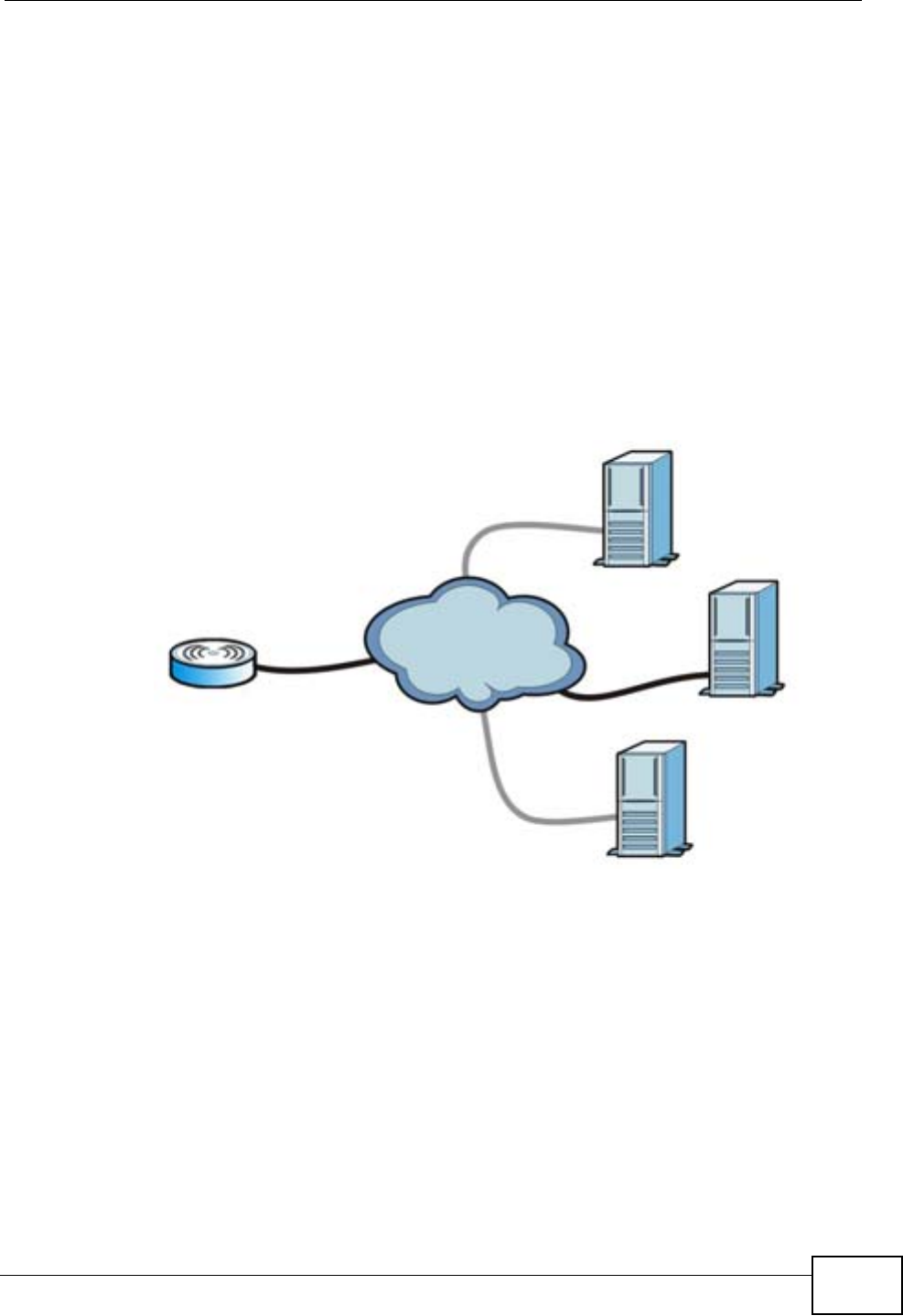
Chapter 9 Maintenance
HES-309M Series User’s Guide 113
TR-069
TR-069 is an abbreviation of “Technical Reference 069”, a protocol designed to
facilitate the remote management of Customer Premise Equipement (CPE), such
as the WiMAX Device. It can be managed over a WAN by means of an Auto
Configuration Server (ACS). TR-069 is based on sending Remote Procedure Calls
(RPCs) between the ACS and the client device. RPCs are sent in Extensible Markup
Language (XML) format over HTTP or HTTPS.
An administrator can use an ACS to remotely set up the WiMAX Device, modify its
settings, perform firmware upgrades, and monitor and diagnose it. In order to do
so, you must enable the TR-069 feature on your WiMAX Device and then configure
it appropriately. (The ACS server which it will use must also be configured by its
administrator.)
Figure 47 TR-069 Example
In this example, the WiMAX Device receives data from at least 3 sources: A SIP
server for handling voice calls, an HTTP server for handling web services, and an
ACS, for configuring the WiMAX Device remotely. All three servers are owned and
operated by the client’s Internet Service Provider. However, without the
configuration settings from the ACS, the WiMAX Device cannot access the other
two servers. Once the WiMAX Device receives its configuration settings and
implements them, it can connect to the other servers. If the settings change, it
will once again be unable to connect until it receives its updates from the ACS.
The WiMAX Device can be configured to periodically check for updates from the
auto-configuration server so that the end user need not be worried about it.
SIP
ACS
HTTP
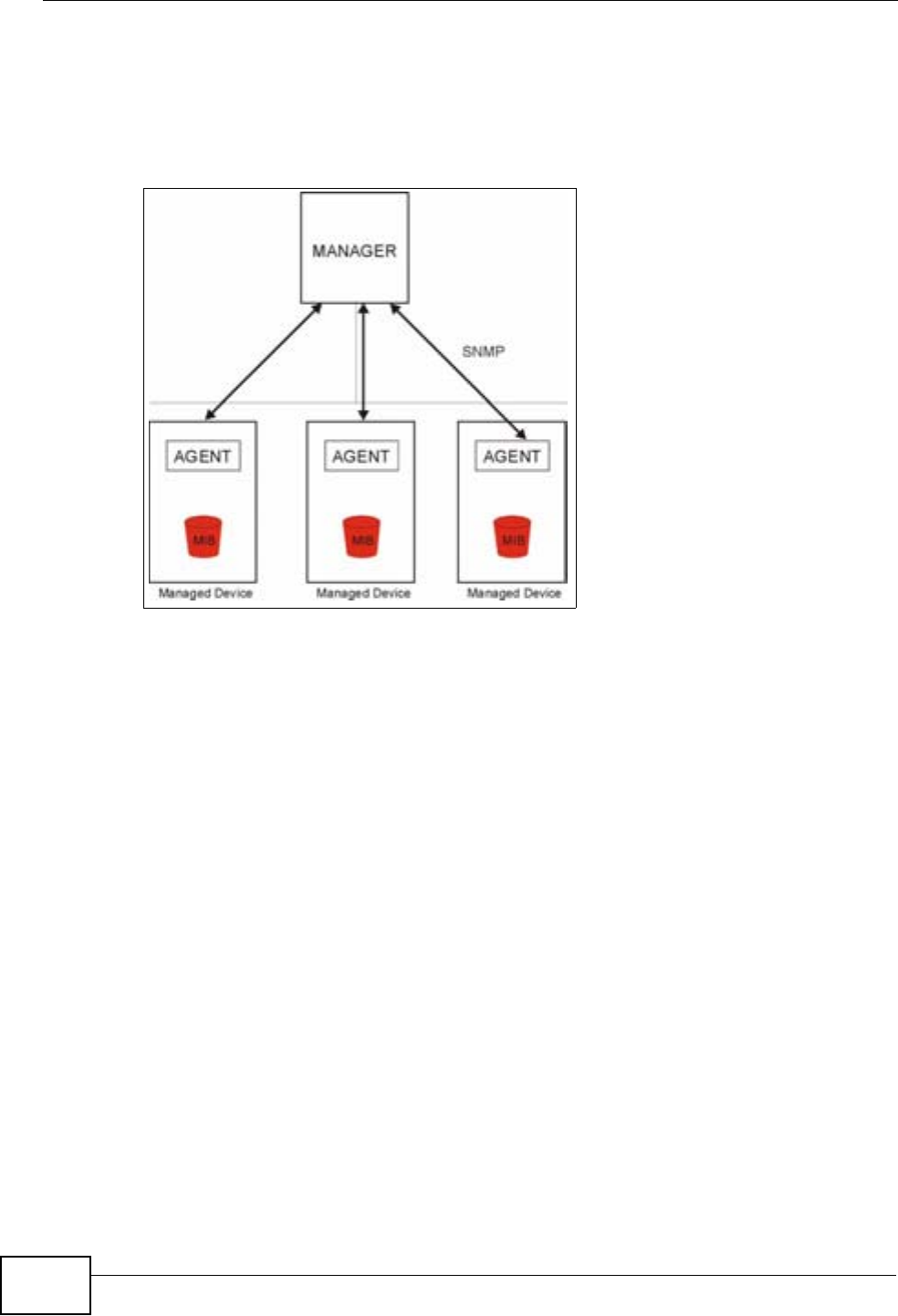
Chapter 9 Maintenance
HES-309M Series User’s Guide
114
SNMP
An SNMP managed network consists of two main types of component: agents and
a manager.
Figure 48 SNMP Management Model
An agent is a management software module that resides in a managed device (the
WiMAX Device). An agent translates the local management information from the
managed device into a form compatible with SNMP. The manager is the console
through which network administrators perform network management functions. It
executes applications that control and monitor managed devices.
The managed devices contain object variables/managed objects that define each
piece of information to be collected about a device. Examples of variables include
such as number of packets received, node port status etc. A Management
Information Base (MIB) is a collection of managed objects. SNMP allows a
manager and agents to communicate for the purpose of accessing these objects.
The WiMAX Device supports MIB II that is defined in RFC-1213 and RFC-1215. The
focus of the MIBs is to let administrators collect statistical data and monitor status
and performance.
SNMP itself is a simple request/response protocol based on the manager/agent
model. The manager issues a request and the agent returns responses using the
following protocol operations:
• Get - Allows the manager to retrieve an object variable from the agent.
• GetNext - Allows the manager to retrieve the next object variable from a table
or list within an agent. In SNMPv1, when a manager wants to retrieve all
elements of a table from an agent, it initiates a Get operation, followed by a
series of GetNext operations.

Chapter 9 Maintenance
HES-309M Series User’s Guide 115
• Set - Allows the manager to set values for object variables within an agent.
• Trap - Used by the agent to inform the manager of some events.
The WiMAX Device sends traps to the SNMP manager when any of the following
events occurs:
OMA-DM
When the WiMAX Device initiates communication with the server (often times at
start up or after the first time you turn it on), the server uploads commands, new
files (if any), and other information used by a service provider to customize the
WiMAX Device’s features.
Device management works as follows:
1The server (A) sends out the query (1) to the WiMAX Device (B).
2The WiMAX Device responds by sending back its credentials (2), to which the
server responds with its credentials along with a string of management operations
(3).
3The client responds to the management operations (4), perhaps confirming file
alterations or confirming receipt of file uploads and so on.
Table 40 SNMP Traps
TRAP # TRAP NAME DESCRIPTION
0coldStart (defined in RFC-
1215)
A trap is sent after booting (power on).
1warmStart (defined in RFC-
1215)
A trap is sent after booting (software reboot).
4authenticationFailure (defined
in RFC-1215)
A trap is sent to the manager when receiving
any SNMP get or set requirements with the
wrong community (password).
6whyReboot (defined in ZYXEL-
MIB)
A trap is sent with the reason of restart before
rebooting when the system is going to restart
(warm start).
6a For intentional reboot: A trap is sent with the message "System reboot
by user!" if reboot is done intentionally, (for
example, download new files, CI command "sys
reboot", etc.).
6b For fatal error: A trap is sent with the message of the fatal
code if the system reboots because of fatal
errors.
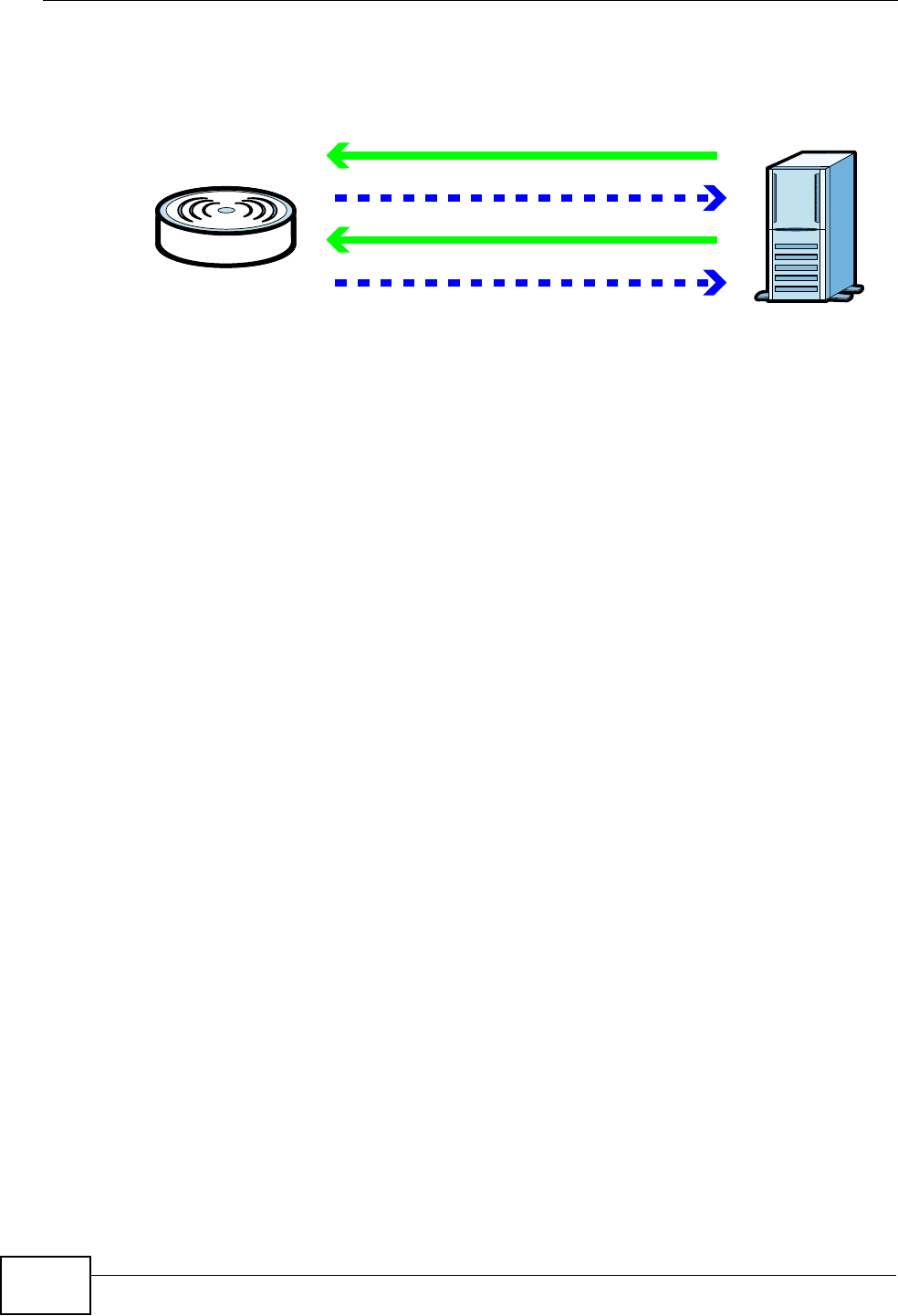
Chapter 9 Maintenance
HES-309M Series User’s Guide
116
4The server disconnects from the WiMAX Device once all of its management
operations have been carried out.
Figure 49 OMA-DM Data Management
OMA-DM Authentication
In order to ensure the integrity of the connection between an OMA-DM server and
the WiMAX Device, communication between the two is encoded using one of three
common algorithms. They are not intended to be used in lieu of proper digital
security, but instead as a means of transmitting multiple disparate types of data
over HTTP. Security encryption for communication is handled by different
processes configured elsewhere in the WiMAX Device’s web configurator
Basic Access Authentication –Sends a person’s user name and password in
Base64. This auhentication protocol is supported by all browsers that are HTTP
1.0/1.1 compliant. Although converted to Base64 for the sake of cross-
compatibility, credentials are nonetheless passed between the web browser and
the server in plaintext, making it extremely easy to intercept and read. As such, it
is rarely used anymore.
Digest Access Authentication –This protocol was designed to replace basic
access authentication. Instead of encoding a user name and password in plaintext,
this protocol uses what is known as an MD5 message authentication code. It
allows the server to issue a single-use, randomly generated number (known as a
‘nonce’) to the client (in this case, the web browser), which then uses the number
as the ‘public key’ for encrypting its data. When the server receives the encrypted
data, it unlocks it using the ‘key’ that was just provided. While stronger than basic
access authentication, this protocol is not as strong as, say, HMAC, or as secure as
the client using a client-side private key encryption scheme.
Hash Message Authentication Code –Also known as HMAC, this code relies on
cryptographic hash functions to bolster an existing protocol, such as MD5. It is a
method for generating a stronger, significantly higher encryption key.
A
B1
2
3
4
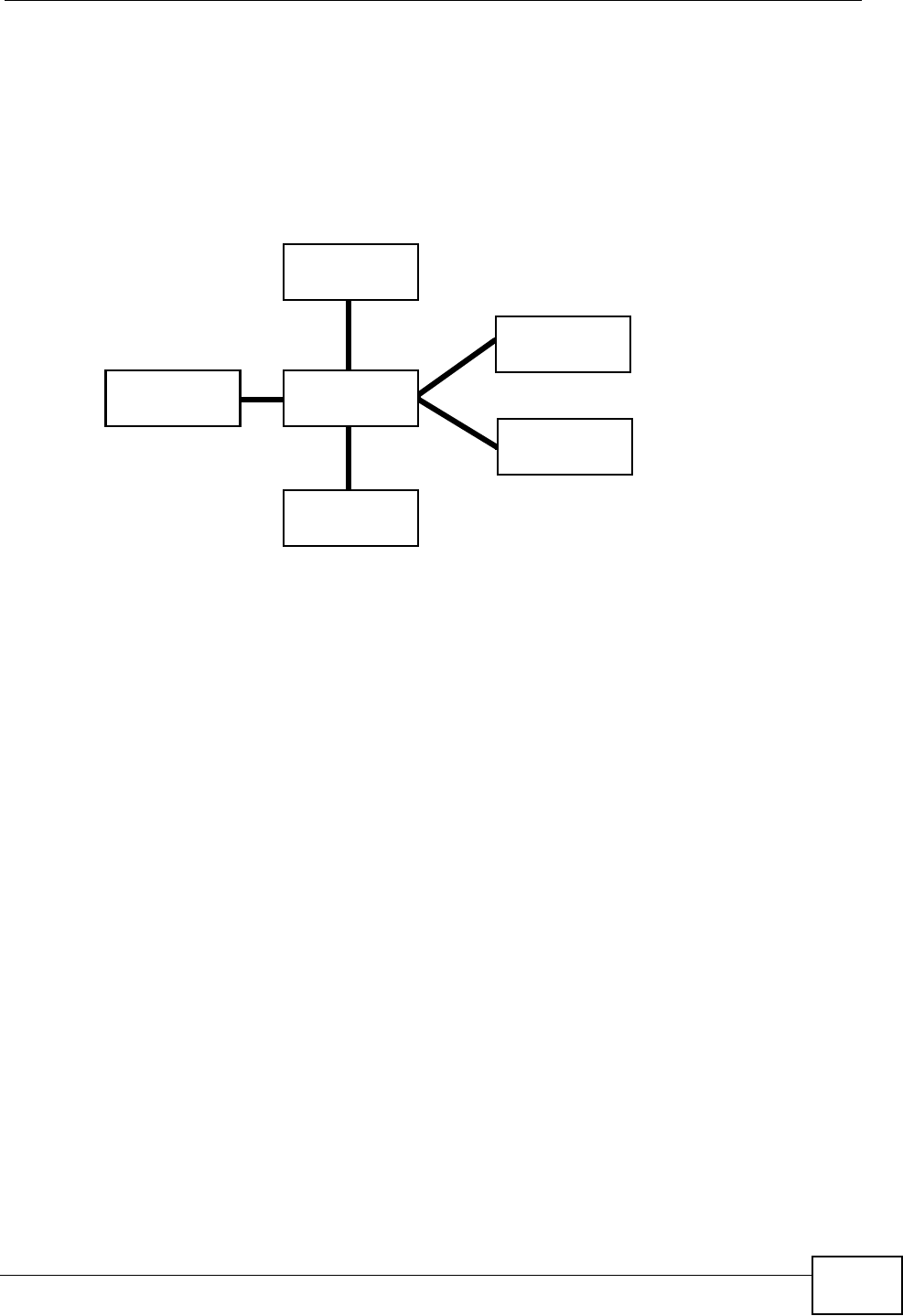
Chapter 9 Maintenance
HES-309M Series User’s Guide 117
OMA-DM Data Model
Each device that conforms to the current OMA-DM standard has an identical data
structure embedded in its controlling firmware. This allows a similarly conforming
OMA-DM server to navigate the folder structure and to make file alterations where
appropriate or required.
Figure 50 OMA-DM Data Model
In the example data model shown here, the parent folders must conform to the
OMA-DM standard. The child folders, on the other hand, can be customized on an
individual basis. This allows the parent folders to all maintain a consistent URI
(Uniform Resource Indentifier) across all devices that meet the OMA-DM
standard’s requirements.
For example, in the preceding figure the URI for the “Games” folder is “./Vendor/
Games/”. The “./Vendor/” portion of the URI exists on all devices that conform to
the OMA-DM standard. The “Games” folder, however, may or may not exist
depending on the services provided by the company managing the device.
Daytime
A network protocol used by devices for debugging and time measurement. A
computer can use this protocol to set its internal clock but only if it knows in which
order the year, month, and day are returned by the server. Not all servers use the
same format.
Time
A network protocol for retrieving the current time from a server. The computer
issuing the command compares the time on its clock to the information returned
by the server, adjusts itself automatically for time zone differences, then
calculates the difference and corrects itself if there has been any temporal drift.
Root Folder
./
DMAcc
Vendor
Operator
MP3s
Games
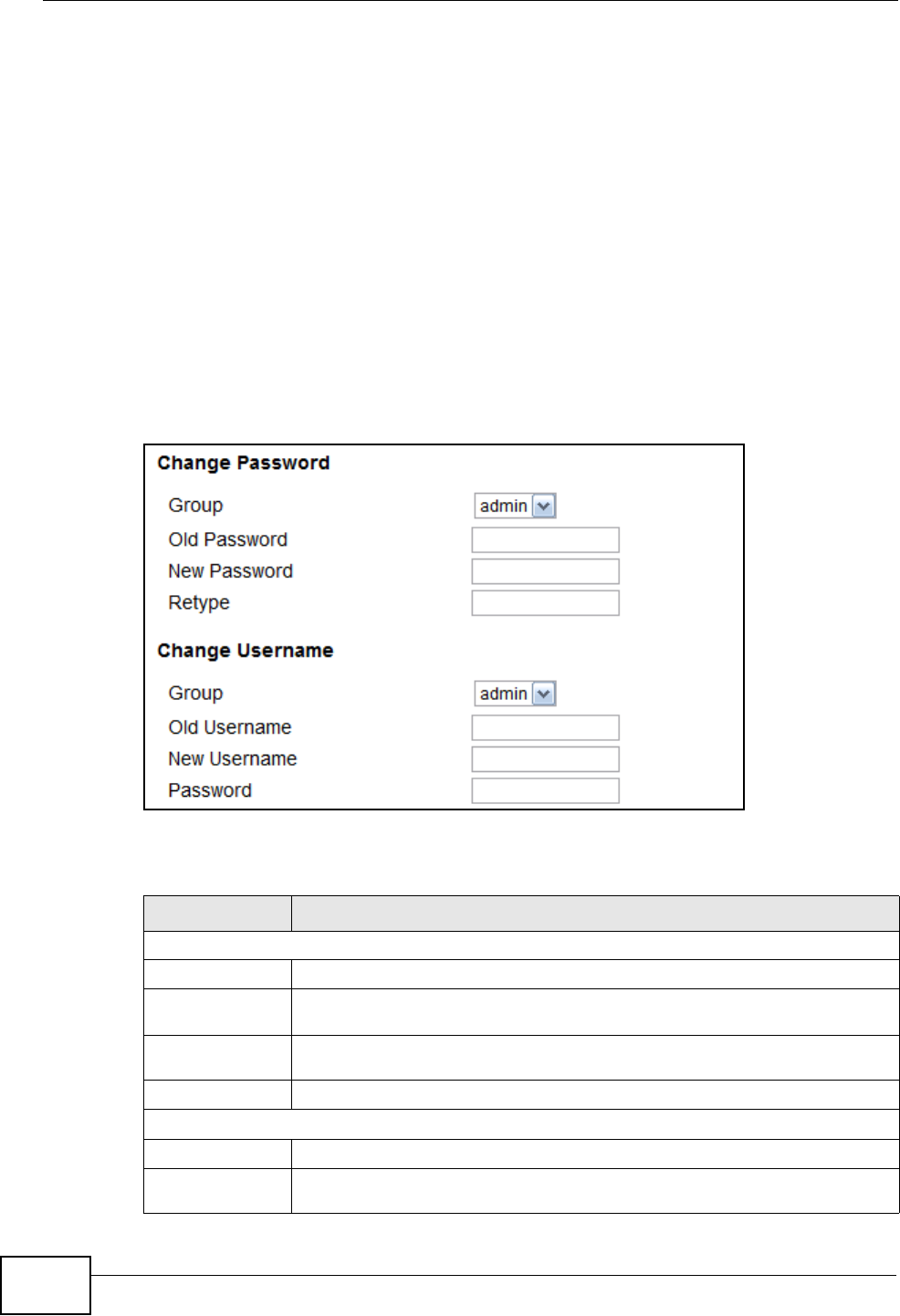
Chapter 9 Maintenance
HES-309M Series User’s Guide
118
NTP
NTP stands for Network Time Protocol. It is employed by devices connected to the
Internet in order to obtain a precise time setting from an official time server.
These time servers are accurate to within 200 microseconds.
9.2 Password
Use this screen to set up user and admin accounts for logging into and managing
the WiMAX Device.
Click Maintenance > Password to open this screen as shown next.
Figure 51 Password Screen
This screen contains the following fields:
Table 41 Password
LABEL DESCRIPTION
Change Password
Group Select the group for which you want to change the login password.
Old
Password Enter the old password for the login group.
New
Password Enter the new password for the login group.
Retype Retype the new password for the login group.
Change User name
Group Select a group for which want to change a username.
Old
Username Enter the username to be changed.
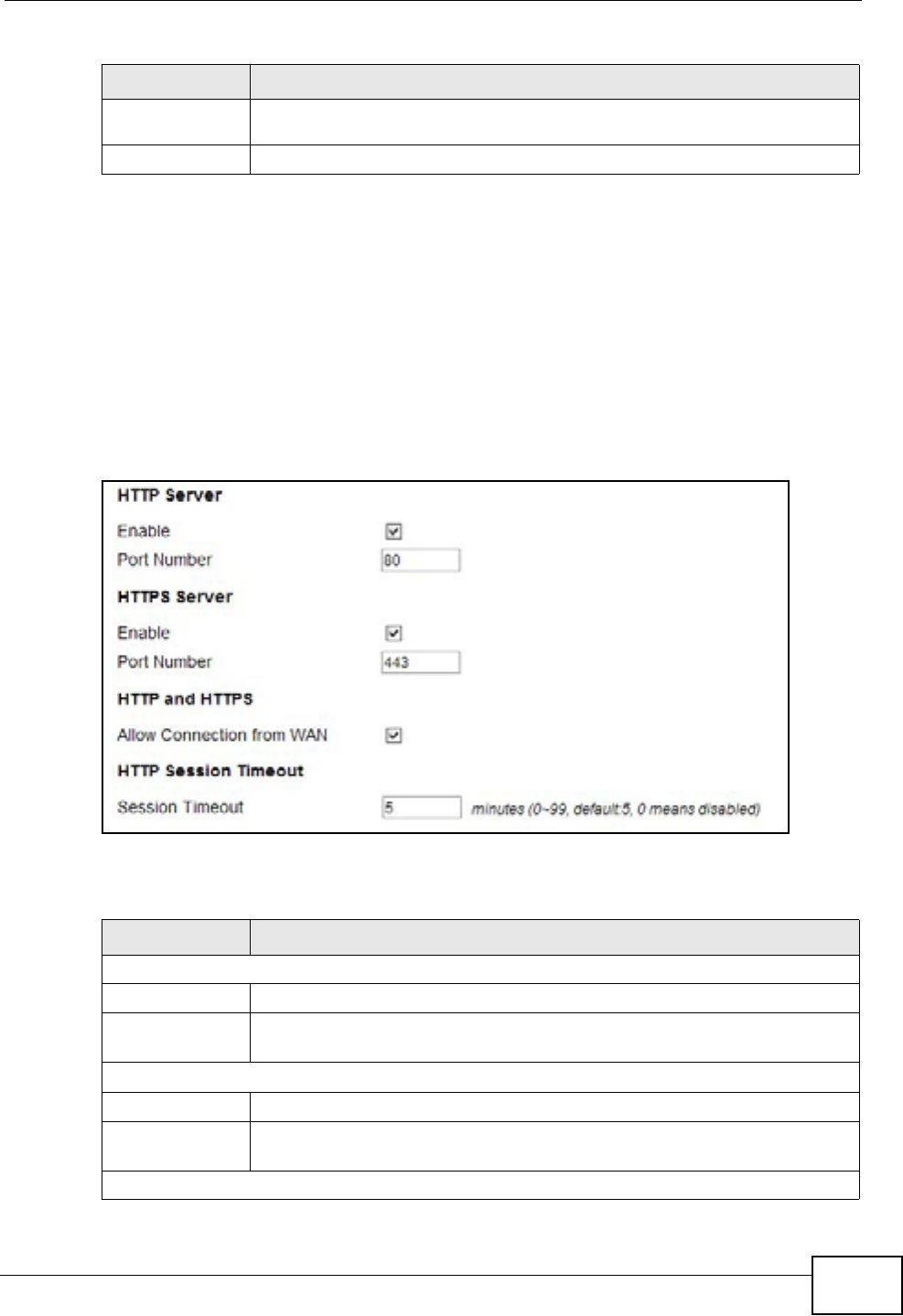
Chapter 9 Maintenance
HES-309M Series User’s Guide 119
9.3 HTTP
Use this screen to allow remote access to the WiMAX Device from a network
connection over HTTP.
Click Maintenance > Remote MGMT > HTTP to open this screen as shown
next.
Figure 52 HTTP Screen
This screen contains the following fields:
New
Username Enter the new username.
Password Enter the password for this username.
Table 41 Password (continued)
LABEL DESCRIPTION
Table 42 HTTP
LABEL DESCRIPTION
HTTP Server
Enable Select this to enable remote management using this service.
Port Number Enter the port number this service can use to access the WiMAX Device.
The computer must use the same port number.
HTTPS Server
Enable Select this to enable remote management using this service.
Port Number Enter the port number this service can use to access the WiMAX Device.
The computer must use the same port number.
HTTP and HTTPS
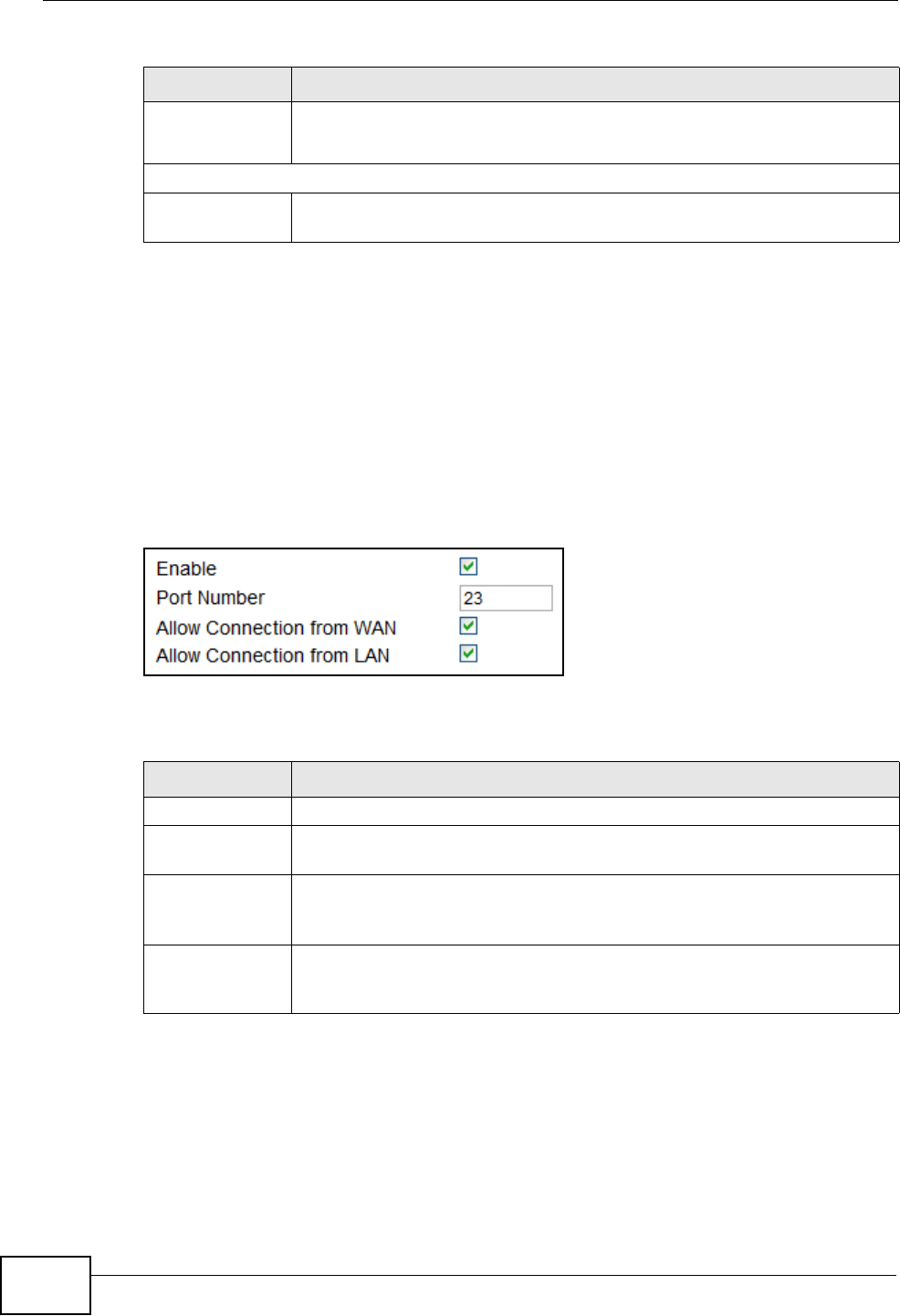
Chapter 9 Maintenance
HES-309M Series User’s Guide
120
9.4 Telnet
Use this screen to allow remote access to the WiMAX Device from a network
connection over Telnet.
Click Maintenance > Remote MGMT > Telnet to open this screen as shown
next.
Figure 53 Telnet Screen
This screen contains the following fields:
Allow
Connection
from WAN
Select this to allow incoming connections from the WAN over either
HTTP or HTTPS.
HTTP Session Timeout
Session
Timeout Enter the number of minutes (0-99) the WiMAX Device waits to delete
an inactive web connection (HTTP or HTTPS).
Table 42 HTTP (continued)
LABEL DESCRIPTION
Table 43 Telnet
LABEL DESCRIPTION
Enable Select this to enable remote management using this service.
Port Number Enter the port number this service can use to access the WiMAX Device.
The computer must use the same port number.
Allow
Connection
from WAN
Select this to allow connections using this service that originate on the
WAN.
Allow
Connection
from LAN
Select this to allow connection using this service that originate on the
LAN.
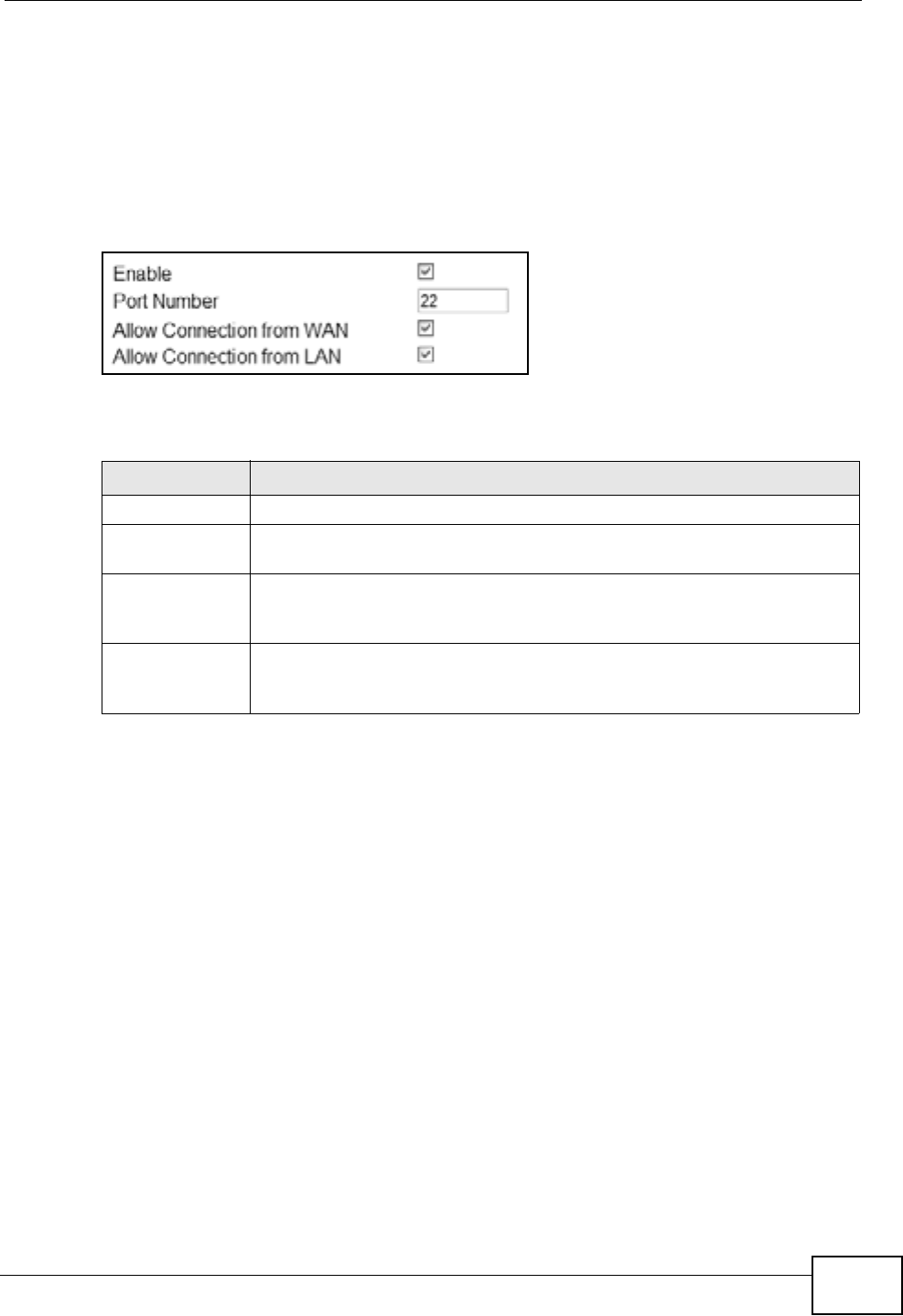
Chapter 9 Maintenance
HES-309M Series User’s Guide 121
9.5 SSH
Use this screen to allow remote access to the WiMAX Device from a network
connection over SSH.
Click Maintenance > Remote MGMT > SSH to open this screen as shown next.
Figure 54 SSH Screen
This screen contains the following fields:
Table 44 SSH
LABEL DESCRIPTION
Enable Select this to enable remote management using this service.
Port Number Enter the port number this service can use to access the WiMAX Device.
The computer must use the same port number.
Allow
Connection
from WAN
Select this to allow connections using this service that originate on the
WAN.
Allow
Connection
from LAN
Select this to allow connection using this service that originate on the
LAN.
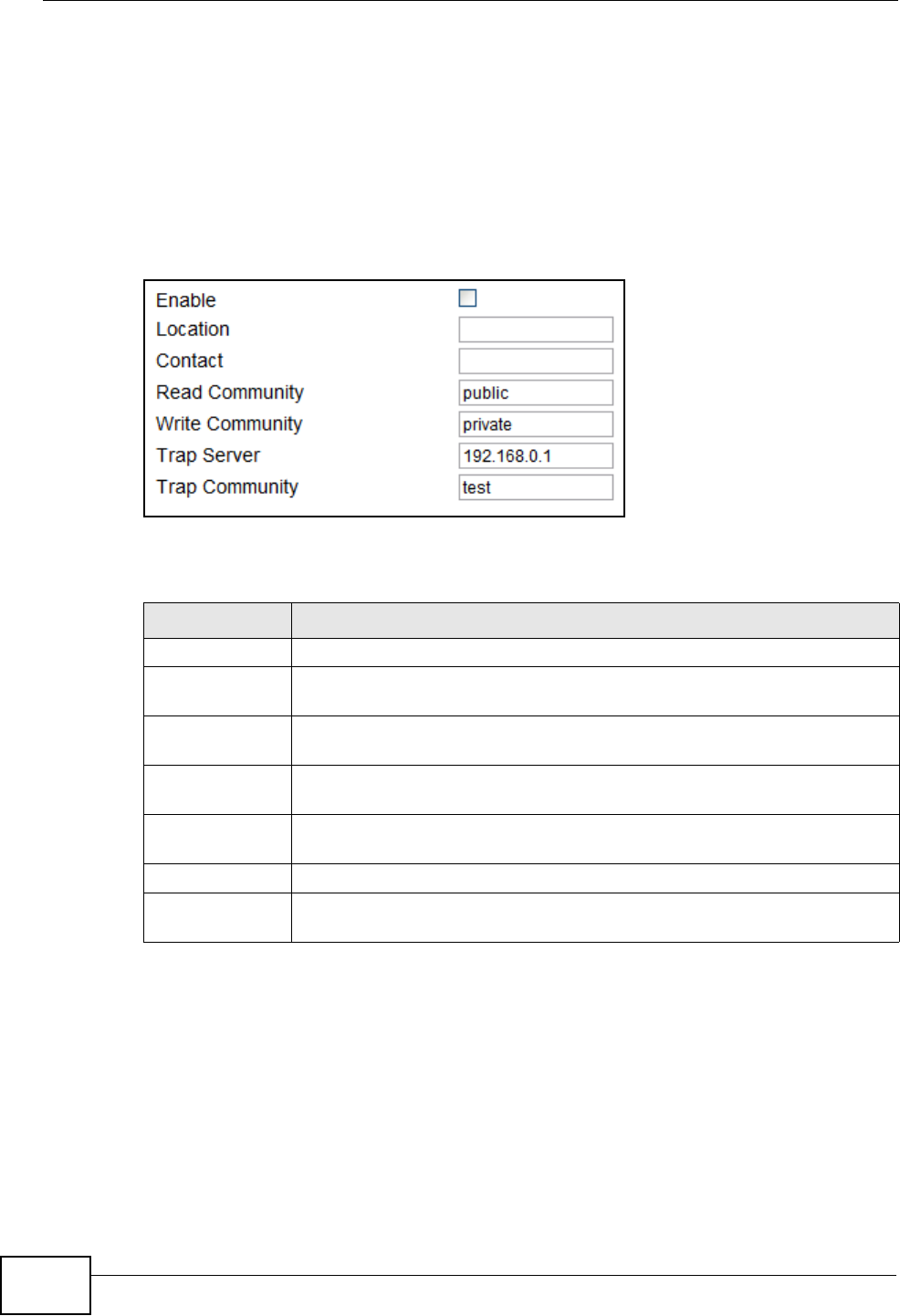
Chapter 9 Maintenance
HES-309M Series User’s Guide
122
9.6 SNMP
Use this screen to allow remote access to the WiMAX Device from a network
connection over SNMP.
Click Maintenance > Remote MGMT > SNMP to open this screen as shown
next.
Figure 55 SNMP Screen
This screen contains the following fields:
Table 45 SNMP
LABEL DESCRIPTION
Enable Select this to enable remote management using this service.
Location Enter the location of the SNMP server (for example, “Engineering Dept.,
Floor 6, Building A, New York City”).
Contact Enter contact information for the administrator managing the SNMP
server (for example, “Bill Smith, IT Dept., (555) 555-5454”).
Read
Community
Enter the password for the incoming Get and GetNext requests from the
management station. The default is public and allows all requests.
Write
Community
Enter the password for incoming Set requests from the management
station. The default is public and allows all requests.
Trap Server Enter the IP address of the station to send your SNMP traps to.
Trap
Community
Enter the trap community, which is the password sent with each trap to
the SNMP manager. The default is public and allows all requests.
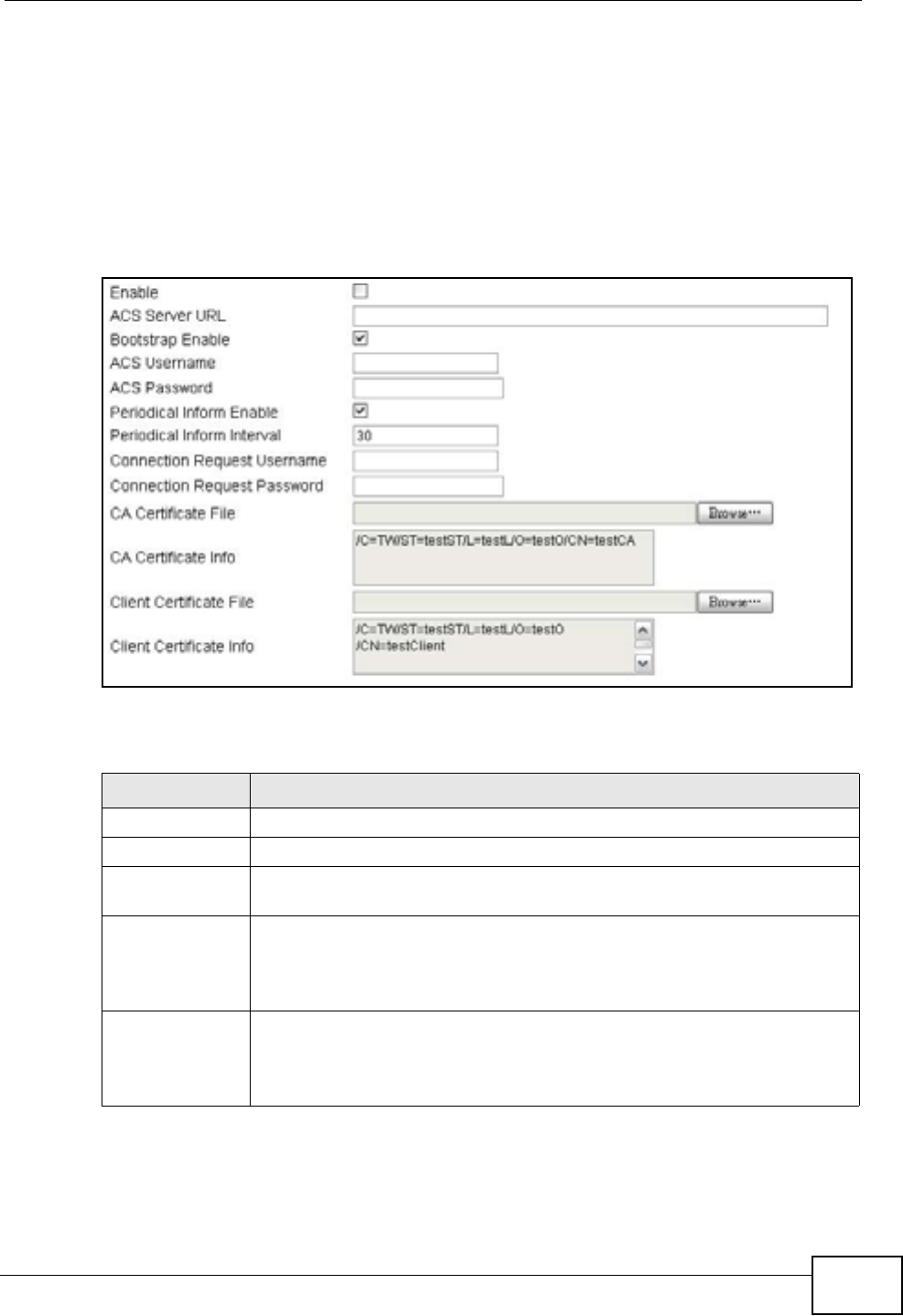
Chapter 9 Maintenance
HES-309M Series User’s Guide 123
9.7 CWMP
Use this screen to allow CWMP connections for remote management, firmware
upgrades and troubleshooting.
Click Maintenance > Remote MGMT > CWMP to open this screen as shown
next.
Figure 56 CWMP Screen
This screen contains the following fields:
Table 46 CWMP
LABEL DESCRIPTION
Enable Select this to enable remote management using this service.
ACS Server URL Enter the URL or IP address of the auto-configuration server.
Bootstrap
Enable
Select this to enable bootstrap events.
ACS Username Enter the user name sent when the WiMAX Device connects to the ACS
and which is used for authentication.
You can enter up to 31 alphanumeric characters (a-z, A-Z, 0-9) and
underscores but spaces are not allowed.
ACS Password Enter the password sent when the WiMAX Device connects to an ACS
and which is used for authentication.
You can enter up to 31 alphanumeric characters (a-z, A-Z, 0-9) and
underscores but spaces are not allowed.

Chapter 9 Maintenance
HES-309M Series User’s Guide
124
Perodical
Inform Enable
Select this to allow the WiMAX Device to periodically connect to the ACS
and check for configuration updates.
If you do not enable this feature then the WiMAX Device can only be
updated automatically when the ACS initiates contact with it and if you
selected the checkbox on this screen.
Periodical
Inform Interval
Enter the time interval (in seconds) at which the WiMAX Device
connects to the auto-configuration server.
Connection
Request
Username
Enter the connection request user name that the ACS must send to the
WiMAX Device when it requests a connection.
You can enter up to 31 alphanumeric characters (a-z, A-Z, 0-9) and
underscores but spaces are not allowed.
Note: This must be provided by the ACS administrator.
Connection
Request
Password
Enter the connection request password that the ACS must send to the
WiMAX Device when it requests a connection.
You can enter up to 31 alphanumeric characters (a-z, A-Z, 0-9) and
underscores but spaces are not allowed.
Note: This must be provided by the ACS administrator.
CA Certificate
File
Click Browse to upload a Certificate Authority (CA) certificate to the
WiMAX Device.
CA Certificate
Info
This displays information about the currently active CA certificate.
Client
Certificate File
Click Browse to upload a client certificate to the WiMAX Device.
Client
Certificate Info
This displays information about the currently active client certificate.
Table 46 CWMP (continued)
LABEL DESCRIPTION
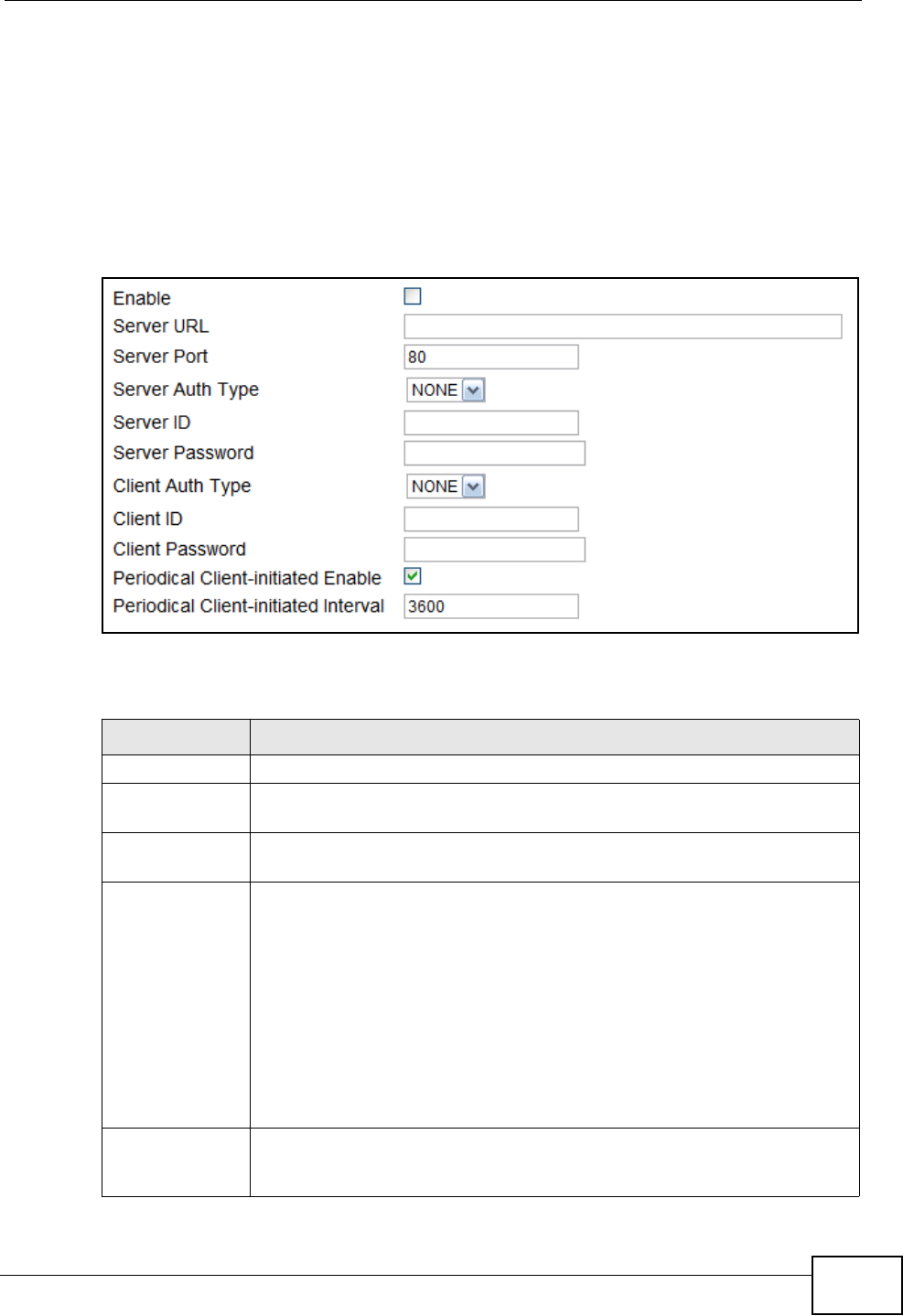
Chapter 9 Maintenance
HES-309M Series User’s Guide 125
9.8 OMA-DM
Use this screen to allow remote access to the WiMAX Device from a network
connection over OMA-DM.
Click Maintenance > Remote MGMT > OMA-DM to open this screen as shown
next.
Figure 57 OMA-DM Screen
This screen contains the following fields:
Table 47 OMA-DM
LABEL DESCRIPTION
Enable Select this to enable remote management using this service.
Server URL Enter the IP address or URL of the OMA-DM server that you intend to
use to manage this device.
Server Port Enter the port number for the IP address of the OMA-DM server set up
in the preceding field.
Server Auth
Type
Select the encryption algorithm scheme used by the OMA-DM server to
communicate with client devices. If the scheme selected here does not
match the actual scheme used by the server, then server will challenge
the WiMAX Device to automatically update its settings.
•None - No authentication.
•Basic - Server ID and Password are encoded using a Basic Access
Authentication Code.
•Digest (MD5) - Server ID and Password are encoded using a Digest
Access Authentication Code.
•HMAC - Server ID and Password are encoded using a keyed Hash
Message Authentication Code.
Server ID Enter the identification code for the server. This is used by the WiMAX
Device during the communication handshake process to identify the
server.

Chapter 9 Maintenance
HES-309M Series User’s Guide
126
Server
Password
Enter the password for the server’s identification code. This shared
public key is used by the WiMAX Device during the communication
handshake process to identify the server.
Client Auth
Type
Select the encryption algorithm scheme used by the OMA-DM server to
communicate with client devices. If the scheme selected here does not
match the actual scheme used by the server, then server will challenge
the WiMAX Device to automatically update its settings.
•None - No authentication.
•Basic - Server ID and Password are encoded using a Basic Access
Authentication Code.
•Digest (MD5) - Server ID and Password are encoded using a Digest
Access Authentication Code.
•HMAC - Server ID and Password are encoded using a keyed Hash
Message Authentication Code.
Note: Make sure that the scheme selected here matches the the
Server Auth Type.
Client ID Enter the client name for the WiMAX Device.
Client Password Enter the password for the WiMAX Device’s client name.
Perodical Client-
Initiated Enable
Select this to allow the WiMAX Device to periodically connect to the
OMA-DM server and check for configuration updates.
If you do not enable this feature then the WiMAX Device can only be
updated automatically when the OM-DM server initiates contact with it
and if you selected the checkbox on this screen.
Periodical
Client-Initiated
Interval
Enter the time interval (in seconds) at which the WiMAX Device
connects to the OMA-DM server.
Table 47 OMA-DM (continued)
LABEL DESCRIPTION
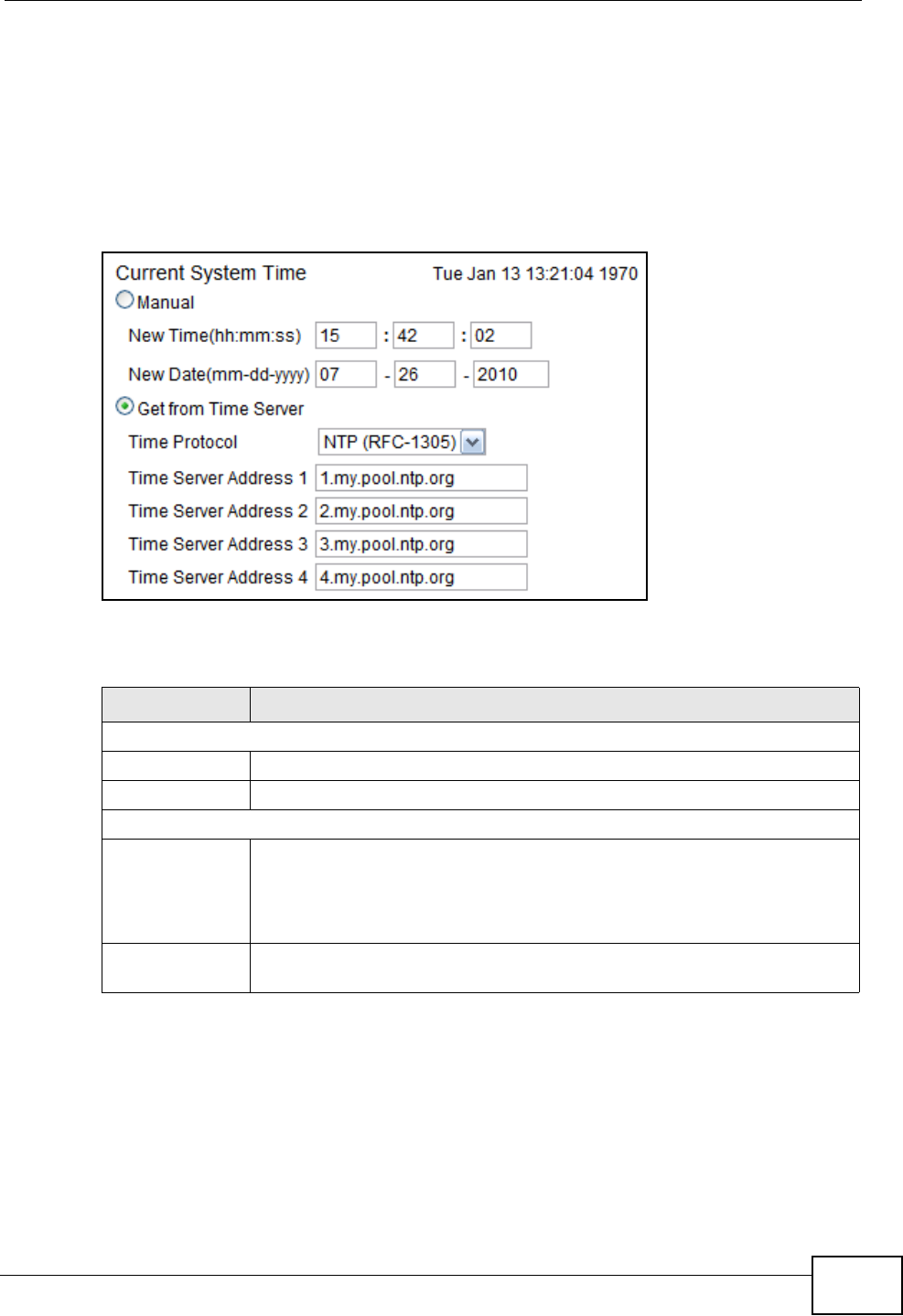
Chapter 9 Maintenance
HES-309M Series User’s Guide 127
9.9 Date
Use these settings to set the system time or configure an NTP server for automatic
time synchronization.
Click Maintenance > Date/Time > Date to open this screen as shown next.
Figure 58 Date Screen
This screen contains the following fields:
Table 48 Date
LABEL DESCRIPTION
Manual
New Time Enter the new time in this field.
New Date Enter the new date in this field.
Get from Time Server
Time
Protocol Select the time service protocol that your time server uses.Check with
your ISP or network administrator, or use trial-and-error to find a
protocol that works.
•NTP (RFC 1305) - This format is similar to Time (RFC 868).
Time Server
Address 1~4 Enter the IP address or URL of your time server. Check with your ISP or
network administrator if you are unsure of this information.
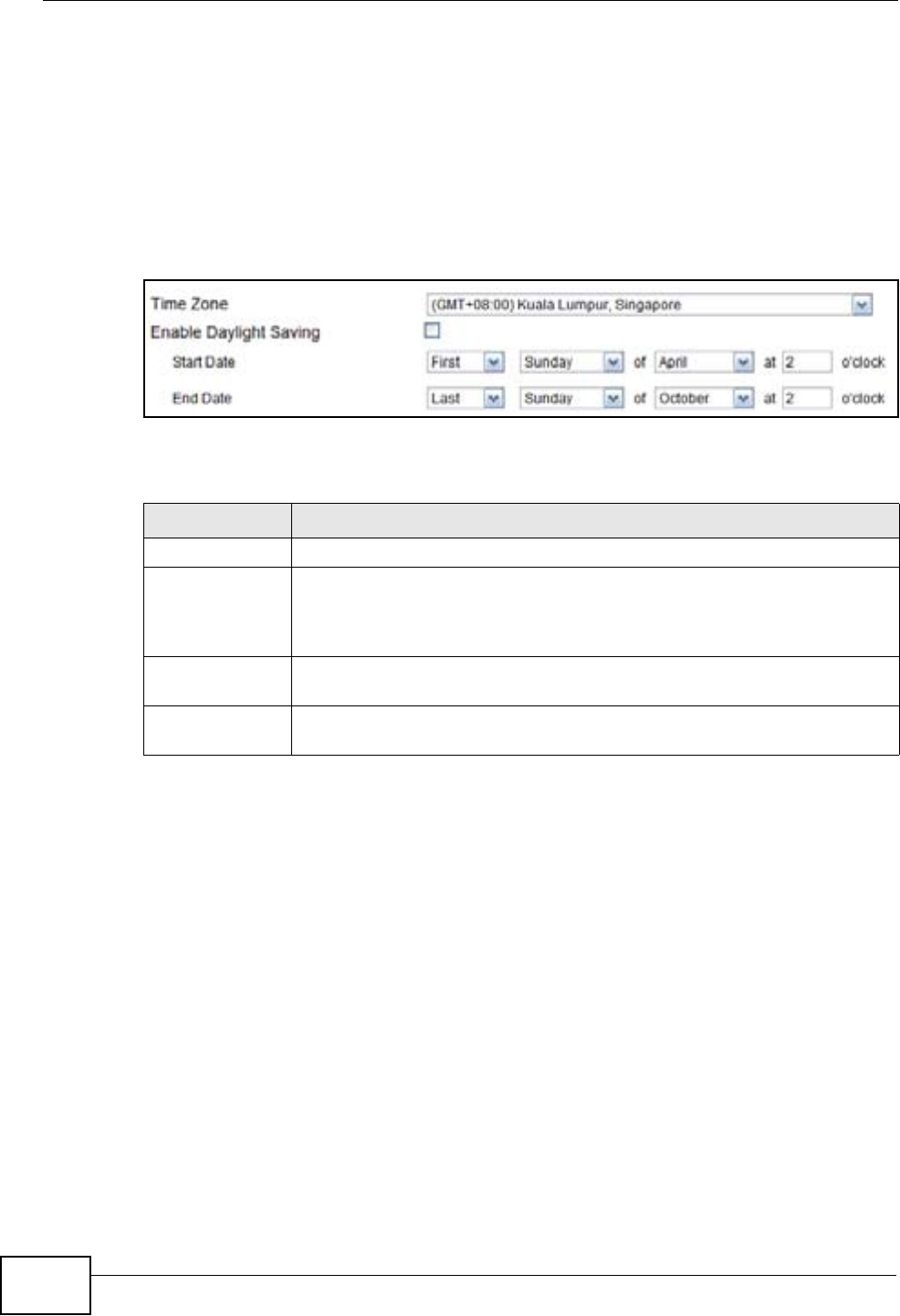
Chapter 9 Maintenance
HES-309M Series User’s Guide
128
9.10 Time Zone
Use this screen to set the time zone in which the WiMAX device is physically
located.
Click Maintenance > Date/Time > Time Zone to open this screen as shown
next.
Figure 59 Time Zone Screen
This screen contains the following fields:
9.11 Upgrade File
Use this screen to browse to a firmware file on a local computer and upload it to
the WiMAX Device. Firmware files usually use the system model name with a
"*.bin" extension, such as "WiMAX Device.bin". The upload process uses HTTP
(Hypertext Transfer Protocol) and may take up to two minutes. After a successful
upload, the system restarts.
Contact your service provider for information on available firmware upgrades.
Note: Only use firmware for your WiMAX Device’s specific model.
Table 49 Time Zone
LABEL DESCRIPTION
Time Zone Select the time zone at your location.
Enable Daylight
Savings Time
Select this if your location uses daylight savings time. Daylight savings
is a period from late spring to early fall when many places set their
clocks ahead of normal local time by one hour to give more daytime
light in the evening.
Start Date Enter which hour on which day of which week of which month daylight-
savings time starts.
End Date Enter which hour on the which day of which week of which month
daylight-savings time ends.
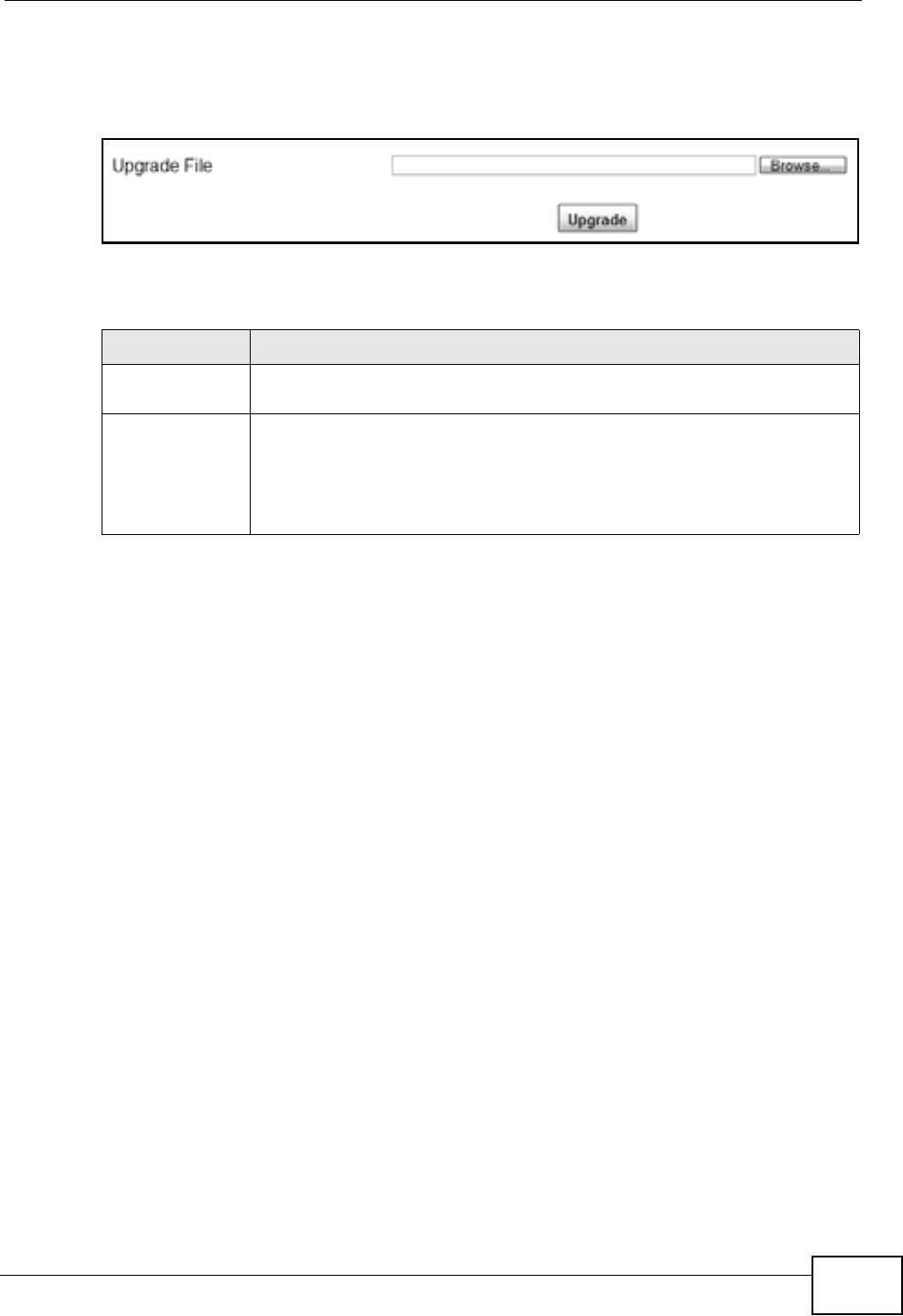
Chapter 9 Maintenance
HES-309M Series User’s Guide 129
Click Maintenance > Firmware Upgrade > Upgrade File to open this screen
as shown next.
Figure 60 Upgrade File Screen
This screen contains the following fields:
9.11.1 The Firmware Upload Process
When the WiMAX Device uploads new firmware, the process usually takes about
two minutes. The device also automatically restarts in this time. This causes a
temporary network disconnect.
Note: Do not turn off the device while firmware upload is in progress!
After two minutes, log in again, and check your new firmware version in the
Status screen. You might have to open a new browser window to log in.
If the upload is not successful, you will be notified by error message.
Table 50 Upgrade File
LABEL DESCRIPTION
Upgrade File Click Browse then browse to the location of a firmware upgrade file
and select it.
Upgrade Click this to begin uploading the selected file. This may take up to two
minutes.
Note: Do not turn off the device while firmware upload is in
progress!
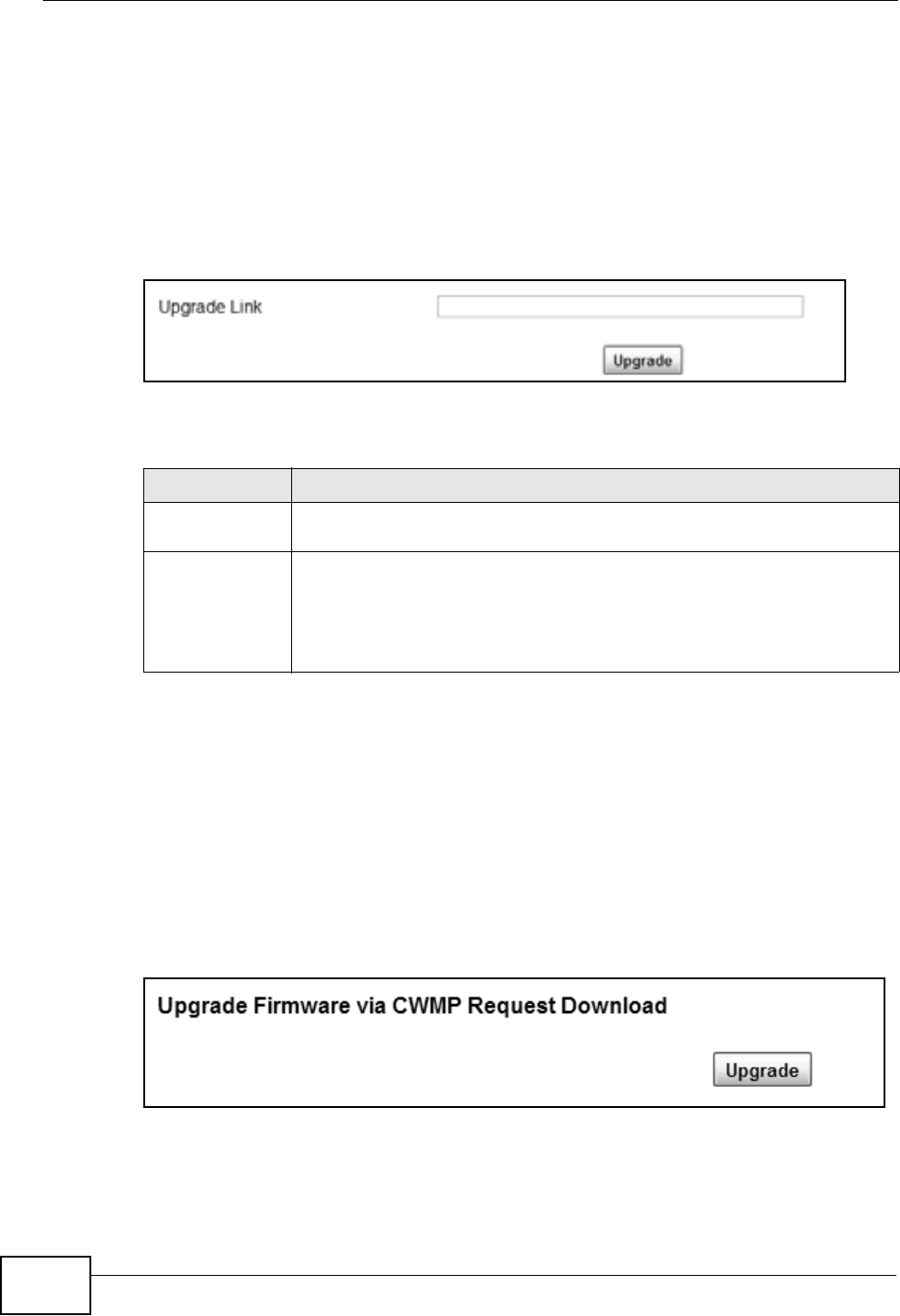
Chapter 9 Maintenance
HES-309M Series User’s Guide
130
9.12 Upgrade Link
Use this screen to set the URL of a firmware file on a remote computer and upload
it to the WiMAX Device.
Click Maintenance > Firmware Upgrade > Upgrade Link to open this screen
as shown next.
Figure 61 Upgrade Link Screen
This screen contains the following fields:
9.13 CWMP Upgrade
Use this screen to upgrade the firmware on the WiMAX Device using CWMP
Request Download.
Click Maintenance > Firmware Upgrade > CWMP Upgrade to open this
screen as shown next.
Figure 62 CWMP Upgrade Screen
Table 51 Upgrade Link
LABEL DESCRIPTION
Upgrade Link Enter the URL or IP address of the firmware’s upgrade location on the
network.
Upgrade Click this to begin uploading the selected file. This may take up to two
minutes.
Note: Do not turn off the device while firmware upload is in
progress!
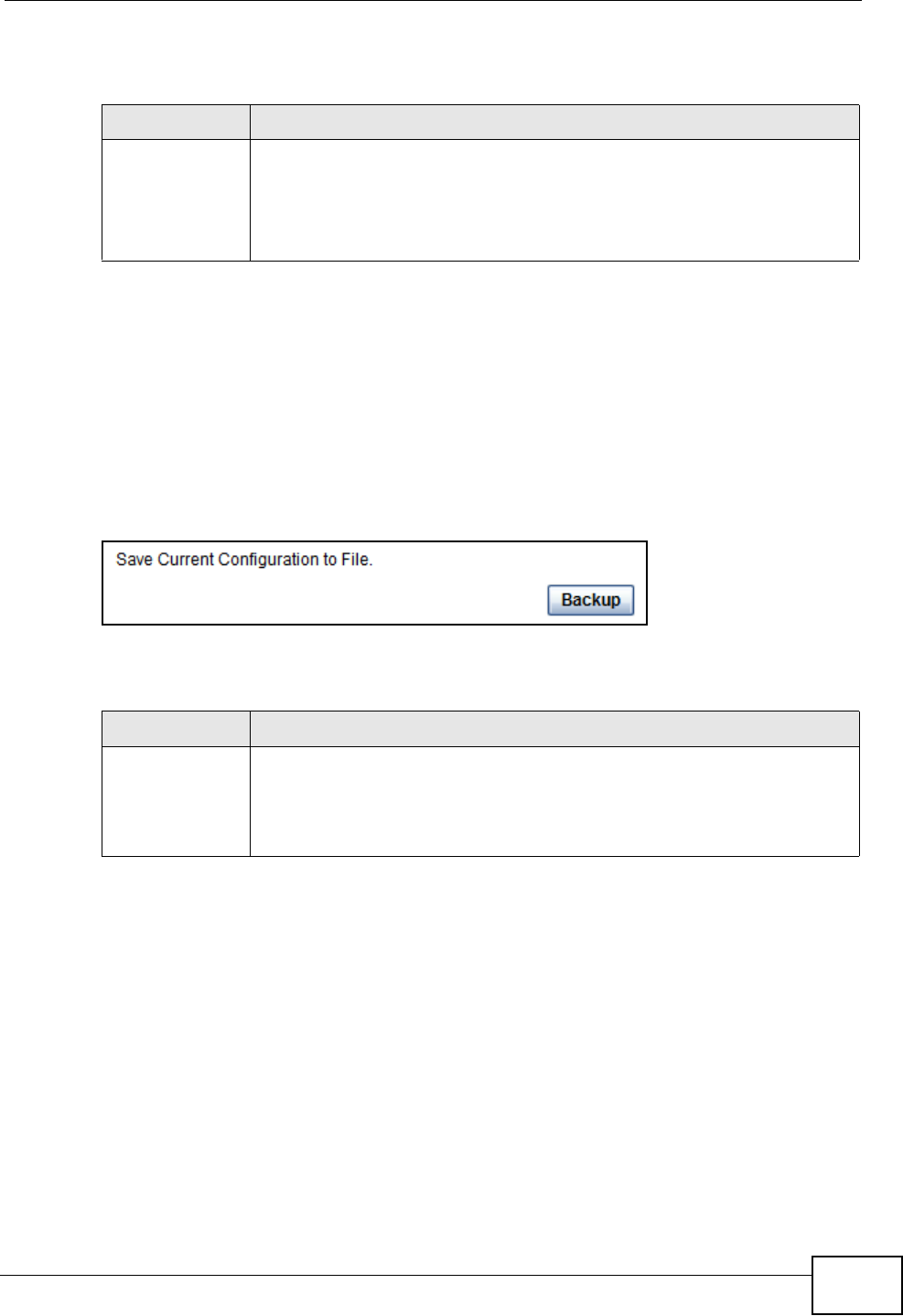
Chapter 9 Maintenance
HES-309M Series User’s Guide 131
This screen contains the following fields:
9.14 Backup
Use this screen to backup your current WiMAX Device settings to a local computer.
Click Maintenance > Backup/Restore > Backup to open this screen as shown
next.
Figure 63 Backup/Restore Screen
This screen contains the following fields:
Table 52 CWMP Upgrade
LABEL DESCRIPTION
Upgrade Click this to begin upgrading firmware using CWMP Request. This may
take up to two minutes.
Note: Do not turn off the device while firmware upload is in
progress!
Table 53 Backup/Restore
LABEL DESCRIPTION
Backup Click this to save the WiMAX Device’s current configuration to a file on
your computer. Once your device is configured and functioning properly,
it is highly recommended that you back up your configuration file before
making configuration changes. The backup configuration file is useful if
you need to return to your previous settings.
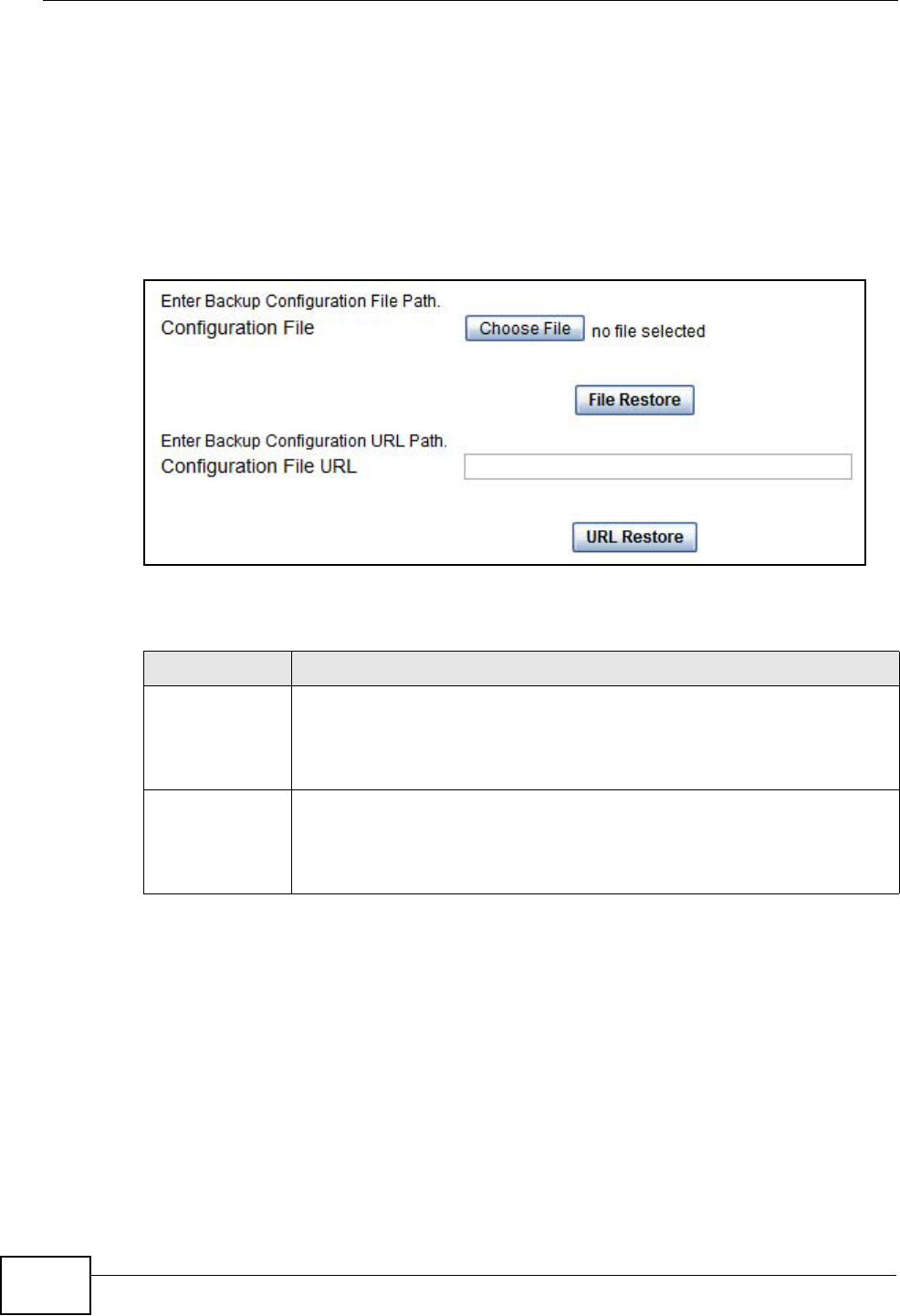
Chapter 9 Maintenance
HES-309M Series User’s Guide
132
9.15 Restore
Use this screen to restore your WiMAX Device settings from a backup file on a
local computer.
Click Maintenance > Backup/Restore > Restore to open this screen as shown
next.
Figure 64 Restore Screen
This screen contains the following fields:
9.15.1 The Restore Configuration Process
When the WiMAX Device restores a configuration file, the device automatically
restarts. This causes a temporary network disconnect.
Note: Do not turn off the device while configuration file upload is in progress.
If the WiMAX Device’s IP address is different in the configuration file you selected,
you may need to change the IP address of your computer to be in the same
subnet as that of the default management IP address (192.168.5.1). See the
Table 54 Restore
LABEL DESCRIPTION
Configuration
File
Click Choose File then browse to the location of a firmware upgrade
file and select it.
Click File Restore to upload the specified configuration to the WiMAX
Device and replace the current settings.
Backup
Configuration
File URL
Enter the URL or IP address of the backup configuration file’s location
on the network.
Click URL Restore to upload the specified configuration to the WiMAX
Device and replace the current settings.
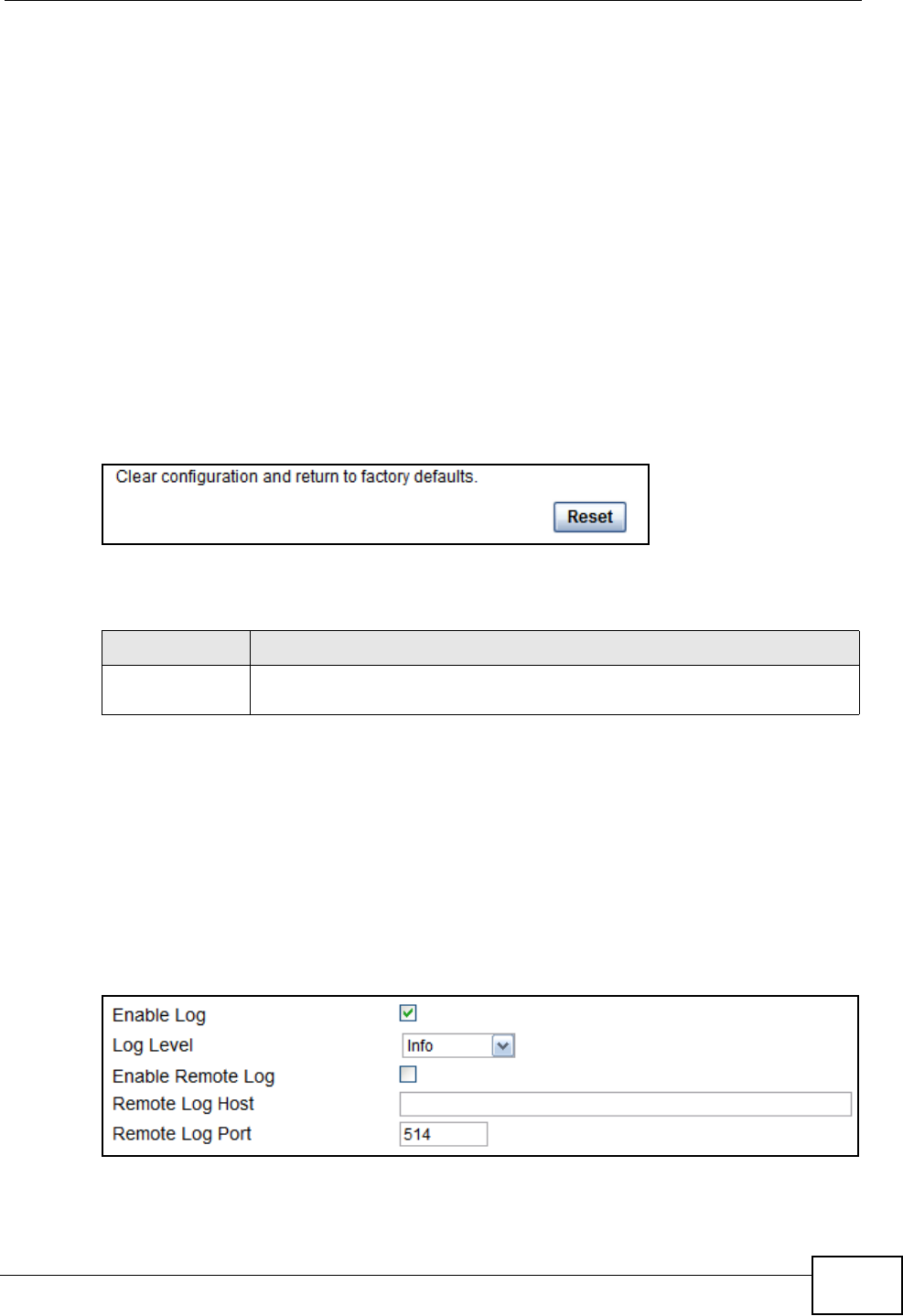
Chapter 9 Maintenance
HES-309M Series User’s Guide 133
Quick Start Guide or the appendices for details on how to set up your computer’s
IP address.
You might have to open a new browser to log in again.
If the upload was not successful, you are notified with an error message.
9.16 Factory Defaults
Use this screen to restore the WiMAX Device to its factory default settings.
Click Maintenance > Backup/Restore > Factory Defaults to open this screen
as shown next.
Figure 65 Factory Defaults Screen
This screen contains the following fields:
9.17 Log Setting
Use this screen to configure which type of events on the WiMAX Device are
logged.
Click Maintenance > Log > Log Setting to open this screen as shown next.
Figure 66 Log Setting Screen
Table 55 Factory Defaults
LABEL DESCRIPTION
Reset Click this to clear all user-entered configuration information and return
the WiMAX Device to its factory defaults. There is no warning screen.
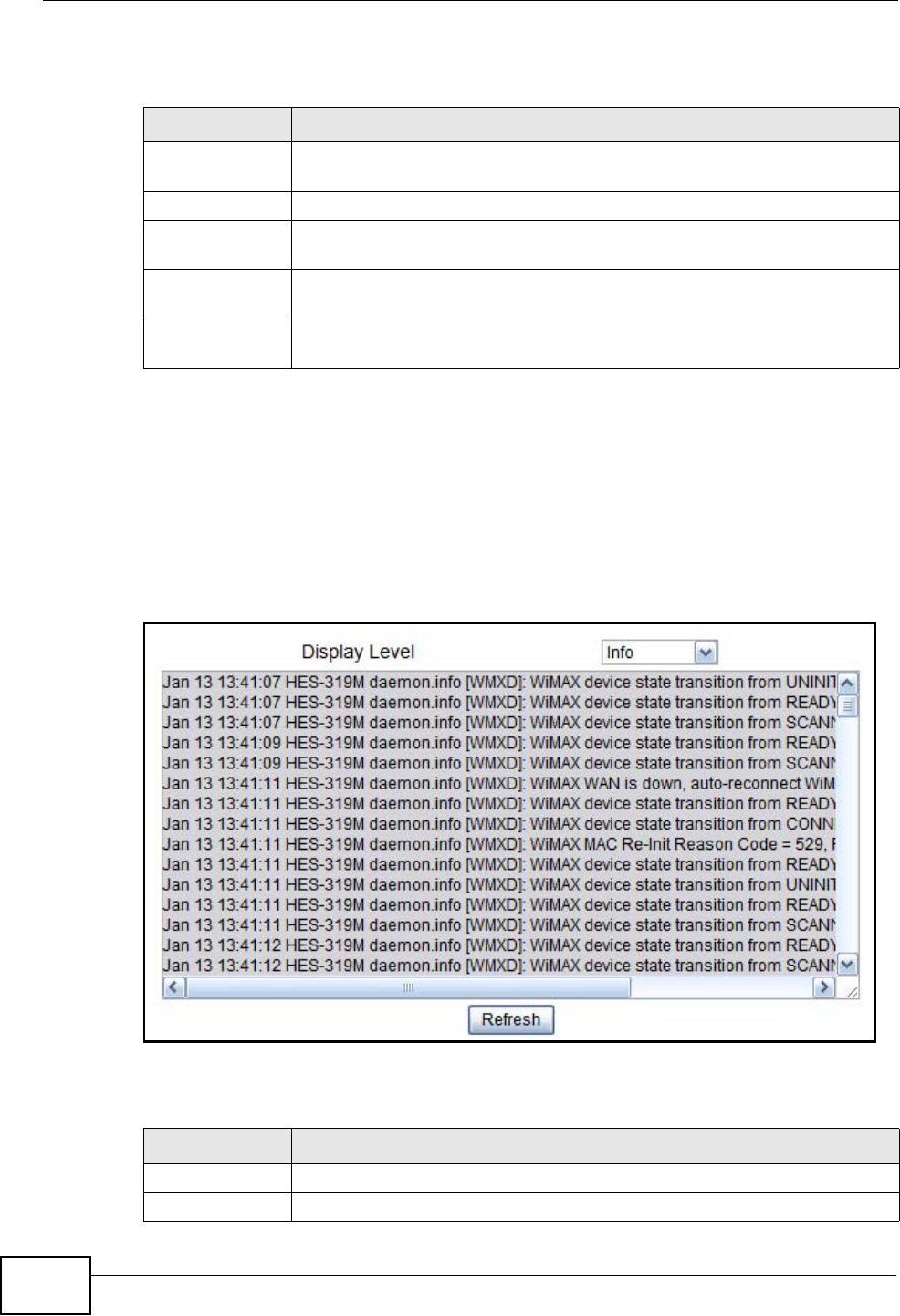
Chapter 9 Maintenance
HES-309M Series User’s Guide
134
This screen contains the following fields:
9.18 Log Display
Use this screen to view the log messages of the WiMAX Device.
Click Maintenance > Log > Log Display to open this screen as shown next.
Figure 67 Log Display Screen
This screen contains the following fields:
Table 56 Log Setting
LABEL DESCRIPTION
Enable Log Select this to have the WiMAX Device log network activity according to
the selected Log Level.
Log Level Select the type of logs to record.
Enable Remote
Log
Select this to allow logs to be recorded and stored on a remote logs
server.
Remote Log
Host
Enter the remote log host IP address if Enable Remote Log is
selected.
Remote Log
Port
Enter the remote log host port if Enable Remote Log is selected.
Table 57 Log Display
LABEL DESCRIPTION
Display Level Select the type of logs to display from this menu.
Refresh Click this to refresh the logs in the display window.
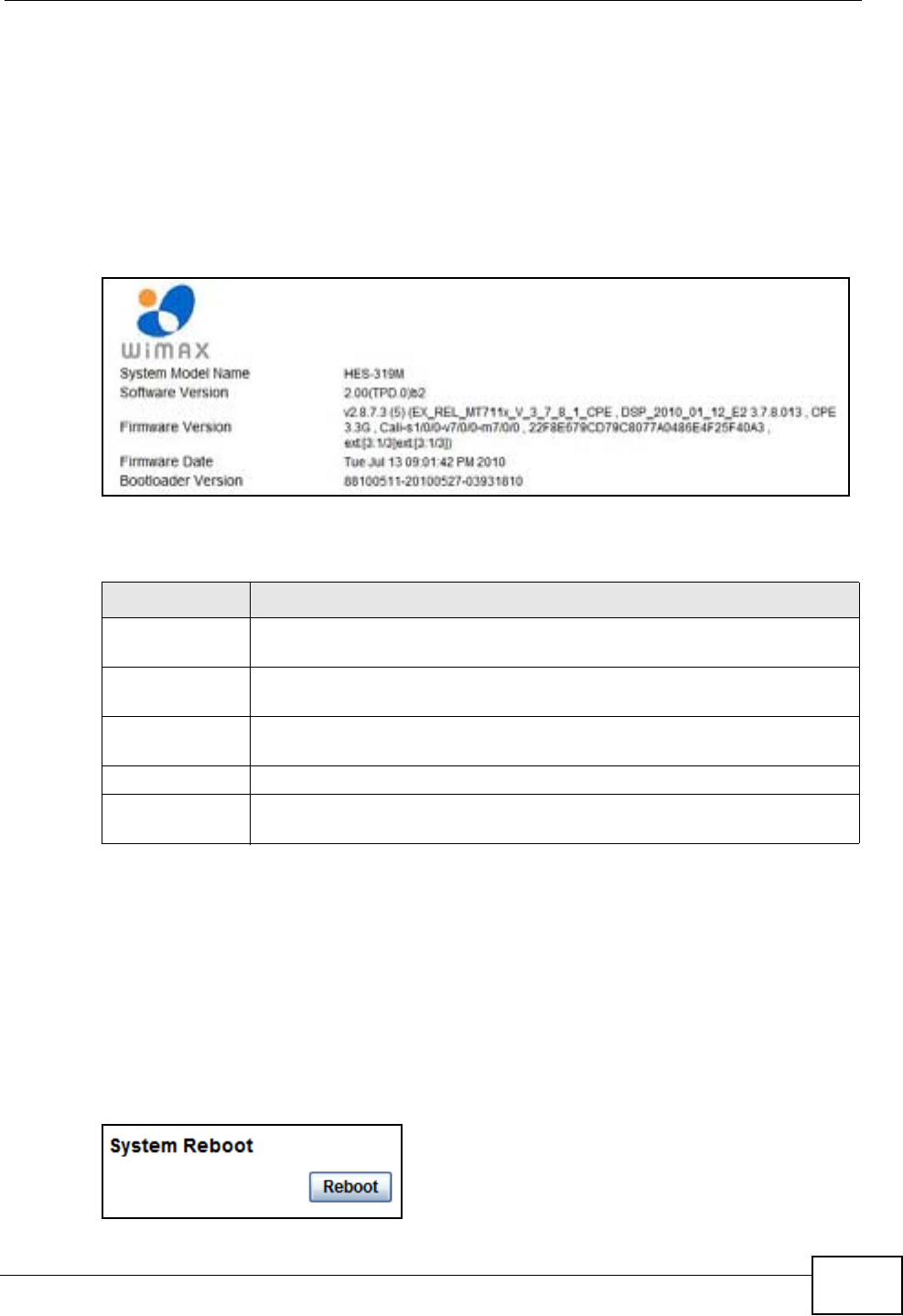
Chapter 9 Maintenance
HES-309M Series User’s Guide 135
9.19 About
This screen displays information about the WiMAX Device that can be useful when
upgrading firmware, considering deployment options, and working with technical
support if the device encounters difficulties.
Click Maintenance > About to open this screen as shown next.
Figure 68 About Screen
This screen contains the following fields:
9.20 Reboot
Use this screen to perform a software restart of the WiMAX Device. You may log in
again within a few minutes of using the reboot button.
Click Maintenance > Reboot to open this screen as shown next.
Figure 69 Reboot Screen
Table 58 About
LABEL DESCRIPTION
System Model
Name
This field displays the WiMAX Device system name. It is used for
identification.
Software
Version
This field displays the Web Configurator software version that the
WiMAX Device is currently running.
Firmware
Version
This field displays the current version of the firmware inside the device.
Firmware Date This field displays the date the firmware version was created.
Bootloader
Version
This field displays the bootloader version.

Chapter 9 Maintenance
HES-309M Series User’s Guide
136
This screen contains the following fields:
Table 59 Reboot
LABEL DESCRIPTION
Reboot Click this button to have the device perform a software restart. The
Power LED blinks as it restarts and the shines steadily if the restart is
successful.
Note: Wait one minute before logging back into the WiMAX Device
after a restart.

HES-309M Series User’s Guide 137
CHAPTER 10
Troubleshooting
This chapter offers some suggestions to solve problems you might encounter. The
potential problems are divided into the following categories:
•Power, Hardware Connections, and LEDs
•WiMAX Device Access and Login
•Internet Access
•Reset the WiMAX Device to Its Factory Defaults
10.1 Power, Hardware Connections, and LEDs
The WiMAX Device does not turn on. None of the LEDs turn on.
1Make sure you are using the power adapter or cord included with the WiMAX
Device.
2Make sure the power adapter or cord is connected to the WiMAX Device and
plugged in to an appropriate power source. Make sure the power source is turned
on.
3Disconnect and re-connect the power adapter or cord to the WiMAX Device.
4If the problem continues, contact the vendor.
One of the LEDs does not behave as expected.
1Make sure you understand the normal behavior of the LED. See Section 1.2.1 on
page 18 for more information.
2Check the hardware connections. See the Quick Start Guide.

Chapter 10 Troubleshooting
HES-309M Series User’s Guide
138
3Inspect your cables for damage. Contact the vendor to replace any damaged
cables.
4Disconnect and re-connect the power adapter to the WiMAX Device.
5If the problem continues, contact the vendor.
10.2 WiMAX Device Access and Login
I forgot the IP address for the WiMAX Device.
1The default IP address is .
2If you changed the IP address and have forgotten it, you might get the IP address
of the WiMAX Device by looking up the IP address of the default gateway for your
computer. To do this in most Windows computers, click Start > Run, enter cmd,
and then enter ipconfig. The IP address of the Default Gateway might be the IP
address of the WiMAX Device (it depends on the network), so enter this IP address
in your Internet browser.
3If this does not work, you have to reset the WiMAX Device to its factory defaults.
See Section 9.16 on page 133.
I forgot the password.
1The default password is 1234.
2If this does not work, you have to reset the WiMAX Device to its factory defaults.
See Section 9.16 on page 133.
I cannot see or access the Login screen in the web configurator.
1Make sure you are using the correct IP address.
• The default IP address is .
• If you changed the IP address (Section 7.6 on page 83), use the new IP
address.

Chapter 10 Troubleshooting
HES-309M Series User’s Guide 139
• If you changed the IP address and have forgotten it, see the troubleshooting
suggestions for I forgot the IP address for the WiMAX Device.
2Check the hardware connections, and make sure the LEDs are behaving as
expected. See the Quick Start Guide and Section 1.2.1 on page 18.
3Make sure your Internet browser does not block pop-up windows and has
JavaScript and Java enabled. See Appendix C on page 179.
4If there is a DHCP server on your network, make sure your computer is using a
dynamic IP address. Your WiMAX Device is a DHCP server by default.
If there is no DHCP server on your network, make sure your computer’s IP
address is in the same subnet as the WiMAX Device. See Appendix D on page 189.
5Reset the WiMAX Device to its factory defaults, and try to access the WiMAX
Device with the default IP address. See Chapter 2 on page 19.
6If the problem continues, contact the network administrator or vendor, or try one
of the advanced suggestions.
Advanced Suggestions
• Try to access the WiMAX Device using another service, such as Telnet. If you can
access the WiMAX Device, check the remote management settings and firewall
rules to find out why the WiMAX Device does not respond to HTTP.
• If your computer is connected wirelessly, use a computer that is connected to a
LAN/ETHERNET port.
I can see the Login screen, but I cannot log in to the WiMAX Device.
1Make sure you have entered the user name and password correctly. The default
user name is admin, and the default password is 1234. These fields are case-
sensitive, so make sure [Caps Lock] is not on.
2You cannot log in to the web configurator while someone is using Telnet to access
the WiMAX Device. Log out of the WiMAX Device in the other session, or ask the
person who is logged in to log out.
3Disconnect and re-connect the power adapter or cord to the WiMAX Device.
4If this does not work, you have to reset the WiMAX Device to its factory defaults.
See Section 9.16 on page 133.

Chapter 10 Troubleshooting
HES-309M Series User’s Guide
140
I cannot Telnet to the WiMAX Device.
See the troubleshooting suggestions for I cannot see or access the Login screen in
the web configurator. Ignore the suggestions about your browser.
10.3 Internet Access
I cannot access the Internet.
1Check the hardware connections, and make sure the LEDs are behaving as
expected. See the Quick Start Guide and Section 1.2.1 on page 18.
2Make sure you entered your ISP account information correctly in the wizard. These
fields are case-sensitive, so make sure [Caps Lock] is not on.
3Check your security settings. See Chapter 8 on page 105.
4Check your WiMAX settings. The WiMAX Device may have been set to search the
wrong frequencies for a wireless connection. See Chapter 6 on page 51. If you are
unsure of the correct values, contact your service provider.
5If you are trying to access the Internet wirelessly, make sure the wireless settings
in the wireless client are the same as the settings in the AP.
6Disconnect all the cables from your WiMAX Device, and follow the directions in the
Quick Start Guide again.
7If the problem continues, contact your ISP.
I cannot access the Internet any more. I had access to the Internet (with the
WiMAX Device), but my Internet connection is not available any more.
1Check the hardware connections, and make sure the LEDs are behaving as
expected. See the Quick Start Guide and Section 1.2.1 on page 18.
2Disconnect and re-connect the power adapter to the WiMAX Device.

Chapter 10 Troubleshooting
HES-309M Series User’s Guide 141
3If the problem continues, contact your ISP.
The Internet connection is slow or intermittent.
1The quality of the WiMAX Device’s wireless connection to the base station may be
poor. Poor signal reception may be improved by moving the WiMAX Device away
from thick walls and other obstructions, or to a higher floor in your building.
2There may be radio interference caused by nearby electrical devices such as
microwave ovens and radio transmitters. Move the WiMAX Device away or switch
the other devices off. Weather conditions may also affect signal quality.
3There might be a lot of traffic on the network. Look at the LEDs, and check Section
1.2.1 on page 18. If the WiMAX Device is sending or receiving a lot of information,
try closing some programs that use the Internet, especially peer-to-peer
applications.
4Disconnect and re-connect the power adapter to the WiMAX Device.
5If the problem continues, contact the network administrator or vendor, or try one
of the advanced suggestions.
The Internet connection disconnects.
1Check your WiMAX link and signal strength using the Strength Indicator LEDs
on the device.
2Contact your ISP if the problem persists.
10.4 Reset the WiMAX Device to Its Factory
Defaults
If you reset the WiMAX Device, you lose all of the changes you have made. The
WiMAX Device re-loads its default settings, and the password resets to 1234. You
have to make all of your changes again.

Chapter 10 Troubleshooting
HES-309M Series User’s Guide
142
You will lose all of your changes when you push the Reset button.
To reset the WiMAX Device,
1Make sure the Power LED is on and not blinking.
2Press and hold the Reset button for five to ten seconds. Release the Reset button
when the Power LED begins to blink. The default settings have been restored.
If the WiMAX Device restarts automatically, wait for the WiMAX Device to finish
restarting, and log in to the web configurator. The password is “1234”.
If the WiMAX Device does not restart automatically, disconnect and reconnect the
WiMAX Device’s power. Then, follow the directions above again.
10.4.1 Pop-up Windows, JavaScript and Java Permissions
Please see Appendix C on page 179.

HES-309M Series User’s Guide 143
CHAPTER 11
Product Specifications
This chapter gives details about your WiMAX Device’s hardware and firmware
features.
FEATURE DESCRIPTION
Operation Requirements • Storage conditions: –40°C to 60°C, 10% to 95%
humidity
• Operation conditions: –40°C to 65°C, 10% to 90%
humidity (non condensing)
• Operating Humidity: 10% to 95% RH
Power Supply Requirement • DC 48 V, 0.32 A on PoE
• 100 V ~ 240 V ± 10% AC input
LAN Port • RJ-45 Interface
•1 Port
• 10/100BaseT
• AUTO MDI/MDIX
Reset Button / Restore to
Factory Default Button
•System Reset
• System configuration can be restored to factory
default if hold the Reset Button longer than 5 seconds
LAN Status LED (Green /
Yellow)
Green LED for 10M
•ON: Linked
• Blinking: Data transmitting
•OFF: Link off
Yellow LED for 100M
•ON: Linked
• Blinking: Data transmitting
•OFF: Link off
RSSI LED (Green) 5 LED bar : LED 1~5 indicates RSSI
(Power level reception, only on when connected)
• 5 LED : -50dBm < RSSI
• 4 LED : -50dBm <= RSSI > -60dBm
• 3 LED : -60dBm <= RSSI > -70dBm
• 2 LED : -70dBm <= RSSI > -80dBm
• 1 LED : -80dBm <= RSSI > -90dBm
• 0 LED : -90dBm >= RSSI

Chapter 11 Product Specifications
HES-309M Series User’s Guide
144
Buzzer behavior • 5 Counts (5 sec) : -50dBm< RSSI
• 4 Counts (4 sec) : -50dBm <= RSSI > -60dBm
• 3 Counts (3 sec) : -60dBm <= RSSI > -70dBm
• 2 Counts (2 sec) : -70dBm <= RSSI > -80dBm
• 1 Counts (1 sec) : -80dBm <= RSSI > -90dBm
• 0 Counts no buzzer : -90dBm >= RSSI
Antennna • Center Frequency: 3500 MHz (HES-319M), 2300 MHz
(HES-339M), 2600 MHz (HES-309M)
• Frequency Range: 3300 MHz~3600 MHz (HES-319M),
2300 MHz~2400 MHz (HES-339M), 2500 MHz~2700
MHz (HES-309M)
• Bandwidth: 300 MHz
• Peak Gain: 15 dBi (HES-319M), 12 dBi (HES-339M),
13 dBi (HES-309M)
• H-Plane Average Gain: 3.5 dBi
• VSWR: 2
• Polarization: Linear, Vertical
• H-Plane HPBW: 180°
• V-Plane HPBW: 25°
• Down tilt: 0°
• Impedance: 50
• Connector: IPEX female
WiMAX compliance Fully compliant with IEEE 802.16e Mobile WiMAX
corrigendum 1 & 2 and WiMAX Forum Wave 2 System
Profiles
Operating Frequency Band 3.3GHz~3.6GHz (HES-319M), 2.3GHz~2.4GHz (HES-
339M), 2.5GHz~2.7GHz (HES-309M)
Certification Profile Support WF profiles: 1A, 2A, 3A, 5A, 5AL, 5BL (5MHz,
7MHz, 10MHz bandwidth)
Maximum nominal
Transmission Power
Maximum nominal Tx power at the antenna connector:
26dBm.
Transmitter Power Control Transmit power control by step of 1dB, relative accuracy
of +/- 0.5dB (as per IEEE 802.16e-2005, §8.4.12.1).
Transmitter spectral flatness Transmitter spectral flatness as defined in IEEE 802.16e-
2005, §8.4.12.2.
Transmitter Error Vector
Magnitude (EVM)
Transmitter relative constellation error (EVM) as defined
in IEEE 802.16e-2005, §8.4.12.3.
Receiver SNR Compliant to IEEE 802.16e-2005 section §8.4.13.1
Receiver Sensitivity The receiver minimum sensitivity level Rss, measured
under the conditions defined in IEEE 802.16e-2005.
FEATURE DESCRIPTION

Chapter 11 Product Specifications
HES-309M Series User’s Guide 145
Cumulated Noise Figure and
Implementation Loss of the
Receiver
Lower than 6.4dB
Receiver SNR Compliant to IEEE 802.16e-2005 section §8.4.13.1
Receiver Sensitivity The receiver minimum sensitivity level Rss, measured
under the conditions defined in IEEE 802.16e-2005.
Receiver Diversity Maximum Ratio Combining (MRC)
Receiver Adjacent Channel
Rejection
The receiver adjacent channel rejection measured under
the conditions defined in IEEE 802.16e-2005 is at least:
25dB for QPSK ½, 14dB for 16QAM ¾, 7dB for 64QAM ¾.
Receiver Non-Adjacent
Channel Rejection
The receiver non-adjacent channel rejection measured
under the conditions defined in IEEE 802.16e-2005 is at
least: 38dB for QPSK ½, 33dB for 16QAM ¾, 26dB for
64QAM ¾.
FEATURE DESCRIPTION

Chapter 11 Product Specifications
HES-309M Series User’s Guide
146

HES-309M Series User’s Guide 147
APPENDIX A
WiMAX Security
Wireless security is vital to protect your wireless communications. Without it,
information transmitted over the wireless network would be accessible to any
networking device within range.
User Authentication and Data Encryption
The WiMAX (IEEE 802.16) standard employs user authentication and encryption to
ensure secured communication at all times.
User authentication is the process of confirming a user’s identity and level of
authorization. Data encryption is the process of encoding information so that it
cannot be read by anyone who does not know the code.
WiMAX uses PKMv2 (Privacy Key Management version 2) for authentication, and
CCMP (Counter Mode with Cipher Block Chaining Message Authentication Protocol)
for data encryption.
WiMAX supports EAP (Extensible Authentication Protocol, RFC 2486) which allows
additional authentication methods to be deployed with no changes to the base
station or the mobile or subscriber stations.
PKMv2
PKMv2 is a procedure that allows authentication of a mobile or subscriber station
and negotiation of a public key to encrypt traffic between the MS/SS and the base
station. PKMv2 uses standard EAP methods such as Transport Layer Security
(EAP-TLS) or Tunneled TLS (EAP-TTLS) for secure communication.
In cryptography, a ‘key’ is a piece of information, typically a string of random
numbers and letters, that can be used to ‘lock’ (encrypt) or ‘unlock’ (decrypt) a
message. Public key encryption uses key pairs, which consist of a public (freely
available) key and a private (secret) key. The public key is used for encryption and
the private key is used for decryption. You can decrypt a message only if you have
the private key. Public key certificates (or ‘digital IDs’) allow users to verify each
other’s identity.

Appendix A WiMAX Security
HES-309M Series User’s Guide
148
RADIUS
RADIUS is based on a client-server model that supports authentication,
authorization and accounting. The base station is the client and the server is the
RADIUS server. The RADIUS server handles the following tasks:
• Authentication
Determines the identity of the users.
• Authorization
Determines the network services available to authenticated users once they are
connected to the network.
•Accounting
Keeps track of the client’s network activity.
RADIUS is a simple package exchange in which your base station acts as a
message relay between the MS/SS and the network RADIUS server.
Types of RADIUS Messages
The following types of RADIUS messages are exchanged between the base station
and the RADIUS server for user authentication:
• Access-Request
Sent by an base station requesting authentication.
• Access-Reject
Sent by a RADIUS server rejecting access.
• Access-Accept
Sent by a RADIUS server allowing access.
• Access-Challenge
Sent by a RADIUS server requesting more information in order to allow access.
The base station sends a proper response from the user and then sends another
Access-Request message.
The following types of RADIUS messages are exchanged between the base station
and the RADIUS server for user accounting:
•Accounting-Request
Sent by the base station requesting accounting.
• Accounting-Response
Sent by the RADIUS server to indicate that it has started or stopped accounting.
In order to ensure network security, the access point and the RADIUS server use a
shared secret key, which is a password they both know. The key is not sent over

Appendix A WiMAX Security
HES-309M Series User’s Guide 149
the network. In addition to the shared key, password information exchanged is
also encrypted to protect the network from unauthorized access.
Diameter
Diameter (RFC 3588) is a type of AAA server that provides several improvements
over RADIUS in efficiency, security, and support for roaming.
Security Association
The set of information about user authentication and data encryption between two
computers is known as a security association (SA). In a WiMAX network, the
process of security association has three stages.
• Authorization request and reply
The MS/SS presents its public certificate to the base station. The base station
verifies the certificate and sends an authentication key (AK) to the MS/SS.
• Key request and reply
The MS/SS requests a transport encryption key (TEK) which the base station
generates and encrypts using the authentication key.
• Encrypted traffic
The MS/SS decrypts the TEK (using the authentication key). Both stations can
now securely encrypt and decrypt the data flow.
CCMP
All traffic in a WiMAX network is encrypted using CCMP (Counter Mode with Cipher
Block Chaining Message Authentication Protocol). CCMP is based on the 128-bit
Advanced Encryption Standard (AES) algorithm.
‘Counter mode’ refers to the encryption of each block of plain text with an
arbitrary number, known as the counter. This number changes each time a block
of plain text is encrypted. Counter mode avoids the security weakness of repeated
identical blocks of encrypted text that makes encrypted data vulnerable to
pattern-spotting.
‘Cipher Block Chaining Message Authentication’ (also known as CBC-MAC) ensures
message integrity by encrypting each block of plain text in such a way that its
encryption is dependent on the block before it. This series of ‘chained’ blocks
creates a message authentication code (MAC or CMAC) that ensures the encrypted
data has not been tampered with.

Appendix A WiMAX Security
HES-309M Series User’s Guide
150
Authentication
The WiMAX Device supports EAP-TTLS authentication.
EAP-TTLS (Tunneled Transport Layer Service)
EAP-TTLS is an extension of the EAP-TLS authentication that uses certificates for
only the server-side authentications to establish a secure connection (with EAP-
TLS digital certifications are needed by both the server and the wireless clients for
mutual authentication). Client authentication is then done by sending username
and password through the secure connection, thus client identity is protected. For
client authentication, EAP-TTLS supports EAP methods and legacy authentication
methods such as PAP, CHAP, MS-CHAP and MS-CHAP v2.

HES-309M Series User’s Guide 151
APPENDIX B
Setting Up Your Computer’s IP
Address
Note: Your specific ZyXEL device may not support all of the operating systems
described in this appendix. See the product specifications for more information
about which operating systems are supported.
This appendix shows you how to configure the IP settings on your computer in
order for it to be able to communicate with the other devices on your network.
Windows Vista/XP/2000, Mac OS 9/OS X, and all versions of UNIX/LINUX include
the software components you need to use TCP/IP on your computer.
If you manually assign IP information instead of using a dynamic IP, make sure
that your network’s computers have IP addresses that place them in the same
subnet.
In this appendix, you can set up an IP address for:
•Windows XP/NT/2000 on page 152
•Windows Vista on page 155
•Mac OS X: 10.3 and 10.4 on page 159
•Mac OS X: 10.5 on page 163
•Linux: Ubuntu 8 (GNOME) on page 166
•Linux: openSUSE 10.3 (KDE) on page 172
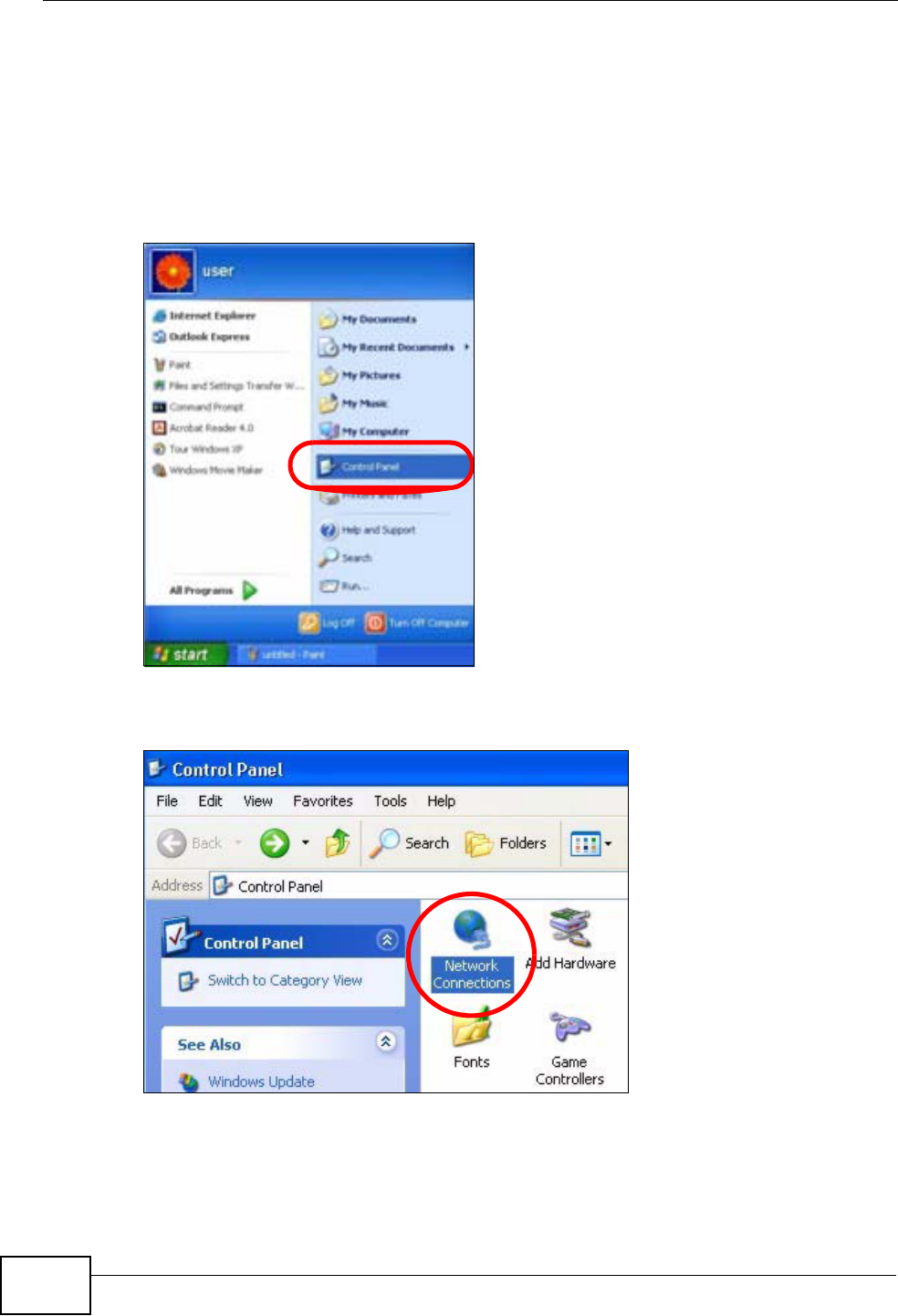
Appendix B Setting Up Your Computer’s IP Address
HES-309M Series User’s Guide
152
Windows XP/NT/2000
The following example uses the default Windows XP display theme but can also
apply to Windows 2000 and Windows NT.
1Click Start >Control Panel.
Figure 70 Windows XP: Start Menu
2In the Control Panel, click the Network Connections icon.
Figure 71 Windows XP: Control Panel
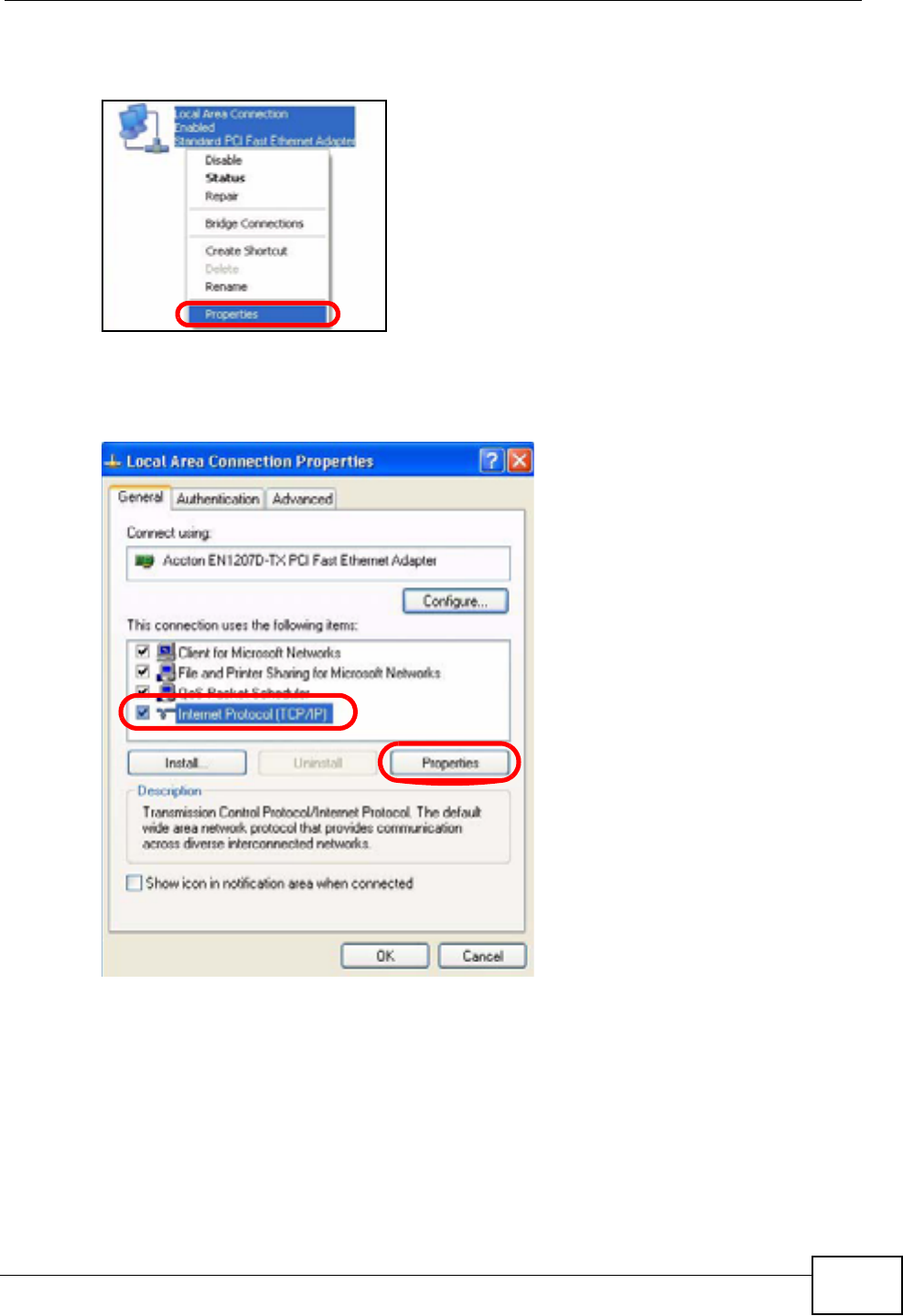
Appendix B Setting Up Your Computer’s IP Address
HES-309M Series User’s Guide 153
3Right-click Local Area Connection and then select Properties.
Figure 72 Windows XP: Control Panel > Network Connections > Properties
4On the General tab, select Internet Protocol (TCP/IP) and then click
Properties.
Figure 73 Windows XP: Local Area Connection Properties
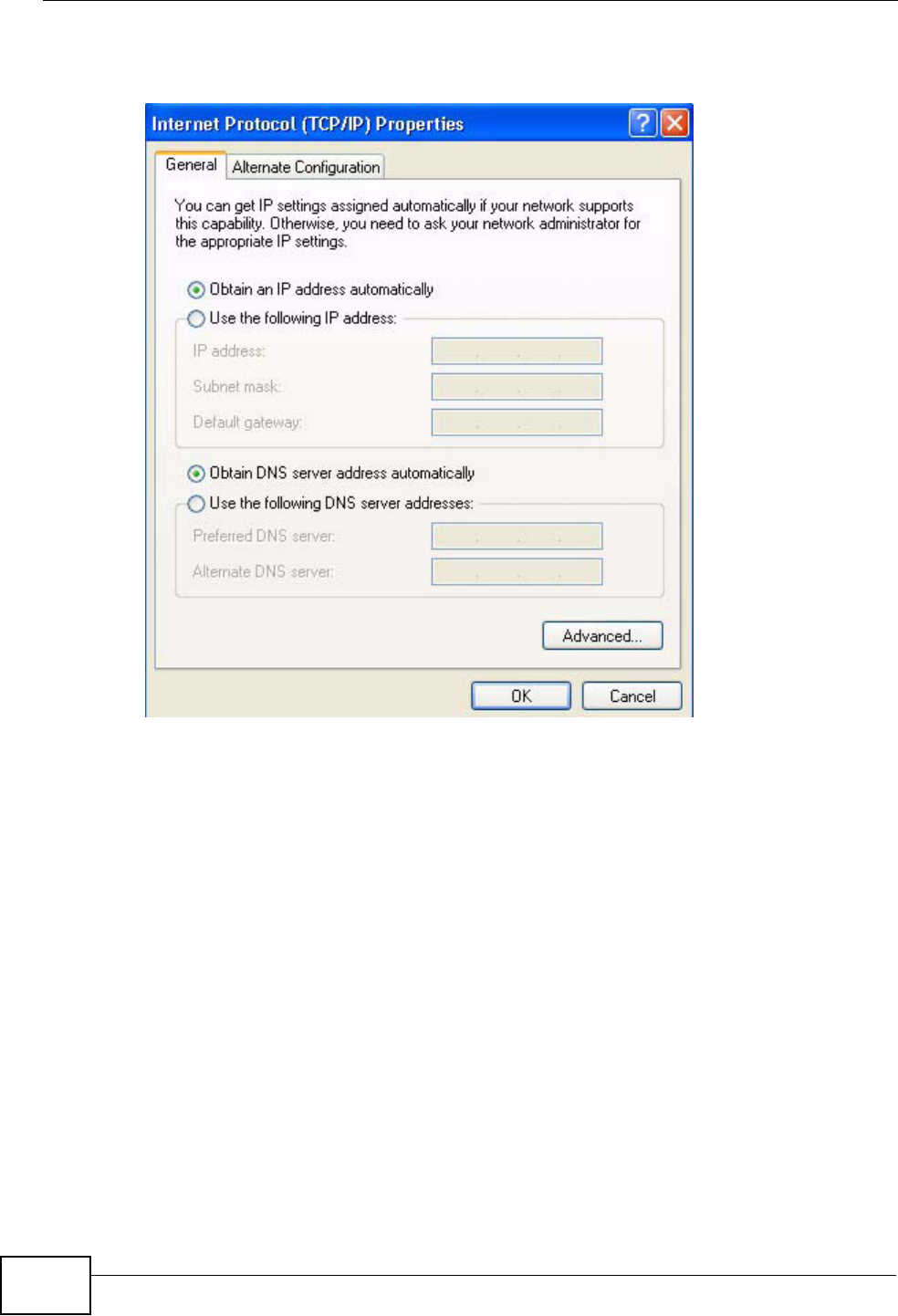
Appendix B Setting Up Your Computer’s IP Address
HES-309M Series User’s Guide
154
5The Internet Protocol TCP/IP Properties window opens.
Figure 74 Windows XP: Internet Protocol (TCP/IP) Properties
6Select Obtain an IP address automatically if your network administrator or ISP
assigns your IP address dynamically.
Select Use the following IP Address and fill in the IP address,Subnet mask,
and Default gateway fields if you have a static IP address that was assigned to
you by your network administrator or ISP. You may also have to enter a Preferred
DNS server and an Alternate DNS server, if that information was provided.
7Click OK to close the Internet Protocol (TCP/IP) Properties window.
Click OK to close the Local Area Connection Properties window.Verifying Settings
1Click Start > All Programs > Accessories > Command Prompt.
2In the Command Prompt window, type "ipconfig" and then press [ENTER].
You can also go to Start > Control Panel > Network Connections, right-click a
network connection, click Status and then click the Support tab to view your IP
address and connection information.
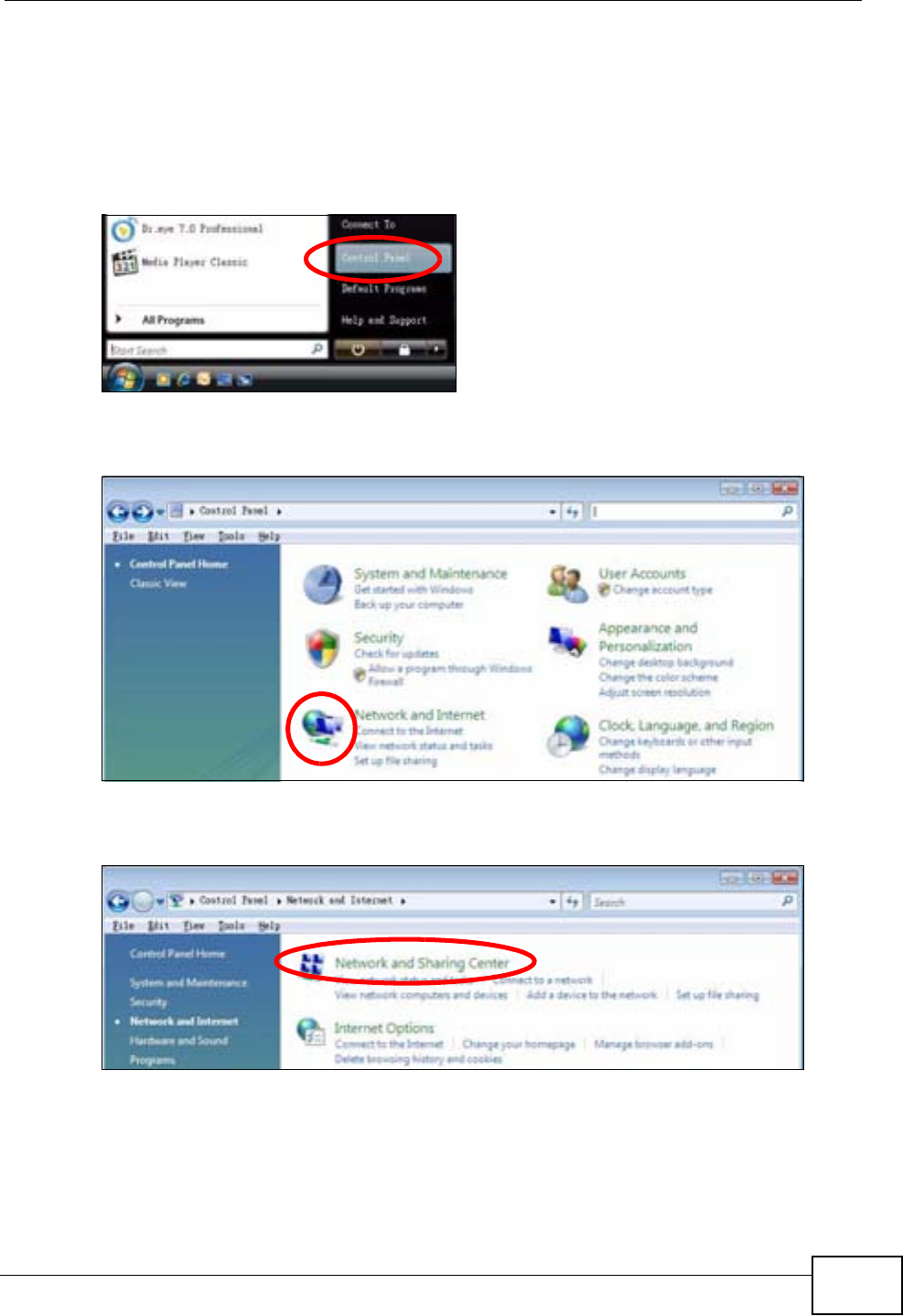
Appendix B Setting Up Your Computer’s IP Address
HES-309M Series User’s Guide 155
Windows Vista
This section shows screens from Windows Vista Professional.
1Click Start > Control Panel.
Figure 75 Windows Vista: Start Menu
2In the Control Panel, click the Network and Internet icon.
Figure 76 Windows Vista: Control Panel
3Click the Network and Sharing Center icon.
Figure 77 Windows Vista: Network And Internet
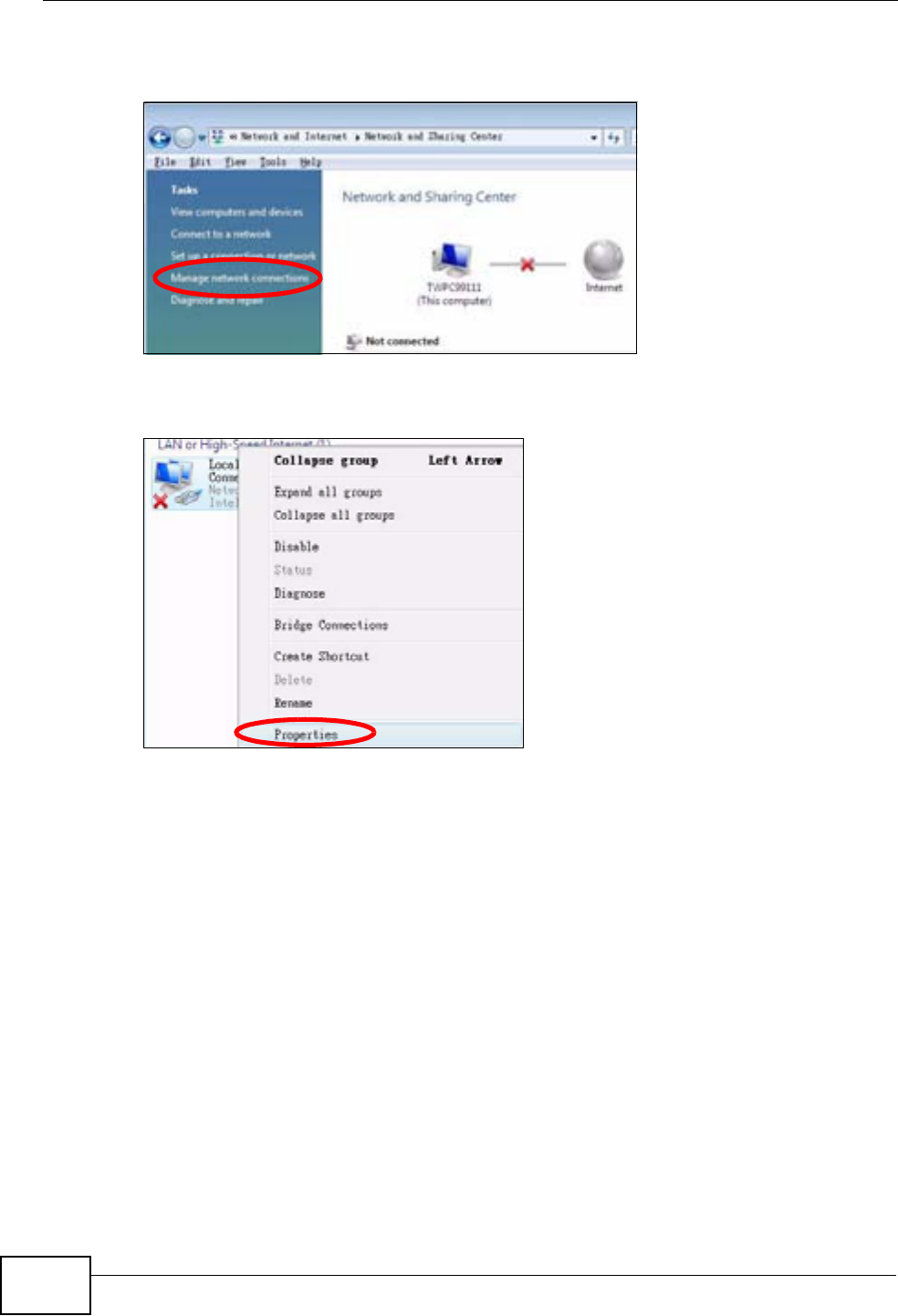
Appendix B Setting Up Your Computer’s IP Address
HES-309M Series User’s Guide
156
4Click Manage network connections.
Figure 78 Windows Vista: Network and Sharing Center
5Right-click Local Area Connection and then select Properties.
Figure 79 Windows Vista: Network and Sharing Center
Note: During this procedure, click Continue whenever Windows displays a screen
saying that it needs your permission to continue.
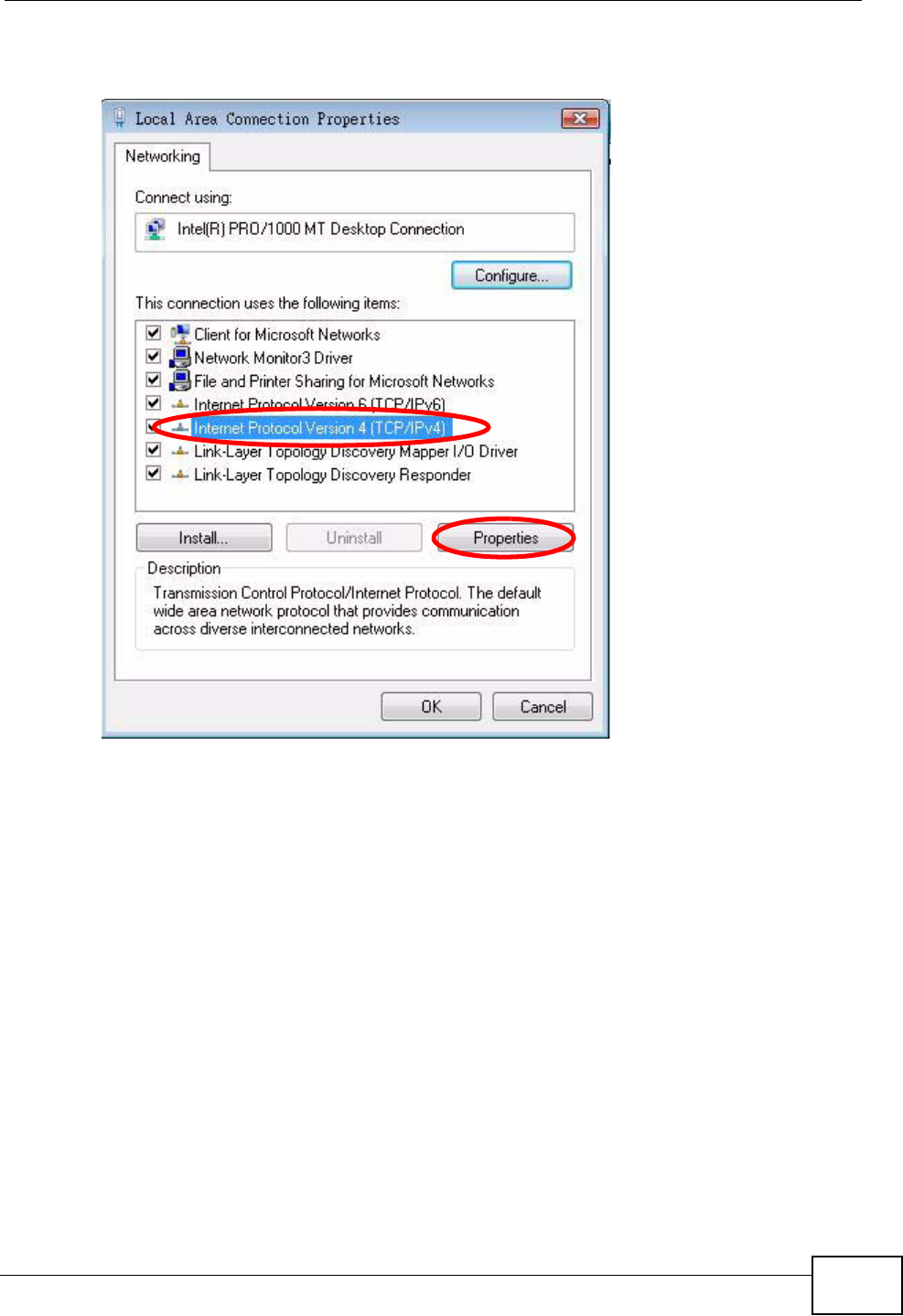
Appendix B Setting Up Your Computer’s IP Address
HES-309M Series User’s Guide 157
6Select Internet Protocol Version 4 (TCP/IPv4) and then select Properties.
Figure 80 Windows Vista: Local Area Connection Properties
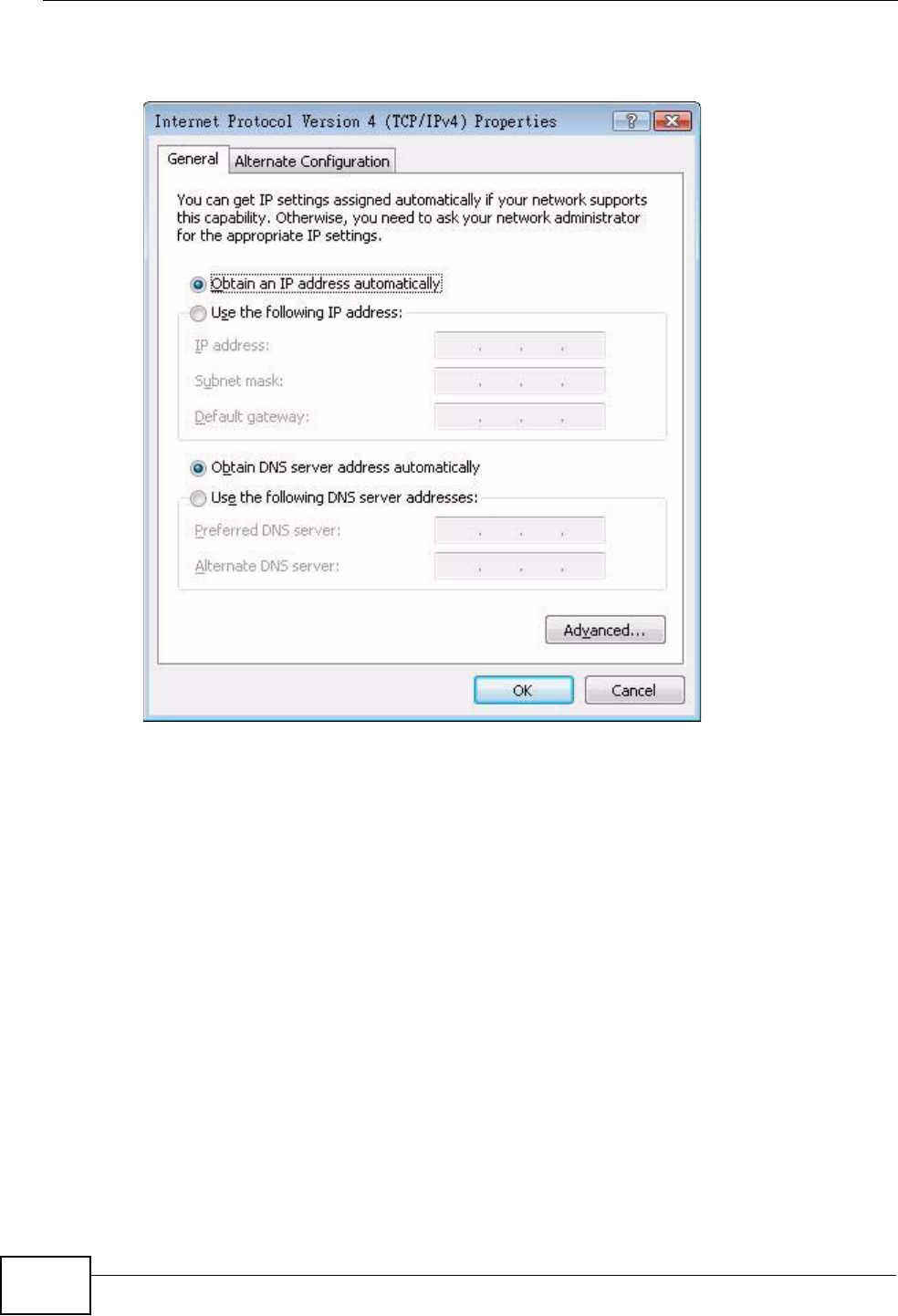
Appendix B Setting Up Your Computer’s IP Address
HES-309M Series User’s Guide
158
7The Internet Protocol Version 4 (TCP/IPv4) Properties window opens.
Figure 81 Windows Vista: Internet Protocol Version 4 (TCP/IPv4) Properties
8Select Obtain an IP address automatically if your network administrator or ISP
assigns your IP address dynamically.
Select Use the following IP Address and fill in the IP address,Subnet mask,
and Default gateway fields if you have a static IP address that was assigned to
you by your network administrator or ISP. You may also have to enter a Preferred
DNS server and an Alternate DNS server, if that information was
provided.Click Advanced.
9Click OK to close the Internet Protocol (TCP/IP) Properties window.
Click OK to close the Local Area Connection Properties window.Verifying Settings
1Click Start > All Programs > Accessories > Command Prompt.
2In the Command Prompt window, type "ipconfig" and then press [ENTER].
You can also go to Start > Control Panel > Network Connections, right-click a
network connection, click Status and then click the Support tab to view your IP
address and connection information.
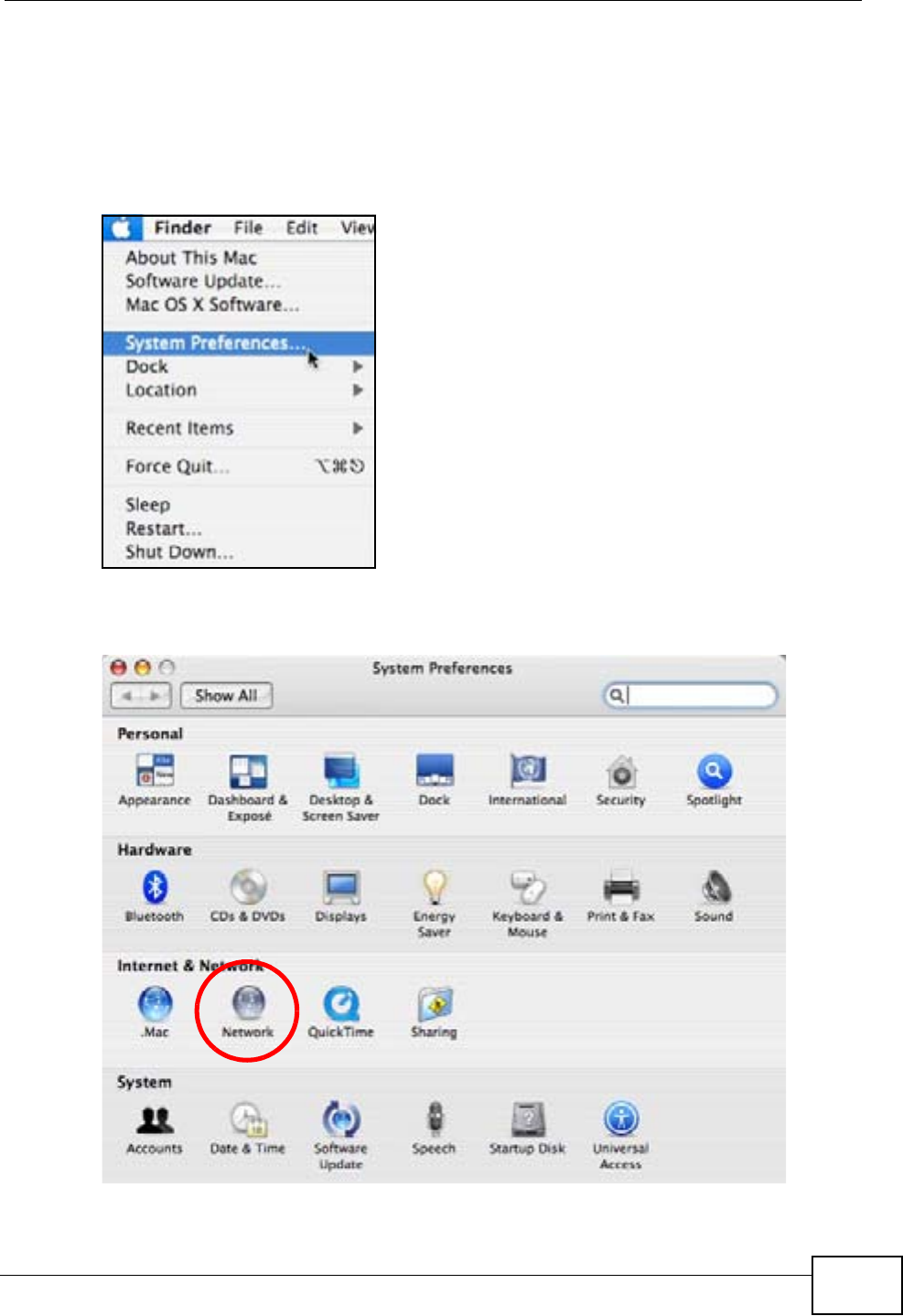
Appendix B Setting Up Your Computer’s IP Address
HES-309M Series User’s Guide 159
Mac OS X: 10.3 and 10.4
The screens in this section are from Mac OS X 10.4 but can also apply to 10.3.
1Click Apple > System Preferences.
Figure 82 Mac OS X 10.4: Apple Menu
2In the System Preferences window, click the Network icon.
Figure 83 Mac OS X 10.4: System Preferences
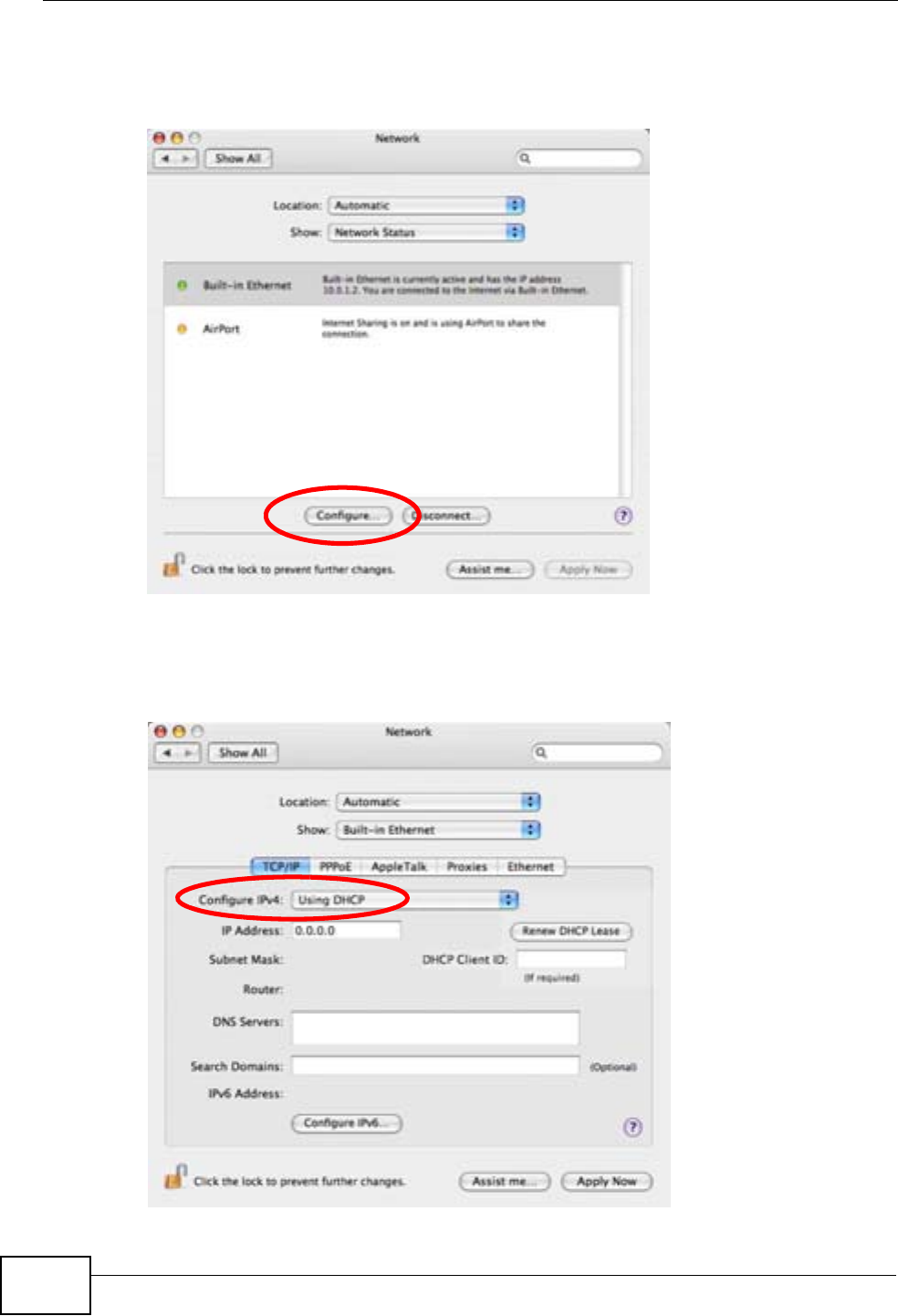
Appendix B Setting Up Your Computer’s IP Address
HES-309M Series User’s Guide
160
3When the Network preferences pane opens, select Built-in Ethernet from the
network connection type list, and then click Configure.
Figure 84 Mac OS X 10.4: Network Preferences
4For dynamically assigned settings, select Using DHCP from the Configure IPv4
list in the TCP/IP tab.
Figure 85 Mac OS X 10.4: Network Preferences > TCP/IP Tab.
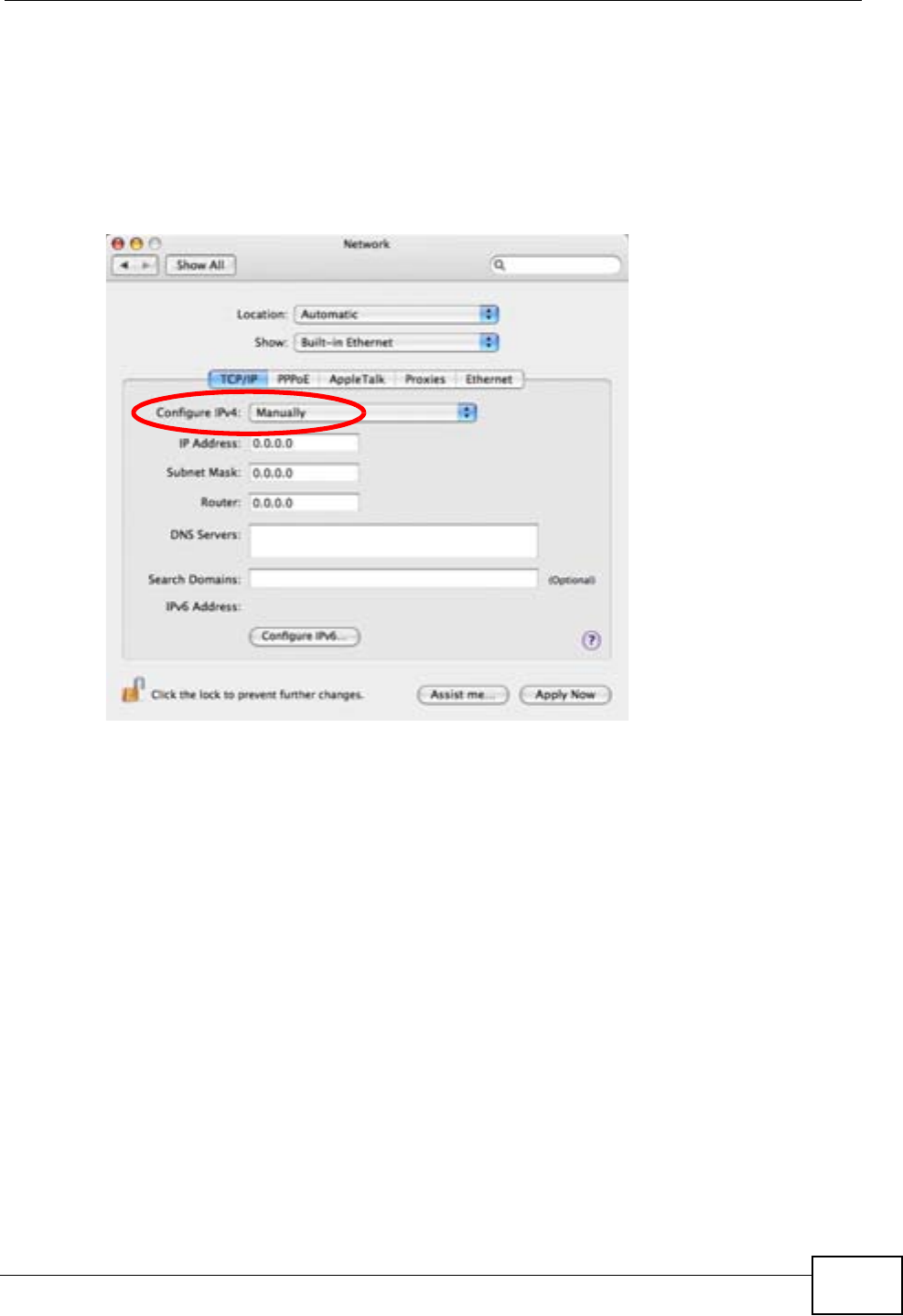
Appendix B Setting Up Your Computer’s IP Address
HES-309M Series User’s Guide 161
5For statically assigned settings, do the following:
•From the Configure IPv4 list, select Manually.
•In the IP Address field, type your IP address.
•In the Subnet Mask field, type your subnet mask.
•In the Router field, type the IP address of your device.
Figure 86 Mac OS X 10.4: Network Preferences > Ethernet
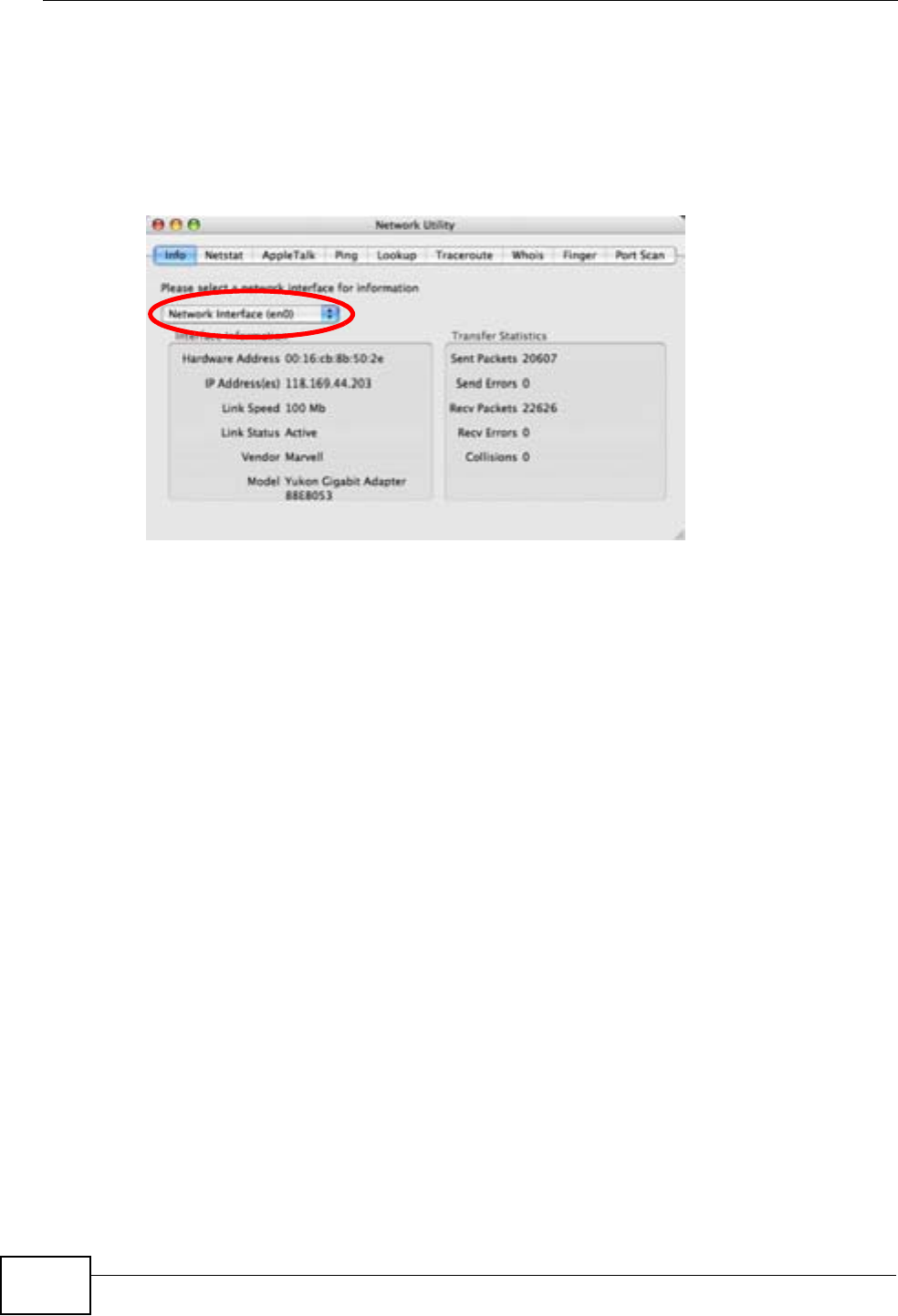
Appendix B Setting Up Your Computer’s IP Address
HES-309M Series User’s Guide
162
Click Apply Now and close the window.Verifying Settings
Check your TCP/IP properties by clicking Applications > Utilities > Network
Utilities, and then selecting the appropriate Network Interface from the Info
tab.
Figure 87 Mac OS X 10.4: Network Utility
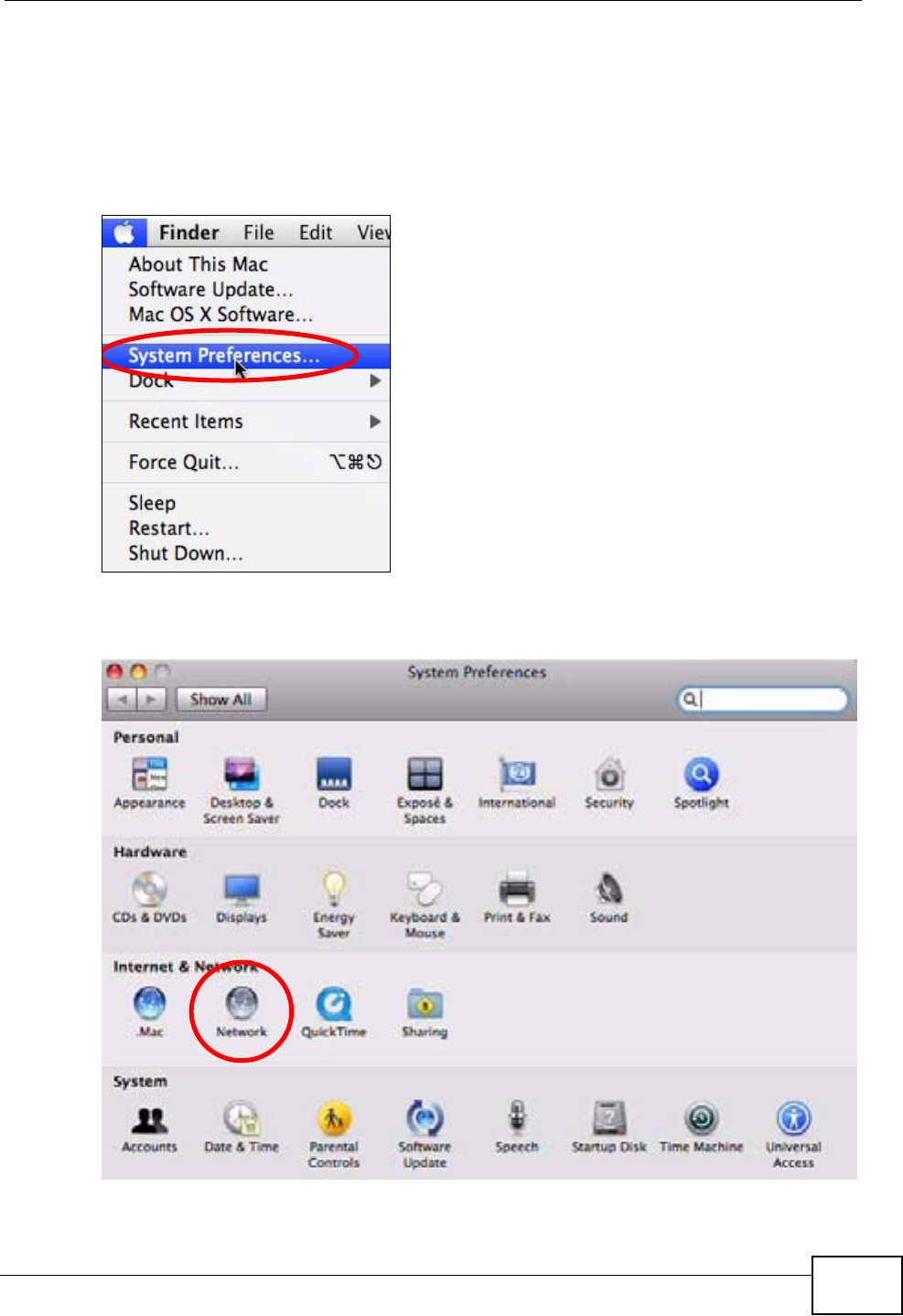
Appendix B Setting Up Your Computer’s IP Address
HES-309M Series User’s Guide 163
Mac OS X: 10.5
The screens in this section are from Mac OS X 10.5.
1Click Apple > System Preferences.
Figure 88 Mac OS X 10.5: Apple Menu
2In System Preferences, click the Network icon.
Figure 89 Mac OS X 10.5: Systems Preferences
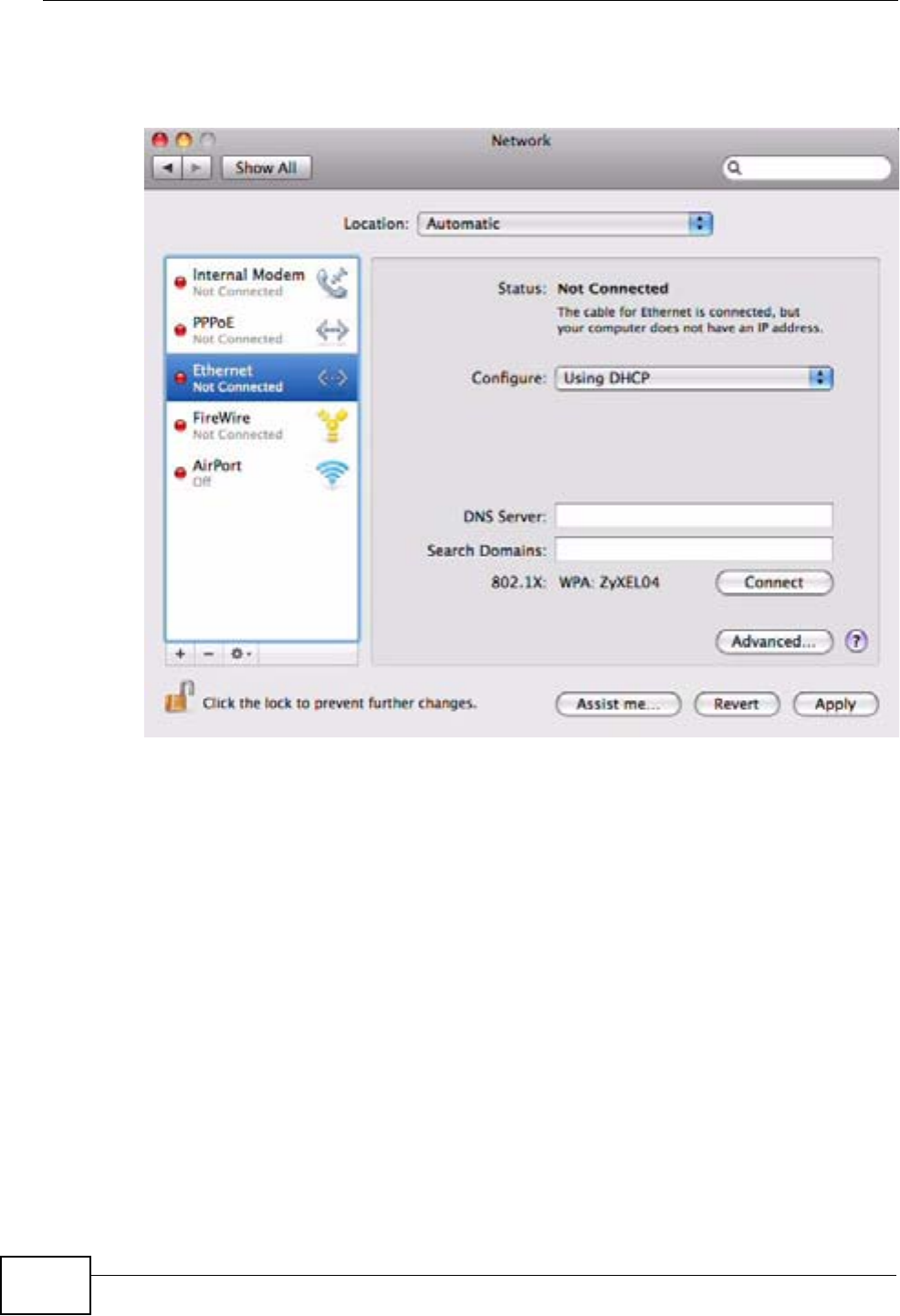
Appendix B Setting Up Your Computer’s IP Address
HES-309M Series User’s Guide
164
3When the Network preferences pane opens, select Ethernet from the list of
available connection types.
Figure 90 Mac OS X 10.5: Network Preferences > Ethernet
4From the Configure list, select Using DHCP for dynamically assigned settings.
5For statically assigned settings, do the following:
•From the Configure list, select Manually.
•In the IP Address field, enter your IP address.
•In the Subnet Mask field, enter your subnet mask.
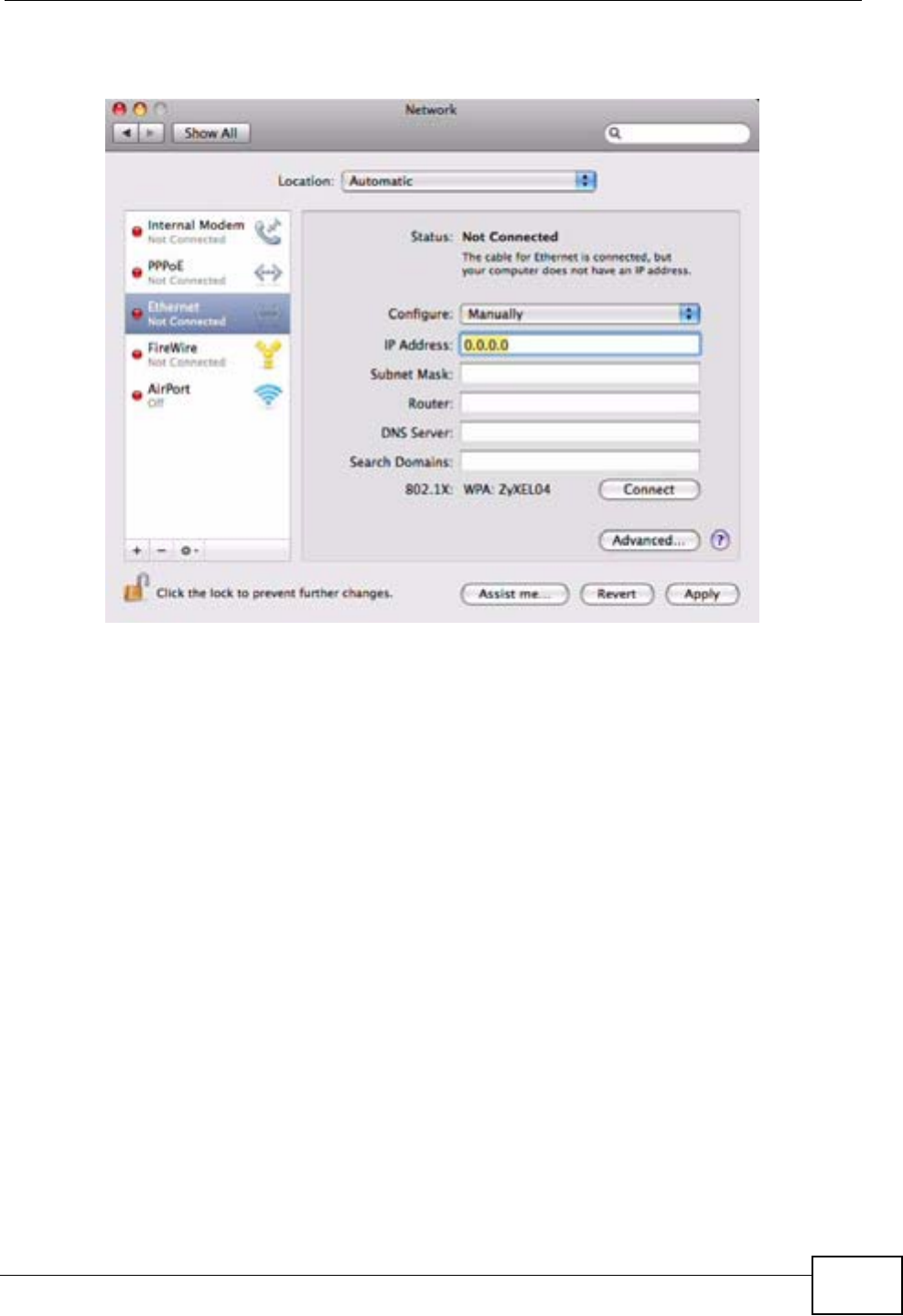
Appendix B Setting Up Your Computer’s IP Address
HES-309M Series User’s Guide 165
•In the Router field, enter the IP address of your WiMAX Device.
Figure 91 Mac OS X 10.5: Network Preferences > Ethernet
6Click Apply and close the window.
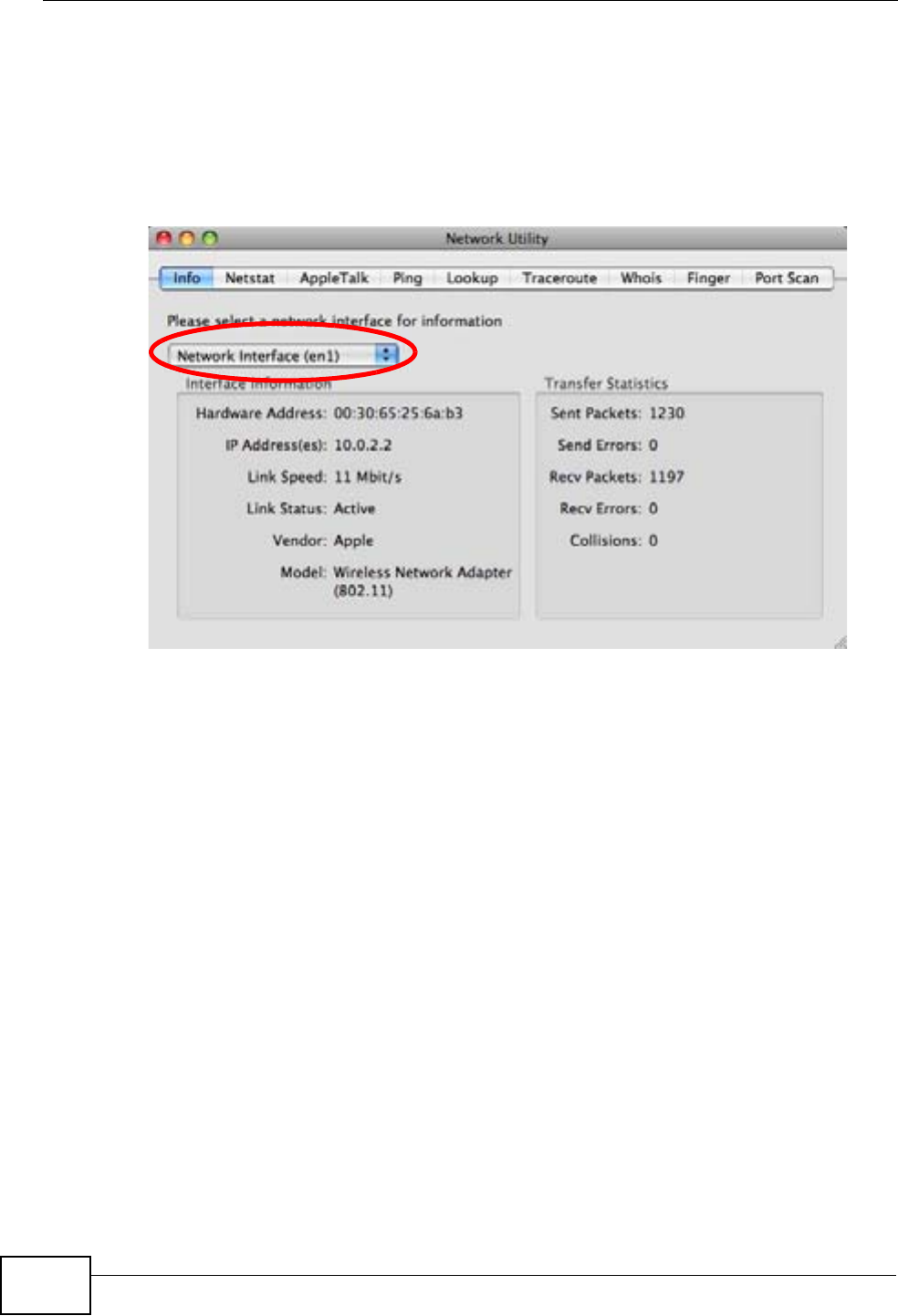
Appendix B Setting Up Your Computer’s IP Address
HES-309M Series User’s Guide
166
Verifying Settings
Check your TCP/IP properties by clicking Applications > Utilities > Network
Utilities, and then selecting the appropriate Network interface from the Info
tab.
Figure 92 Mac OS X 10.5: Network Utility
Linux: Ubuntu 8 (GNOME)
This section shows you how to configure your computer’s TCP/IP settings in the
GNU Object Model Environment (GNOME) using the Ubuntu 8 Linux distribution.
The procedure, screens and file locations may vary depending on your specific
distribution, release version, and individual configuration. The following screens
use the default Ubuntu 8 installation.
Note: Make sure you are logged in as the root administrator.
Follow the steps below to configure your computer IP address in GNOME:
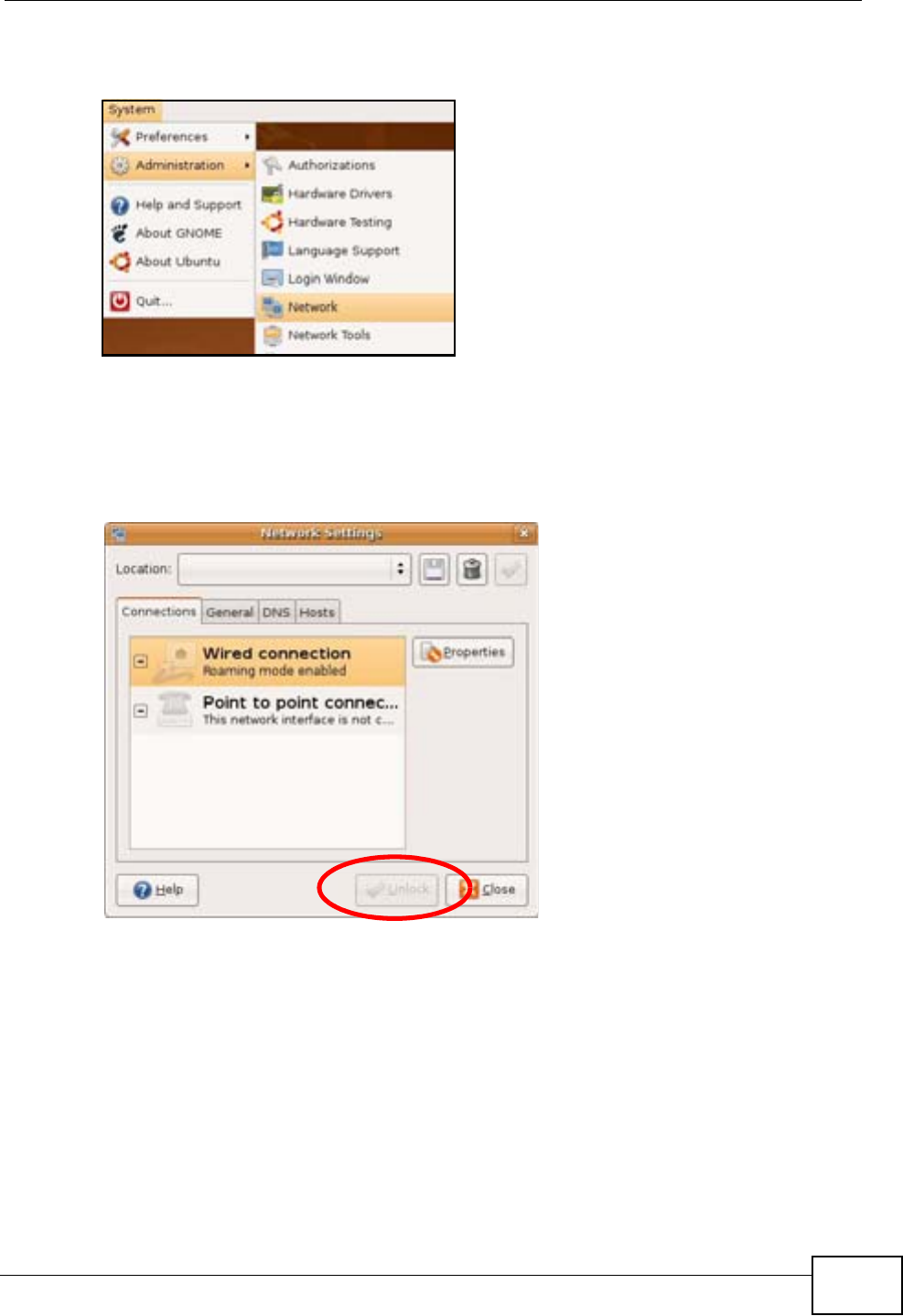
Appendix B Setting Up Your Computer’s IP Address
HES-309M Series User’s Guide 167
1Click System > Administration > Network.
Figure 93 Ubuntu 8: System > Administration Menu
2When the Network Settings window opens, click Unlock to open the
Authenticate window. (By default, the Unlock button is greyed out until clicked.)
You cannot make changes to your configuration unless you first enter your admin
password.
Figure 94 Ubuntu 8: Network Settings > Connections
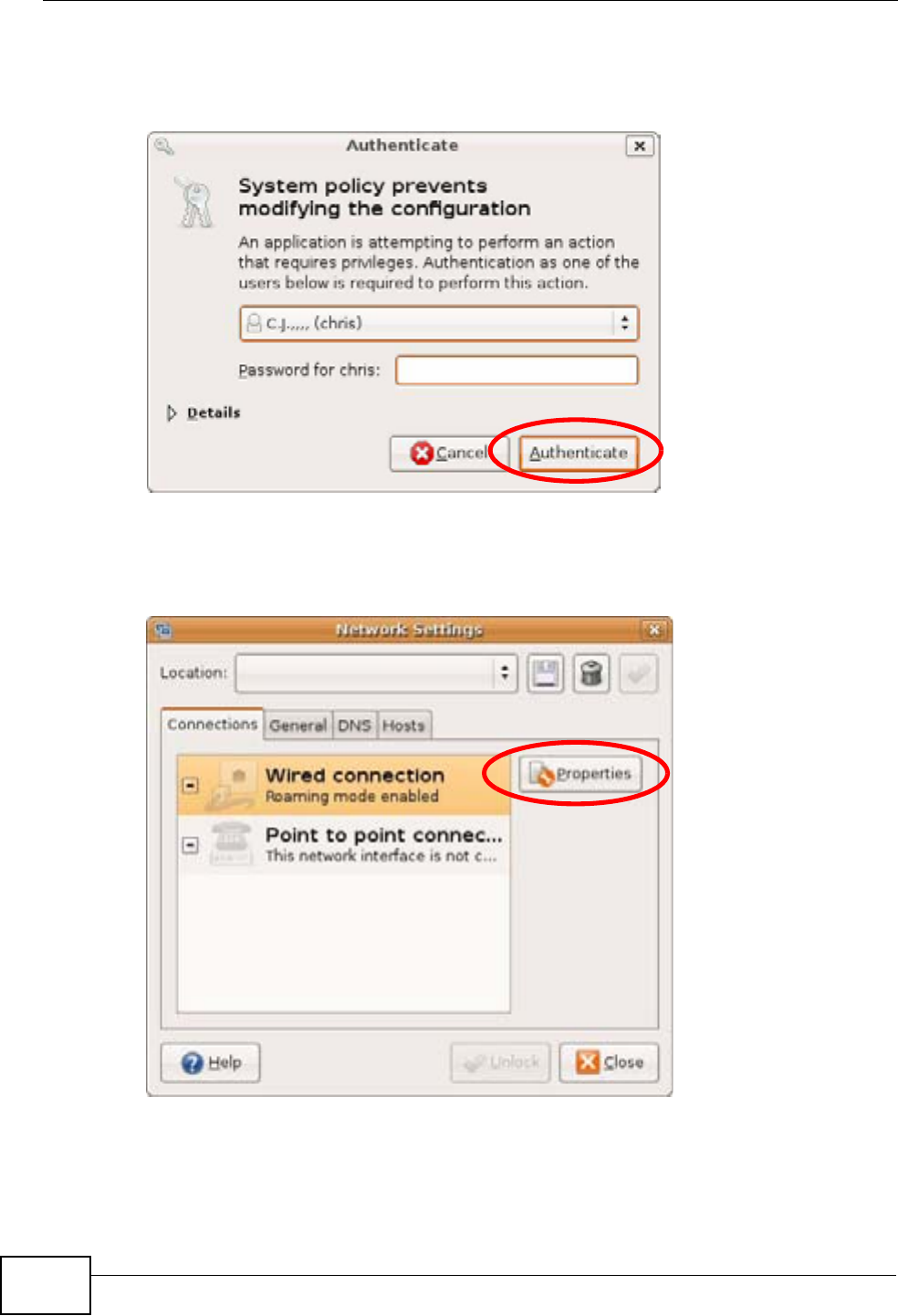
Appendix B Setting Up Your Computer’s IP Address
HES-309M Series User’s Guide
168
3In the Authenticate window, enter your admin account name and password then
click the Authenticate button.
Figure 95 Ubuntu 8: Administrator Account Authentication
4In the Network Settings window, select the connection that you want to
configure, then click Properties.
Figure 96 Ubuntu 8: Network Settings > Connections
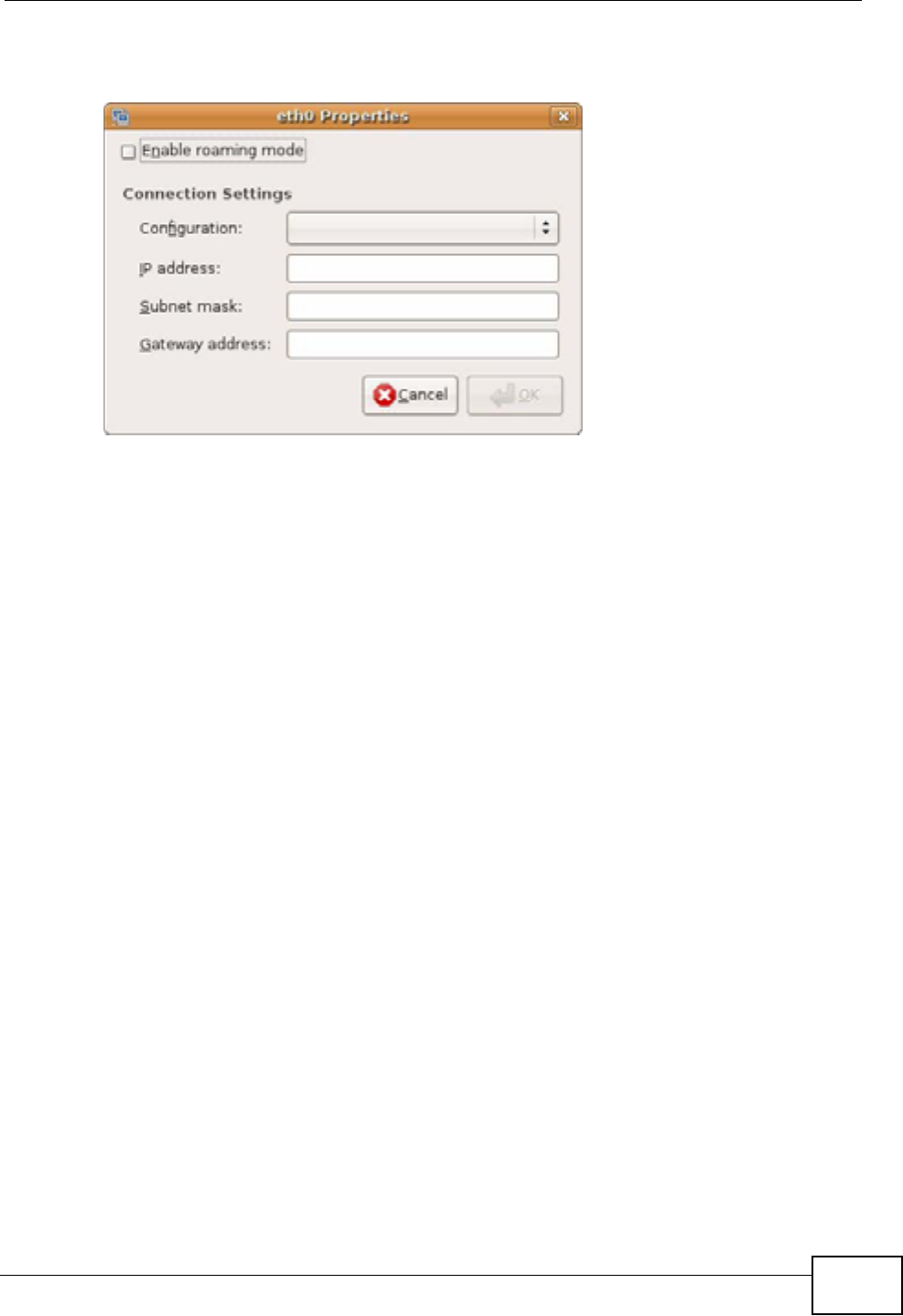
Appendix B Setting Up Your Computer’s IP Address
HES-309M Series User’s Guide 169
5The Properties dialog box opens.
Figure 97 Ubuntu 8: Network Settings > Properties
•In the Configuration list, select Automatic Configuration (DHCP) if you
have a dynamic IP address.
•In the Configuration list, select Static IP address if you have a static IP
address. Fill in the IP address,Subnet mask, and Gateway address fields.
6Click OK to save the changes and close the Properties dialog box and return to
the Network Settings screen.
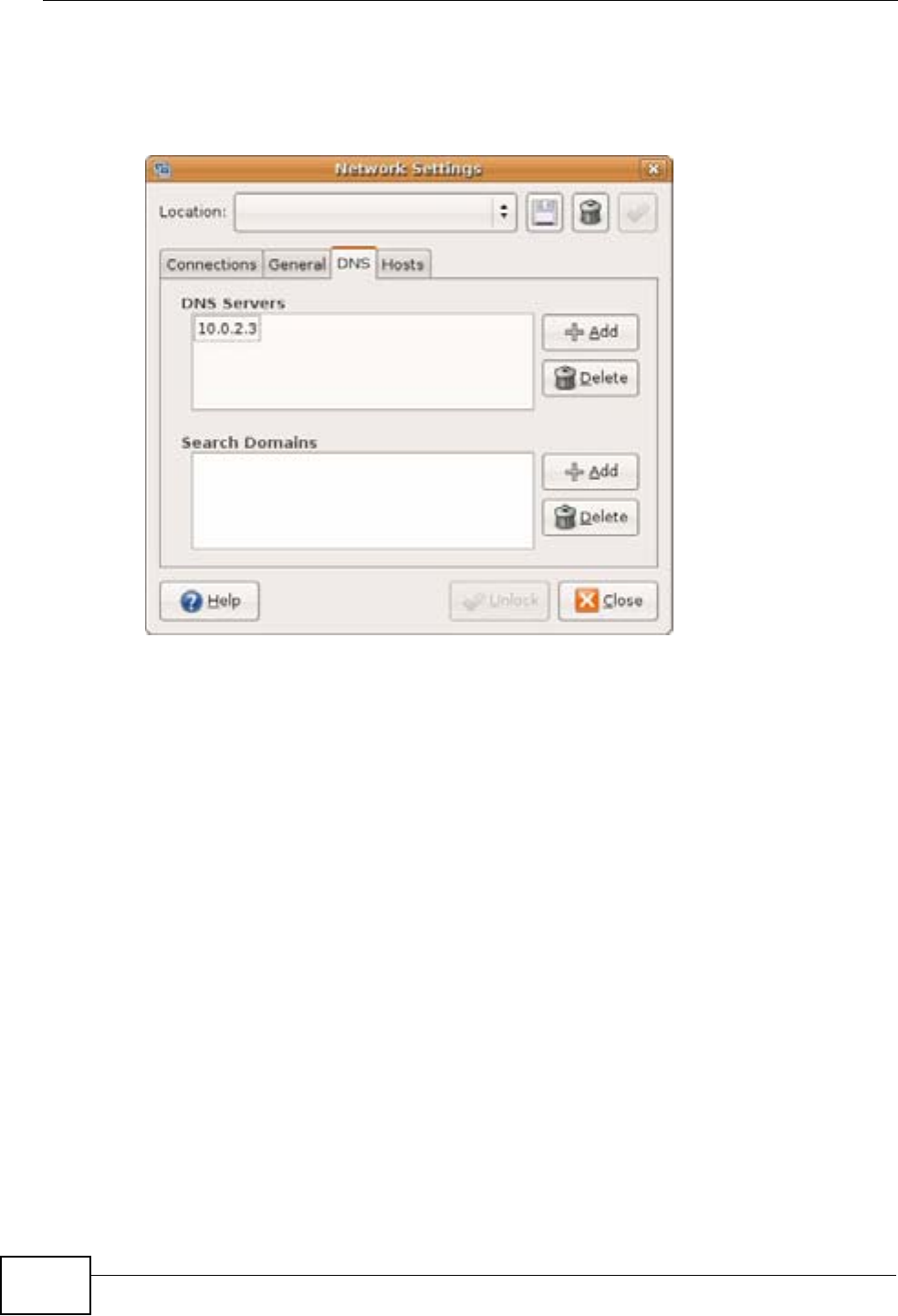
Appendix B Setting Up Your Computer’s IP Address
HES-309M Series User’s Guide
170
7If you know your DNS server IP address(es), click the DNS tab in the Network
Settings window and then enter the DNS server information in the fields
provided.
Figure 98 Ubuntu 8: Network Settings > DNS
8Click the Close button to apply the changes.
Verifying Settings
Check your TCP/IP properties by clicking System > Administration > Network
Tools, and then selecting the appropriate Network device from the Devices
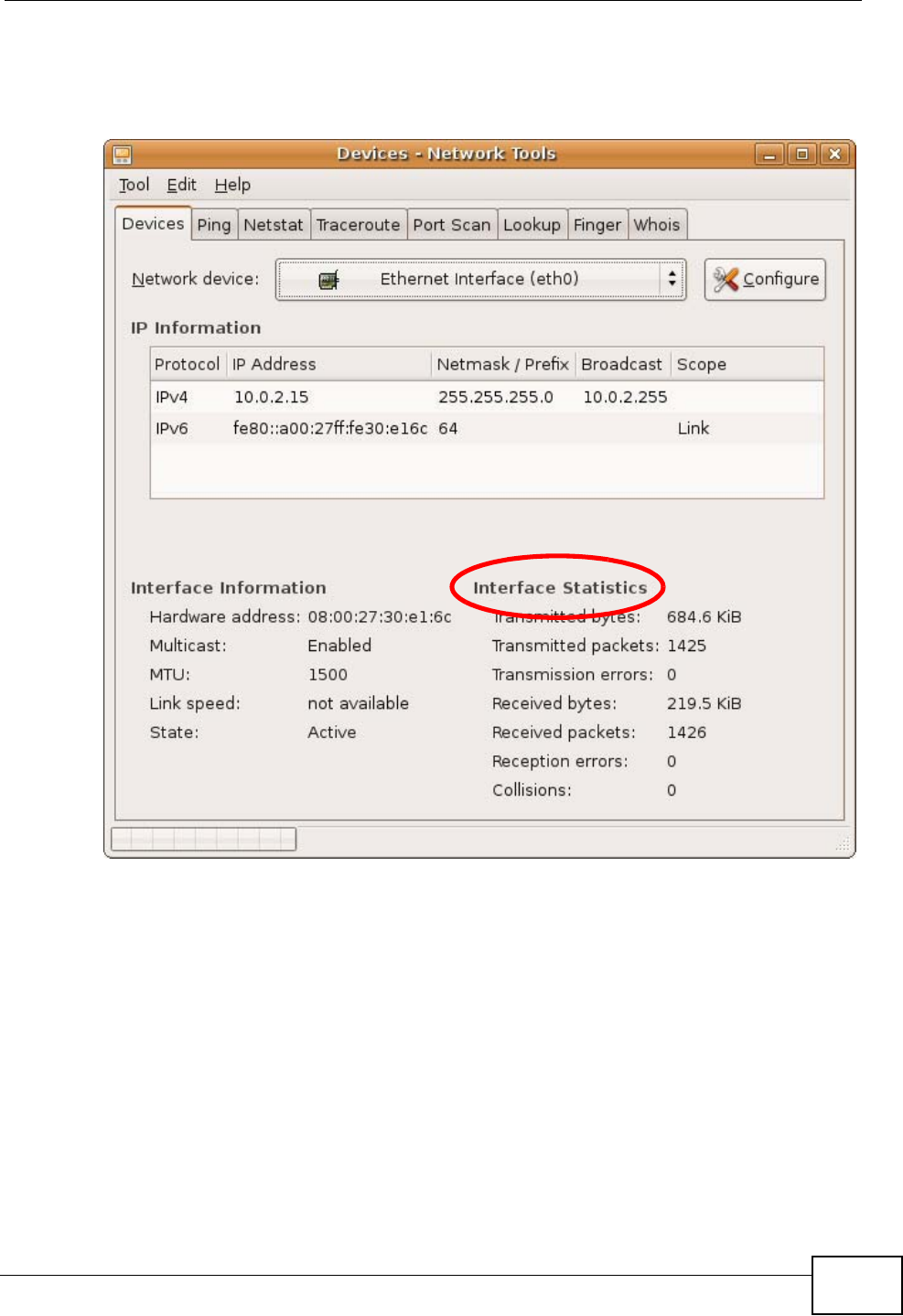
Appendix B Setting Up Your Computer’s IP Address
HES-309M Series User’s Guide 171
tab. The Interface Statistics column shows data if your connection is working
properly.
Figure 99 Ubuntu 8: Network Tools
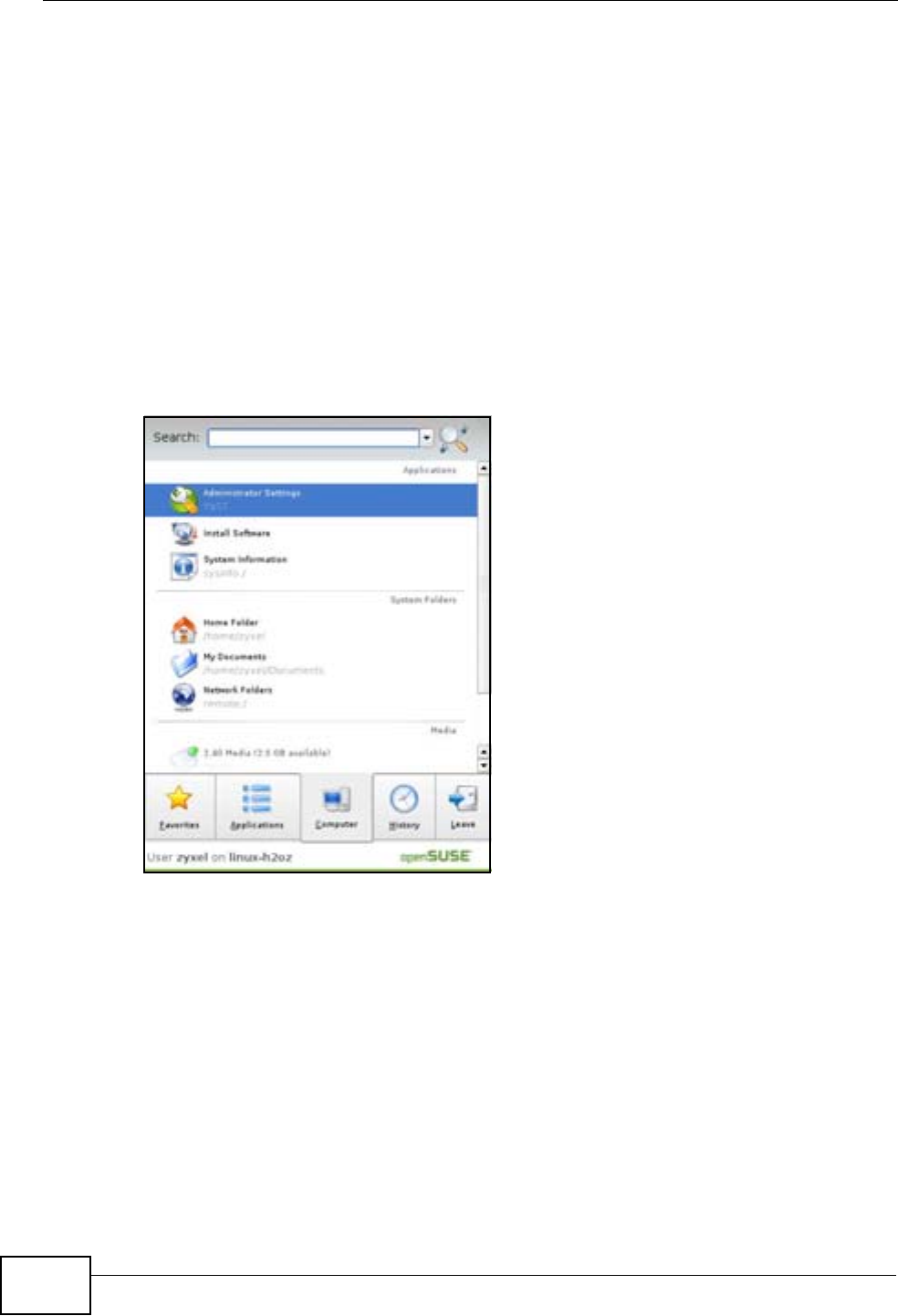
Appendix B Setting Up Your Computer’s IP Address
HES-309M Series User’s Guide
172
Linux: openSUSE 10.3 (KDE)
This section shows you how to configure your computer’s TCP/IP settings in the K
Desktop Environment (KDE) using the openSUSE 10.3 Linux distribution. The
procedure, screens and file locations may vary depending on your specific
distribution, release version, and individual configuration. The following screens
use the default openSUSE 10.3 installation.
Note: Make sure you are logged in as the root administrator.
Follow the steps below to configure your computer IP address in the KDE:
1Click K Menu > Computer > Administrator Settings (YaST).
Figure 100 openSUSE 10.3: K Menu > Computer Menu
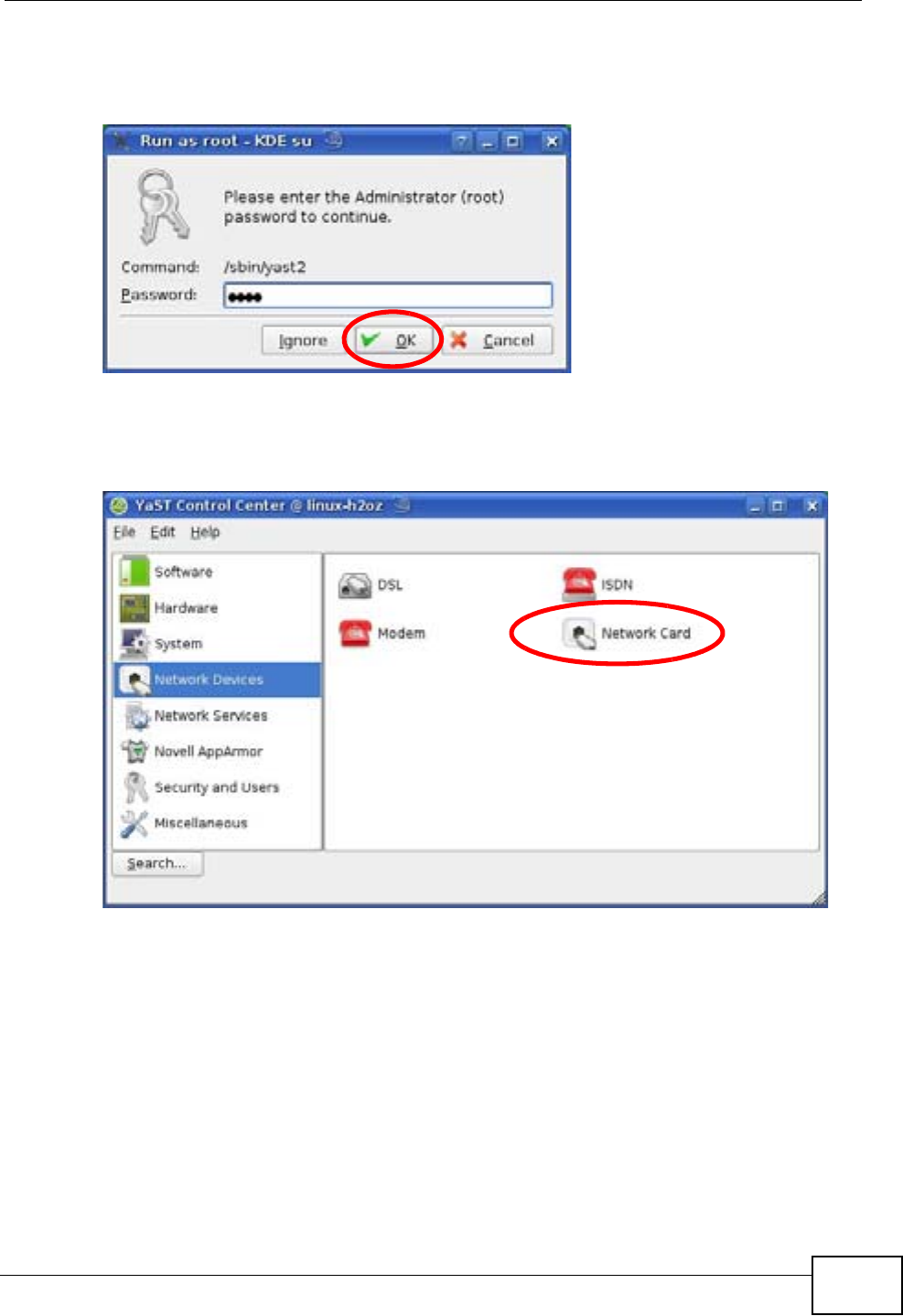
Appendix B Setting Up Your Computer’s IP Address
HES-309M Series User’s Guide 173
2When the Run as Root - KDE su dialog opens, enter the admin password and
click OK.
Figure 101 openSUSE 10.3: K Menu > Computer Menu
3When the YaST Control Center window opens, select Network Devices and
then click the Network Card icon.
Figure 102 openSUSE 10.3: YaST Control Center
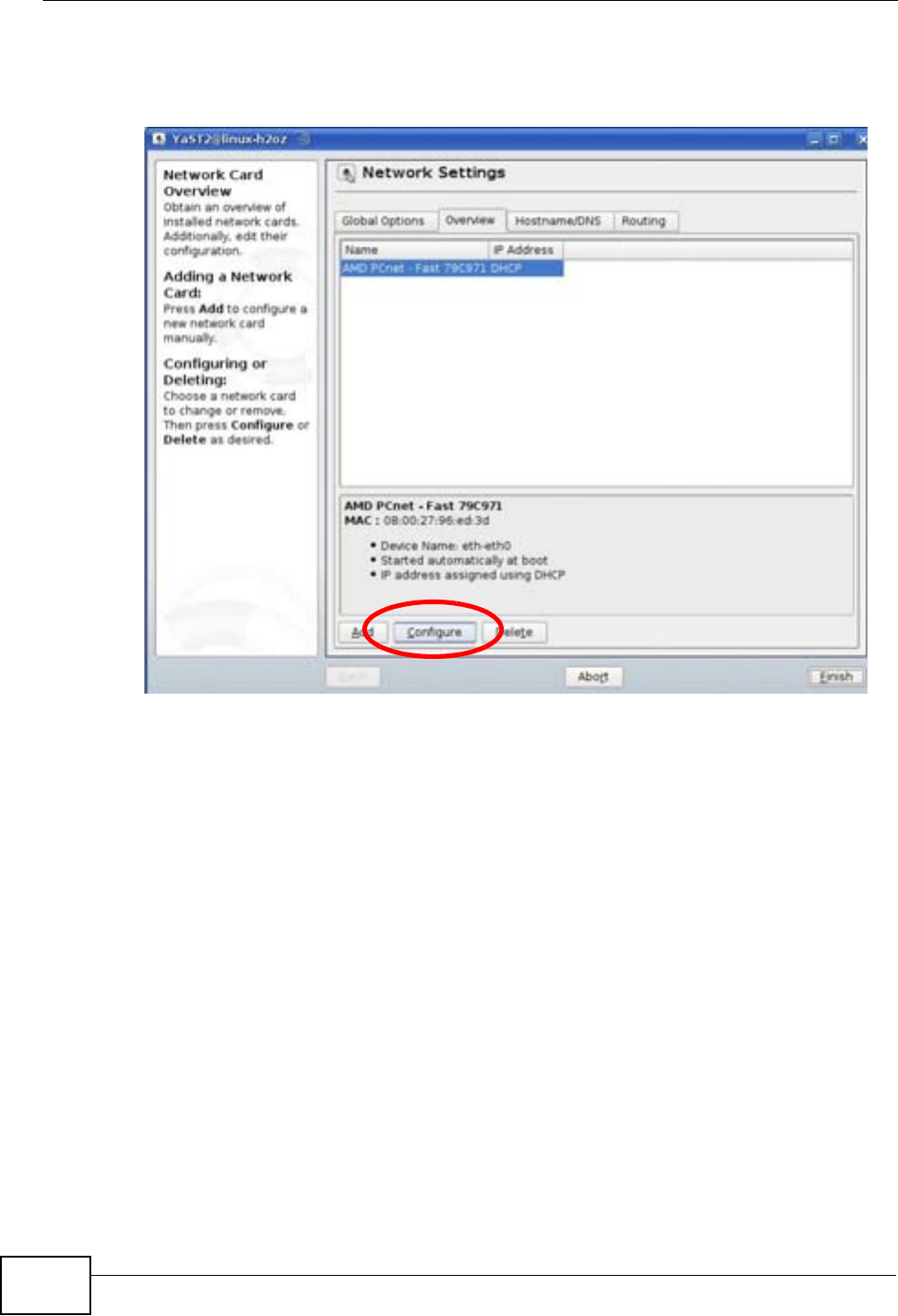
Appendix B Setting Up Your Computer’s IP Address
HES-309M Series User’s Guide
174
4When the Network Settings window opens, click the Overview tab, select the
appropriate connection Name from the list, and then click the Configure button.
Figure 103 openSUSE 10.3: Network Settings
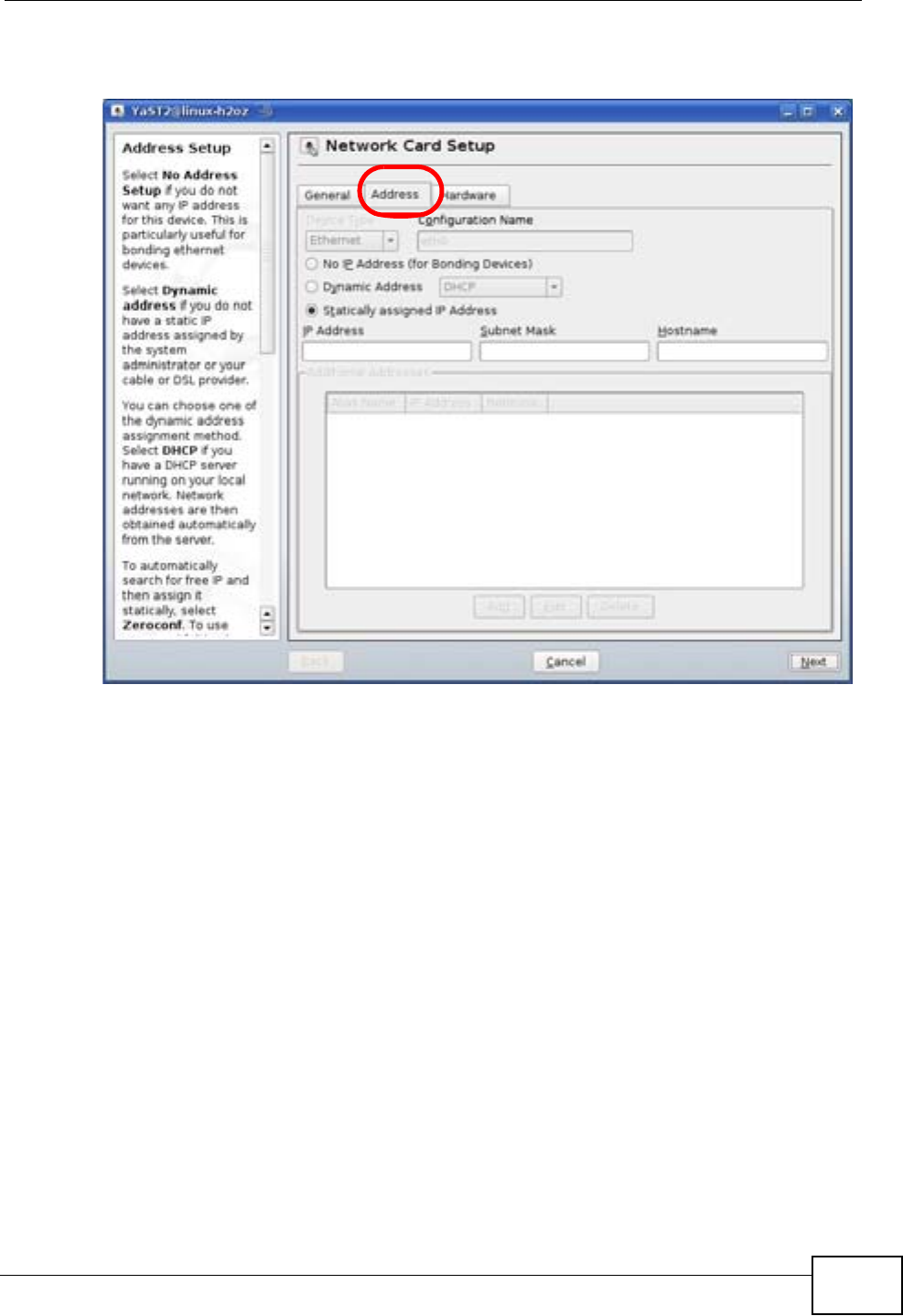
Appendix B Setting Up Your Computer’s IP Address
HES-309M Series User’s Guide 175
5When the Network Card Setup window opens, click the Address tab
Figure 104 openSUSE 10.3: Network Card Setup
6Select Dynamic Address (DHCP) if you have a dynamic IP address.
Select Statically assigned IP Address if you have a static IP address. Fill in the
IP address,Subnet mask, and Hostname fields.
7Click Next to save the changes and close the Network Card Setup window.
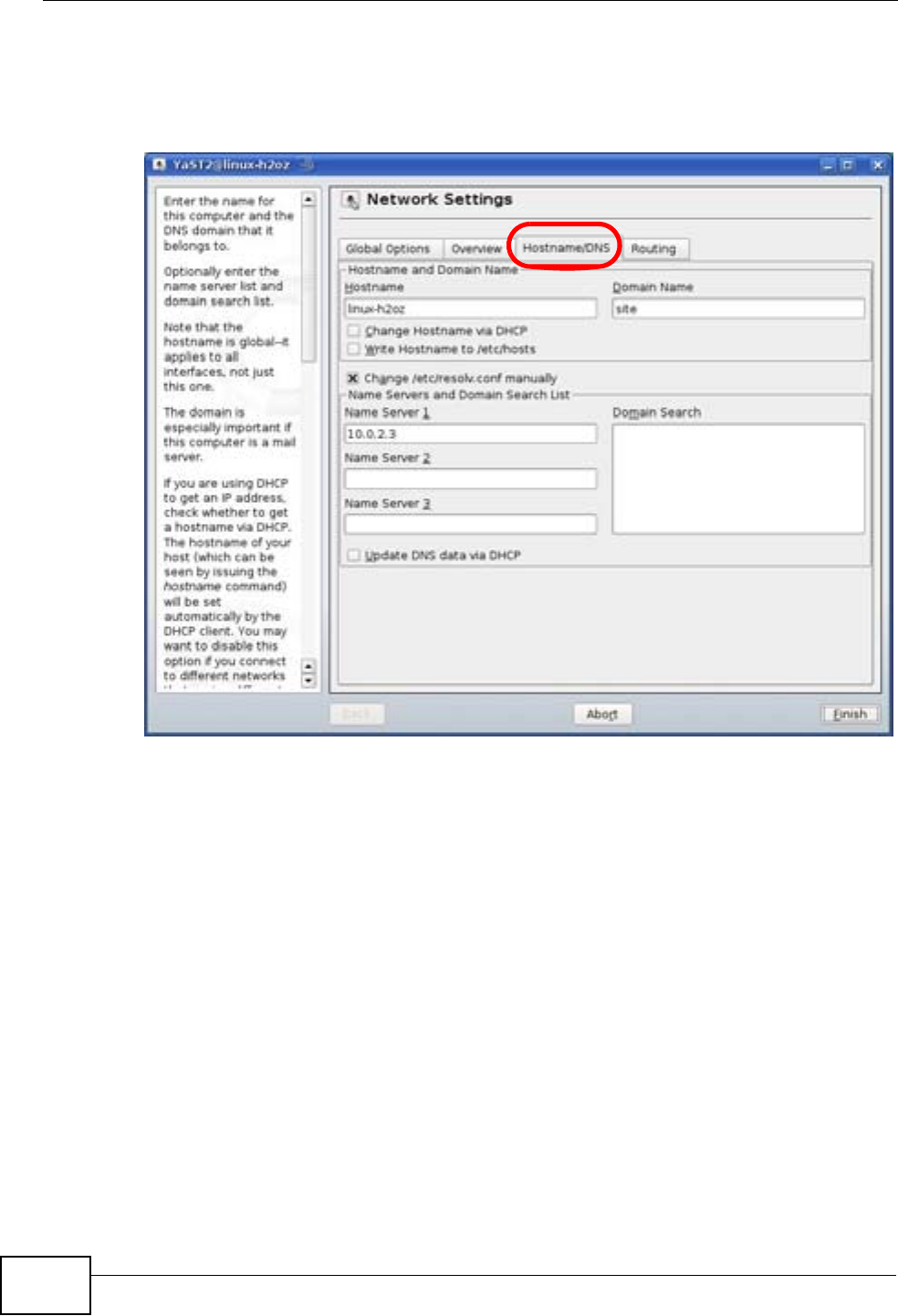
Appendix B Setting Up Your Computer’s IP Address
HES-309M Series User’s Guide
176
8If you know your DNS server IP address(es), click the Hostname/DNS tab in
Network Settings and then enter the DNS server information in the fields
provided.
Figure 105 openSUSE 10.3: Network Settings
9Click Finish to save your settings and close the window.
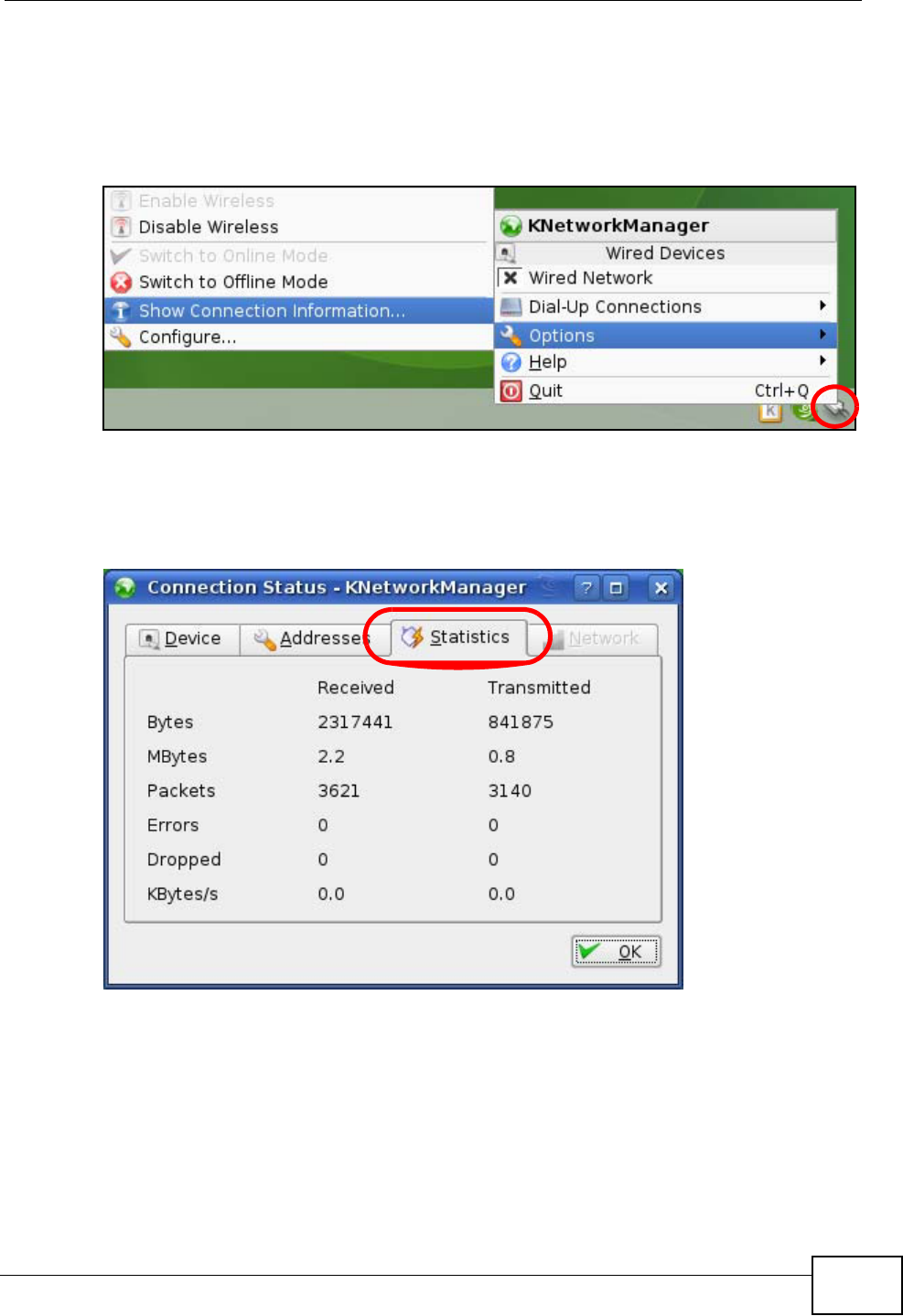
Appendix B Setting Up Your Computer’s IP Address
HES-309M Series User’s Guide 177
Verifying Settings
Click the KNetwork Manager icon on the Task bar to check your TCP/IP
properties. From the Options sub-menu, select Show Connection Information.
Figure 106 openSUSE 10.3: KNetwork Manager
When the Connection Status - KNetwork Manager window opens, click the
Statistics tab to see if your connection is working properly.
Figure 107 openSUSE: Connection Status - KNetwork Manager

Appendix B Setting Up Your Computer’s IP Address
HES-309M Series User’s Guide
178

HES-309M Series User’s Guide 179
APPENDIX C
Pop-up Windows, JavaScript
and Java Permissions
In order to use the web configurator you need to allow:
• Web browser pop-up windows from your device.
• JavaScript (enabled by default).
• Java permissions (enabled by default).
Note: Internet Explorer 6 screens are used here. Screens for other Internet Explorer
versions may vary.
Internet Explorer Pop-up Blockers
You may have to disable pop-up blocking to log into your device.
Either disable pop-up blocking (enabled by default in Windows XP SP (Service
Pack) 2) or allow pop-up blocking and create an exception for your device’s IP
address.
Disable Pop-up Blockers
1In Internet Explorer, select Tools,Pop-up Blocker and then select Turn Off
Pop-up Blocker.
Figure 108 Pop-up Blocker
You can also check if pop-up blocking is disabled in the Pop-up Blocker section in
the Privacy tab.
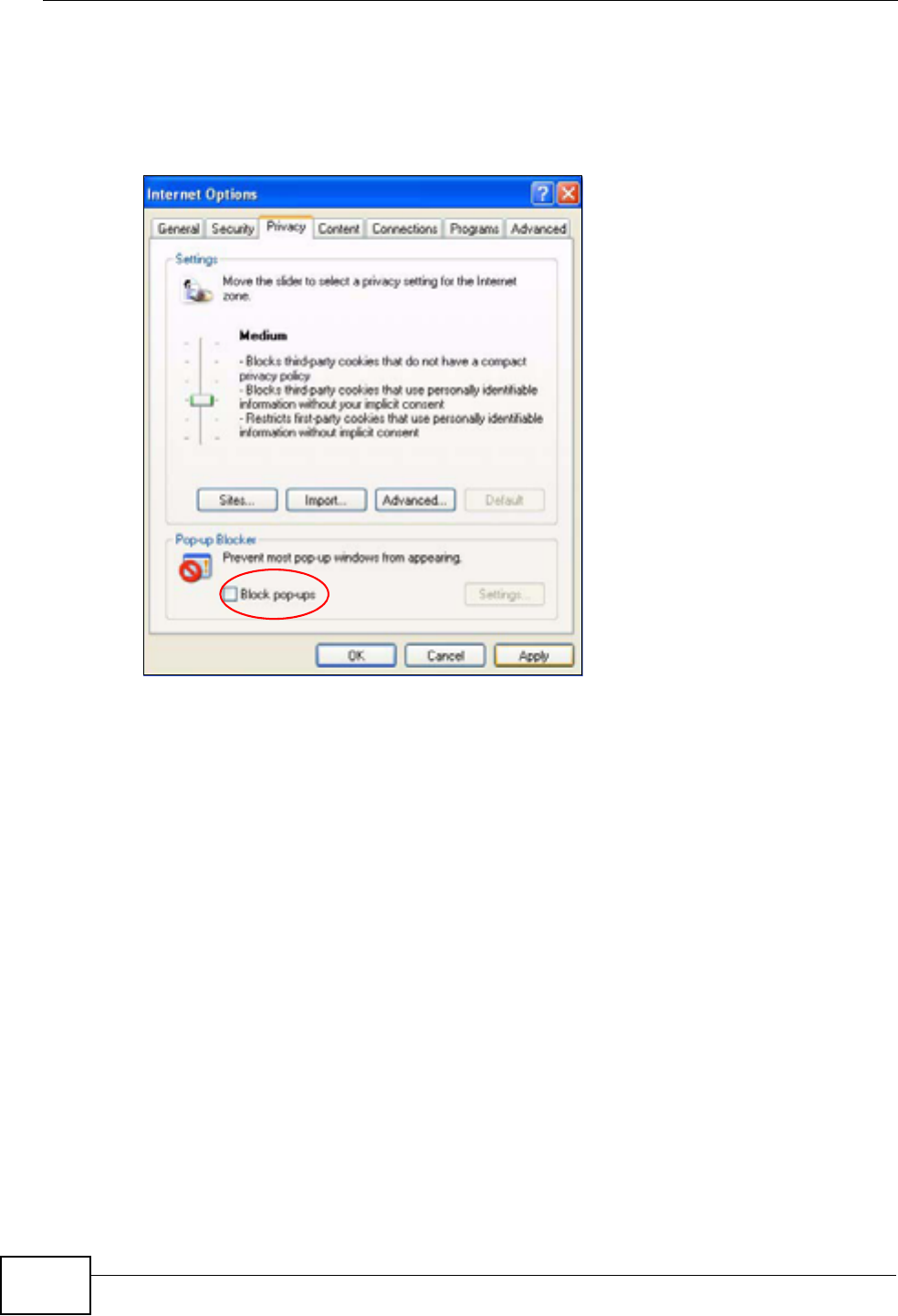
Appendix C Pop-up Windows, JavaScript and Java Permissions
HES-309M Series User’s Guide
180
1In Internet Explorer, select Tools,Internet Options,Privacy.
2Clear the Block pop-ups check box in the Pop-up Blocker section of the screen.
This disables any web pop-up blockers you may have enabled.
Figure 109 Internet Options: Privacy
3Click Apply to save this setting.
Enable Pop-up Blockers with Exceptions
Alternatively, if you only want to allow pop-up windows from your device, see the
following steps.
1In Internet Explorer, select Tools,Internet Options and then the Privacy tab.
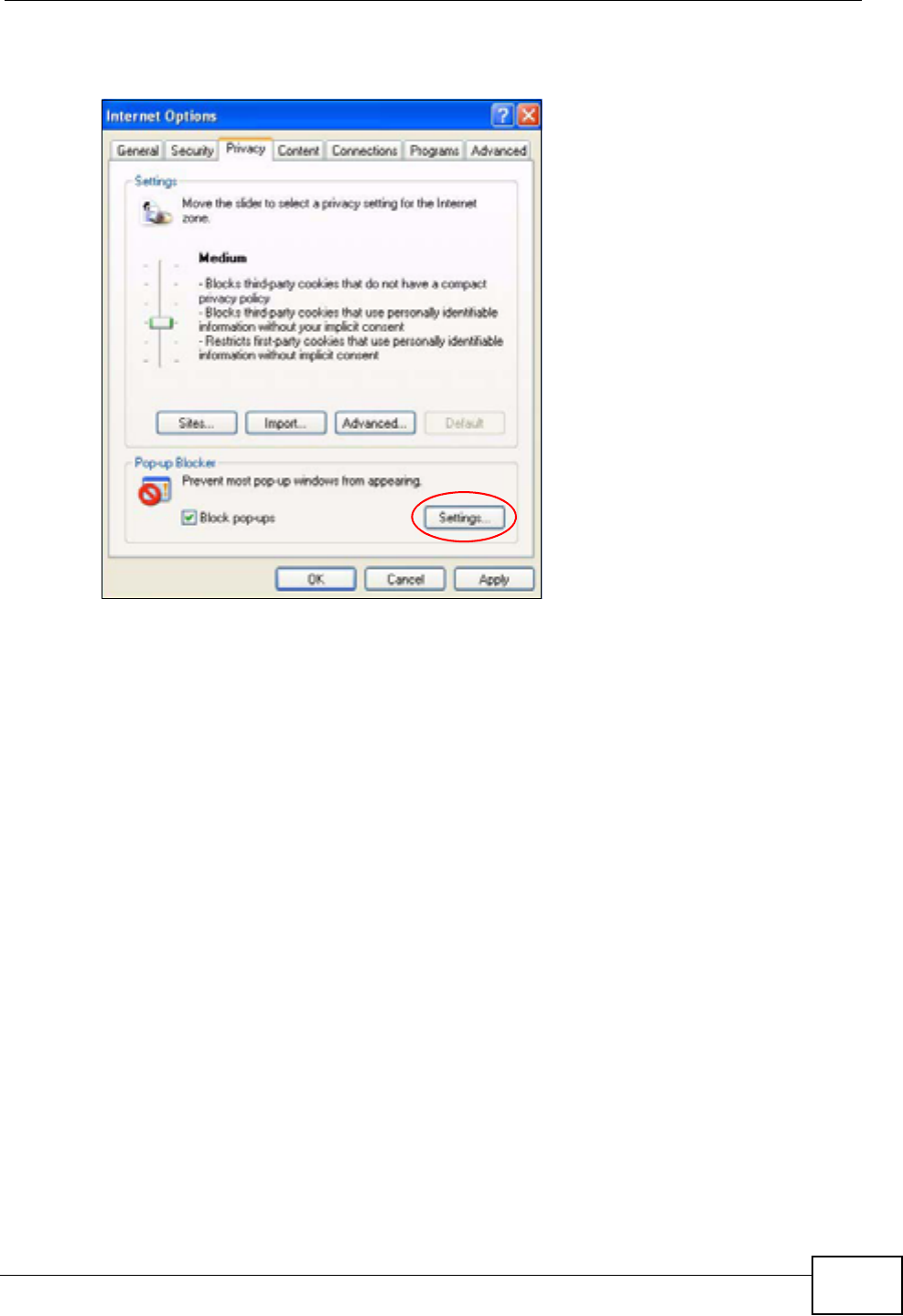
Appendix C Pop-up Windows, JavaScript and Java Permissions
HES-309M Series User’s Guide 181
2Select Settings…to open the Pop-up Blocker Settings screen.
Figure 110 Internet Options: Privacy
3Type the IP address of your device (the web page that you do not want to have
blocked) with the prefix “http://”. For example, http://192.168.167.1.
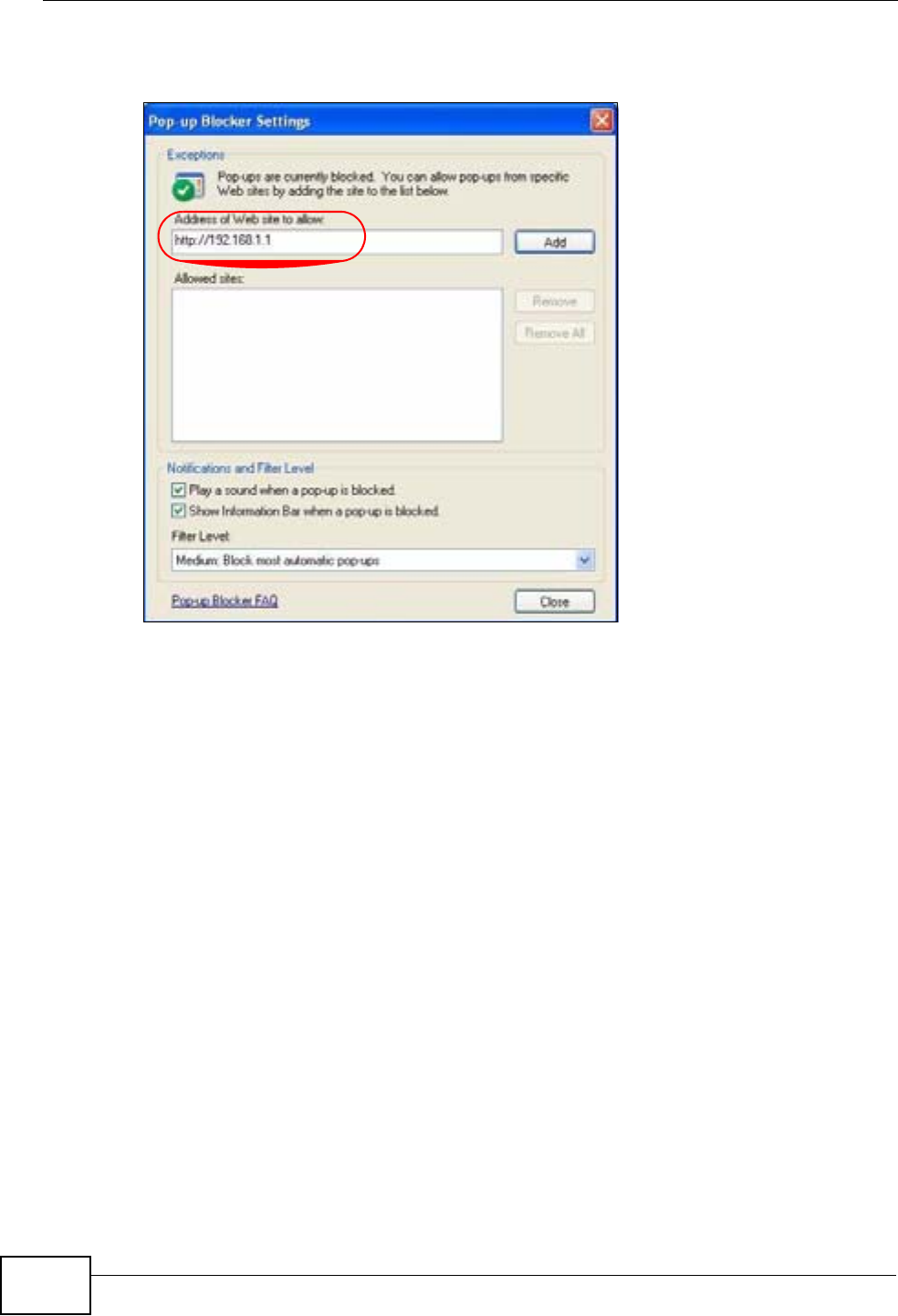
Appendix C Pop-up Windows, JavaScript and Java Permissions
HES-309M Series User’s Guide
182
4Click Add to move the IP address to the list of Allowed sites.
Figure 111 Pop-up Blocker Settings
5Click Close to return to the Privacy screen.
6Click Apply to save this setting.
JavaScript
If pages of the web configurator do not display properly in Internet Explorer, check
that JavaScript is allowed.
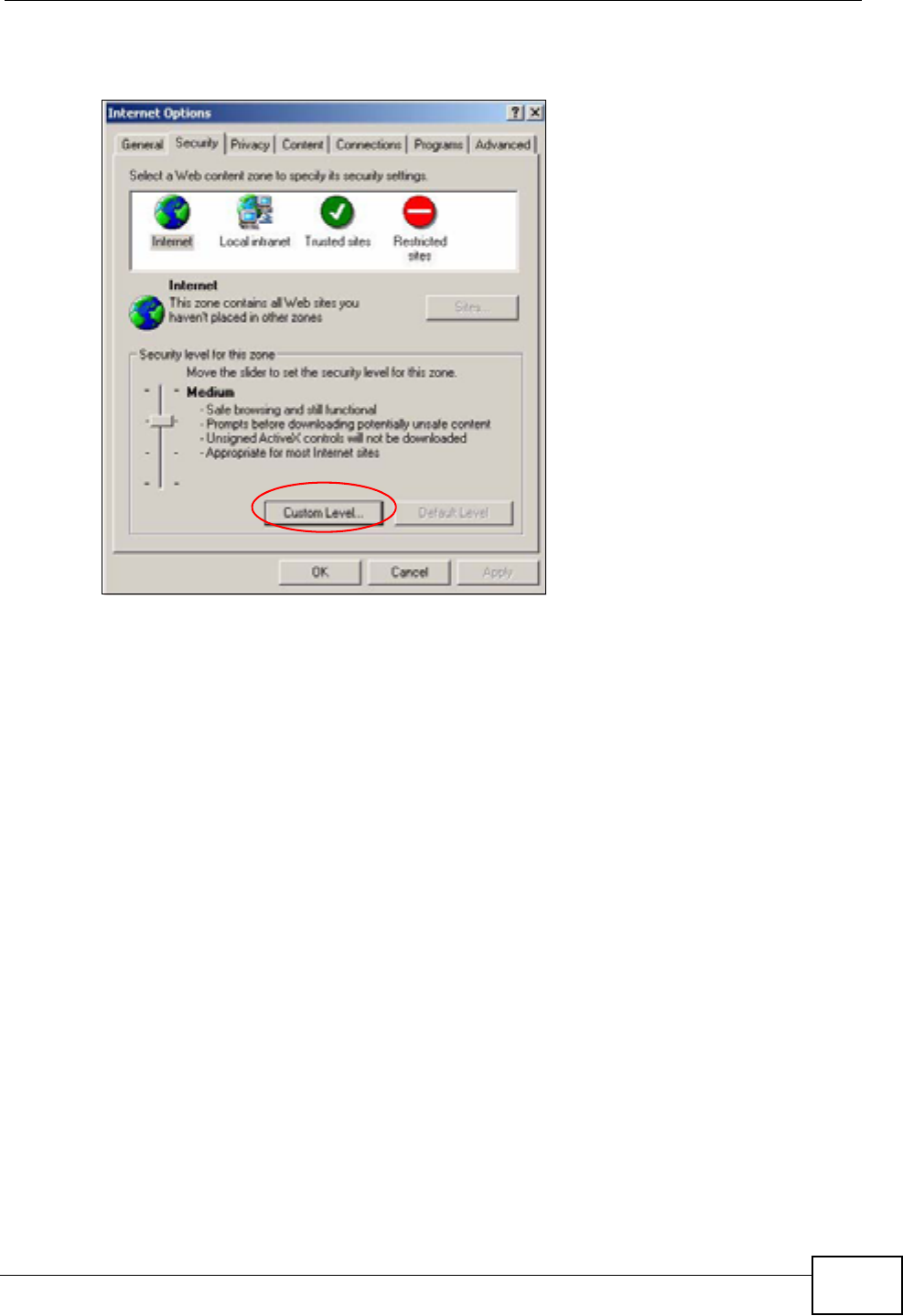
Appendix C Pop-up Windows, JavaScript and Java Permissions
HES-309M Series User’s Guide 183
1In Internet Explorer, click Tools,Internet Options and then the Security tab.
Figure 112 Internet Options: Security
2Click the Custom Level... button.
3Scroll down to Scripting.
4Under Active scripting make sure that Enable is selected (the default).
5Under Scripting of Java applets make sure that Enable is selected (the
default).
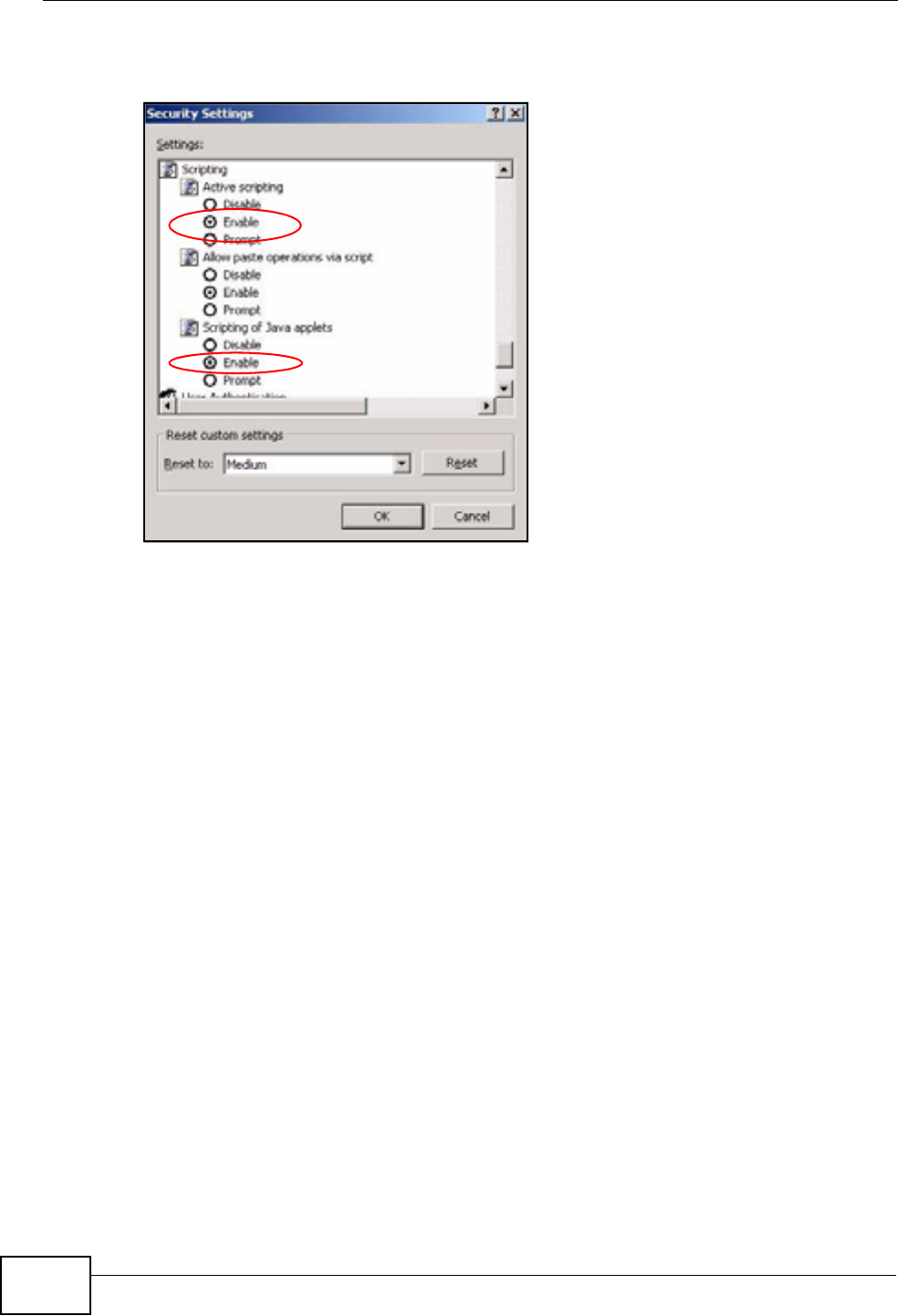
Appendix C Pop-up Windows, JavaScript and Java Permissions
HES-309M Series User’s Guide
184
6Click OK to close the window.
Figure 113 Security Settings - Java Scripting
Java Permissions
1From Internet Explorer, click Tools,Internet Options and then the Security
tab.
2Click the Custom Level... button.
3Scroll down to Microsoft VM.
4Under Java permissions make sure that a safety level is selected.
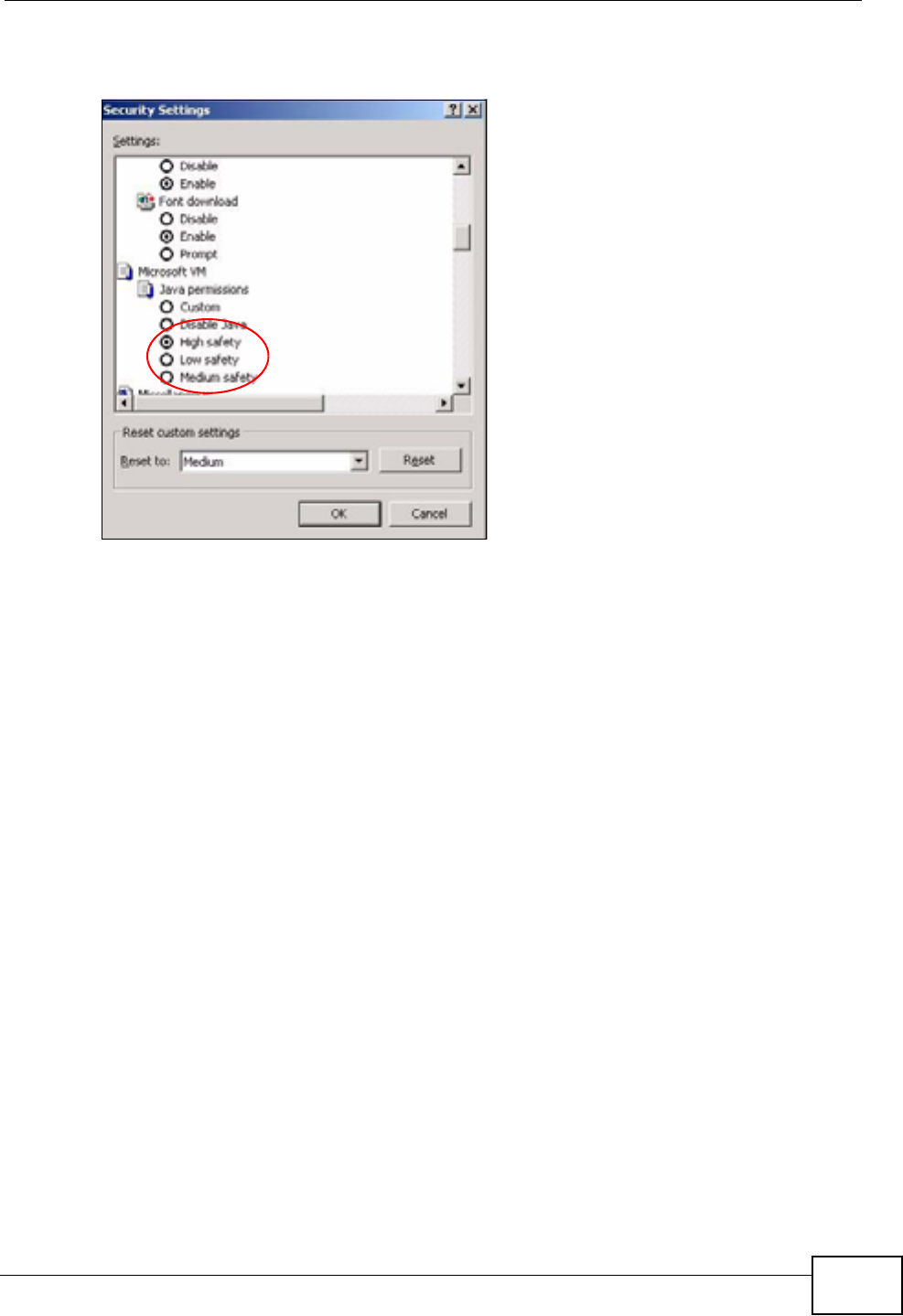
Appendix C Pop-up Windows, JavaScript and Java Permissions
HES-309M Series User’s Guide 185
5Click OK to close the window.
Figure 114 Security Settings - Java
JAVA (Sun)
1From Internet Explorer, click Tools,Internet Options and then the Advanced
tab.
2Make sure that Use Java 2 for <applet> under Java (Sun) is selected.
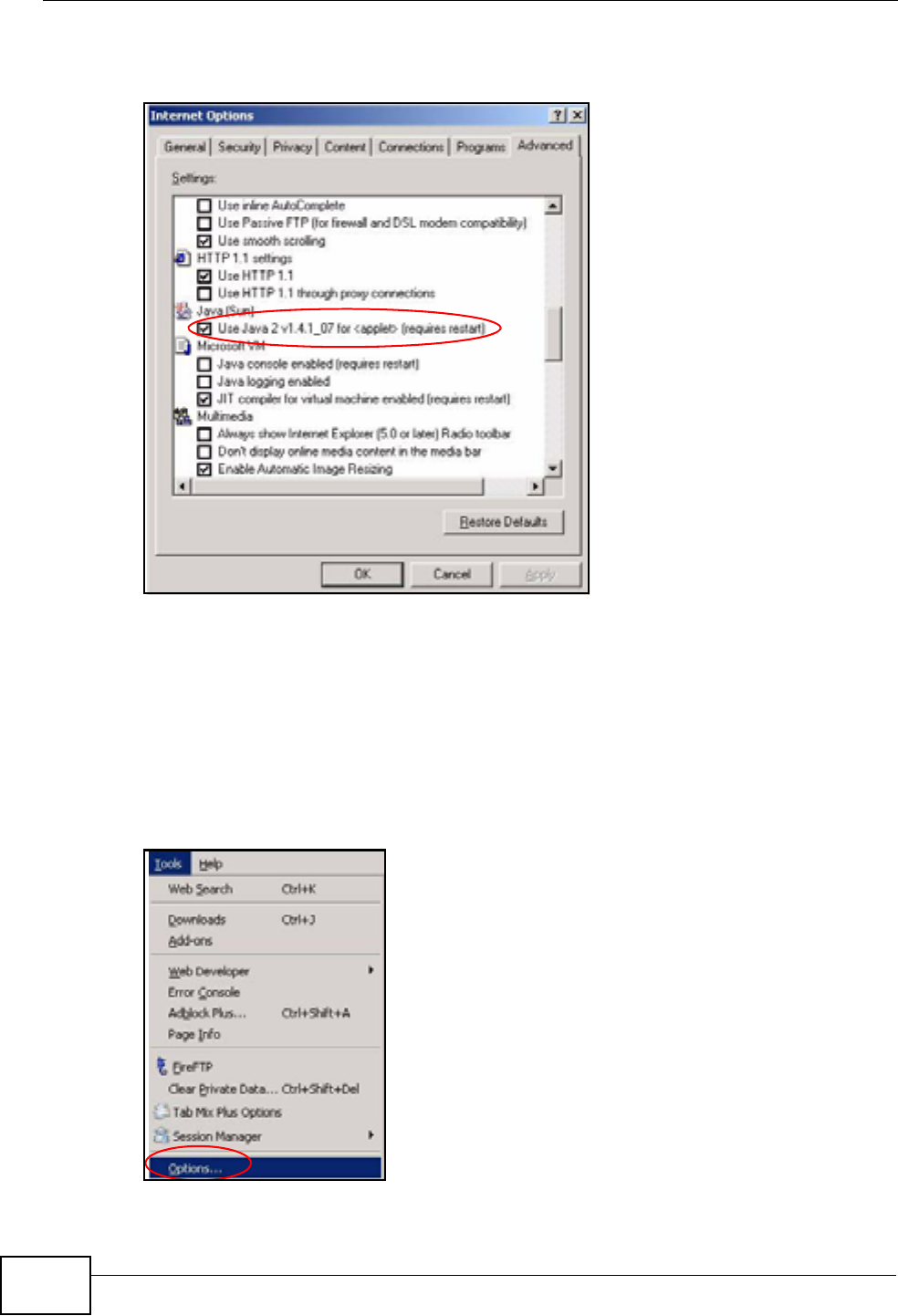
Appendix C Pop-up Windows, JavaScript and Java Permissions
HES-309M Series User’s Guide
186
3Click OK to close the window.
Figure 115 Java (Sun)
Mozilla Firefox
Mozilla Firefox 2.0 screens are used here. Screens for other versions may vary.
You can enable Java, Javascript and pop-ups in one screen. Click Tools, then click
Options in the screen that appears.
Figure 116 Mozilla Firefox: TOOLS > Options
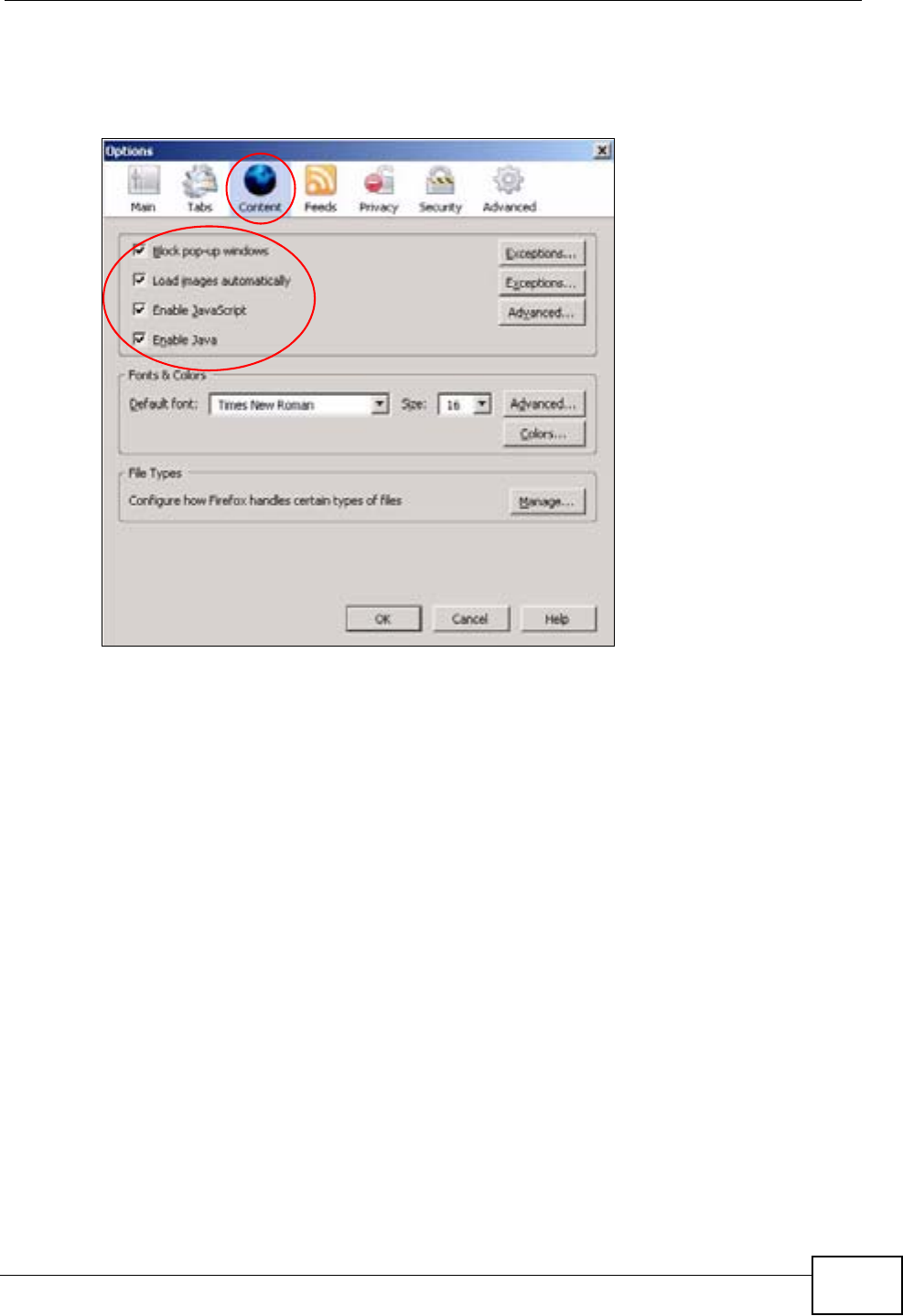
Appendix C Pop-up Windows, JavaScript and Java Permissions
HES-309M Series User’s Guide 187
Click Content.to show the screen below. Select the check boxes as shown in the
following screen.
Figure 117 Mozilla Firefox Content Security

Appendix C Pop-up Windows, JavaScript and Java Permissions
HES-309M Series User’s Guide
188

HES-309M Series User’s Guide 189
APPENDIX D
IP Addresses and Subnetting
This appendix introduces IP addresses and subnet masks.
IP addresses identify individual devices on a network. Every networking device
(including computers, servers, routers, printers, etc.) needs an IP address to
communicate across the network. These networking devices are also known as
hosts.
Subnet masks determine the maximum number of possible hosts on a network.
You can also use subnet masks to divide one network into multiple sub-networks.
Introduction to IP Addresses
One part of the IP address is the network number, and the other part is the host
ID. In the same way that houses on a street share a common street name, the
hosts on a network share a common network number. Similarly, as each house
has its own house number, each host on the network has its own unique
identifying number - the host ID. Routers use the network number to send packets
to the correct network, while the host ID determines to which host on the network
the packets are delivered.
Structure
An IP address is made up of four parts, written in dotted decimal notation (for
example, ). Each of these four parts is known as an octet. An octet is an eight-
digit binary number (for example 11000000, which is 192 in decimal notation).
Therefore, each octet has a possible range of 00000000 to 11111111 in binary, or
0 to 255 in decimal.
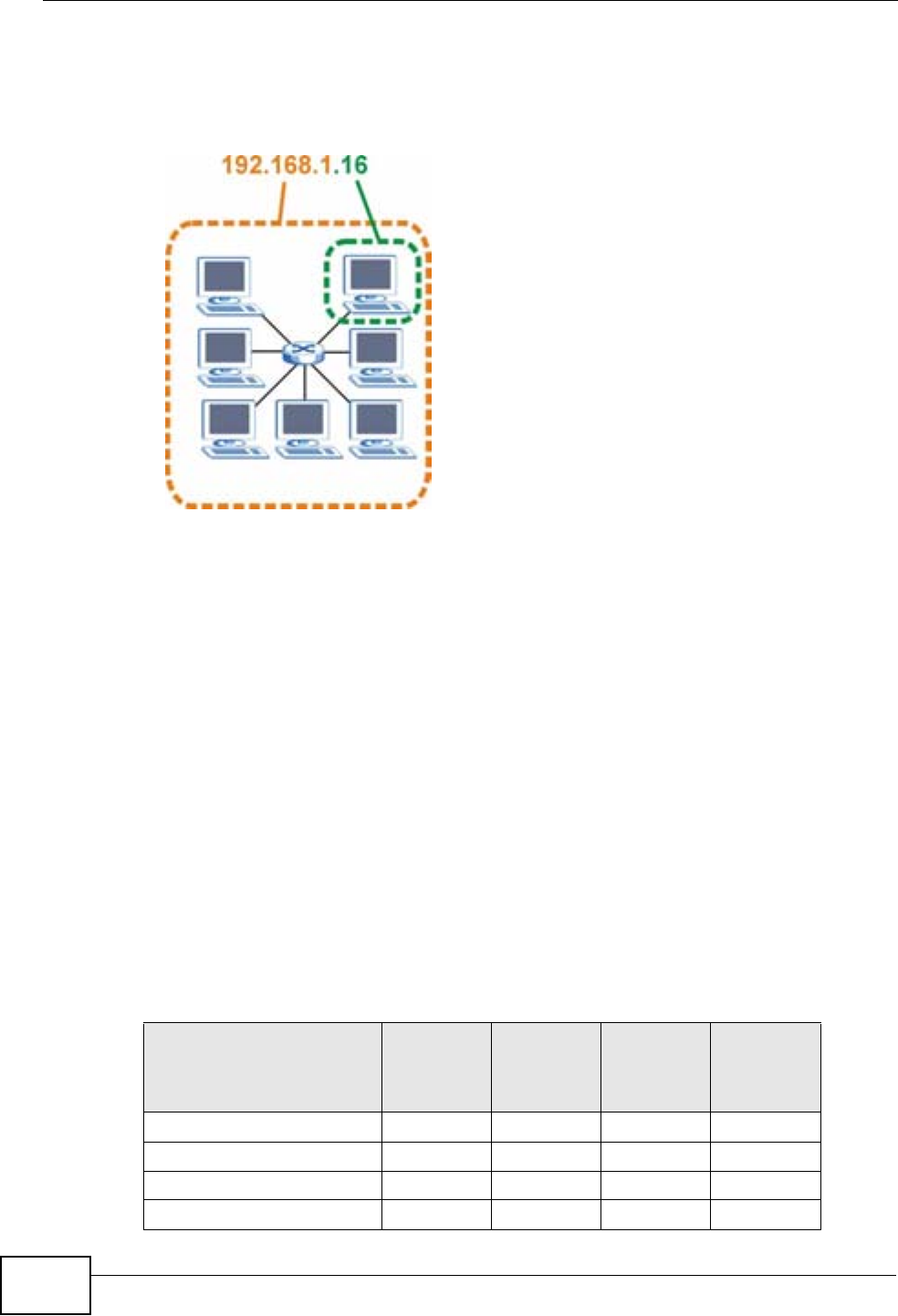
Appendix D IP Addresses and Subnetting
HES-309M Series User’s Guide
190
The following figure shows an example IP address in which the first three octets
(192.168.1) are the network number, and the fourth octet (16) is the host ID.
Figure 118 Network Number and Host ID
How much of the IP address is the network number and how much is the host ID
varies according to the subnet mask.
Subnet Masks
A subnet mask is used to determine which bits are part of the network number,
and which bits are part of the host ID (using a logical AND operation). The term
“subnet” is short for “sub-network”.
A subnet mask has 32 bits. If a bit in the subnet mask is a “1” then the
corresponding bit in the IP address is part of the network number. If a bit in the
subnet mask is “0” then the corresponding bit in the IP address is part of the host
ID.
The following example shows a subnet mask identifying the network number (in
bold text) and host ID of an IP address (192.168.1.2 in decimal).
Table 60 IP Address Network Number and Host ID Example
1ST
OCTET:
(192)
2ND
OCTET:
(168)
3RD
OCTET:
(1)
4TH
OCTET
(2)
IP Address (Binary) 11000000 10101000 00000001 00000010
Subnet Mask (Binary) 11111111 11111111 11111111 00000000
Network Number 11000000 10101000 00000001
Host ID 00000010

Appendix D IP Addresses and Subnetting
HES-309M Series User’s Guide 191
By convention, subnet masks always consist of a continuous sequence of ones
beginning from the leftmost bit of the mask, followed by a continuous sequence of
zeros, for a total number of 32 bits.
Subnet masks can be referred to by the size of the network number part (the bits
with a “1” value). For example, an “8-bit mask” means that the first 8 bits of the
mask are ones and the remaining 24 bits are zeroes.
Subnet masks are expressed in dotted decimal notation just like IP addresses. The
following examples show the binary and decimal notation for 8-bit, 16-bit, 24-bit
and 29-bit subnet masks.
Network Size
The size of the network number determines the maximum number of possible
hosts you can have on your network. The larger the number of network number
bits, the smaller the number of remaining host ID bits.
An IP address with host IDs of all zeros is the IP address of the network
(192.168.1.0 with a 24-bit subnet mask, for example). An IP address with host
IDs of all ones is the broadcast address for that network (192.168.1.255 with a
24-bit subnet mask, for example).
As these two IP addresses cannot be used for individual hosts, calculate the
maximum number of possible hosts in a network as follows:
Table 61 Subnet Masks
BINARY
DECIMAL
1ST
OCTET
2ND
OCTET
3RD
OCTET
4TH
OCTET
8-bit mask 11111111 00000000 00000000 00000000 255.0.0.0
16-bit
mask
11111111 11111111 00000000 00000000 255.255.0.0
24-bit
mask
11111111 11111111 11111111 00000000 255.255.255.0
29-bit
mask
11111111 11111111 11111111 11111000 255.255.255.24
8
Table 62 Maximum Host Numbers
SUBNET MASK HOST ID SIZE MAXIMUM NUMBER OF
HOSTS
8 bits 255.0.0.0 24 bits 224 – 2 16777214
16 bits 255.255.0.0 16 bits 216 – 2 65534
24 bits 255.255.255.0 8 bits 28 – 2 254
29 bits 255.255.255.2
48
3 bits 23 – 2 6

Appendix D IP Addresses and Subnetting
HES-309M Series User’s Guide
192
Notation
Since the mask is always a continuous number of ones beginning from the left,
followed by a continuous number of zeros for the remainder of the 32 bit mask,
you can simply specify the number of ones instead of writing the value of each
octet. This is usually specified by writing a “/” followed by the number of bits in
the mask after the address.
For example, 192.1.1.0 /25 is equivalent to saying 192.1.1.0 with subnet mask
255.255.255.128.
The following table shows some possible subnet masks using both notations.
Subnetting
You can use subnetting to divide one network into multiple sub-networks. In the
following example a network administrator creates two sub-networks to isolate a
group of servers from the rest of the company network for security reasons.
In this example, the company network address is 192.168.1.0. The first three
octets of the address (192.168.1) are the network number, and the remaining
octet is the host ID, allowing a maximum of 28 – 2 or 254 possible hosts.
Table 63 Alternative Subnet Mask Notation
SUBNET
MASK
ALTERNATIVE
NOTATION
LAST OCTET
(BINARY)
LAST OCTET
(DECIMAL)
255.255.255.0 /24 0000 0000 0
255.255.255.12
8
/25 1000 0000 128
255.255.255.19
2
/26 1100 0000 192
255.255.255.22
4
/27 1110 0000 224
255.255.255.24
0
/28 1111 0000 240
255.255.255.24
8
/29 1111 1000 248
255.255.255.25
2
/30 1111 1100 252
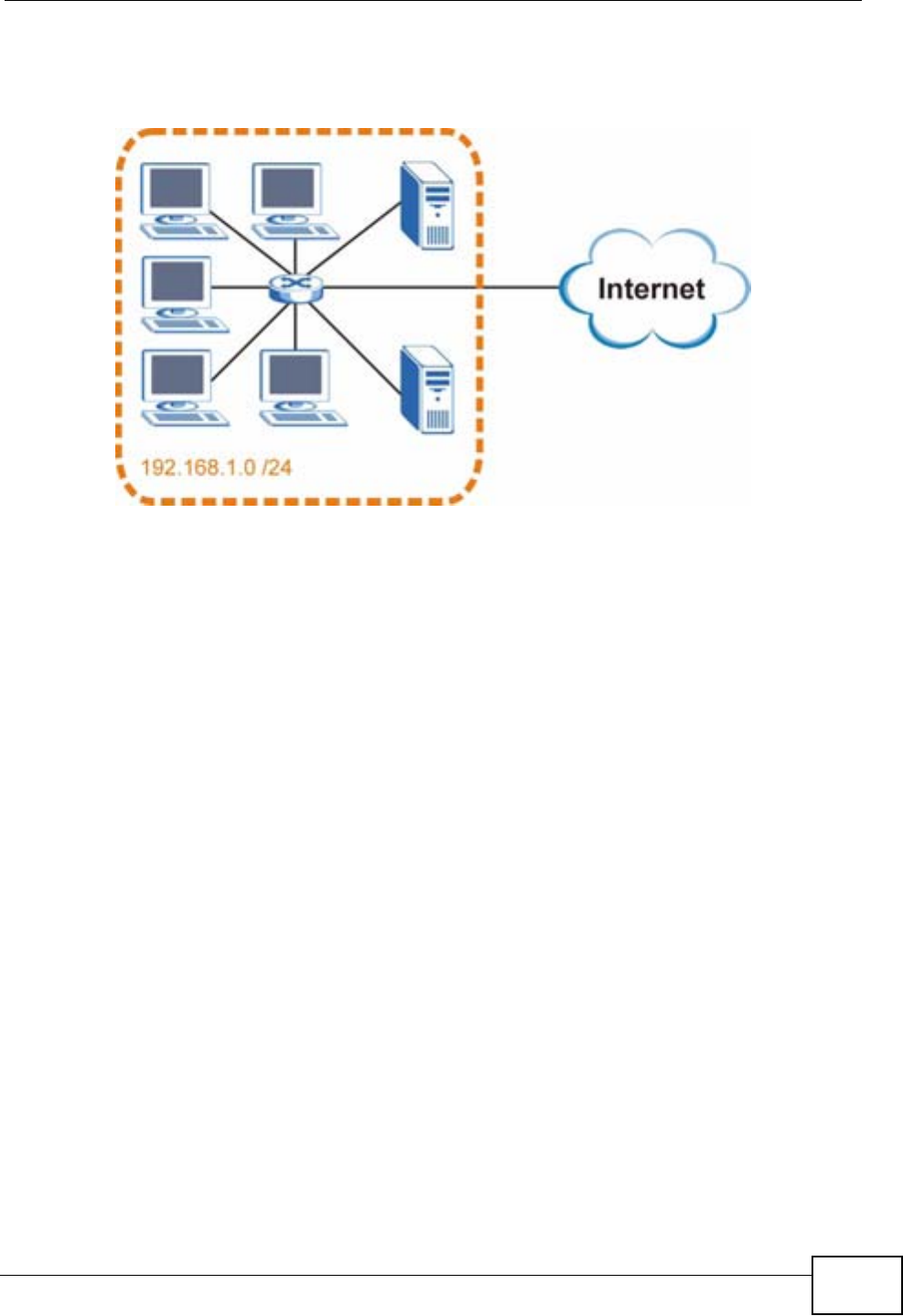
Appendix D IP Addresses and Subnetting
HES-309M Series User’s Guide 193
The following figure shows the company network before subnetting.
Figure 119 Subnetting Example: Before Subnetting
You can “borrow” one of the host ID bits to divide the network 192.168.1.0 into
two separate sub-networks. The subnet mask is now 25 bits (255.255.255.128 or
/25).
The “borrowed” host ID bit can have a value of either 0 or 1, allowing two
subnets; 192.168.1.0 /25 and 192.168.1.128 /25.
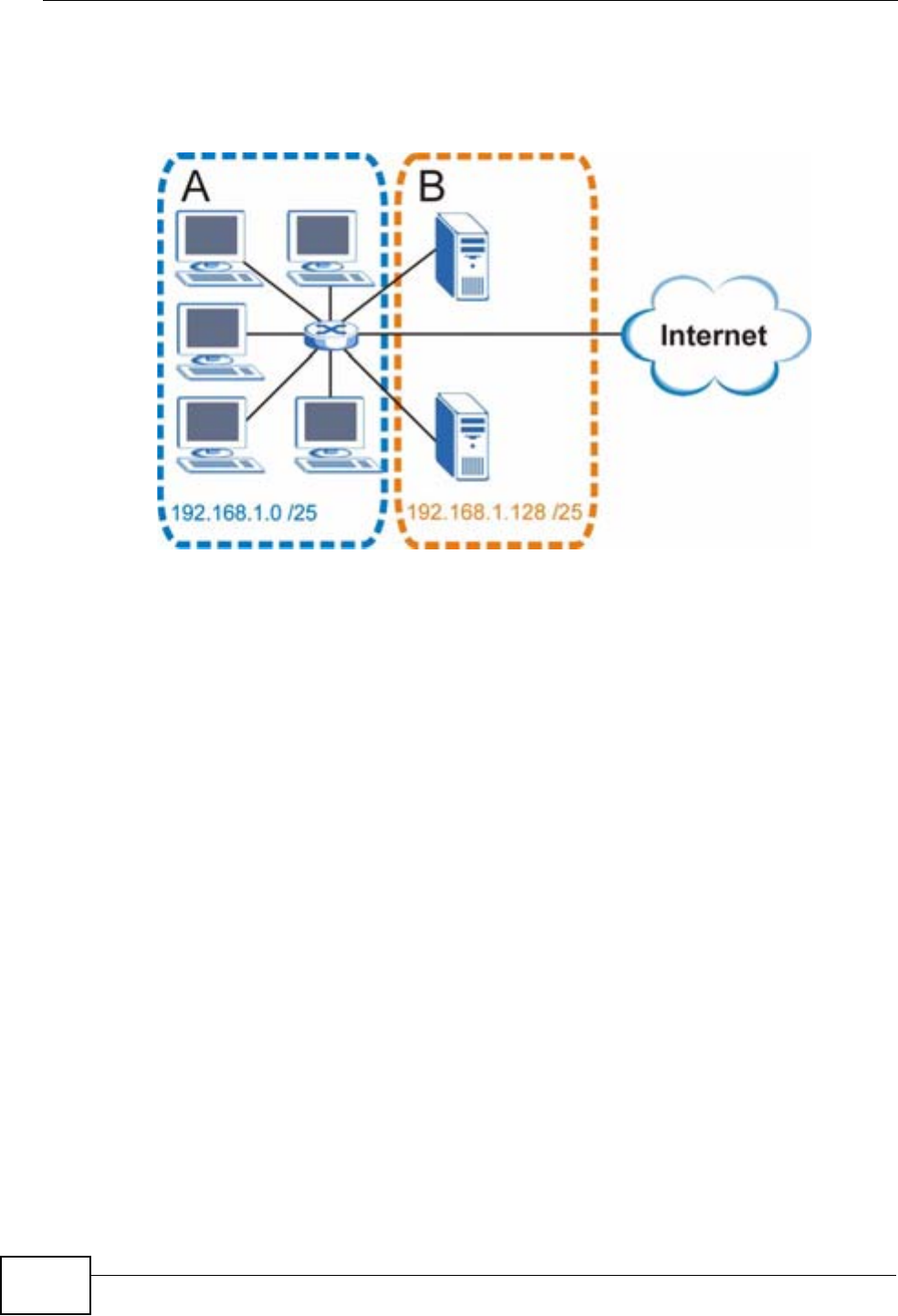
Appendix D IP Addresses and Subnetting
HES-309M Series User’s Guide
194
The following figure shows the company network after subnetting. There are now
two sub-networks, A and B.
Figure 120 Subnetting Example: After Subnetting
In a 25-bit subnet the host ID has 7 bits, so each sub-network has a maximum of
27 – 2 or 126 possible hosts (a host ID of all zeroes is the subnet’s address itself,
all ones is the subnet’s broadcast address).
192.168.1.0 with mask 255.255.255.128 is subnet A itself, and 192.168.1.127
with mask 255.255.255.128 is its broadcast address. Therefore, the lowest IP
address that can be assigned to an actual host for subnet A is 192.168.1.1 and
the highest is 192.168.1.126.
Similarly, the host ID range for subnet B is 192.168.1.129 to 192.168.1.254.
Example: Four Subnets
The previous example illustrated using a 25-bit subnet mask to divide a 24-bit
address into two subnets. Similarly, to divide a 24-bit address into four subnets,
you need to “borrow” two host ID bits to give four possible combinations (00, 01,
10 and 11). The subnet mask is 26 bits
(11111111.11111111.11111111.11000000) or 255.255.255.192.

Appendix D IP Addresses and Subnetting
HES-309M Series User’s Guide 195
Each subnet contains 6 host ID bits, giving 26 - 2 or 62 hosts for each subnet (a
host ID of all zeroes is the subnet itself, all ones is the subnet’s broadcast
address).
Table 64 Subnet 1
IP/SUBNET MASK NETWORK NUMBER LAST OCTET BIT
VALUE
IP Address (Decimal) 192.168.1. 0
IP Address (Binary) 11000000.10101000.00000001. 00000000
Subnet Mask (Binary) 11111111.11111111.11111111. 11000000
Subnet Address:
192.168.1.0
Lowest Host ID: 192.168.1.1
Broadcast Address:
192.168.1.63
Highest Host ID: 192.168.1.62
Table 65 Subnet 2
IP/SUBNET MASK NETWORK NUMBER LAST OCTET BIT
VALUE
IP Address 192.168.1. 64
IP Address (Binary) 11000000.10101000.00000001. 01000000
Subnet Mask (Binary) 11111111.11111111.11111111. 11000000
Subnet Address:
192.168.1.64
Lowest Host ID: 192.168.1.65
Broadcast Address:
192.168.1.127
Highest Host ID: 192.168.1.126
Table 66 Subnet 3
IP/SUBNET MASK NETWORK NUMBER LAST OCTET BIT
VALUE
IP Address 192.168.1. 128
IP Address (Binary) 11000000.10101000.00000001. 10000000
Subnet Mask (Binary) 11111111.11111111.11111111. 11000000
Subnet Address:
192.168.1.128
Lowest Host ID: 192.168.1.129
Broadcast Address:
192.168.1.191
Highest Host ID: 192.168.1.190
Table 67 Subnet 4
IP/SUBNET MASK NETWORK NUMBER LAST OCTET BIT
VALUE
IP Address 192.168.1. 192
IP Address (Binary) 11000000.10101000.00000001
.
11000000
Subnet Mask (Binary) 11111111.11111111.11111111
.
11000000

Appendix D IP Addresses and Subnetting
HES-309M Series User’s Guide
196
Example: Eight Subnets
Similarly, use a 27-bit mask to create eight subnets (000, 001, 010, 011, 100,
101, 110 and 111).
The following table shows IP address last octet values for each subnet.
Subnet Planning
The following table is a summary for subnet planning on a network with a 24-bit
network number.
Subnet Address:
192.168.1.192
Lowest Host ID: 192.168.1.193
Broadcast Address:
192.168.1.255
Highest Host ID: 192.168.1.254
Table 67 Subnet 4 (continued)
IP/SUBNET MASK NETWORK NUMBER LAST OCTET BIT
VALUE
Table 68 Eight Subnets
SUBNET SUBNET
ADDRESS FIRST ADDRESS LAST
ADDRESS
BROADCAST
ADDRESS
1 0 1 30 31
232 33 62 63
364 65 94 95
496 97 126 127
5128 129 158 159
6160 161 190 191
7192 193 222 223
8224 225 254 255
Table 69 24-bit Network Number Subnet Planning
NO. “BORROWED”
HOST BITS SUBNET MASK NO. SUBNETS NO. HOSTS PER
SUBNET
1255.255.255.128 (/25) 2126
2255.255.255.192 (/26) 462
3255.255.255.224 (/27) 830
4255.255.255.240 (/28) 16 14
5255.255.255.248 (/29) 32 6
6255.255.255.252 (/30) 64 2
7255.255.255.254 (/31) 128 1

Appendix D IP Addresses and Subnetting
HES-309M Series User’s Guide 197
The following table is a summary for subnet planning on a network with a 16-bit
network number.
Configuring IP Addresses
Where you obtain your network number depends on your particular situation. If
the ISP or your network administrator assigns you a block of registered IP
addresses, follow their instructions in selecting the IP addresses and the subnet
mask.
If the ISP did not explicitly give you an IP network number, then most likely you
have a single user account and the ISP will assign you a dynamic IP address when
the connection is established. If this is the case, it is recommended that you select
a network number from 192.168.0.0 to 192.168.255.0. The Internet Assigned
Number Authority (IANA) reserved this block of addresses specifically for private
use; please do not use any other number unless you are told otherwise. You must
also enable Network Address Translation (NAT) on the WiMAX Device.
Once you have decided on the network number, pick an IP address for your WiMAX
Device that is easy to remember (for instance, 192.168.1.1) but make sure that
no other device on your network is using that IP address.
The subnet mask specifies the network number portion of an IP address. Your
WiMAX Device will compute the subnet mask automatically based on the IP
Table 70 16-bit Network Number Subnet Planning
NO. “BORROWED”
HOST BITS SUBNET MASK NO. SUBNETS NO. HOSTS PER
SUBNET
1255.255.128.0 (/17) 232766
2255.255.192.0 (/18) 416382
3255.255.224.0 (/19) 88190
4255.255.240.0 (/20) 16 4094
5255.255.248.0 (/21) 32 2046
6255.255.252.0 (/22) 64 1022
7255.255.254.0 (/23) 128 510
8255.255.255.0 (/24) 256 254
9255.255.255.128 (/25) 512 126
10 255.255.255.192 (/26) 1024 62
11 255.255.255.224 (/27) 2048 30
12 255.255.255.240 (/28) 4096 14
13 255.255.255.248 (/29) 8192 6
14 255.255.255.252 (/30) 16384 2
15 255.255.255.254 (/31) 32768 1

Appendix D IP Addresses and Subnetting
HES-309M Series User’s Guide
198
address that you entered. You don't need to change the subnet mask computed by
the WiMAX Device unless you are instructed to do otherwise.
Private IP Addresses
Every machine on the Internet must have a unique address. If your networks are
isolated from the Internet (running only between two branch offices, for example)
you can assign any IP addresses to the hosts without problems. However, the
Internet Assigned Numbers Authority (IANA) has reserved the following three
blocks of IP addresses specifically for private networks:
• 10.0.0.0 — 10.255.255.255
• 172.16.0.0 — 172.31.255.255
• 192.168.0.0 — 192.168.255.255
You can obtain your IP address from the IANA, from an ISP, or it can be assigned
from a private network. If you belong to a small organization and your Internet
access is through an ISP, the ISP can provide you with the Internet addresses for
your local networks. On the other hand, if you are part of a much larger
organization, you should consult your network administrator for the appropriate IP
addresses.
Regardless of your particular situation, do not create an arbitrary IP address;
always follow the guidelines above. For more information on address assignment,
please refer to RFC 1597, Address Allocation for Private Internets and RFC 1466,
Guidelines for Management of IP Address Space.
IP Address Conflicts
Each device on a network must have a unique IP address. Devices with duplicate
IP addresses on the same network will not be able to access the Internet or other
resources. The devices may also be unreachable through the network.
Conflicting Computer IP Addresses Example
More than one device can not use the same IP address. In the following example
computer Ahas a static (or fixed) IP address that is the same as the IP address
that a DHCP server assigns to computer B which is a DHCP client. Neither can
access the Internet. This problem can be solved by assigning a different static IP
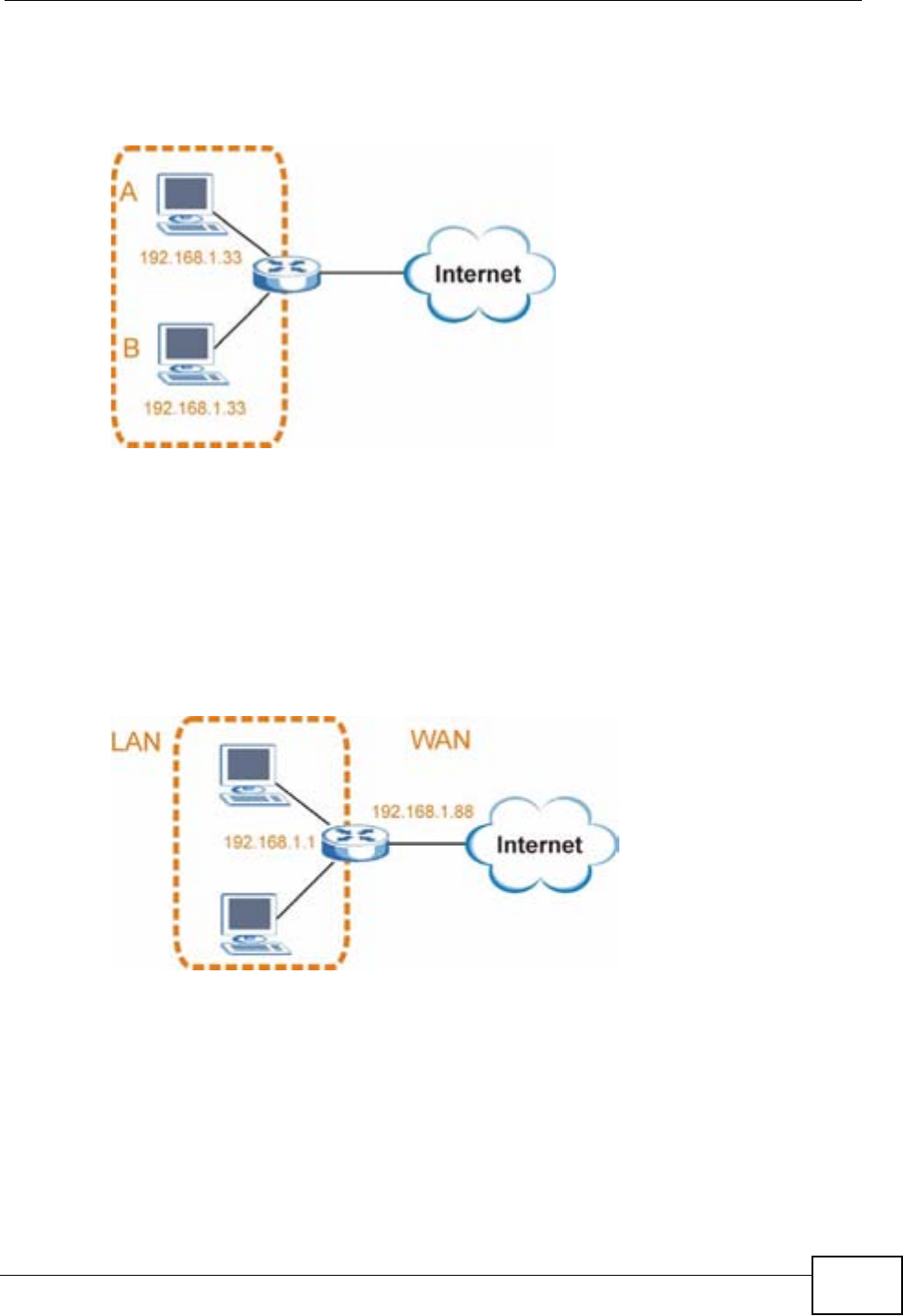
Appendix D IP Addresses and Subnetting
HES-309M Series User’s Guide 199
address to computer A or setting computer A to obtain an IP address
automatically.
Figure 121 Conflicting Computer IP Addresses Example
Conflicting Router IP Addresses Example
Since a router connects different networks, it must have interfaces using different
network numbers. For example, if a router is set between a LAN and the Internet
(WAN), the router’s LAN and WAN addresses must be on different subnets. In the
following example, the LAN and WAN are on the same subnet. The LAN computers
cannot access the Internet because the router cannot route between networks.
Figure 122 Conflicting Computer IP Addresses Example
Conflicting Computer and Router IP Addresses Example
More than one device can not use the same IP address. In the following example,
the computer and the router’s LAN port both use 192.168.1.1 as the IP address.
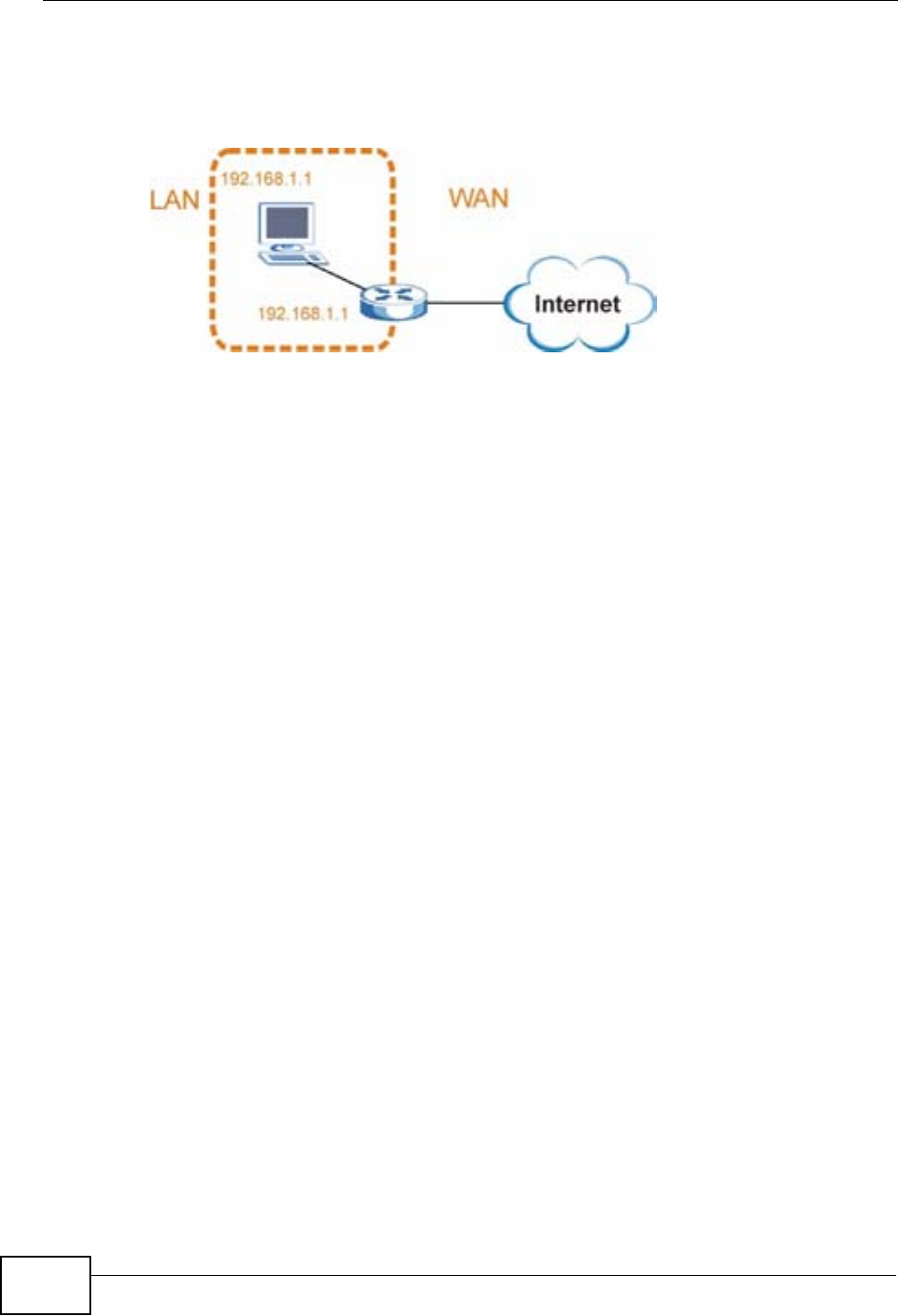
Appendix D IP Addresses and Subnetting
HES-309M Series User’s Guide
200
The computer cannot access the Internet. This problem can be solved by
assigning a different IP address to the computer or the router’s LAN port.
Figure 123 Conflicting Computer and Router IP Addresses Example

HES-309M Series User’s Guide 201
APPENDIX E
Importing Certificates
This appendix shows you how to import public key certificates into your web
browser.
Public key certificates are used by web browsers to ensure that a secure web site
is legitimate. When a certificate authority such as VeriSign, Comodo, or Network
Solutions, to name a few, receives a certificate request from a website operator,
they confirm that the web domain and contact information in the request match
those on public record with a domain name registrar. If they match, then the
certificate is issued to the website operator, who then places it on the site to be
issued to all visiting web browsers to let them know that the site is legitimate.
Many ZyXEL products, such as the NSA-2401, issue their own public key
certificates. These can be used by web browsers on a LAN or WAN to verify that
they are in fact connecting to the legitimate device and not one masquerading as
it. However, because the certificates were not issued by one of the several
organizations officially recognized by the most common web browsers, you will
need to import the ZyXEL-created certificate into your web browser and flag that
certificate as a trusted authority.
Note: You can see if you are browsing on a secure website if the URL in your web
browser’s address bar begins with https:// or there is a sealed padlock
icon ( ) somewhere in the main browser window (not all browsers show the
padlock in the same location.)
In this appendix, you can import a public key certificate for:
• Internet Explorer on page 202
•Firefox on page 212
•Opera on page 218
• Konqueror on page 226
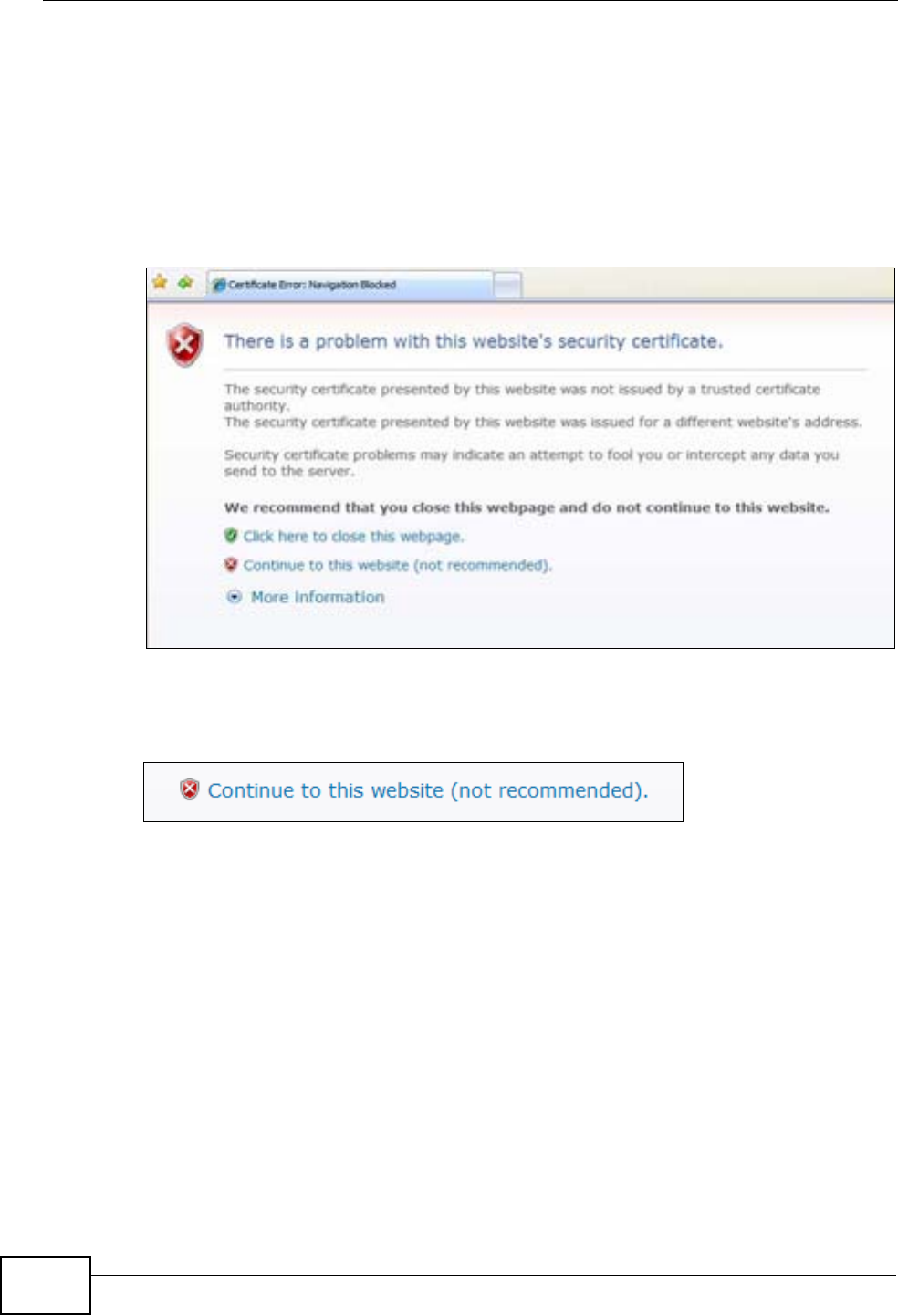
Appendix E Importing Certificates
HES-309M Series User’s Guide
202
Internet Explorer
The following example uses Microsoft Internet Explorer 7 on Windows XP
Professional; however, they can also apply to Internet Explorer on Windows Vista.
1If your device’s web configurator is set to use SSL certification, then the first time
you browse to it you are presented with a certification error.
Figure 124 Internet Explorer 7: Certification Error
2Click Continue to this website (not recommended).
Figure 125 Internet Explorer 7: Certification Error
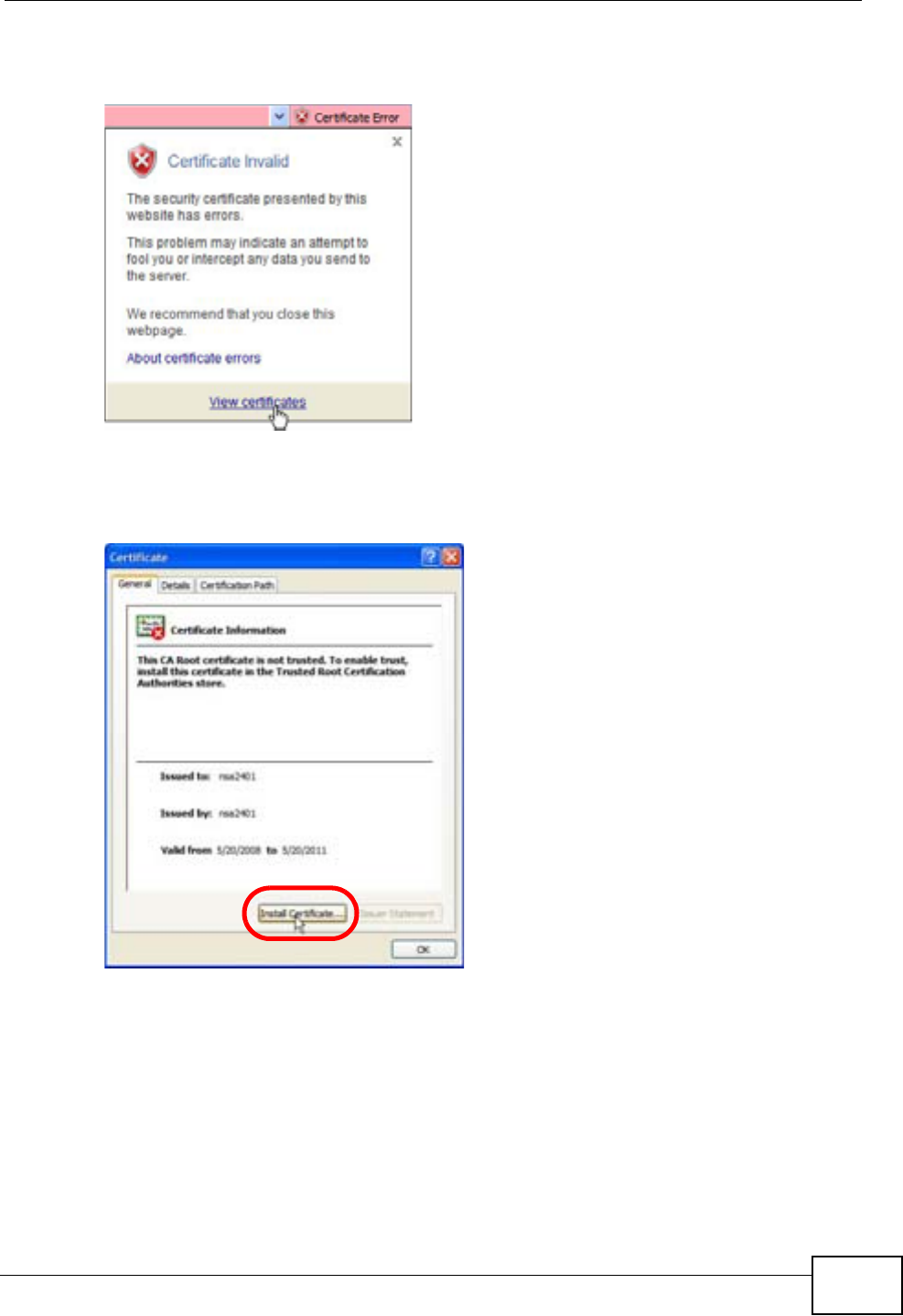
Appendix E Importing Certificates
HES-309M Series User’s Guide 203
3In the Address Bar, click Certificate Error > View certificates.
Figure 126 Internet Explorer 7: Certificate Error
4In the Certificate dialog box, click Install Certificate.
Figure 127 Internet Explorer 7: Certificate
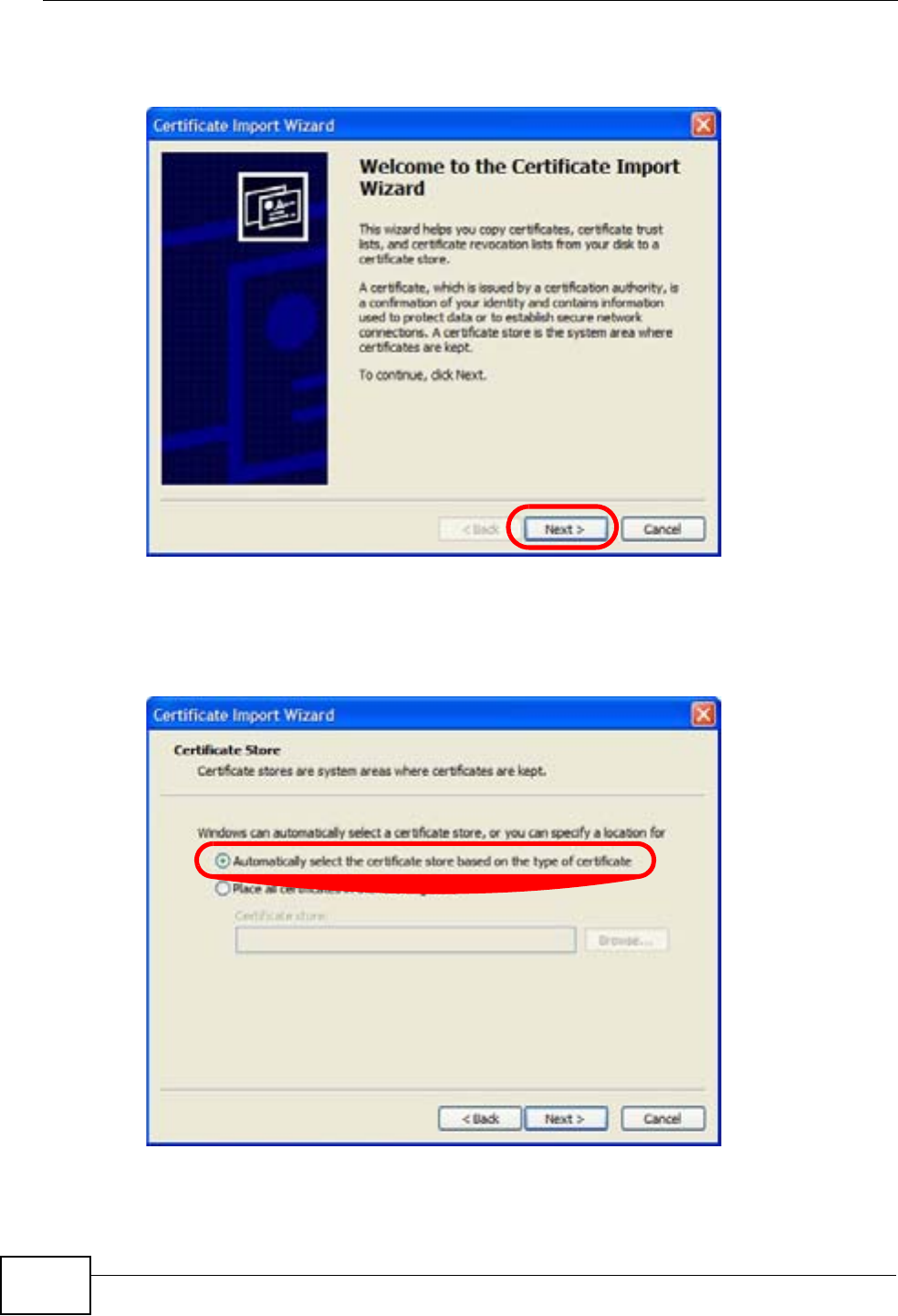
Appendix E Importing Certificates
HES-309M Series User’s Guide
204
5In the Certificate Import Wizard, click Next.
Figure 128 Internet Explorer 7: Certificate Import Wizard
6If you want Internet Explorer to Automatically select certificate store based
on the type of certificate, click Next again and then go to step 9.
Figure 129 Internet Explorer 7: Certificate Import Wizard
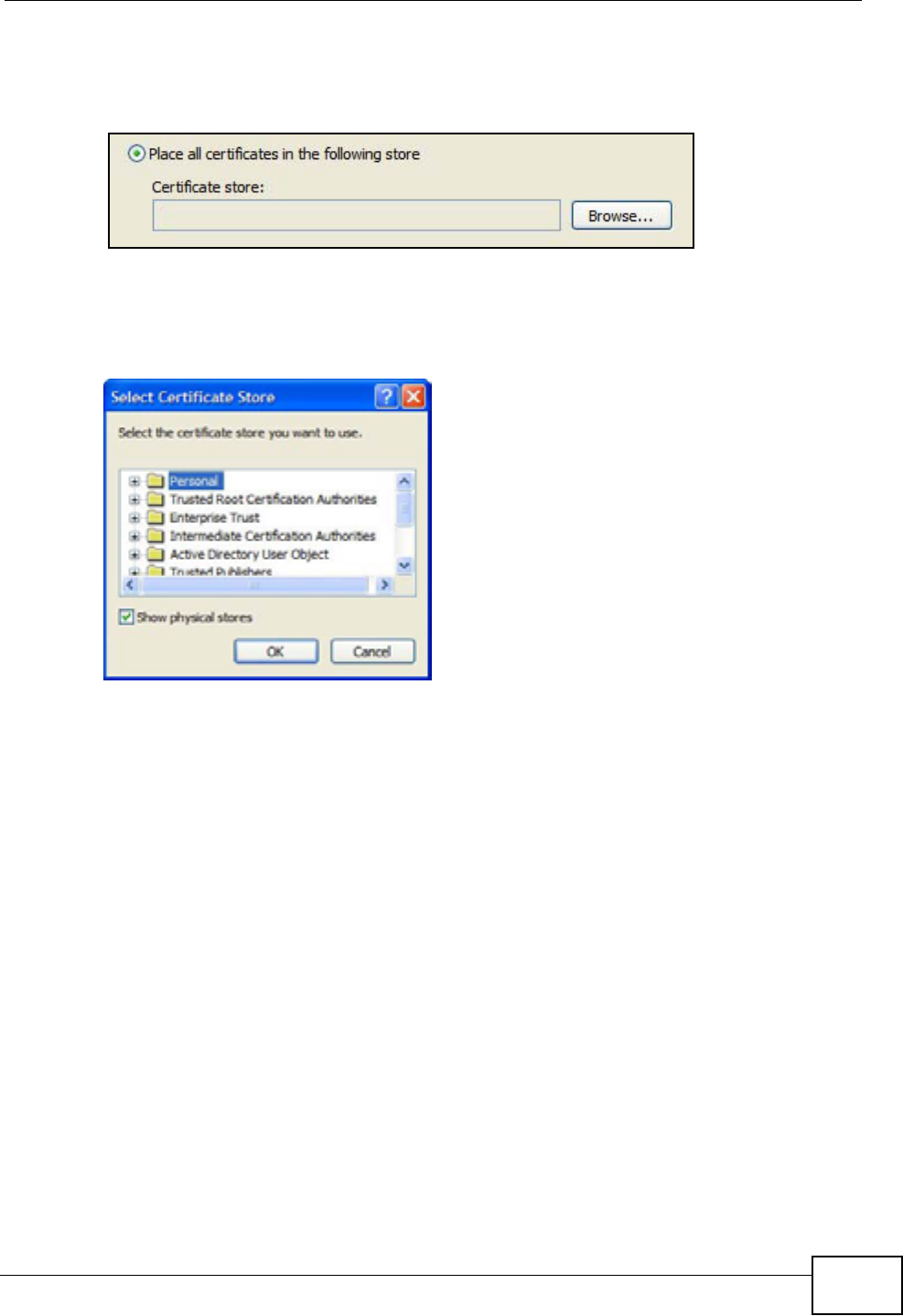
Appendix E Importing Certificates
HES-309M Series User’s Guide 205
7Otherwise, select Place all certificates in the following store and then click
Browse.
Figure 130 Internet Explorer 7: Certificate Import Wizard
8In the Select Certificate Store dialog box, choose a location in which to save the
certificate and then click OK.
Figure 131 Internet Explorer 7: Select Certificate Store
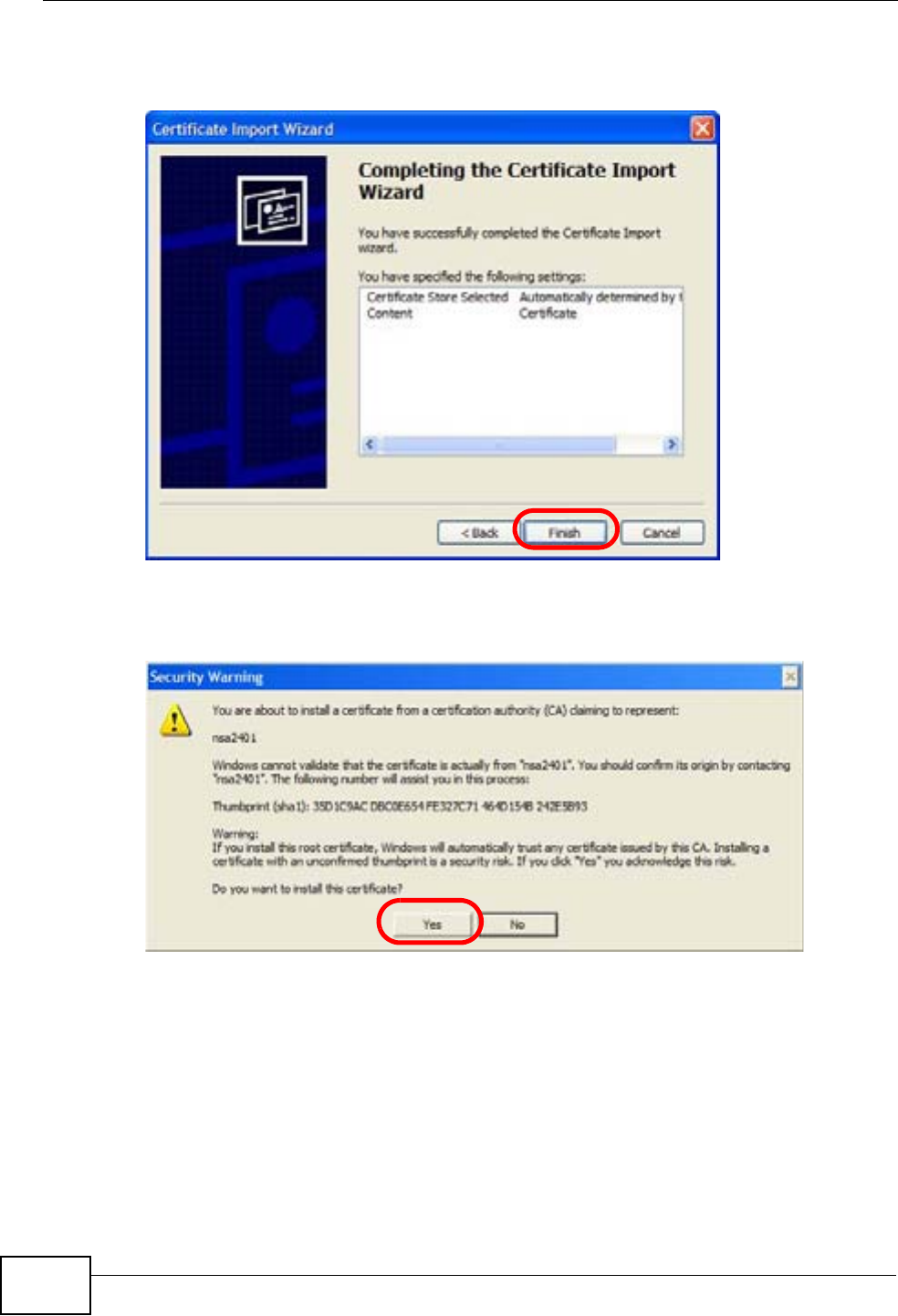
Appendix E Importing Certificates
HES-309M Series User’s Guide
206
9In the Completing the Certificate Import Wizard screen, click Finish.
Figure 132 Internet Explorer 7: Certificate Import Wizard
10 If you are presented with another Security Warning, click Yes.
Figure 133 Internet Explorer 7: Security Warning
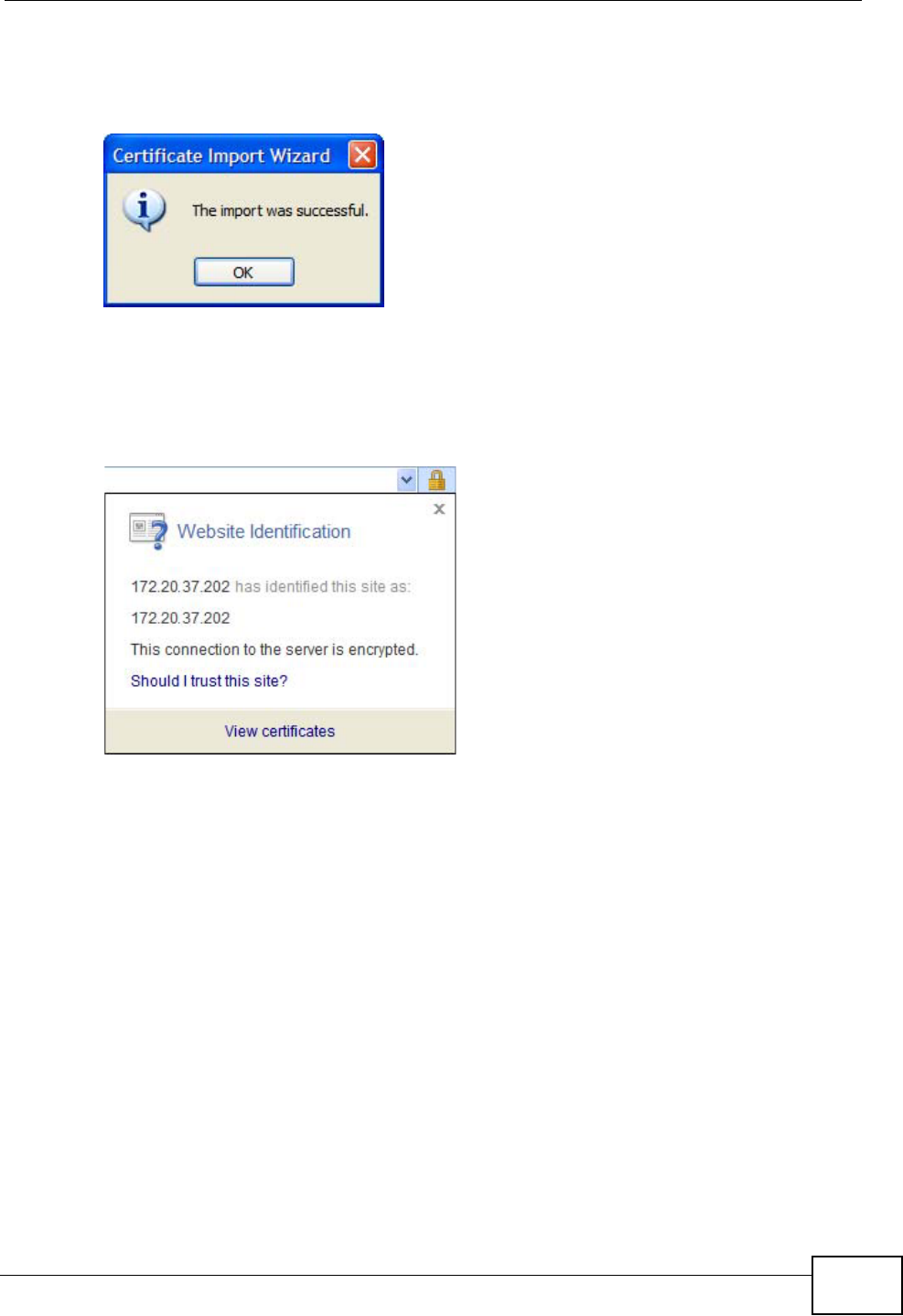
Appendix E Importing Certificates
HES-309M Series User’s Guide 207
11 Finally, click OK when presented with the successful certificate installation
message.
Figure 134 Internet Explorer 7: Certificate Import Wizard
12 The next time you start Internet Explorer and go to a ZyXEL web configurator
page, a sealed padlock icon appears in the address bar. Click it to view the page’s
Website Identification information.
Figure 135 Internet Explorer 7: Website Identification
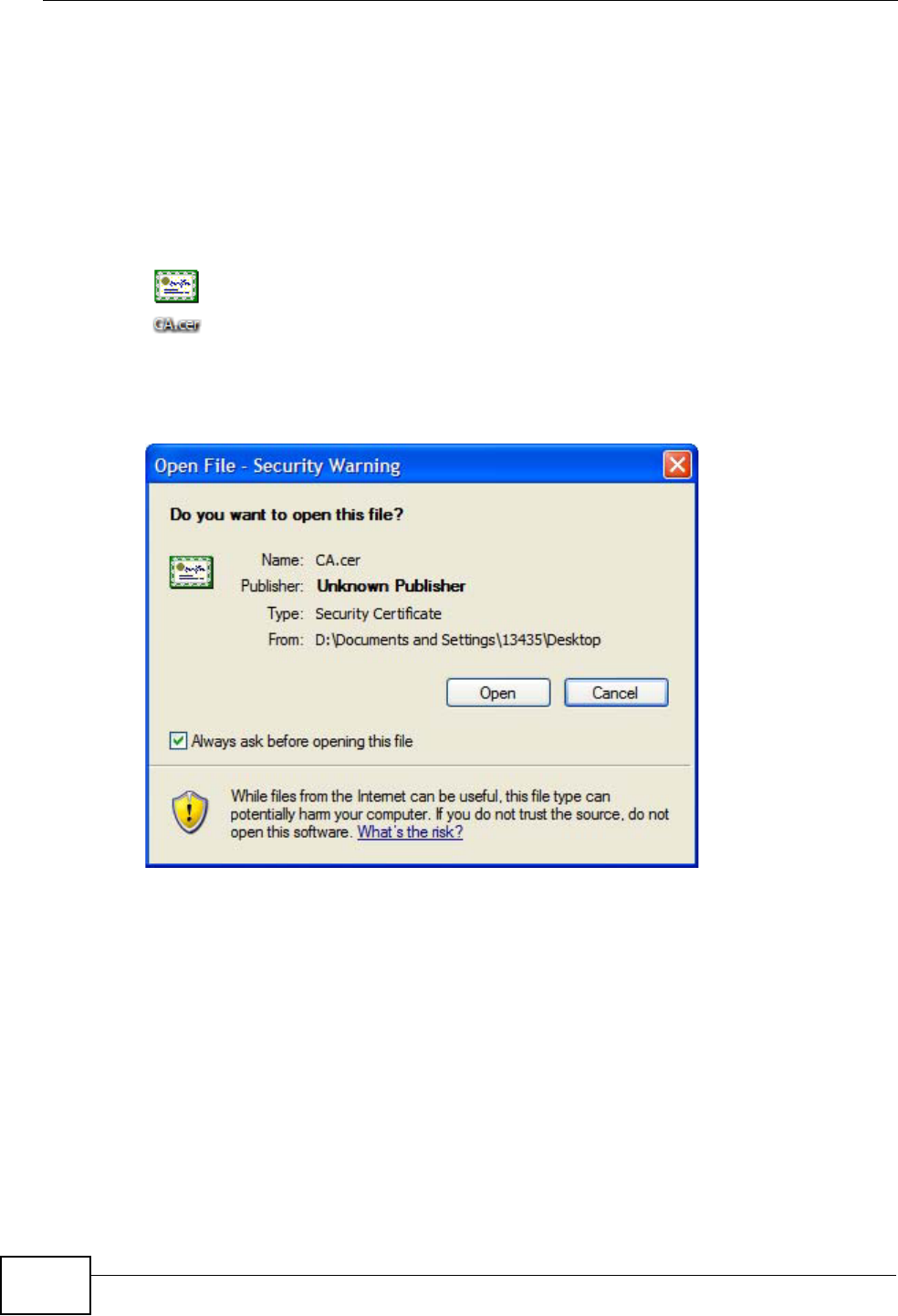
Appendix E Importing Certificates
HES-309M Series User’s Guide
208
Installing a Stand-Alone Certificate File in Internet Explorer
Rather than browsing to a ZyXEL web configurator and installing a public key
certificate when prompted, you can install a stand-alone certificate file if one has
been issued to you.
1Double-click the public key certificate file.
Figure 136 Internet Explorer 7: Public Key Certificate File
2In the security warning dialog box, click Open.
Figure 137 Internet Explorer 7: Open File - Security Warning
3Refer to steps 4-12 in the Internet Explorer procedure beginning on page 202 to
complete the installation process.
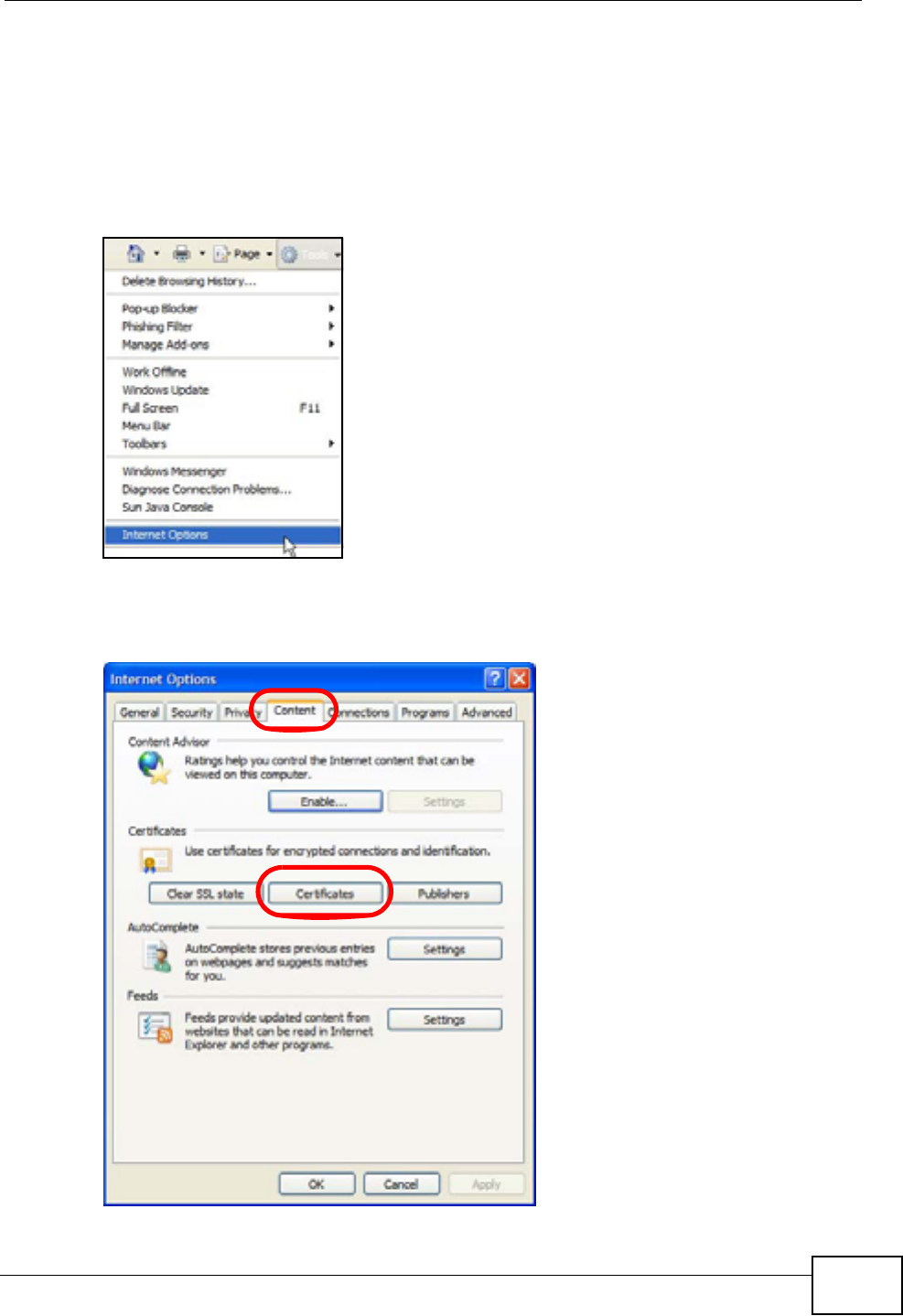
Appendix E Importing Certificates
HES-309M Series User’s Guide 209
Removing a Certificate in Internet Explorer
This section shows you how to remove a public key certificate in Internet Explorer
7.
1Open Internet Explorer and click TOOLS > Internet Options.
Figure 138 Internet Explorer 7: Tools Menu
2In the Internet Options dialog box, click Content >Certificates.
Figure 139 Internet Explorer 7: Internet Options
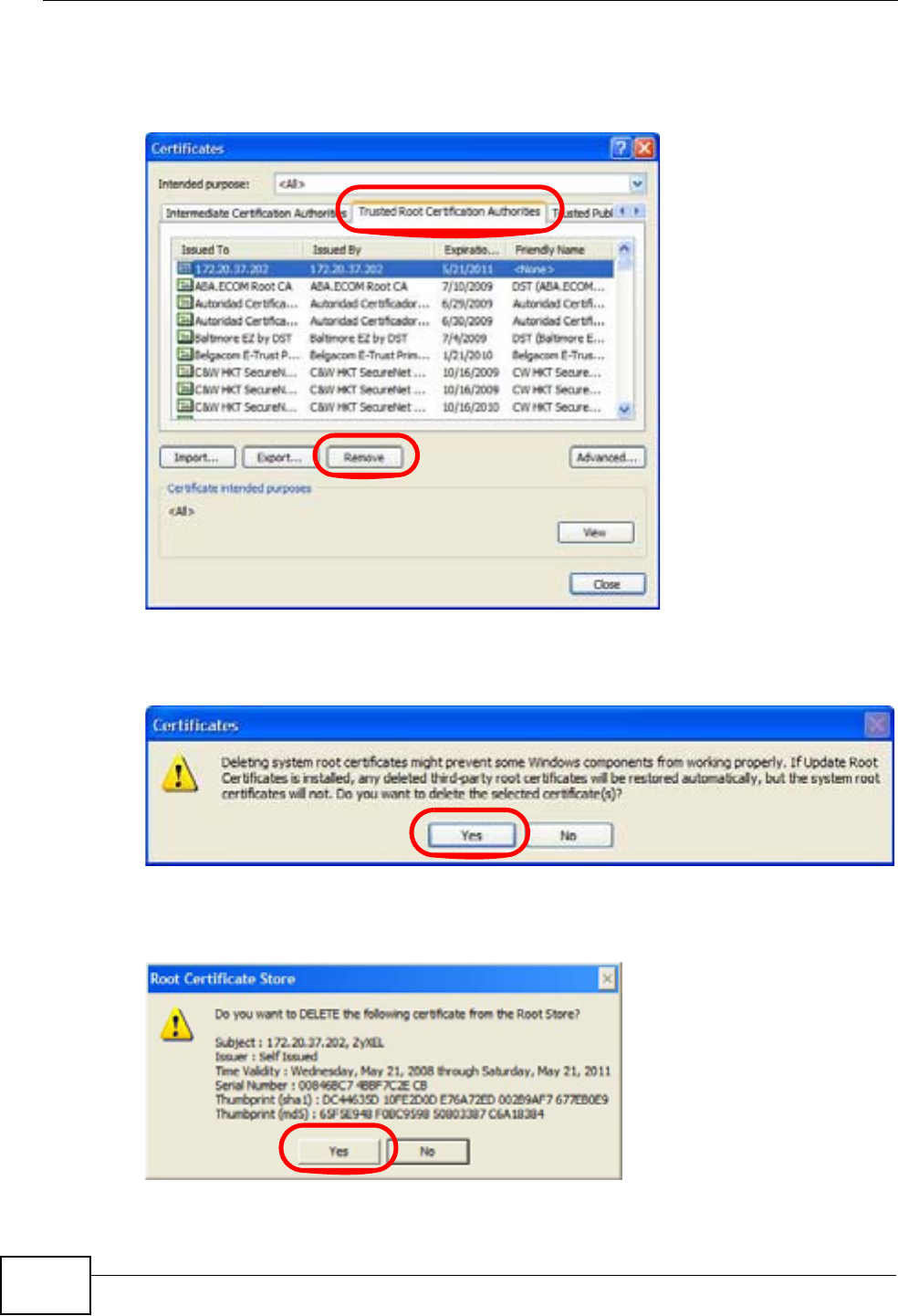
Appendix E Importing Certificates
HES-309M Series User’s Guide
210
3In the Certificates dialog box, click the Trusted Root Certificates Authorities
tab, select the certificate that you want to delete, and then click Remove.
Figure 140 Internet Explorer 7: Certificates
4In the Certificates confirmation, click Yes.
Figure 141 Internet Explorer 7: Certificates
5In the Root Certificate Store dialog box, click Yes.
Figure 142 Internet Explorer 7: Root Certificate Store

Appendix E Importing Certificates
HES-309M Series User’s Guide 211
6The next time you go to the web site that issued the public key certificate you just
removed, a certification error appears.
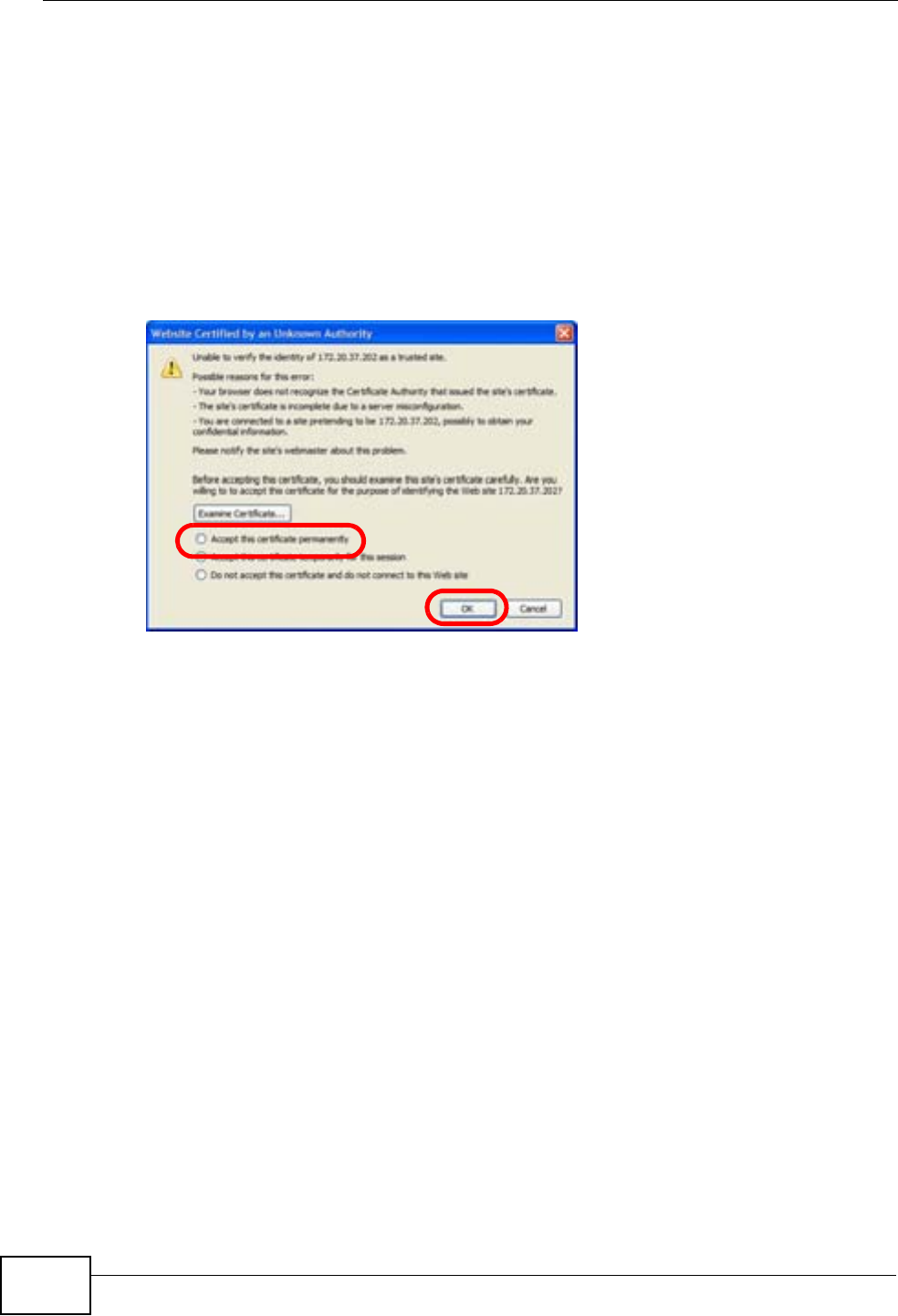
Appendix E Importing Certificates
HES-309M Series User’s Guide
212
Firefox
The following example uses Mozilla Firefox 2 on Windows XP Professional;
however, the screens can also apply to Firefox 2 on all platforms.
1If your device’s web configurator is set to use SSL certification, then the first time
you browse to it you are presented with a certification error.
2Select Accept this certificate permanently and click OK.
Figure 143 Firefox 2: Website Certified by an Unknown Authority
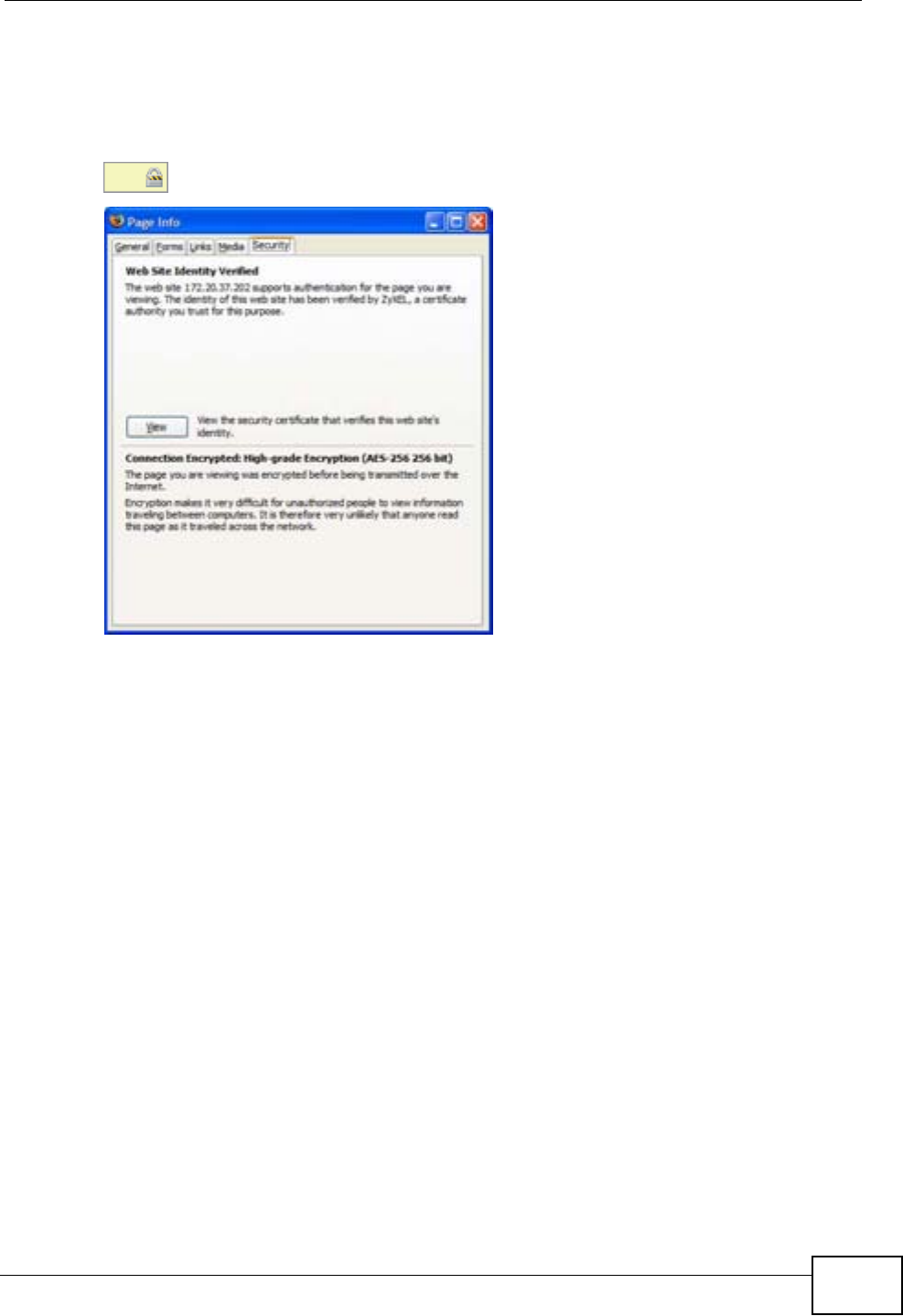
Appendix E Importing Certificates
HES-309M Series User’s Guide 213
3The certificate is stored and you can now connect securely to the web configurator.
A sealed padlock appears in the address bar, which you can click to open the Page
Info > Security window to view the web page’s security information.
Figure 144 Firefox 2: Page Info
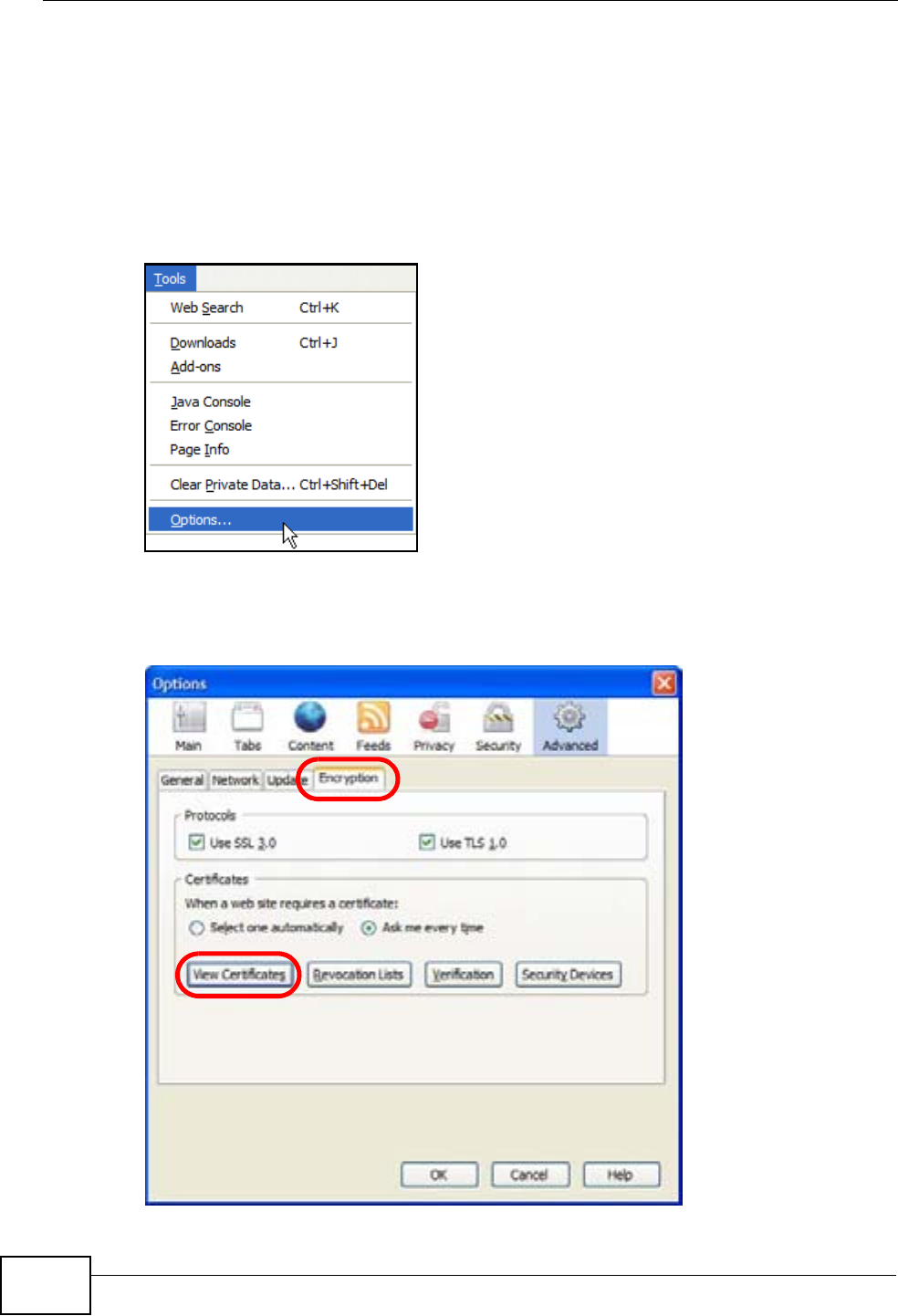
Appendix E Importing Certificates
HES-309M Series User’s Guide
214
Installing a Stand-Alone Certificate File in Firefox
Rather than browsing to a ZyXEL web configurator and installing a public key
certificate when prompted, you can install a stand-alone certificate file if one has
been issued to you.
1Open Firefox and click TOOLS > Options.
Figure 145 Firefox 2: Tools Menu
2In the Options dialog box, click ADVANCED > Encryption > View Certificates.
Figure 146 Firefox 2: Options
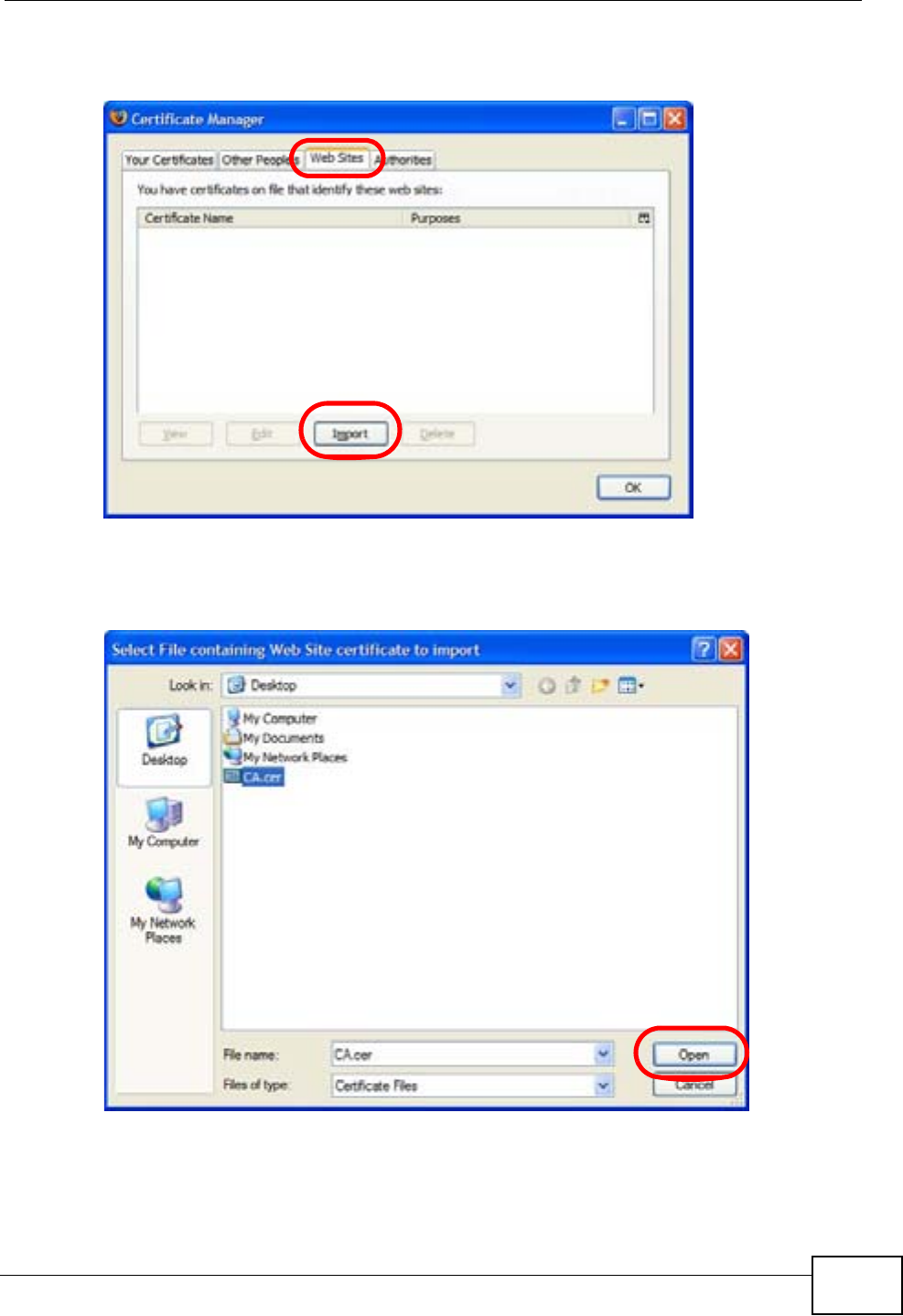
Appendix E Importing Certificates
HES-309M Series User’s Guide 215
3In the Certificate Manager dialog box, click Web Sites > Import.
Figure 147 Firefox 2: Certificate Manager
4Use the Select File dialog box to locate the certificate and then click Open.
Figure 148 Firefox 2: Select File
5The next time you visit the web site, click the padlock in the address bar to open
the Page Info > Security window to see the web page’s security information.
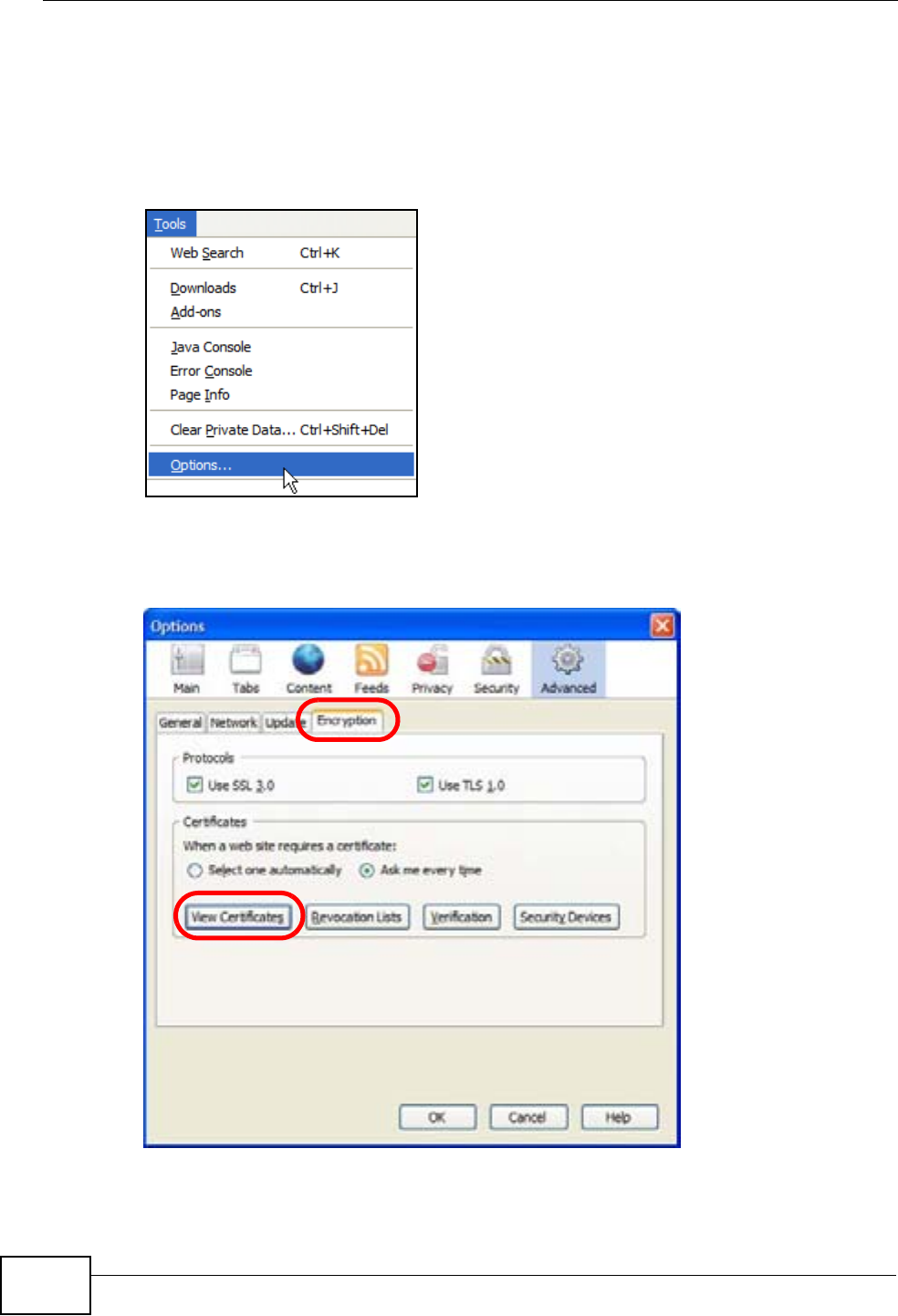
Appendix E Importing Certificates
HES-309M Series User’s Guide
216
Removing a Certificate in Firefox
This section shows you how to remove a public key certificate in Firefox 2.
1Open Firefox and click TOOLS > Options.
Figure 149 Firefox 2: Tools Menu
2In the Options dialog box, click ADVANCED > Encryption > View Certificates.
Figure 150 Firefox 2: Options
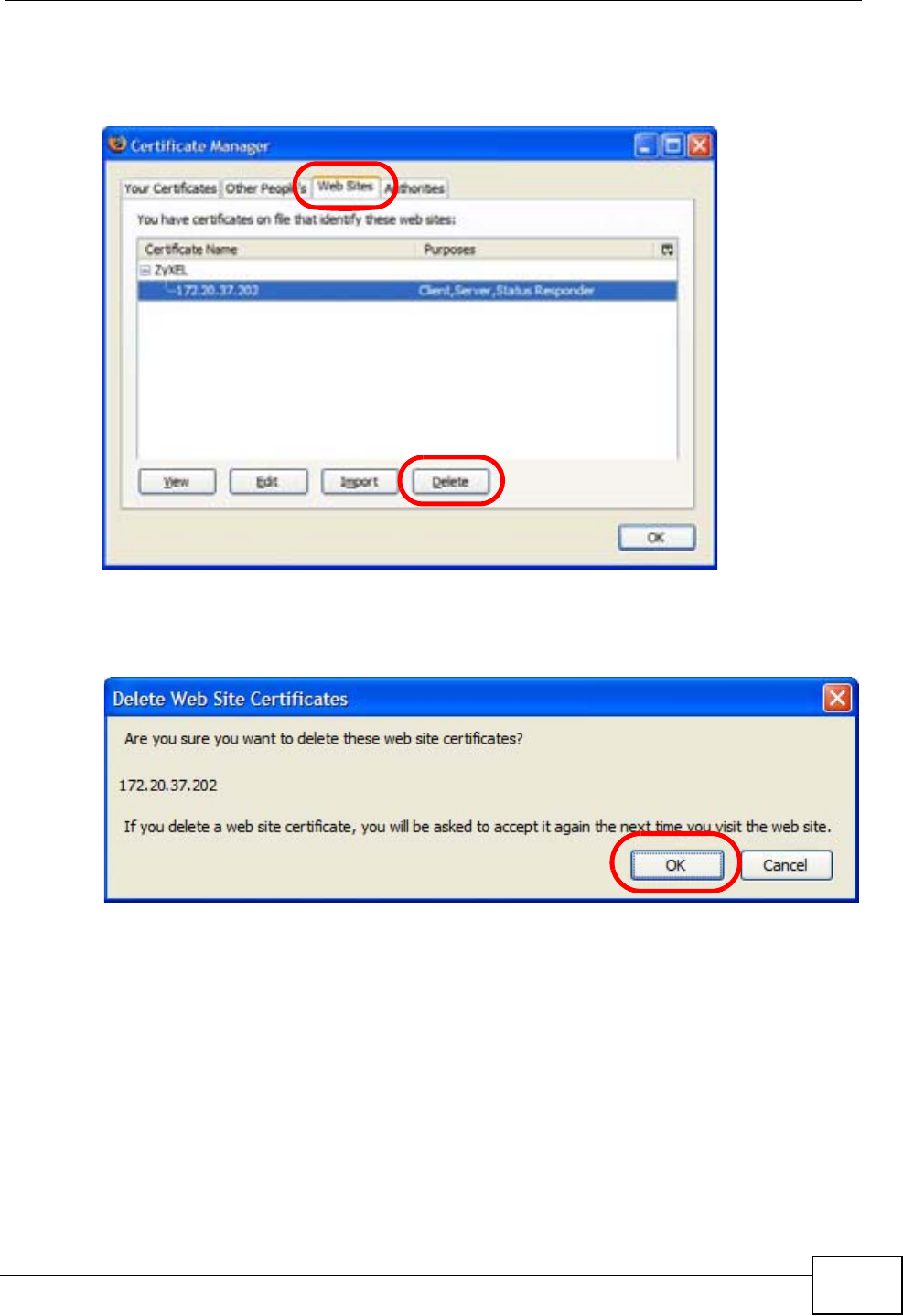
Appendix E Importing Certificates
HES-309M Series User’s Guide 217
3In the Certificate Manager dialog box, select the Web Sites tab, select the
certificate that you want to remove, and then click Delete.
Figure 151 Firefox 2: Certificate Manager
4In the Delete Web Site Certificates dialog box, click OK.
Figure 152 Firefox 2: Delete Web Site Certificates
5The next time you go to the web site that issued the public key certificate you just
removed, a certification error appears.
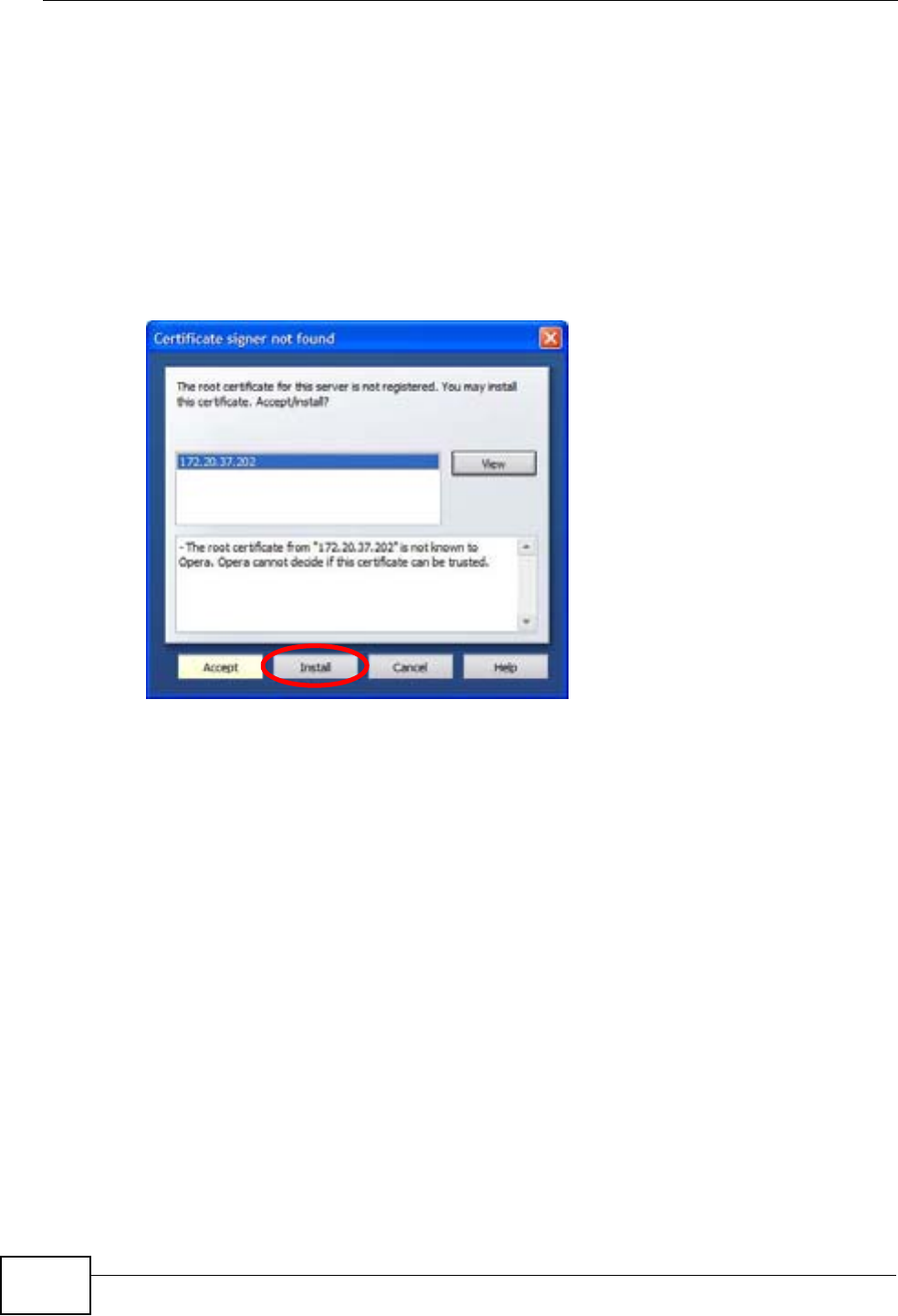
Appendix E Importing Certificates
HES-309M Series User’s Guide
218
Opera
The following example uses Opera 9 on Windows XP Professional; however, the
screens can apply to Opera 9 on all platforms.
1If your device’s web configurator is set to use SSL certification, then the first time
you browse to it you are presented with a certification error.
2Click Install to accept the certificate.
Figure 153 Opera 9: Certificate signer not found
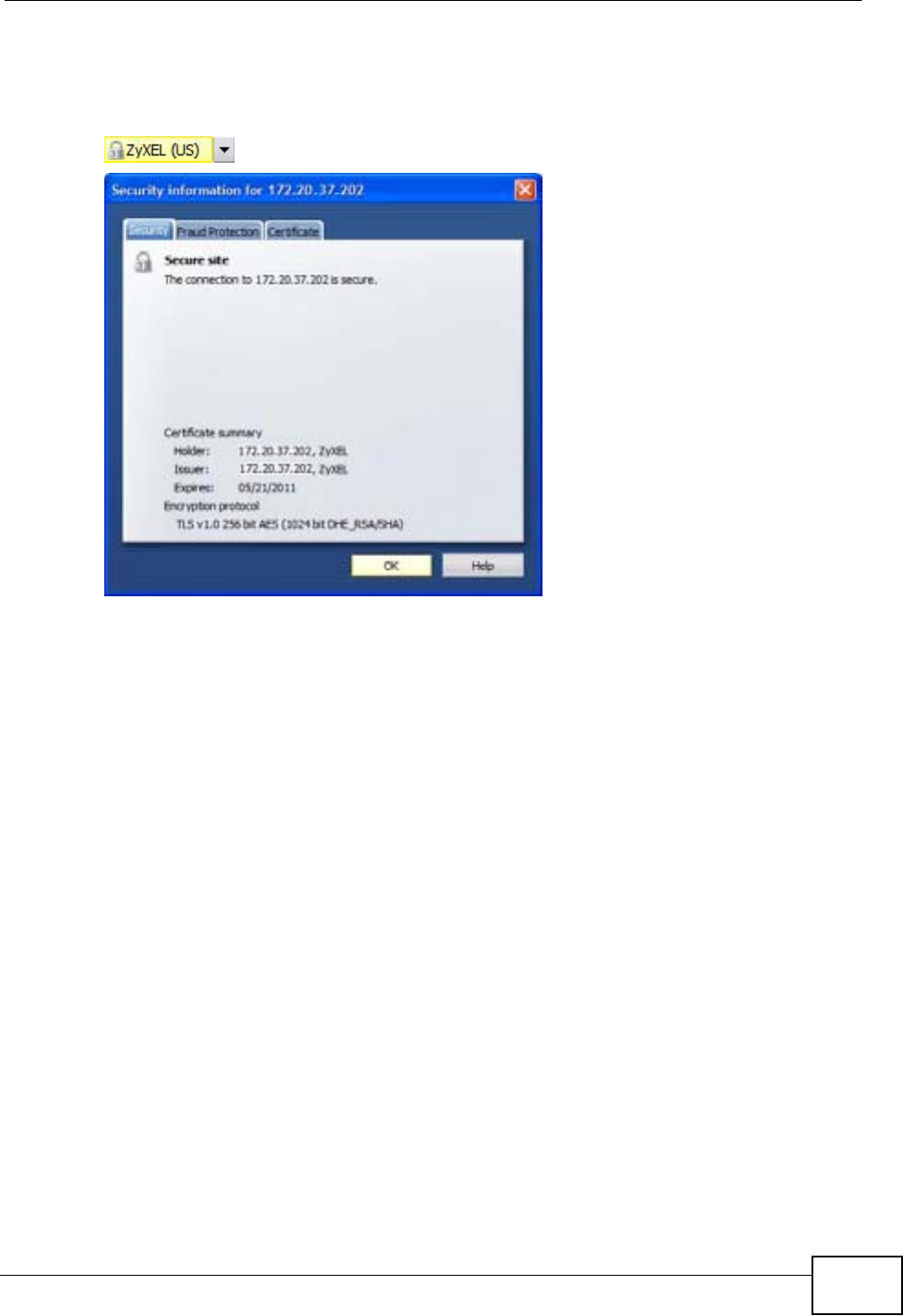
Appendix E Importing Certificates
HES-309M Series User’s Guide 219
3The next time you visit the web site, click the padlock in the address bar to open
the Security information window to view the web page’s security details.
Figure 154 Opera 9: Security information
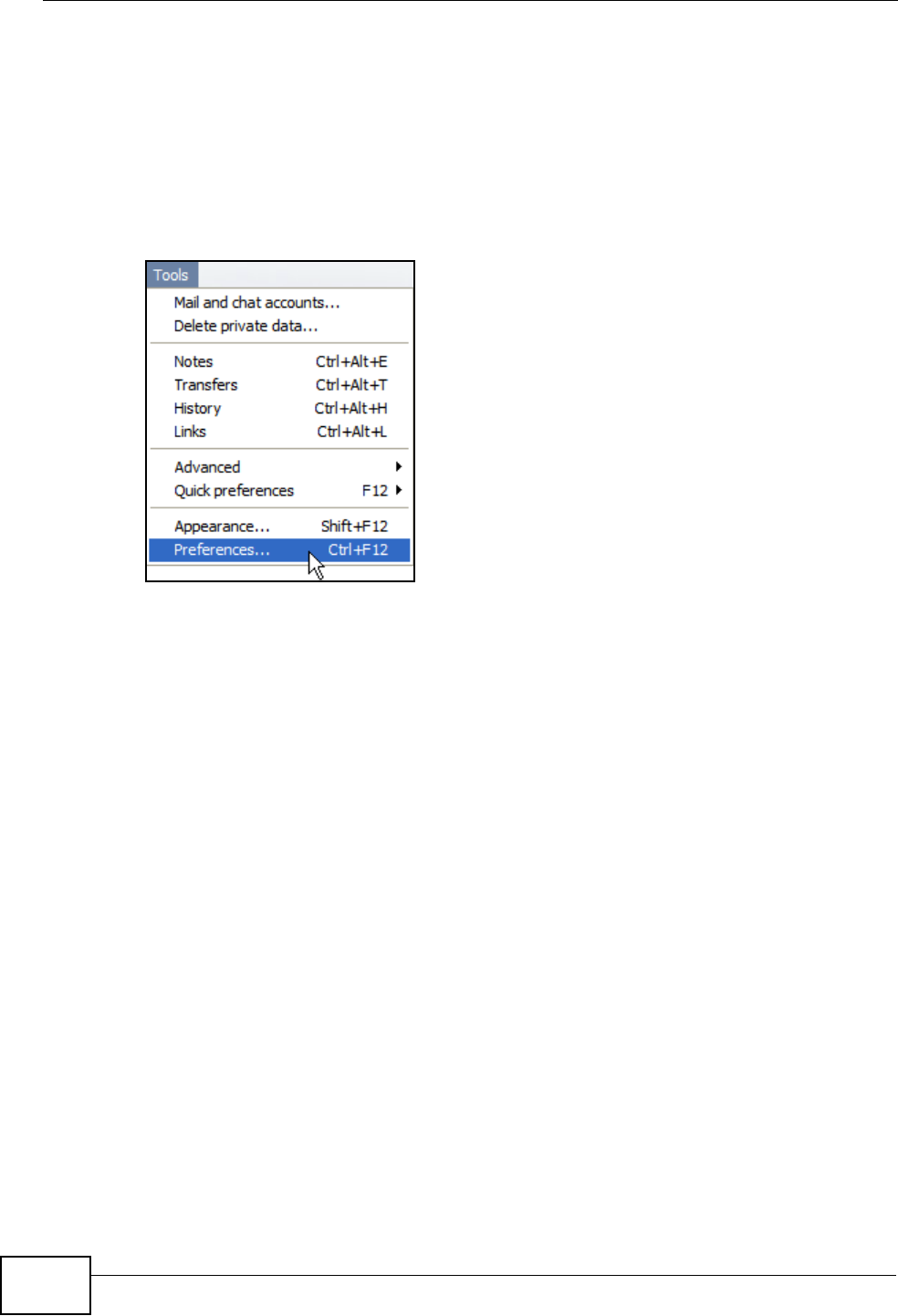
Appendix E Importing Certificates
HES-309M Series User’s Guide
220
Installing a Stand-Alone Certificate File in Opera
Rather than browsing to a ZyXEL web configurator and installing a public key
certificate when prompted, you can install a stand-alone certificate file if one has
been issued to you.
1Open Opera and click TOOLS > Preferences.
Figure 155 Opera 9: Tools Menu
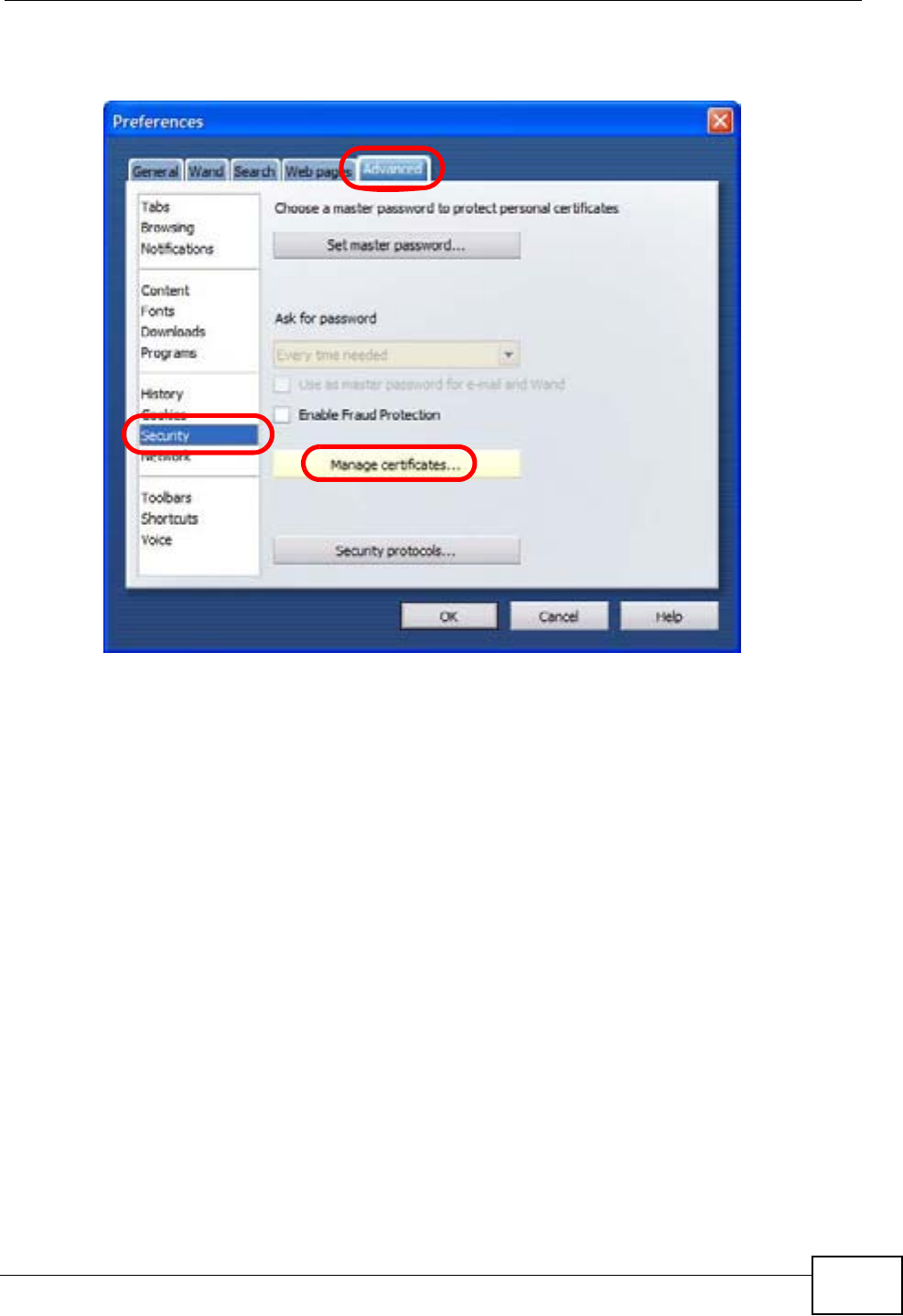
Appendix E Importing Certificates
HES-309M Series User’s Guide 221
2In Preferences, click ADVANCED > Security > Manage certificates.
Figure 156 Opera 9: Preferences
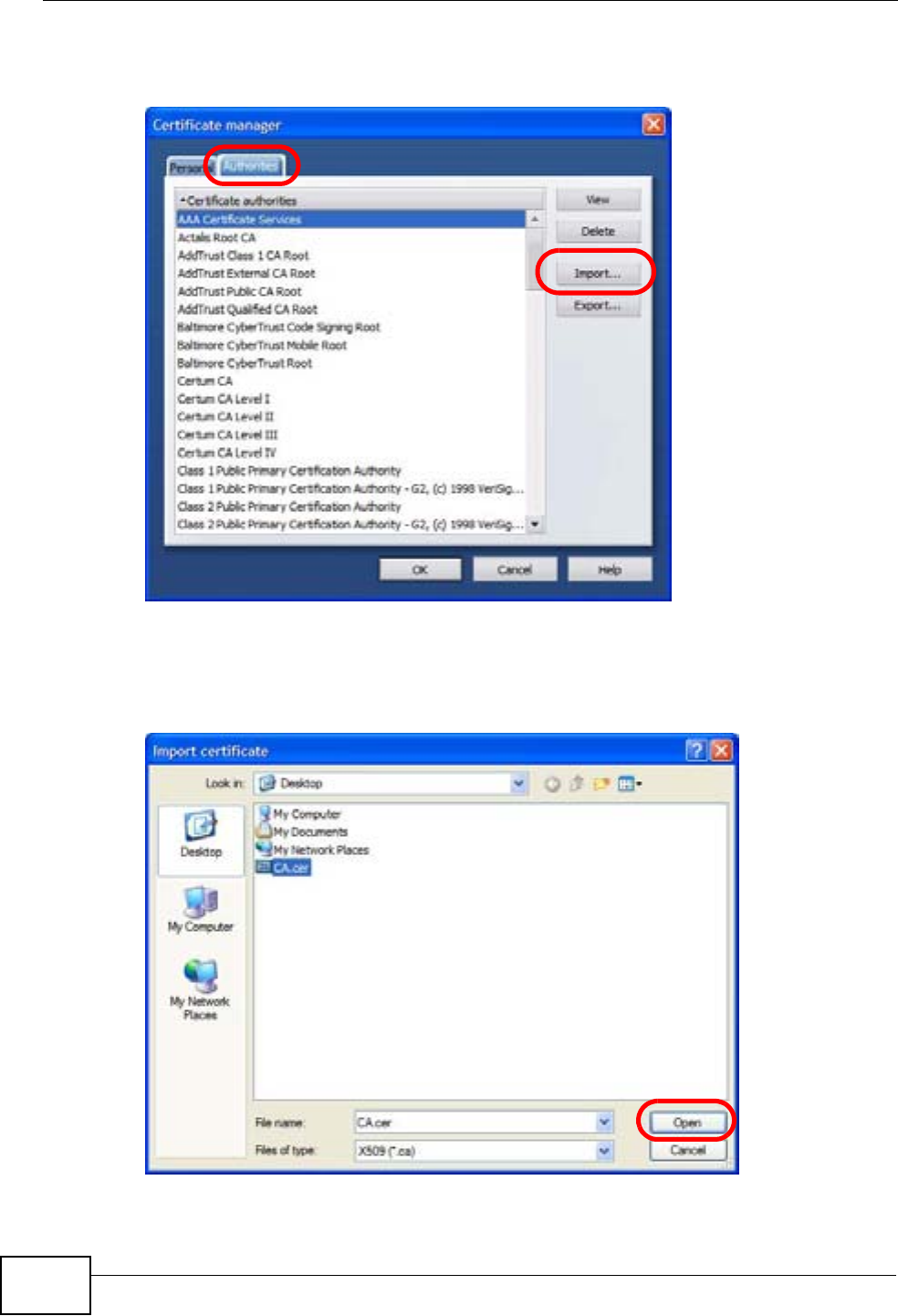
Appendix E Importing Certificates
HES-309M Series User’s Guide
222
3In the Certificates Manager, click Authorities > Import.
Figure 157 Opera 9: Certificate manager
4Use the Import certificate dialog box to locate the certificate and then click
Open.
Figure 158 Opera 9: Import certificate
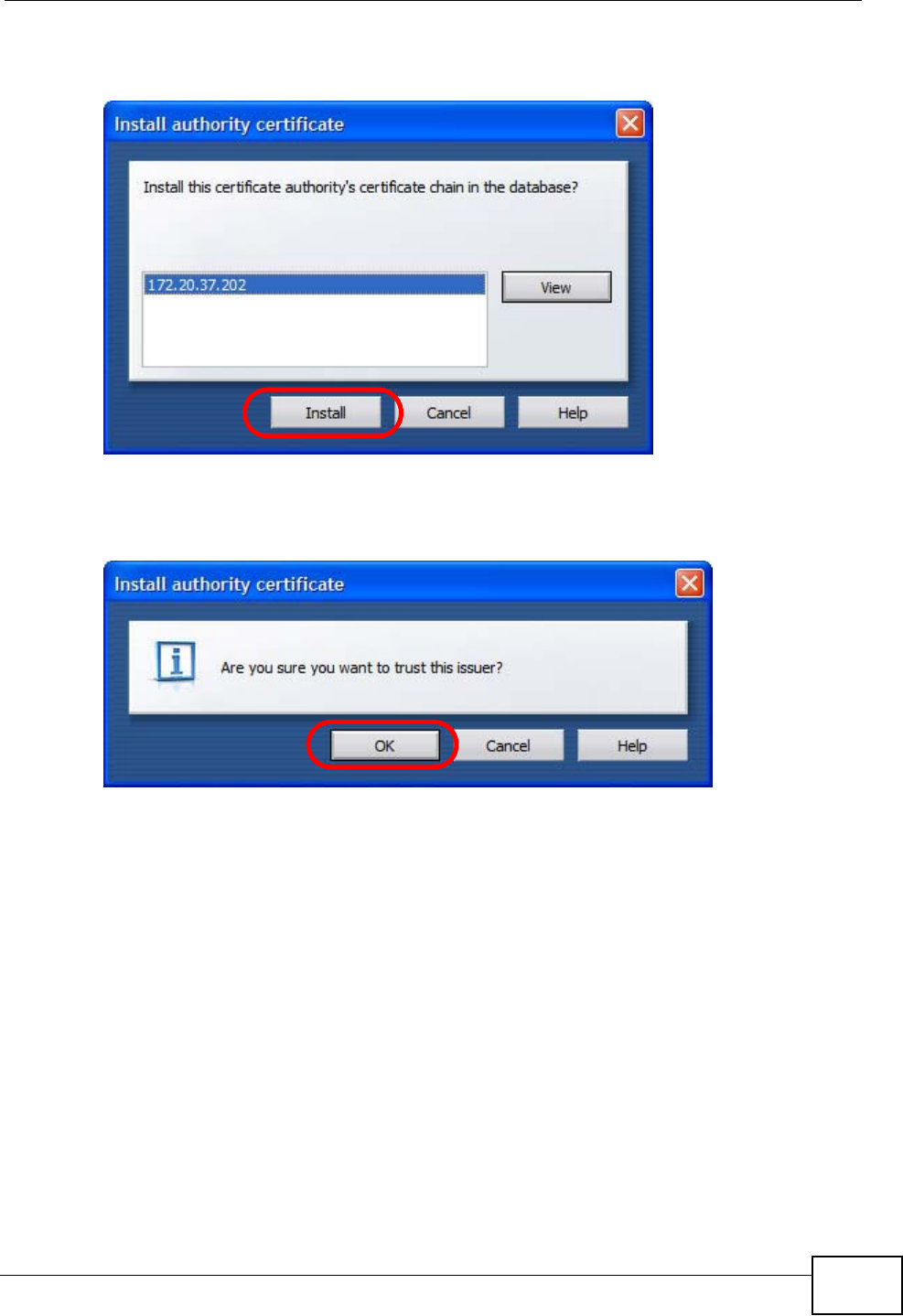
Appendix E Importing Certificates
HES-309M Series User’s Guide 223
5In the Install authority certificate dialog box, click Install.
Figure 159 Opera 9: Install authority certificate
6Next, click OK.
Figure 160 Opera 9: Install authority certificate
7The next time you visit the web site, click the padlock in the address bar to open
the Security information window to view the web page’s security details.
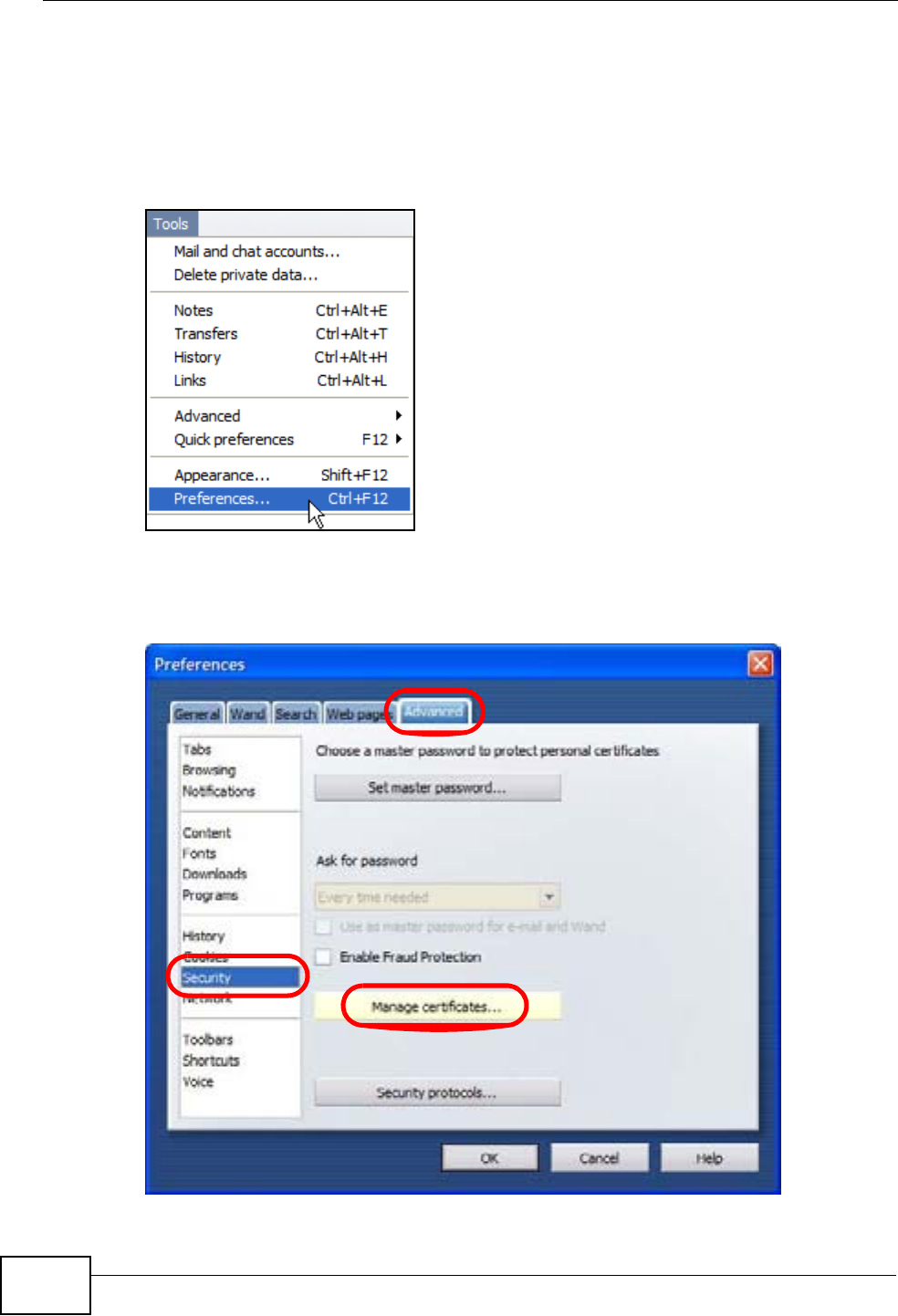
Appendix E Importing Certificates
HES-309M Series User’s Guide
224
Removing a Certificate in Opera
This section shows you how to remove a public key certificate in Opera 9.
1Open Opera and click TOOLS > Preferences.
Figure 161 Opera 9: Tools Menu
2In Preferences,ADVANCED > Security > Manage certificates.
Figure 162 Opera 9: Preferences
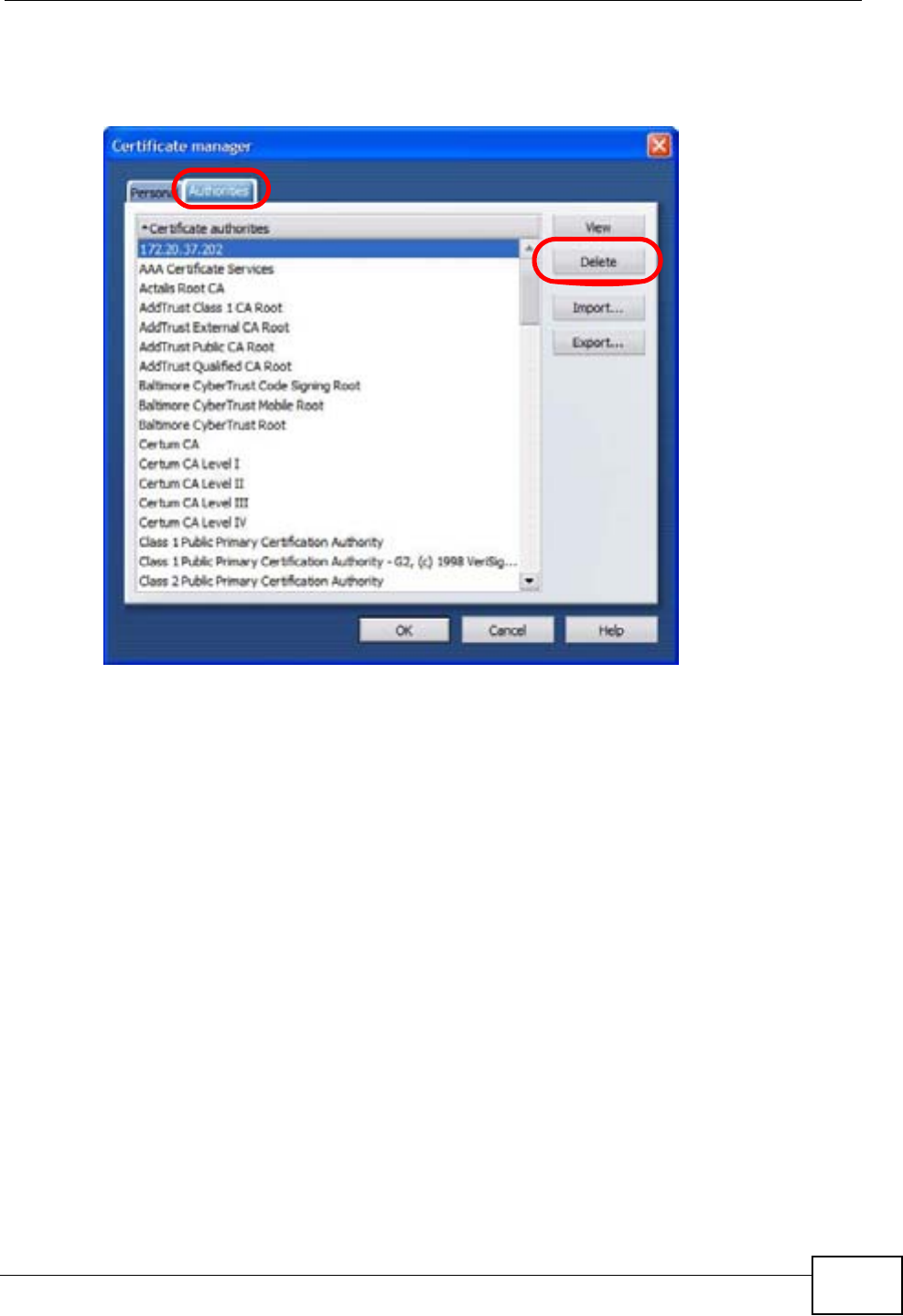
Appendix E Importing Certificates
HES-309M Series User’s Guide 225
3In the Certificates manager, select the Authorities tab, select the certificate
that you want to remove, and then click Delete.
Figure 163 Opera 9: Certificate manager
4The next time you go to the web site that issued the public key certificate you just
removed, a certification error appears.
Note: There is no confirmation when you delete a certificate authority, so be
absolutely certain that you want to go through with it before clicking the button.
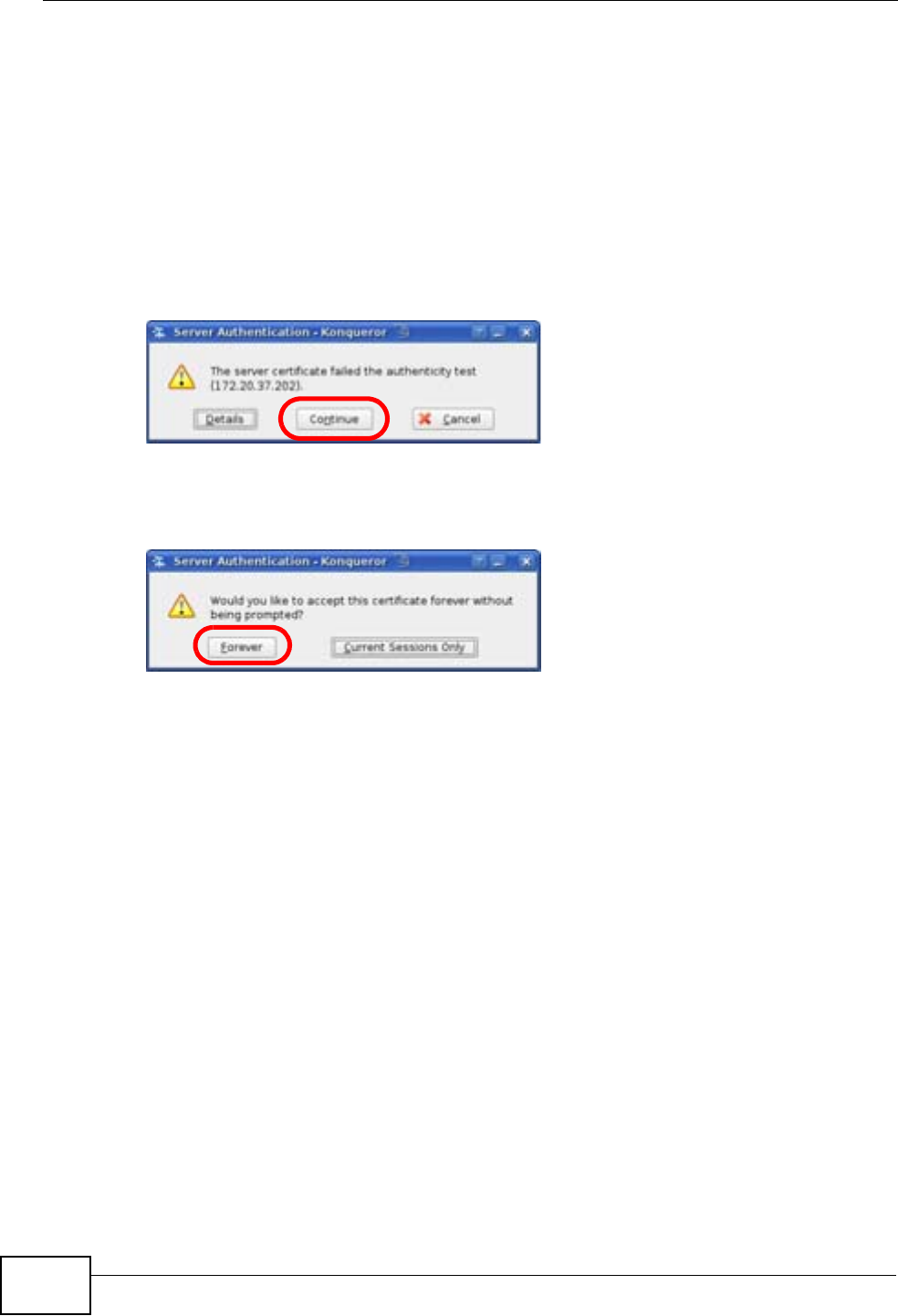
Appendix E Importing Certificates
HES-309M Series User’s Guide
226
Konqueror
The following example uses Konqueror 3.5 on openSUSE 10.3, however the
screens apply to Konqueror 3.5 on all Linux KDE distributions.
1If your device’s web configurator is set to use SSL certification, then the first time
you browse to it you are presented with a certification error.
2Click Continue.
Figure 164 Konqueror 3.5: Server Authentication
3Click Forever when prompted to accept the certificate.
Figure 165 Konqueror 3.5: Server Authentication
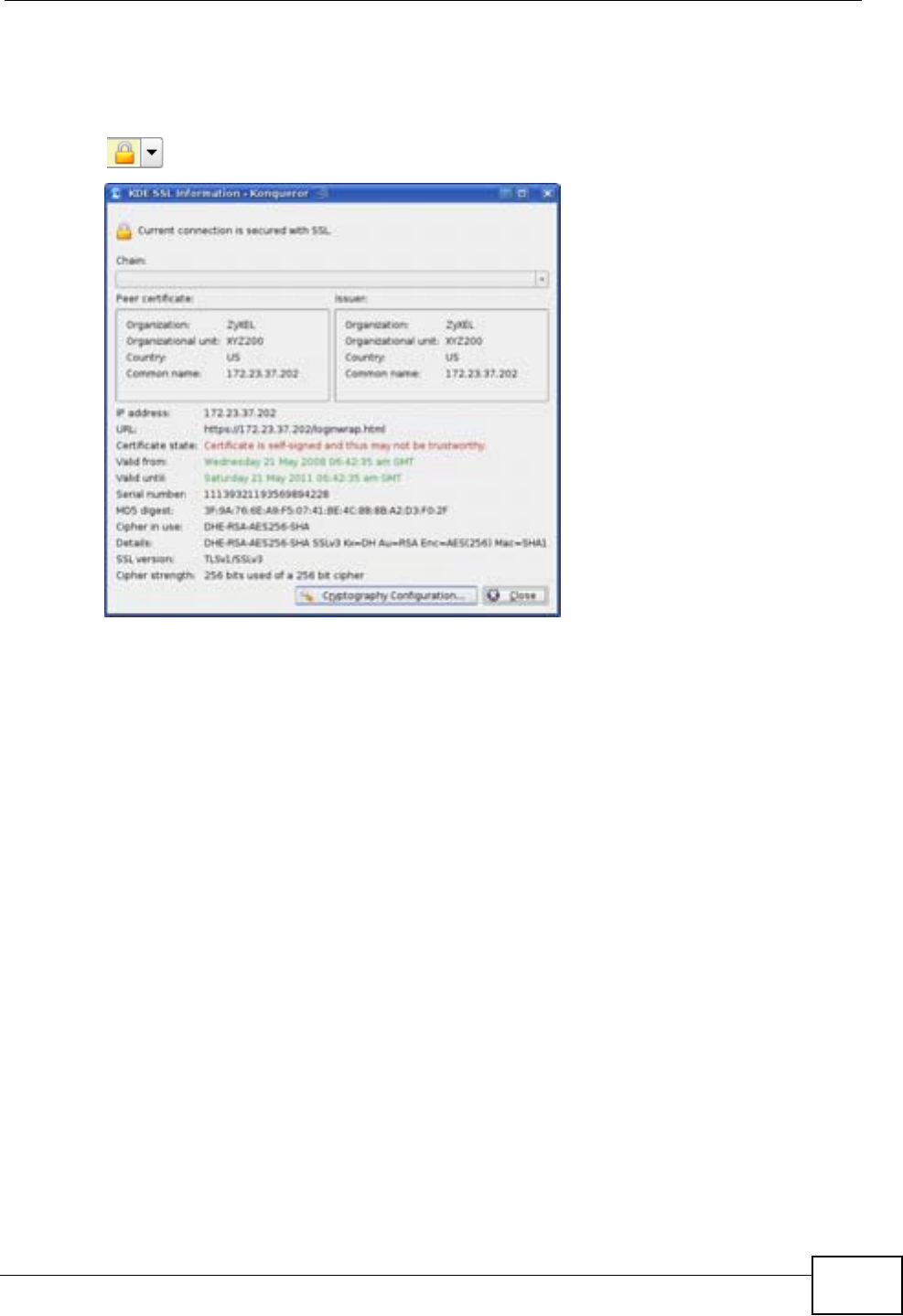
Appendix E Importing Certificates
HES-309M Series User’s Guide 227
4Click the padlock in the address bar to open the KDE SSL Information window
and view the web page’s security details.
Figure 166 Konqueror 3.5: KDE SSL Information
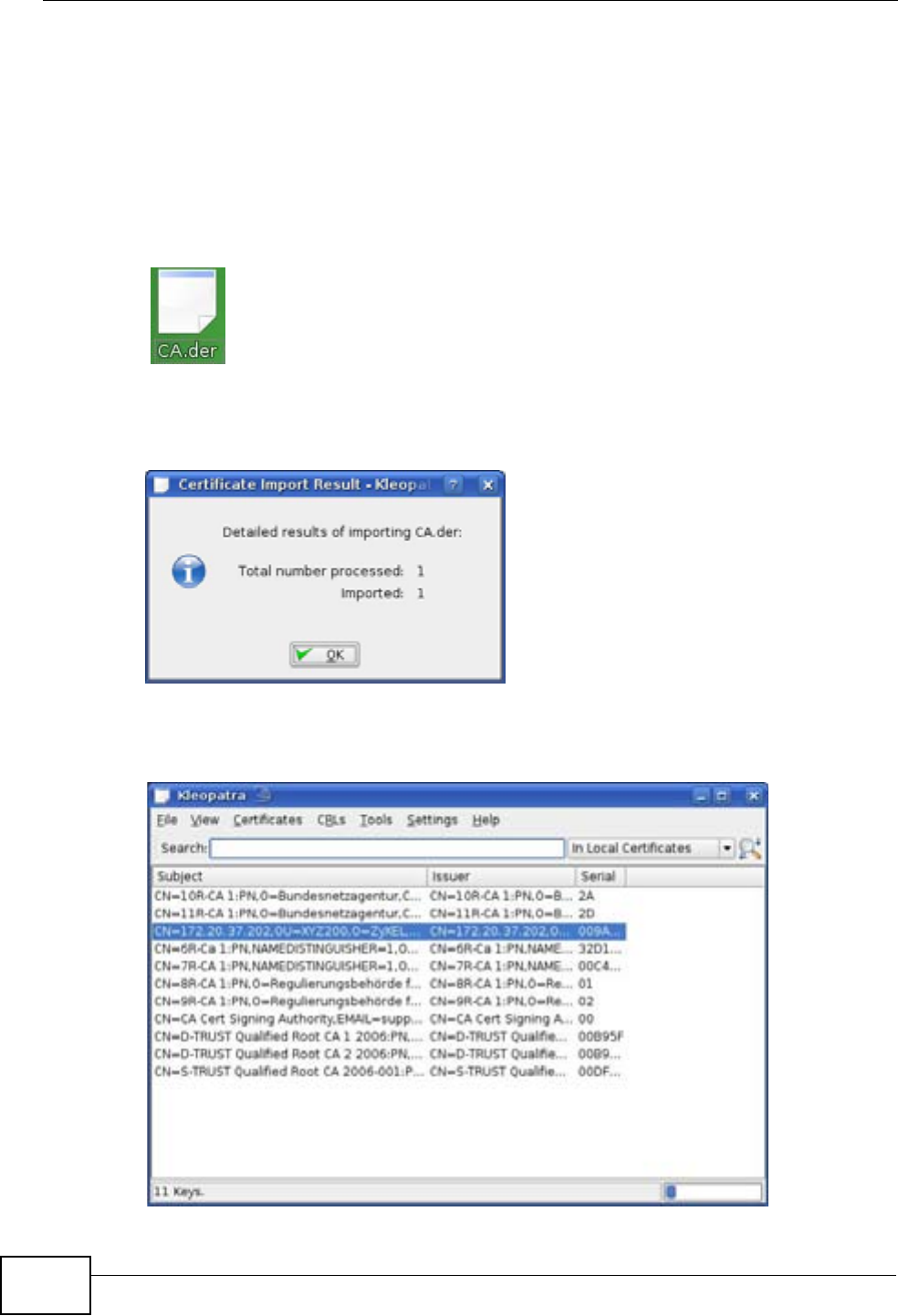
Appendix E Importing Certificates
HES-309M Series User’s Guide
228
Installing a Stand-Alone Certificate File in Konqueror
Rather than browsing to a ZyXEL web configurator and installing a public key
certificate when prompted, you can install a stand-alone certificate file if one has
been issued to you.
1Double-click the public key certificate file.
Figure 167 Konqueror 3.5: Public Key Certificate File
2In the Certificate Import Result - Kleopatra dialog box, click OK.
Figure 168 Konqueror 3.5: Certificate Import Result
The public key certificate appears in the KDE certificate manager, Kleopatra.
Figure 169 Konqueror 3.5: Kleopatra

Appendix E Importing Certificates
HES-309M Series User’s Guide 229
3The next time you visit the web site, click the padlock in the address bar to open
the KDE SSL Information window to view the web page’s security details.
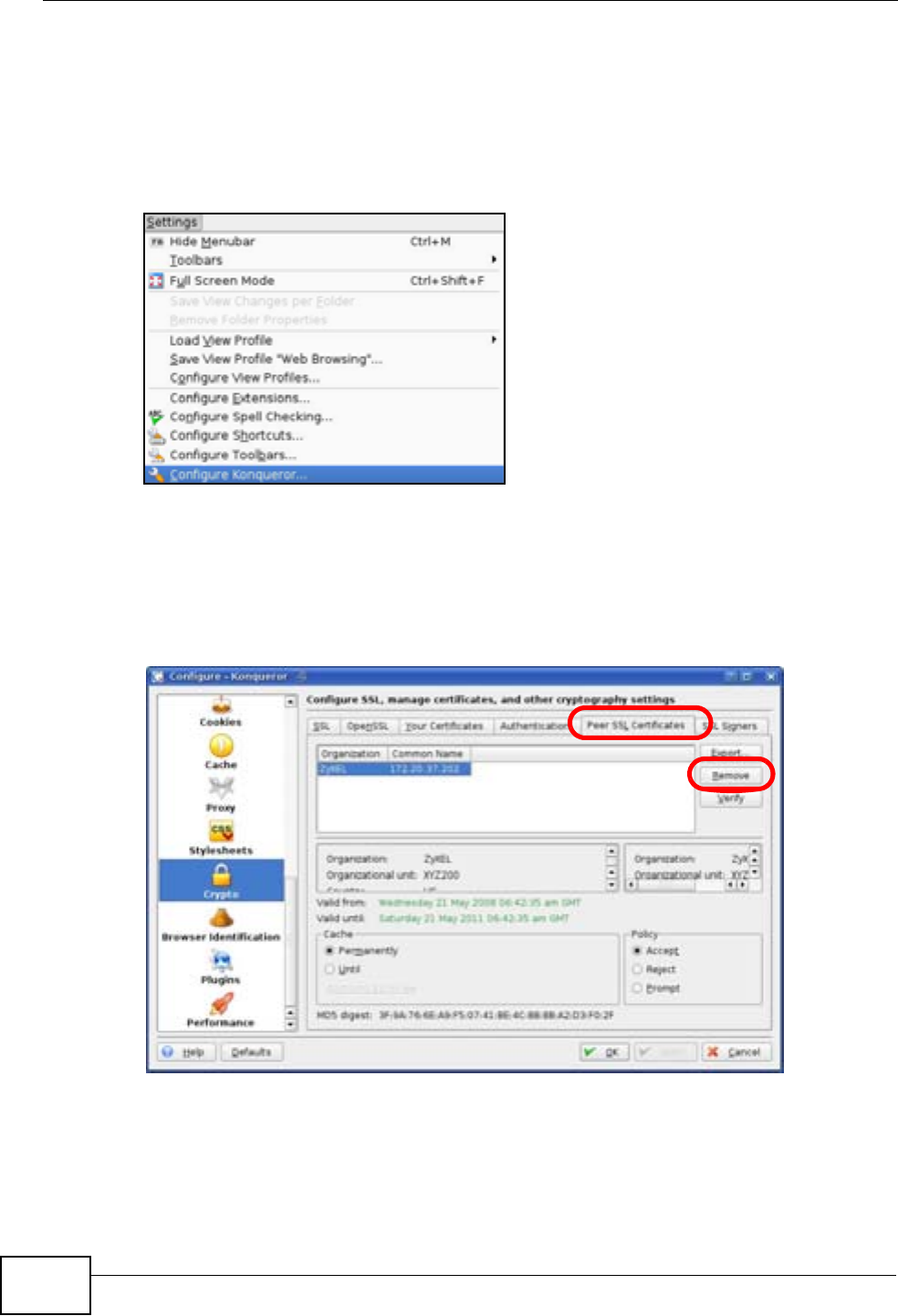
Appendix E Importing Certificates
HES-309M Series User’s Guide
230
Removing a Certificate in Konqueror
This section shows you how to remove a public key certificate in Konqueror 3.5.
1Open Konqueror and click Settings > Configure Konqueror.
Figure 170 Konqueror 3.5: Settings Menu
2In the Configure dialog box, select Crypto.
3On the Peer SSL Certificates tab, select the certificate you want to delete and
then click Remove.
Figure 171 Konqueror 3.5: Configure
4The next time you go to the web site that issued the public key certificate you just
removed, a certification error appears.

Appendix E Importing Certificates
HES-309M Series User’s Guide 231
Note: There is no confirmation when you remove a certificate authority, so be
absolutely certain you want to go through with it before clicking the button.

Appendix E Importing Certificates
HES-309M Series User’s Guide
232

HES-309M Series User’s Guide 233
APPENDIX F
Common Services
The following table lists some commonly-used services and their associated
protocols and port numbers. For a comprehensive list of port numbers, ICMP type/
code numbers and services, visit the IANA (Internet Assigned Number Authority)
web site.
•Name: This is a short, descriptive name for the service. You can use this one or
create a different one, if you like.
•Protocol: This is the type of IP protocol used by the service. If this is TCP/
UDP, then the service uses the same port number with TCP and UDP. If this is
USER-DEFINED, the Port(s) is the IP protocol number, not the port number.
•Port(s): This value depends on the Protocol. Please refer to RFC 1700 for
further information about port numbers.
•If the Protocol is TCP,UDP, or TCP/UDP, this is the IP port number.
•If the Protocol is USER, this is the IP protocol number.
•Description: This is a brief explanation of the applications that use this service
or the situations in which this service is used.
Table 71 Commonly Used Services
NAME PROTOCOL PORT(S) DESCRIPTION
AH
(IPSEC_TUNNEL)
User-Defined 51 The IPSEC AH (Authentication
Header) tunneling protocol uses this
service.
AIM/New-ICQ TCP 5190 AOL’s Internet Messenger service. It
is also used as a listening port by
ICQ.
AUTH TCP 113 Authentication protocol used by some
servers.
BGP TCP 179 Border Gateway Protocol.
BOOTP_CLIENT UDP 68 DHCP Client.
BOOTP_SERVER UDP 67 DHCP Server.
CU-SEEME TCP
UDP
7648
24032
A popular videoconferencing solution
from White Pines Software.
DNS TCP/UDP 53 Domain Name Server, a service that
matches web names (for example
www.zyxel.com) to IP numbers.

Appendix F Common Services
HES-309M Series User’s Guide
234
ESP
(IPSEC_TUNNEL)
User-Defined 50 The IPSEC ESP (Encapsulation
Security Protocol) tunneling protocol
uses this service.
FINGER TCP 79 Finger is a UNIX or Internet related
command that can be used to find out
if a user is logged on.
FTP TCP
TCP
20
21
File Transfer Program, a program to
enable fast transfer of files, including
large files that may not be possible by
e-mail.
H.323 TCP 1720 NetMeeting uses this protocol.
HTTP TCP 80 Hyper Text Transfer Protocol - a
client/server protocol for the world
wide web.
HTTPS TCP 443 HTTPS is a secured http session often
used in e-commerce.
ICMP User-Defined 1Internet Control Message Protocol is
often used for diagnostic or routing
purposes.
ICQ UDP 4000 This is a popular Internet chat
program.
IGMP
(MULTICAST)
User-Defined 2Internet Group Management Protocol
is used when sending packets to a
specific group of hosts.
IKE UDP 500 The Internet Key Exchange algorithm
is used for key distribution and
management.
IRC TCP/UDP 6667 This is another popular Internet chat
program.
MSN Messenger TCP 1863 Microsoft Networks’ messenger
service uses this protocol.
NEW-ICQ TCP 5190 An Internet chat program.
NEWS TCP 144 A protocol for news groups.
NFS UDP 2049 Network File System - NFS is a client/
server distributed file service that
provides transparent file sharing for
network environments.
NNTP TCP 119 Network News Transport Protocol is
the delivery mechanism for the
USENET newsgroup service.
PING User-Defined 1Packet INternet Groper is a protocol
that sends out ICMP echo requests to
test whether or not a remote host is
reachable.
POP3 TCP 110 Post Office Protocol version 3 lets a
client computer get e-mail from a
POP3 server through a temporary
connection (TCP/IP or other).
Table 71 Commonly Used Services (continued)
NAME PROTOCOL PORT(S) DESCRIPTION

Appendix F Common Services
HES-309M Series User’s Guide 235
PPTP TCP 1723 Point-to-Point Tunneling Protocol
enables secure transfer of data over
public networks. This is the control
channel.
PPTP_TUNNEL
(GRE)
User-Defined 47 PPTP (Point-to-Point Tunneling
Protocol) enables secure transfer of
data over public networks. This is the
data channel.
RCMD TCP 512 Remote Command Service.
REAL_AUDIO TCP 7070 A streaming audio service that
enables real time sound over the web.
REXEC TCP 514 Remote Execution Daemon.
RLOGIN TCP 513 Remote Login.
RTELNET TCP 107 Remote Telnet.
RTSP TCP/UDP 554 The Real Time Streaming (media
control) Protocol (RTSP) is a remote
control for multimedia on the
Internet.
SFTP TCP 115 Simple File Transfer Protocol.
SMTP TCP 25 Simple Mail Transfer Protocol is the
message-exchange standard for the
Internet. SMTP enables you to move
messages from one e-mail server to
another.
SNMP TCP/UDP 161 Simple Network Management
Program.
SNMP-TRAPS TCP/UDP 162 Traps for use with the SNMP
(RFC:1215).
SQL-NET TCP 1521 Structured Query Language is an
interface to access data on many
different types of database systems,
including mainframes, midrange
systems, UNIX systems and network
servers.
SSH TCP/UDP 22 Secure Shell Remote Login Program.
STRM WORKS UDP 1558 Stream Works Protocol.
SYSLOG UDP 514 Syslog allows you to send system logs
to a UNIX server.
TACACS UDP 49 Login Host Protocol used for (Terminal
Access Controller Access Control
System).
TELNET TCP 23 Telnet is the login and terminal
emulation protocol common on the
Internet and in UNIX environments. It
operates over TCP/IP networks. Its
primary function is to allow users to
log into remote host systems.
Table 71 Commonly Used Services (continued)
NAME PROTOCOL PORT(S) DESCRIPTION

Appendix F Common Services
HES-309M Series User’s Guide
236
TFTP UDP 69 Trivial File Transfer Protocol is an
Internet file transfer protocol similar
to FTP, but uses the UDP (User
Datagram Protocol) rather than TCP
(Transmission Control Protocol).
VDOLIVE TCP 7000 Another videoconferencing solution.
Table 71 Commonly Used Services (continued)
NAME PROTOCOL PORT(S) DESCRIPTION

HES-309M Series User’s Guide 237
APPENDIX G
Legal Information
Copyright
Copyright © 2010 by ZyXEL Communications Corporation.
The contents of this publication may not be reproduced in any part or as a whole,
transcribed, stored in a retrieval system, translated into any language, or
transmitted in any form or by any means, electronic, mechanical, magnetic,
optical, chemical, photocopying, manual, or otherwise, without the prior written
permission of ZyXEL Communications Corporation.
Published by ZyXEL Communications Corporation. All rights reserved.
Disclaimers
ZyXEL does not assume any liability arising out of the application or use of any
products, or software described herein. Neither does it convey any license under
its patent rights nor the patent rights of others. ZyXEL further reserves the right
to make changes in any products described herein without notice. This publication
is subject to change without notice.
Your use of the WiMAX Device is subject to the terms and conditions of any related
service providers.
Do not use the WiMAX Device for illegal purposes. Illegal downloading or sharing
of files can result in severe civil and criminal penalties. You are subject to the
restrictions of copyright laws and any other applicable laws, and will bear the
consequences of any infringements thereof. ZyXEL bears NO responsibility or
liability for your use of the download service feature.
Trademarks
Trademarks mentioned in this publication are used for identification purposes only
and may be properties of their respective owners.

Appendix G Legal Information
HES-309M Series User’s Guide
238
Certifications
Federal Communications Commission (FCC) Interference Statement
The device complies with Part 15 of FCC rules. Operation is subject to the
following two conditions:
This device complies with part 15 of the FCC Rules.
Operation is subject to the condition that this device does not cause harmful
interference.
This device has been tested and found to comply with the limits for a Class B
digital device pursuant to Part 15 of the FCC Rules. These limits are designed to
provide reasonable protection against harmful interference in a residential
installation. This device generates, uses, and can radiate radio frequency energy,
and if not installed and used in accordance with the instructions, may cause
harmful interference to radio communications. However, there is no guarantee
that interference will not occur in a particular installation.
If this device does cause harmful interference to radio/television reception, which
can be determined by turning the device off and on, the user is encouraged to try
to correct the interference by one or more of the following measures:
1Reorient or relocate the receiving antenna.
2Increase the separation between the equipment and the receiver.
3Connect the equipment into an outlet on a circuit different from that to which the
receiver is connected.
4Consult the dealer or an experienced radio/TV technician for help.
FCC Radiation Exposure Statement
This transmitter must not be co-located or operating in conjunction with any
other antenna or transmitter.
To comply with FCC RF exposure compliance requirements, a separation
distance of at least 40 cm must be maintained between the antenna of this
device and all persons.
ࣹრ !
ࠉᖕ !܅פሽंᘿ୴ࢤሽᖲጥᙄऄ
รԼԲය ᆖীڤᎁᢞٽհ܅פ୴᙮ሽᖲΔॺᆖױΔֆΕᇆࢨࠌش
ृ݁լᖐ۞᧢ޓ᙮ΕףՕפࢨ᧢ޓૠհࢤ֗פ౨Ζ

Appendix G Legal Information
HES-309M Series User’s Guide 239
รԼය!!܅פ୴᙮ሽᖲհࠌشլᐙଆڜ٤֗եឫٽऄຏॾΙᆖ࿇
ڶեឫွழΔᚨمܛೖشΔࠀޏ۟ྤեឫழֱᤉᥛࠌشΖ
ছႈٽऄຏॾΔਐࠉሽॾࡳ܂ᄐհྤᒵሽॾΖ܅פ୴᙮ሽᖲႊݴ
࠹ٽऄຏॾࢨՠᄐΕઝᖂ֗᠔᛭شሽंᘿ୴ࢤሽᖲໂհեឫΖ
ءᖲૻڇլեឫٽऄሽፕፖլ࠹եឫঅᎽයٙՀ࣍փࠌشΖ!
྇֟ሽंᐙΔᓮݔᔞࠌشΖ
Notices
Changes or modifications not expressly approved by the party responsible for
compliance could void the user's authority to operate the equipment.
This Class B digital apparatus complies with Canadian ICES-003.
Cet appareil numérique de la classe B est conforme à la norme NMB-003 du
Canada.
Viewing Certifications
1Go to http://www.zyxel.com.
2Select your product on the ZyXEL home page to go to that product's page.
3Select the certification you wish to view from this page.
ZyXEL Limited Warranty
ZyXEL warrants to the original end user (purchaser) that this product is free from
any defects in materials or workmanship for a period of up to two years from the
date of purchase. During the warranty period, and upon proof of purchase, should
the product have indications of failure due to faulty workmanship and/or
materials, ZyXEL will, at its discretion, repair or replace the defective products or
components without charge for either parts or labor, and to whatever extent it
shall deem necessary to restore the product or components to proper operating
condition. Any replacement will consist of a new or re-manufactured functionally
equivalent product of equal or higher value, and will be solely at the discretion of
ZyXEL. This warranty shall not apply if the product has been modified, misused,
tampered with, damaged by an act of God, or subjected to abnormal working
conditions.

Appendix G Legal Information
HES-309M Series User’s Guide
240
Note
Repair or replacement, as provided under this warranty, is the exclusive remedy of
the purchaser. This warranty is in lieu of all other warranties, express or implied,
including any implied warranty of merchantability or fitness for a particular use or
purpose. ZyXEL shall in no event be held liable for indirect or consequential
damages of any kind to the purchaser.
To obtain the services of this warranty, contact your vendor. You may also refer to
the warranty policy for the region in which you bought the device at http://
www.zyxel.com/web/support_warranty_info.php.
Registration
Register your product online to receive e-mail notices of firmware upgrades and
information at www.zyxel.com.

Index
HES-309M Series User’s Guide 241
Index
A
AAA 52
accounting server
see AAA
activity 52
Advanced Encryption Standard
see AES
AES 149
ALG 76
alternative subnet mask notation 192
Application Layer Gateway
see ALG
authentication 52,147
inner 150
key
server 52
types 150
authorization 147
request and reply 149
server 52
auto-discovery
UPnP 97
B
base station
see BS
BS 51–52
links 52
C
CA 53,54
CBC-MAC 149
CCMP 147,149
cell 51
certificates 147
CA 53
formats 54
verification 149
certification
notices 239
viewing 239
Certification Authority, see CA
chaining 149
chaining message authentication
see CCMP
CMAC
see MAC
copyright 237
counter mode
see CCMP
coverage area 51
cryptography 147
D
data 147–149
decryption 147
encryption 147
flow 149
DHCP 73
server 73
diameter 52
digital ID 54,147
Dynamic Host Configuration Protocol
see DHCP
E
EAP 52
EAP (Extensible Authentication Protocol) 54
EAP-TLS 54
EAP-TTLS 54
encryption 147–149

Index
HES-309M Series User’s Guide
242
traffic 149
Ethernet
encapsulation 75
Extensible Authorization Protocol
see EAP
F
FCC interference statement 238
firewall 105
FTP 111
restrictions 111
I
IANA 198
identity 52,147
idle timeout 112
IEEE 802.16 51,147
IEEE 802.16e 51
IGD 1.0 77
inner authentication 150
Internet
access 52
gateway device 77
Internet Assigned Numbers Authority
see IANA 198
interoperability 51
K
key 147
request and reply 149
M
MAC 149
MAN 51
Management Information Base (MIB) 114
Message Authentication Code
see MAC
message integrity 149
Metropolitan Area Network
see MAN
microwave 51,52
mobile station
see MS
MS 52
N
NAT 197
and remote management 112
server sets 75
traversal 77
network
activity 52
services 52
P
pattern-spotting 149
PKMv2 52,147,150
plain text encryption 149
Privacy Key Management
see PKM
private key 147
product registration 240
public certificate 149
public key 147
R
RADIUS 52,54,148
Message Types 148
Messages 148
Shared Secret Key 148
registration
product 240
related documentation 3
remote management and NAT 112
remote management limitations 111

Index
HES-309M Series User’s Guide 243
S
safety warnings 7
secure communication 147
secure connection 52
security 147
security association 149
see SA
services 52
SIP
ALG 76
Application Layer Gateway, see ALG
SNMP 112
manager 114
SS 51,52
subnet 189
mask 190
subnetting 192
subscriber station
see SS
syntax conventions 5
system timeout 112
T
tampering
TCP/IP configuration 73
TEK 149
TFTP restrictions 111
TLS 147
transport encryption key
see TEK
transport layer security
see TLS
trigger port forwarding
process 92
TTLS 147,150
tunneled TLS
see TTLS
U
unauthorized device 147
Universal Plug and Play
see UPnP
UPnP 76
application 77
auto-discovery 97
security issues 77
Windows XP 95
user authentication 147
V
verification 149
W
WiMAX 51–52
security 149
WiMAX Forum 51
Wireless Interoperability for Microwave Access
see WiMAX
Wireless Metropolitan Area Network
see MAN
wireless network
access 51
standard 51
wireless security 147
wizard setup 23

Index
HES-309M Series User’s Guide
244

Index
HES-309M Series User’s Guide 245

Index
HES-309M Series User’s Guide
246